
- Salkantay Trek
- Inca Jungle Trek
- Huchuy Qosqo Trek
- Ausangate Trek
- Vilcabamba Trek
- Choquequirao Trek
- Huayna Picchu
- Altitude Sickness
- Packing List
- Humantay Lake
- Lake Titicaca
- Nazca Lines
- Rainbow Mountain
- Get A Trek Quote

Lares Trek vs Inca Trail – Choosing Between 2 Epic Routes
Lares Trek or Inca Trail? That is the question.
It can be intimidating trying to make a choice between two of Peru’s most famous hiking routes. How you reach Machu Picchu comes down to a matter of taste.
Ultimately, you need to look at the pros and cons of each route. In this article, I’ve compiled some unbiased comparisons to help you choose between the Lares Trek vs. the Inca Trail.
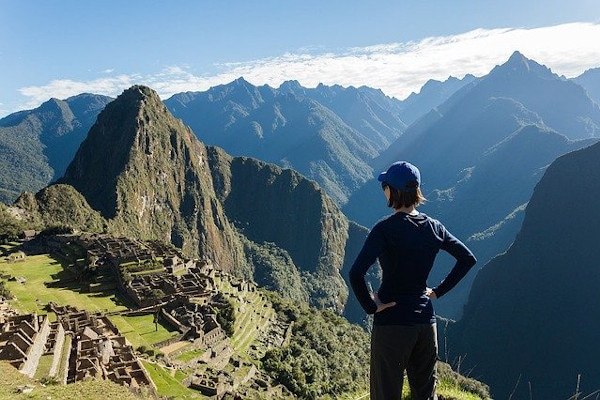
Get an Inca trail trek quote
Start planning your Machu Picchu hiking holiday.
Lares Trek Vs the Inca Trail
What are the main differences.
As a summary there are four main differences between the Lares trail and the Inca trail are as follows:
- The Lares trek is through a valley where you pass many traditional villages. The Lares Trek is ideal for getting a taste of true Peruvian culture.
- The Inca Trail is through remote areas. The trail passes through different biomes and several Incan ruin sites . The Inca Trail is more focused on natural scenery and history than culture.
- The Lares Trek is only 3 days of hiking compared to the Inca’s four days . This makes it shorter (33km for the Lares vs 41km for the Inca trail) and easier than the Inca trail.
- Finally, there is no permit required to hike the Lares Trek, but you do need a permit for the Inca Trail.
Please Note: Inca Trail permits sell out months ahead of time. See Inca trail availability .
A Side By Side Comparison of the Lares Trek Vs the Inca Trail
Routes and difficulty, lares trek - fair.
Firstly, it's essential to know that the Lares Trek has multiple variations. This is because there are many Incan paths through the Lares valley. You can read more about the Lares Trek variations here.
The most popular 4-day Lares Trek is 20 miles / 33km and ends at Aguas Calientes. You will spend three days hiking and the fourth day touring Machu Picchu .
There is only one real steep part on the Lares trek - Ipsaycocha Pass (4,500m / 14,764 ft). Ipsaycocha is higher than any point on the Inca Trail. Unlike the Inca Trail, there are no stone stairways. Hiking up the pass is a steady progression on a dirt track.
You will spend more time at higher altitudes on the Lares trek compared to the Inca Trail. This means there is an increased risk of getting altitude sickness. To help you prepare, we have a list of precautions to avoid altitude sickness.
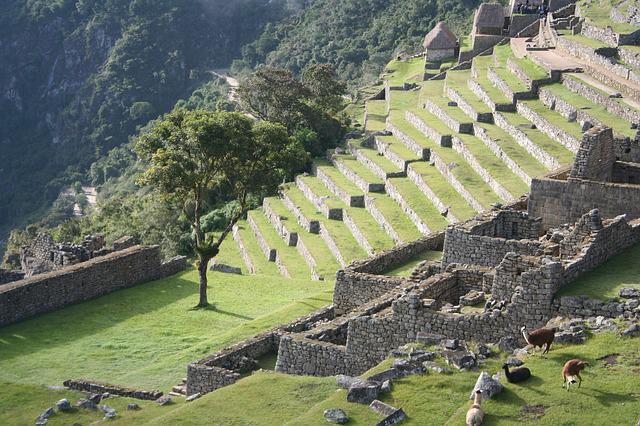
Inca Trail: Moderate
The classic 4-day Inca Trail covers 26miles / 41km through remote areas. There is only one pathway with no alternative options.
The Inca trail trek is the more difficult route of the two trails. You will be going up and down more than on the Lares Trek. You can expect to be trekking up and down around 1000s of stone steps.
Day 2 on the Inca Trail is the most difficult part of the hike. On this day, groups climb the stairs up to 4,215m (13,829 ft) above sea level on Dead Woman’s Pass.
See : How hard is the Inca trail
Looking for a day tour? Here are my 5 favourite day tours around Cusco:
- Rainbow Mountain day trip (with meals)
- Moray and Salt Mines Quad Bike Tour
- Sacred Valley day tour
- Humantay Lake day tour
- Machu Picchu and Huayna Picchu entrance tickets
See more Cusco day trips .
Costs And Availability
Lares trek costs.
The Lares Trek generally costs between $400 and $650 per person. Most companies sell this trek for roughly $550 per person.
The trail is open year-round. Most agencies require hikers to sign a wet season policy agreement. These policies protect companies from client cancellations due to wet weather conditions.
See: weather on the Inca trail .
Inca Trail Costs
With most Inca Trail Tours , a budget Inca trail tour will cost you between $550-$650 per person. If you are looking to hike the Inca Trail in luxury , expect to pay about $1000-$2000 per person. For this price, you will get a private guide and a more cushy camp setup.
The Inca Trail closes over February. This is when the area experiences the heaviest rainfall.
You may also like...
- Inca quarry trail vs Inca trail
- Salkantay trail vs Inca trail
Guides And Porters
Lares trek guides and porters.
Most people do the Lares Trek with a guided tour, but it is possible to hike it solo.
Please Note: If you choose to trek solo on the Lares Trail, you will be carrying all your own gear. You should have some experience trekking to take this option.
Tour operators usually hire mules to do the heavy lifting. These surefooted animals carry equipment and extra baggage between camps.
Inca Trail Guides and Porters
As of 2014, hikers are not allowed to walk the Inca Trail solo . You may only do this hike through a tour operator or by working with a registered private guide.
Horses or mules are not allowed on the Inca Trail as they would cause too much damage to the environment. Local porters carry equipment and food between camps.
Read about Inca trail porter welfare and tips .
Where to stay? Here are 5 of my favourite accommodation options in Cusco:
- Sonesta Hotel (great 4-star hotel)
- Antigua Casona San Blas
- El Mariscal Cusco (very good value)
- Hotel Paradis (good 3-star hotel)
- Quechua Hostel Recoleta (cheap and cheerful)
See more Cusco accommodation options .
Accommodation and Facilities
Lares trek accommodation.
You will be camping on the first two nights of the Lares trek. Campsites are not strictly regulated on this trail. Each company has a preference for where to set up their tents. You will likely spend one of these nights sleeping above 4,200m (13,780ft).
Some tour operators have an arrangement with the locals and can also organize homestays. This way, people in remote villages benefit from tourism.
You will be staying in Aguas Calientes for the final night. Usually, this is in a mid-range hotel. In some circumstances, you may have the option to upgrade to a luxury lodge.
On the Lares Trek, there are no bathrooms. Some companies set up a toilet tent for privacy while in the campsites.
Inca Trail Accommodation
During the Inca Trail, you will be camping all three nights. Due to high numbers of walkers, Inca trail campsites are restricted to designated areas. The highest campsite is at 3600m (18,111 ft) above sea level.
There are several available camping zones for each night. However, you will not be able to choose your campsites on the Inca Trail . Authorities allocate the most convenient sites first.
Please Note: Inca Trail campsites are crowded and noisy in the evenings. The good news about regulated camps is that some have showers and toilets.
Highlights and Negatives Of The Lares Trek Vs The Inca Trail
Lares trek highlights.
The best thing about the Lares Trail is experiencing the authentic Andean culture. You will get to interact with local farmers and craftsmen. The lifestyle in this valley has barely changed over hundreds of years.
Hikers often get to try their hand at weaving and other traditional activities. This is a more authentic Andes hiking experience as you will see very few other tourists on the trail.
The Lares Trail passes by stunning waterfalls and lakes. These bodies of water are held sacred by local people. On the third day, you will get to soak your sore muscles in the Lares Hot Springs, which is a refreshing experience.
- What to do and see in the Sacred valley
- Paragliding in the Sacred valley
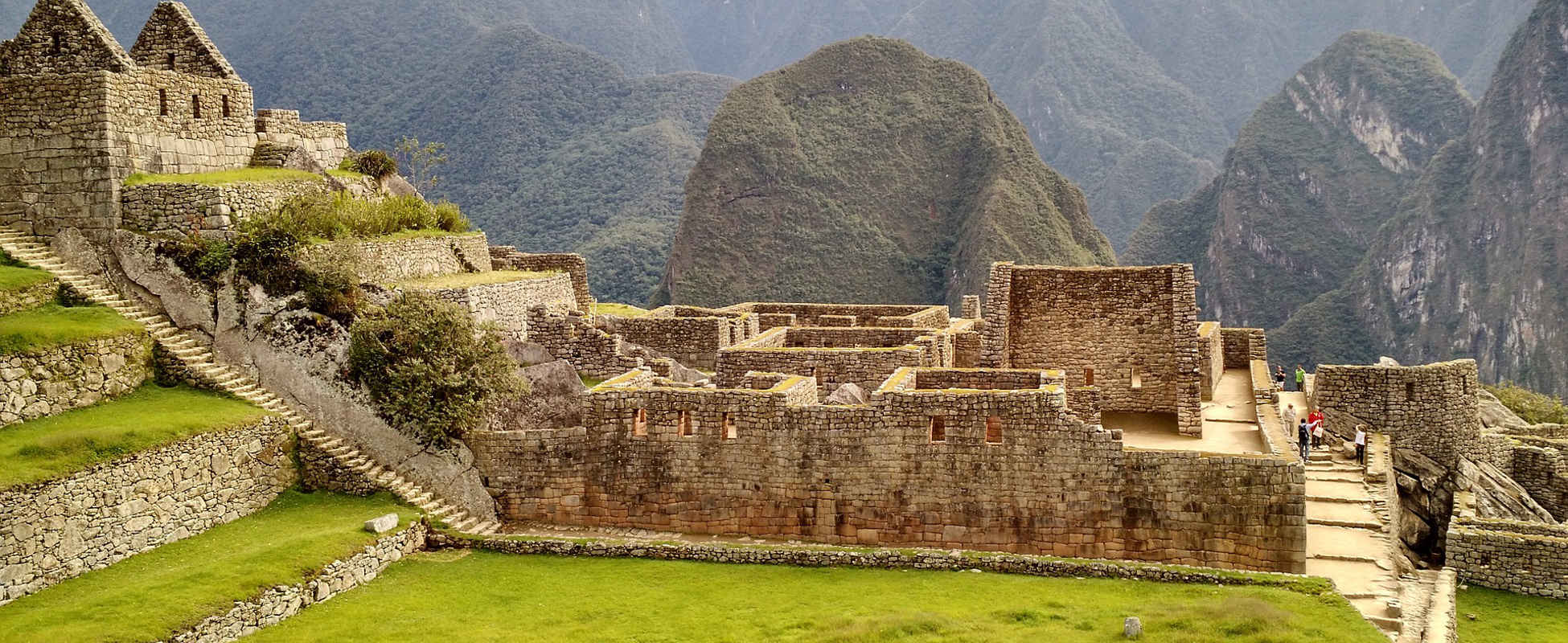
Negatives To The Lares Trail
The biggest downside to hiking the Lares Trek is that it does not end at the Sun Gate. There are also no significant ruins along this trail.
Most of the Lares Trail is in the same valley. This area is inhabited by communities that practice subsistence farming. The landscape of this trail is not nearly as wild and diverse as that of the Inca Trail.
Inca Trail Highlights
Finishing the trail through the Sun Gate is the main attraction of this trail. The Inca Trail is the only route option to enter Machu Picchu on foot. Hikers often describe coming through the Sun Gate as one of the best moments in their lives
The Incan trail is the best route for seeing Incan ruins. You will pass by several fascinating archeological areas on the way to Machu Picchu. These ruins are only accessible to Inca Trail Hikers.
Another highlight of the Inca Trail is getting to see a wide variety of landscapes. The trail will take you through Andean highlands, cloud forests, and tropical forests.
Negatives To Hiking The Inca Trail
The Inca trail is a bit more expensive than the Lares Trek. This trail is also a lot more popular. You share the trail and campsites with hundreds of other tourists and porters.
There are regular checkpoints and you will need to take your passport along for this trail. These document check-points take some of the fun out of the experience.
Lastly, it is not possible to book the Inca Trail on short notice. You need to plan months to a year ahead for your trip.
Lares Trail Or Inca Trail - Which Should You Choose?
Who should hike the lares trek.
The Lares is perfect for those who want to immerse themselves in authentic Peruvian culture. This is also the better option if you like peace and solitude on a hike.
Do your travel plans change on a daily basis? This trail offers the flexibility you need. This is the best alternative to the 4-day Inca Trail over the same length of time.
Another reason to consider the Lares Trek over the Inca Trail is the lack of stairs. This trek is easier for people who suffer from knee issues.
Who should Hike The Inca Trail?
Stick with the Inca Trail If you feel there is no substitute for Peru’s most famous hike. This is for those who want to lay eyes on Machu Picchu for the first time through the Sun Gate at first light.
Can you afford to plan months in advance? Do you want bragging rights to one of the world’s most famous trails? Then, go ahead and book your spot on the Inca Trail.
- How many miles is the Inca trail
Follow the footsteps of Monarchs or see life through the eyes of Incan descendants. Only you can make the choice on how to reach Machu Picchu - the Lares Trek vs. the Inca Trail.
Whichever trail you choose, I can guarantee that it will be one of the best experiences of your life.
Alison Macallister
With a degree in Nature Conservation and experience working with wildlife including the Big 5, Alison works as a guide for a 5-star reserve. She enjoys sharing her passion for all things nature-related. She enjoys hiking, horseriding, 4x4 driving and kayaking.
Leave a Reply
Your email address will not be published. Required fields are marked
Name * * * *
Email * * * *
The Lares trek was amazing. The families we met on the way through, the scenery, all fantastic.
Get a quote from our recommended local trek operator in Peru

INCA TRAIL VS LARES TREK
Perhaps you wanted to hike the Inca trail to Machu Picchu, but just then heard about Lares trek. So the question arises immediately: Which hike should I take?. Well, In this Lares Trek vs Inca trail post, we will come up with some of the main highlights to see if you finally end up choosing one of these treks.
Book your Inca Trail as soon as with a local Company AB EXPEDITIONS !. Permits will sell out fast in Peru, due to continued government restrictions of 50% fewer permits available for 2022. Book here .
Inca Trail.- The famous Inca Trail is undoubtedly one of the top hiking routes in the world that leads you straight to Machu Picchu on foot, and of course, entering through the famous Sun Gate . Before getting to Machu Picchu, you will hike through various Inca ruins and inhabited areas unreachable to tourists by any other means. The most common package is the 4-day hike Inca trail hike.
Lares Trek.- By comparison, the Lares Trek is a much less discovered hiking route to Machu Picchu so at times you will feel like you are alone with the mountains. The real highlight of Lares Trek is hiking through small farming villages with no electricity or water and interacting with the children, making the lares trek a cultural experience in a way that the Inca Trail is not.
Inca trail highlights
- You will catch your first glimpse of Machu Picchu through the Sun Gate on the last day of your hike. The views of Machu Picchu from the Sun Gate are amazing and give a good perspective of the splendour of the Inca ruins.
- The Inca Trail is the only trekking in which you hike until you get Machu Picchu, leaving you with a sense of accomplishment that you have reached your objective.
- You will see a lot of uninhabited landscapes, stunning Andean vistas, and mysterious cloud forests while trekking.
- Along the route, there are various Inca-ruins built into the mountainside that you can visit.
- The diversity of the nature on the trail is beautiful: from high Andes-passes (highest point is about 4200 meters above sea level) to the exuberant nature of the Rain forest.
- Hike to Machu Picchu on mystical, stone-paved paths built by the Incas.
Inca trail Lowlights
- The Inca Trail doesn’t have the cultural interaction like the Lares Trek.
- Remember to book well in advance since the permits are limited and they are sold out months beforehand.
- You should not expect solitude or peace and quiet on the trail as you will be hiking with many other trekkers and many porters.
- The campsites along the route are all busy.
- You have to hike down stairways made by the Incas on a large part of the Inca Trail, especially on day 03. The stairs are not easy and you have to make big steps, so you will get a lot of pressure on your upper legs and knees.
Lares trek Highlights
- On the Lares Trek, you are surrounded by pristine wilderness deep in the Andes Mountains with lakes, Glaciers, valleys, Viscachas, and grazing llamas.
- You will hike through small villages where there are opportunities for cultural interaction with the local families, Specially with children.
- Lares trek route takes hikers off-the-beaten-path and along the trail where fewer tourists venture while still not straying too far from civilization. The only people that will you see are the local people in the mountains
Lares trek Lowlights
- you don’t arrive at Machu Picchu via the Sun Gate. The last night of the trek ends in Aguas Calientes town, after which you will visit Machu Picchu on the following day.
MOUNTAIN SCENERY
Inca Trail.- On the Inca trail hike, the mountain slopes surrounding are mostly overgrown with bushes and trees, so it is greener in coloration, and on a good winter day, you even have a glimpse to see the snow-covered peaks far away.
Lares Trek.- Hiking the Lares trek, you can expect to see spectacular mountain sceneries, snow-covered peaks near as you hit the mountain pass, glacier-fed lagoons, and so on.
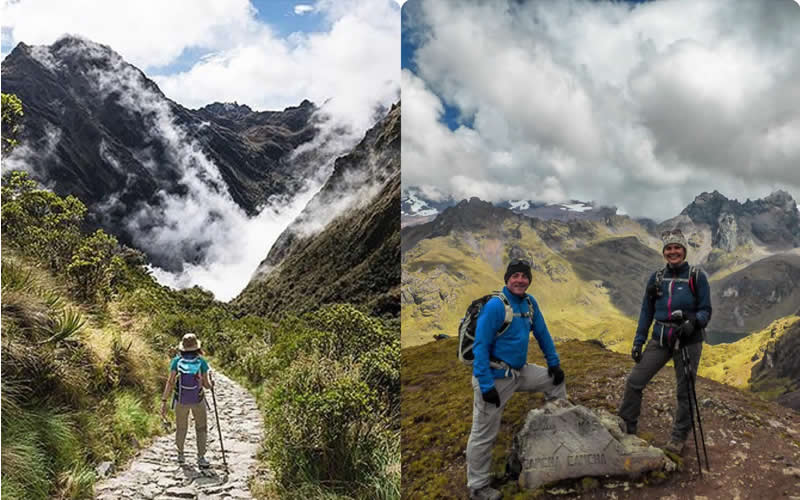
AVAILABILITY / FLEXIBILITY
Inca Trail.- Only 500 people are allowed to enter the Inca Trail per day, including tourists, guides, porters, and cooks. If you really want to do this hike, plan well in advance to secure your Inca trail permit. Otherwise, you will arrive at taking alternative treks.
Lares Trek.- There is no need to pre-book the tour months before, as it receives unlimited tour groups year-round. Just look for a reliable tour operator and ask for the tour, then they will begin to organize the hike. There is always availability.
Inca Trail.- Just like on the Lares Trek, winter months on the Inca trail are just the right time to go. Although the temperature is cold at night, the day hike is mostly enjoyable, having sunny days. However, if you are planning on hiking the Inca trail in summer, the weather is still nice (warm) but rain and fog can obscure the scenic views. See more about the best time to hike the Inca Trail .
Lares Trek.- Expect cold temperatures at night and early hours in winter running from May-August, but it turns out to be advisable months for doing the hike. (Temperature can dip below zero degrees). Whereas, in the summer months from December – March, the temperature gets warmer but followed by downpours. The rest of the year is mild.
MOUNTAIN VILLAGES AND LOCAL PEOPLE
Inca Trail.- Since the Inca trail surroundings are overgrown with bushes and vegetation, there is no mountain village settled, therefore no family is living in those secluded mountains. Only the first day you see some local stores and family houses, but nothing of that captures your attention much.
Lares Trek.- You will surely see local people, focused on their daily duties, most of them are farmers and llama herders worn in their traditional clothes as it is supposed to be in the great Incan times. Living in some adobe huts plastered with mud and securing the llamas and alpacas in compounds chained with stone or into woven wired fences in summer months.

Inca Trail.- No pack animal is allowed to enter the Inca trail. Besides protecting the damage that these animals can cause on the trail, the fact is that they can’t climb up and down on some of the steep stairs of the trail. Only manpower carries the hiking gear and food. All the tour operators hire the famous Inca trail Porters .
Lares Trek.- At the start of your hike, you will be presented with your Lares trek muleteers, and they will carry the food and the campings gear for the hike. Most of them come from the Lares valley, and after 3 days of work, they have to climb the high passes again back home. When work is low, they work on farming native potatoes and cereals.

TRAIL CLOSURES IN FEBRUARY
Inca Trail.- Yes, it closes for upkeep procedures.
Lares trail.- No, it doesn´t close in February.
HOW ABOUT CAMPING ESTABLISHMENTS?
Inca Trail.- The Inca trail porters set up the camping tents, one kitchen tent, dining tent, and passenger tents for overnight. For those who would like to take shower after the hike (nighttime shower), there are some shower stalls. As for the restrooms, there are only squat toilets, unless you find some proper toilets in the first-day hike but bear in mind these are private, so you will be charged by someone else.
Lares trail.- The camping sites are less crowded as the trail is less trodden and has several versions. About bathroom facilities, drinking water, and showers, there are only outhouse toilets so go prepared for it. Water may not be safe, therefore needs to be purified too. As for taking shower, it will depend on the time and weather. Usually, the temperature is cold, so you barely take a birdbath.

THERMAL HOTSPRINGS
Inca Trail.- It is important to clarify that you won’t find any hot springs in the mid-hike. The way you can get it is if you have an extra night at Aguas Calientes, so you can visit the Hotsprings just a few minutes away from the main square.
Lares Trek.- Whichever Lares trek version you take, you will have a chance to soak in the Hotsprings near Lares Town. It is a very nice spot where to relax. And Before starting the tour ask your tour operator if there will be time for it.
WHO SHOULD CHOOSE THE INCA TRAIL?
Now, if you are sticking more to the Inca trail hike than the Lares trek and want to enter Machu Picchu through the sun gate, it can´t be a bad choice. Now look, Unlike the Lares trek, the Inca trail boasts the incredible Inca trail ruins , and it is worth the hype to see them along the way. If you care more about History and like a jungle landscape than a high altitude trek, then book the Inca trail before the permits run out.
WHO SHOULD CHOOSE LARES TREK?
Take the Lares Trek to get to know about life in the Peruvian Andes mountain, because you will witness a more authentic way of life of the Quechua People living in this part of Cusco; and there you will have a chance to learn about their wisdom, religion as well as their philosophy. Besides only mountain villages and the local culture, enjoy the clear blue lakes, valleys inhabited by Alpacas , the alluring mountain peaks, and many marvels this trek has yet to offer.
written by our Tour guide Aldair
- Monday through Saturday 9AM - 1PM & 3PM - 7PM
- Sunday 5 PM - 7PM
- +51976510080
- [email protected]
- Marquez Street 250, Two Blocks from the Plaza de Armas (upper floor of the market, third door on the right)
SALES TEAM HOURS
- Monday through Saturday 8AM - 1PM & 4 PM - 7 PM
- Sunday is closed

- Sacred Valley
- Aguas Calientes
- Peruvian Amazon
- Short Inca Trail 2D
- Classic Inca Trail 4D/3N
- Inca Trail 5D/4N
- Luxury Inca Trail Tour 5D
- Lares and Inca Trail 4D
- Salkantay Inca Trail Trek 6D
- Ancascocha Trail 3D
- Ancascocha Trek 5D
- Huchuy Qosqo Trek 3D
- Lares Valley Cultural Trek 3D
- Lares Trek to Machu Picchu 4D
- Salkantay Trail 4D
- Salkantay Trek 5D
- Choquequirao Trek to Machu Picchu 7D
- Choquequirao Adventure to Machu Picchu 8D
- Choquequirao trek to Machu Picchu (with Vilcabamba) 9D
- Machu Picchu Tours
- Search Treks by Number of Days
- Ausangate Trek 5D
- Ausangate Rainbow Mountain Tour 5D
- Ausangate to Laguna Sibinacocha 6D
- Palccoyo Mountain Tour 1D
- Rainbow Mountain Day Trip 1D
- Rainbow Mountain Trek 2D
- Choquequirao Trek 4D
- Choquequirao In-Depth 5D
- Choquequirao to Vitcos Trek 8D
- Classic Inca Trail 4 Days / 3 Nights
- Inca Trail 5 Days / 4 Nights
- Classic Lares Trek 4D
- Lares Trail 5D
- Laguna Humantay Tour 1D
- Salkantay Trek 5 days
- Vilcabamba Trek to Espiritu Pampa 8D
- Waqrapukara Trek 1D
- Huchuy Qosqo 2D
- Inca Trail and Choquequirao Tour 12D
- Trek Choquequirao to Espiritu Pampa 15D
- Christmas Chocolatada Trek 5D
- Inti Raymi Tour 1D
- Q’eswachaka Bridge Tour 1D
- Qoyllur Rit’i Festival Trek 2D
- Qoyllur Rit’i Pilgrimage Trek 4D
- Virgen del Carmen Festival Tour 2D
- Cusco City Tours
- Cultural Immersion Tours
- History & Nature Tours
- Family Friendly Tours
- Why Choose Apus Peru?
- Our COVID Relief Efforts
- Pre Trek Acclimatization Tour
- Trekkers Wanted Group Treks
- Clean Up Treks
- How to Prepare for Your Trek
- How to Book
- Booking Conditions
- Extras, Upgrades & Add-Ons
- Equipment Rental & Upgrades
- Trekking in Peru
- How to Prepare
- Things to Do
- Family Travel
- Culture & Festivals
- Travel Sustainably
- Apus Peru: On the Trail
Inca Trail vs Lares Trek
Inca Trail vs Lares Trek…that is the question! Two of the best treks in Peru are the Inca Trail and the Lares Trek . Which trek is the best choice for you?
Maybe you’re planning your trip to Peru, know you want to hike, and are debating which trek you should choose . Or maybe you’ve just found out that the Inca Trail is sold out, and you’re wondering how the alternatives compare.
Whatever your reason for wanting to know more about the Inca Trail vs the Lares trek, you’ve come to the right place! We’ll tell you everything you need to know to make sure you make the right decision for you.
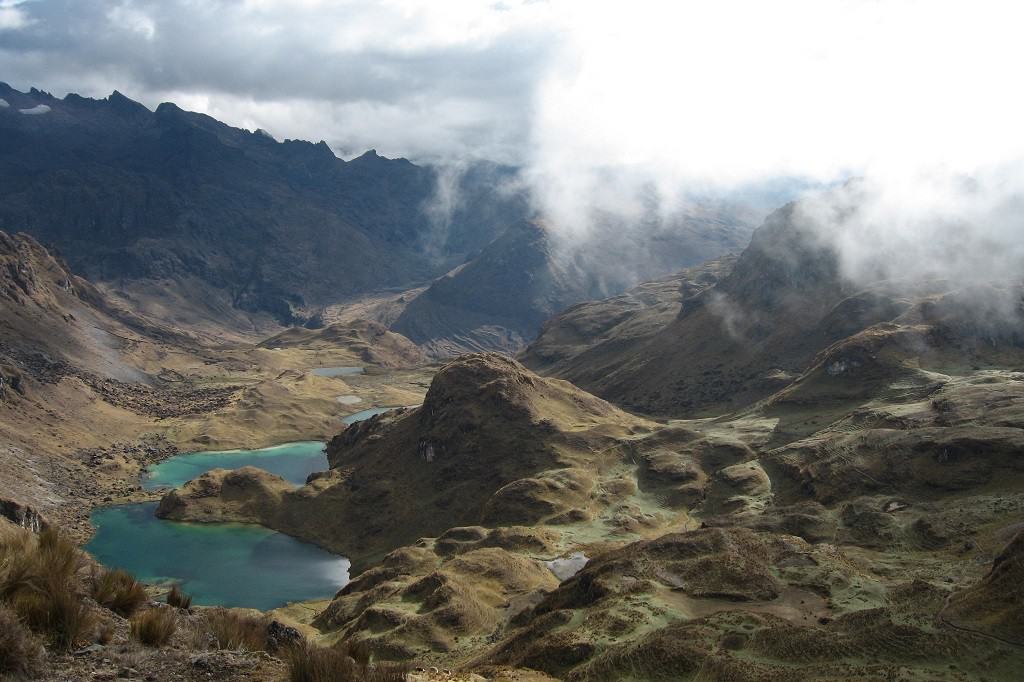
Table of Contents
What is the Lares Trek and What Makes it a Good Alternative to the Inca Trail?
The Lares Trek is a great alternative to the Inca Trail. Lares still retains all the stunning landscapes and the beauty of the snow-capped Andes that the Inca Trail offers, but you can experience it without having to deal with large crowds of fellow hikers.
In fact, the Lares track has remained largely untouched by tourism and it gives an insight into the Andean community and traditional culture that you would not be able to experience on the Inca Trail.
Along the way on the Lares Trek, you will pass through villages and farms and get the opportunity to interact with Peru’s Indigenous people and learn about their way of life. A unique experience!
STOP! IMPORTANT!
PLEASE TAKE NOTE OF THE NEXT SECTION AS IT WILL GIVE YOU A BETTER OVERALL UNDERSTANDING OF THE LARES TREK
The Different Lares Routes
When we discuss the Lares trek vs the Inca Trail trek in this blog we will be referring to these treks as a whole, but acknowledging that they are actually all quite different routes!
There is no ONE single Lares trek route near Cusco . The Lares Valley is a stunning mountainous region inhabited by Quechua people who continue to live their way of life as they did many hundreds of years ago. They farm these mountainsides growing potatoes and other tubers , and raising sheep, alpacas, and llamas.
Until the past 20 years, there were no roads into the region which meant that the people had a number of routes that took them to the villages. Those trails, crisscrossing the Lares region, make up the foundation of the Lares trekking routes.
However, in the past 20 years, and especially in the last 10, a great number of roads have been plowed through this pristine landscape, meaning that cars or trucks can travel to these villages, albeit slowly and only in good weather conditions. As much as we Western trekkers lament this progress, it does make the lives of the people much better.
Trekking routes have evolved to avoid the roads, although at some points it’s impossible to avoid them, as the lowest and best passes to cross logically now have roads across them.
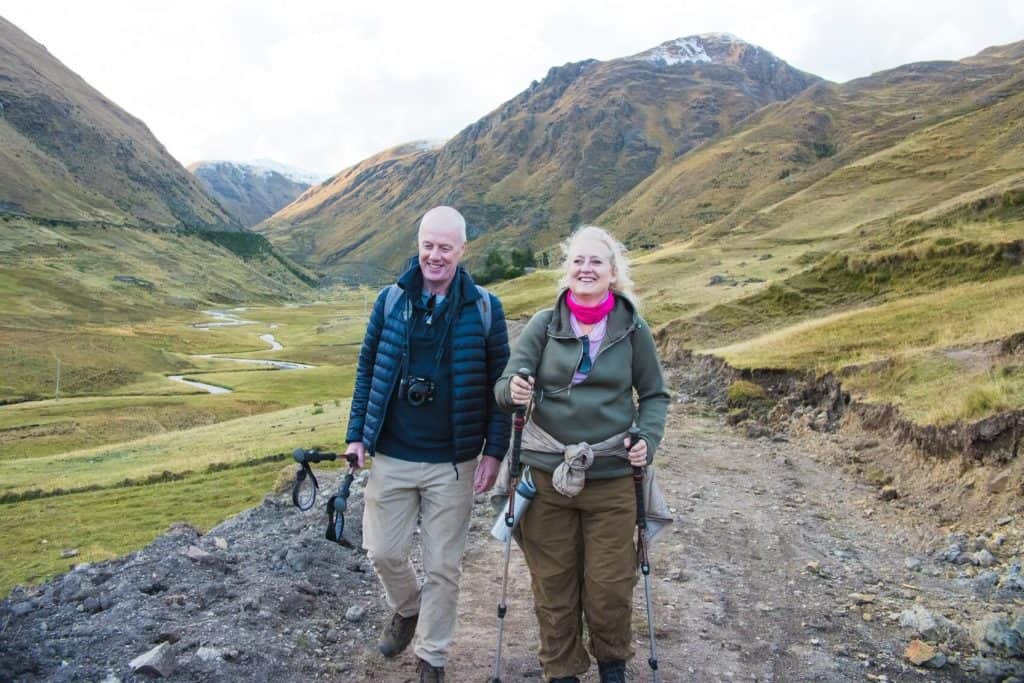
4 Day Lares Trek to Machu Picchu : The Most Direct Comparison between Lares and the Inca Trail
- First Day: Cusco – Ollantaytambo – Chaullacocha
- Second Day: Chaullacocha – Maranniyoc
- Third Day: Maranniyoc – Lares Hot Springs – Ollantaytambo – Aguas Calientes
- Fourth Day: Aguas Calientes – Machu Picchu – Cusco
This is the trek that we will primarily use to compare the Inca Trail vs Lares trek in this post. On the four-day Lares trek to Machu Picchu we visit the high Andean community of Chaullacocha. This is like stepping back in time, where community life remains largely unchanged since Incan times.
We continue the trek to the Lares hot springs before driving back to our starting point at Ollantaytambo to catch the train to Aguas Calientes. After an overnight in a hotel, we spend day four visiting Machu Picchu before returning to Cusco.
Read the full Lares to Machu Picchu trek itinerary here.
4 Day Lares Trek : Hiking from Huaran to Lares
- On Day 1: Cusco – Huaran – Cancha Cancha
- Day 2: Cancha Cancha – Quishuarani
- Day 3: Quishuarani – Cuncani – Lares Hot Springs
- On Day 4: Lares Hot Springs – Cusco
At Apus Peru, we call this the Classic Lares trek. It does not include Machu Picchu , but does include a chance to soak in the famous Lares hot springs on the last day of the trek. What a great way to relax sore muscles after four days of trekking!
Read the full Classic Lares trek itinerary here.
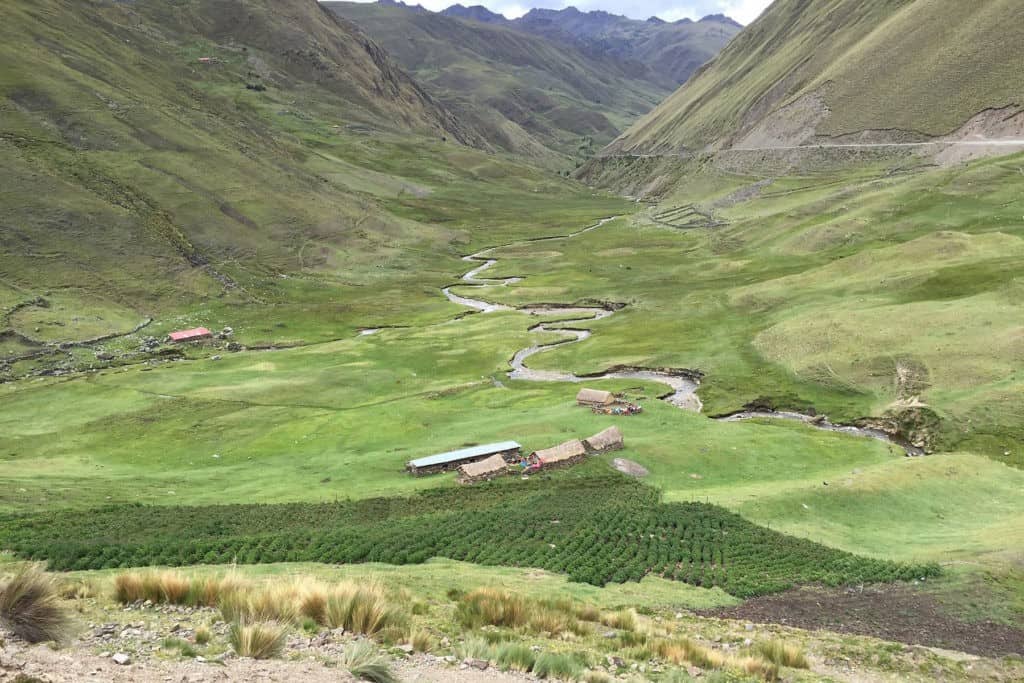
5 Day Lares Trek : A Special Lares Trek to Chaullacocha
- 1st Day: Cusco – Huaran – Cancha Cancha
- 2nd Day: Cancha Cancha – Quishuarani
- 3rd Day: Quishuarani – Cuncani – Lares Hot Springs
- 4th Day: Lares Hot Springs – Huacahuasi – Chaullacocha
- 5th Day: Chaullacocha – Meloqcocha Lagoon – Patacancha – Ollantaytambo – Cusco
Our unique 5-day Lares itinerary starts off like the classic 4-day trek before taking a turn on Day 3 to continue following the Lares trail over high mountain passes with stunning views, glacial lakes and sparkling waterfalls.
After a dip in the Lares hot springs, hikers venture back into the remote highlands for a unique excursion to Chaullacocha.
We have a special relationship with Chaullacocha – which means “fish lake” in Quechua – and you’ll have a chance to really immerse yourself in Andean culture, with opportunities to learn about Andean weaving, visit the local school, or even spend a night with a local family .
See the full 5 Day Lares itinerary here.
3 Day Lares Cultural Trek : An Immersion into Andean Culture
- 1st Day: Cusco – Lares Hot Springs – Maranpaqui
- 2nd Day: Maranpaqui – Chaullacocha
- 3rd Day: Chaullacocha – Ollantaytambo – Aguas Calientes – Machu Picchu – Cusco
A short but challenging trek takes you from the Lares hot springs up and over to Chaullacocha. Apus Peru has worked in community development in Chaullacocha and Chupani since 2007.
Unless you add an extra day in Chaullacocha for more cultural activities, Day 3 is spent travelling to and then touring Machu Picchu, before returning to Cusco.
See the full 3 Day Lares Cultural Trek itinerary here.
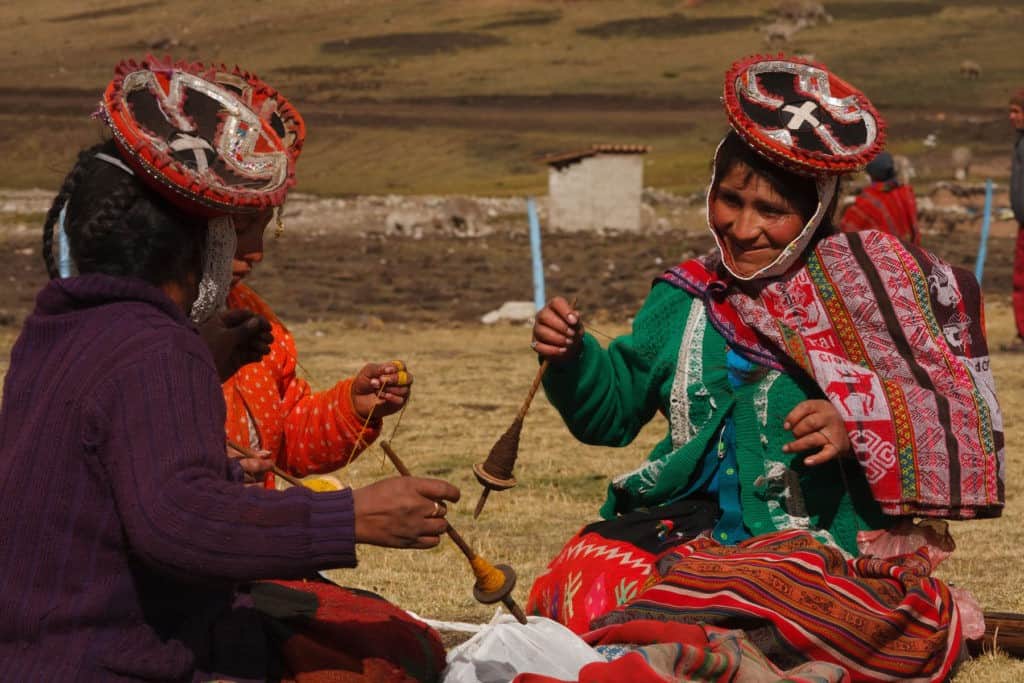
A Note About Lares & Cultural Immersion
One of the most important aspects of the Lares trail is the interaction with the local people. We believe that all trekkers to Peru want to do this in a respectful, non-intrusive way , one that does not turn the locals into a display for the tourists’ benefit while they are going about and living their daily lives.
One of the best ways to avoid this type of exploitation is to go with a trek operator that has deep connections with the communities, which are based on the Quechua concept of ayni (reciprocity) rather than exploitation or paternalism.
So deep are our ties at Apus Peru, that community members in Chaullacocha sent video messages to our Co-Founder in Australia during the pandemic, and she back to them in return!
Our multiple Lares trek routes are different than the norm and will get you off the beaten track. We have worked in community development in the Lares Valley communities since 2007, including supporting the local school. As a result, we have a very close relationship with the people there, many of whom work as part of our trek staff , from porters to cooks to muleteers.
Apus Peru’s sister non-profit organization, Threads of Peru , also works with the weavers of Chaullacocha. Travellers who hike many of our Lares Valley Treks often get a chance to visit the school and the weaving association – this is a totally different experience than the average Lares trek!
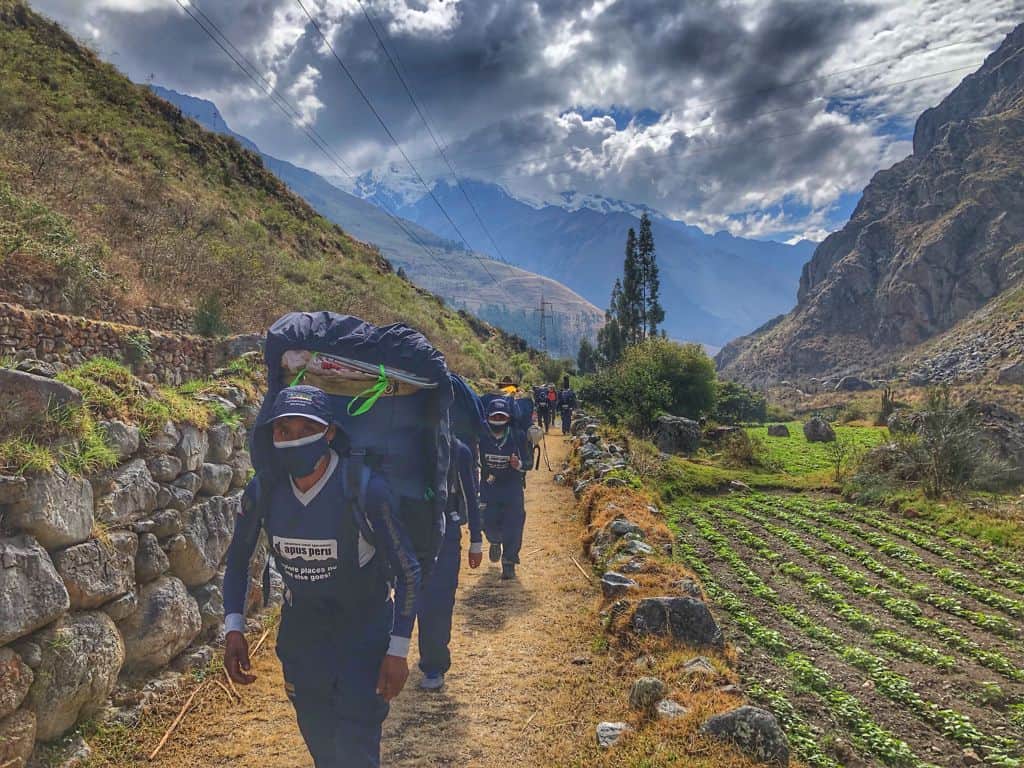
Lares Trek vs Inca Trail: What Are the Main Differences?
It is difficult to compare the Lares Trek to Machu Picchu with the Inca Trail. They are both classic treks that lead to the Inca citadel of Machu Picchu. They are two of the best treks in Peru. Which trek will best suit you?
The Inca Trail is, without doubt, the most famous trek in South America and as such, it is always busy and can get very congested. You need to book well in advance. It is a four-day trek and it passes primarily through Inca ruins, stunning scenery, and uninhabited areas.
The Lares Trek, however, is much less busy and much more of a cultural experience. It passes through villages and farms inhabited by modern-day Andean people and gives the opportunity to interact and learn more about the locals.
Both have their own set of trekking challenges. While the Lares Trek terrain is somewhat easier than the Inca Trail, it reaches higher altitudes. The two Andean treks also highlight different things: what the Lares trek lacks in Incan ruins, it makes up for in a contemporary Andean cultural experience. Both feature stunning scenery.
Keep reading for more of the differences between Lares and the Inca Trail!
Distance: Lares vs Inca Trail
INCA TRAIL : The classic Inca Trail route is the longer of the two treks and is 39 km or 24 miles. It starts in the Sacred Valley, in the area of Piscacucho, also known as Km 82, which is a small village on the railway line between Cusco and Aguas Calientes. Trekkers normally take four to five days to complete the trek.
LARES TREK : The 4-day Lares route to Machu Picchu is shorter, at about 30km (18.6 mi) and takes three days to trek plus an extra day for the Machu Picchu extension. The classic 4-day trek and the 5-day Lares trail are both longer, coming in at 40km (24.9 mi) and 69km (42.9 mi), respectively, but don’t automatically include Machu Picchu.
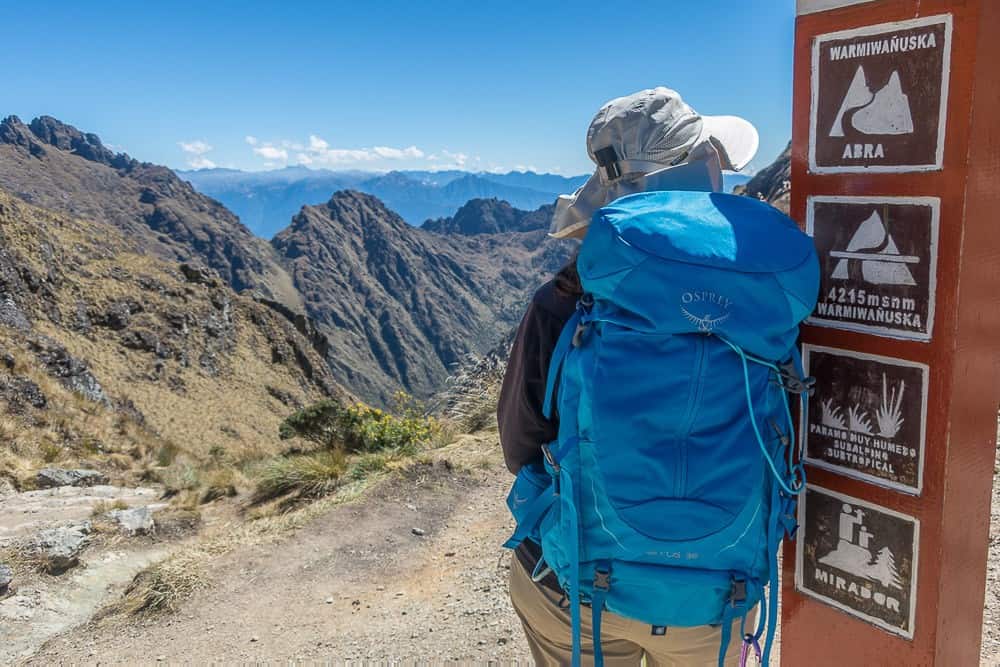
Altitude: Inca Trail vs Lares Trek
INCA TRAIL : The highest point on the Inca Trail is 4215 meters or 13,828 feet. This is known as Warmihuañusca, or Dead Woman’s Pass. You will additionally hike a second high-altitude mountain pass, Runqurakay Pass (4,000m). The highest located campsite on the Inca Trail is at an elevation of 3,600m.
LARES TREK : The altitude is higher on the Lares Trek. On the second day, you will reach the highest point at 4,800m. The highest campsite is at 4,220m. Ensure that you take all of the precautions necessary to prepare for the altitude .
Difficulty: Inca Trail or Lares Trek
INCA TRAIL : The Inca Trail is labeled a moderate difficulty trek, and is considered slightly more challenging than the Lares Trail. One of the biggest difficulties on the Inca Trail is STEPS! Google says that there are over 70,866 steps on the Inca trail, and some of them are big steps, about 10 to 12 inches high.
You will need to walk six to nine hours each day. The most grueling day is the second day when you go up and over Dead Woman’s Pass.
LARES TREK : The Lares Trek is also considered a moderately difficult trek. It is considered to be slightly less physically demanding than the Inca Trail, with more attenuated elevation gains and losses, even, rocky paths and no stone steps.
Read more about our difficulty rating system here.
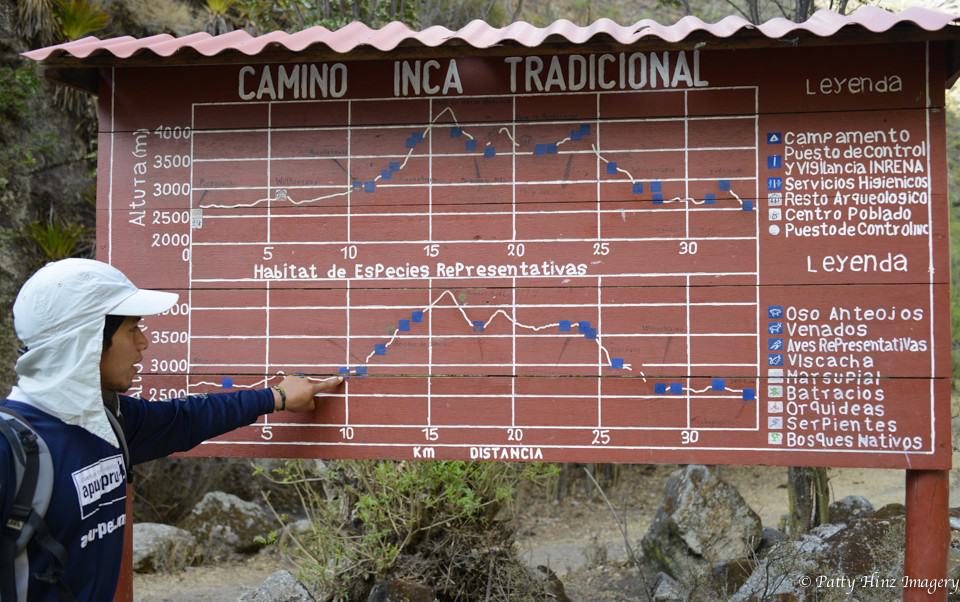
Availability: Lares vs Inca Trail
Availability could be an important deciding factor on which trek you choose, as not all treks are available year-round. Click here to check out our monthly chart on trek availability .
INCA TRAIL : The Inca Trail is fully booked nearly every day of the year, as just 500 people are permitted on this trail each day, including about 300 trail staff and only 200 hikers. It is easy for permits to sell out, especially in high season (May-August), and you should book at least six months in advance. You need to get a permit through an approved tour company.
The Inca Trail is also closed every February for regular maintenance. Due to treacherous conditions during the rainy season (Dec-Mar), we may not operate Inca Trail treks in January or the first part of March. Read more in our Wet Season Trekking policy .
LARES TREK : Though still subject to our Wet Season policy, the Lares Trek is one of the few trails that can usually be hiked all year round.
As you do not need any permits and it is less popular than the Inca Trail, you can book a trek to Lares as little as a week before your departure. However, at Apus Peru we encourage you to book at least a month in advance so that the trekking staff can plan their lives!
Scenery: Inca Trail vs Lares Trail
INCA TRAIL : I can say without hesitation, there is no route in the world that is quite like the Inca Trail, which does make it mighty special! You will get to see magnificent mountain vistas, a mystical cloud forest, fascinating Incan ruins, and the sunrise from the Sun Gate over Machu Picchu. Without a doubt, the Inca Trail has a great deal of stunning scenery!
LARES TREK : What the Lares lacks in variety of landscapes, it makes up for in stunning high alpine lakes and views across windswept, almost moon-like valleys dotted with stone houses.
But what you WILL get on the Lares Track in abundance that you will not get on any other trek in the Andes are fields dotted with people wearing their traditional dress, including handwoven ponchos, and very unique hats. It is NOT a show for tourists. They wear these clothes every day of the year. This view into a world long gone might not be described as spectacular scenery but it is a once-in-a-lifetime view, all the same.
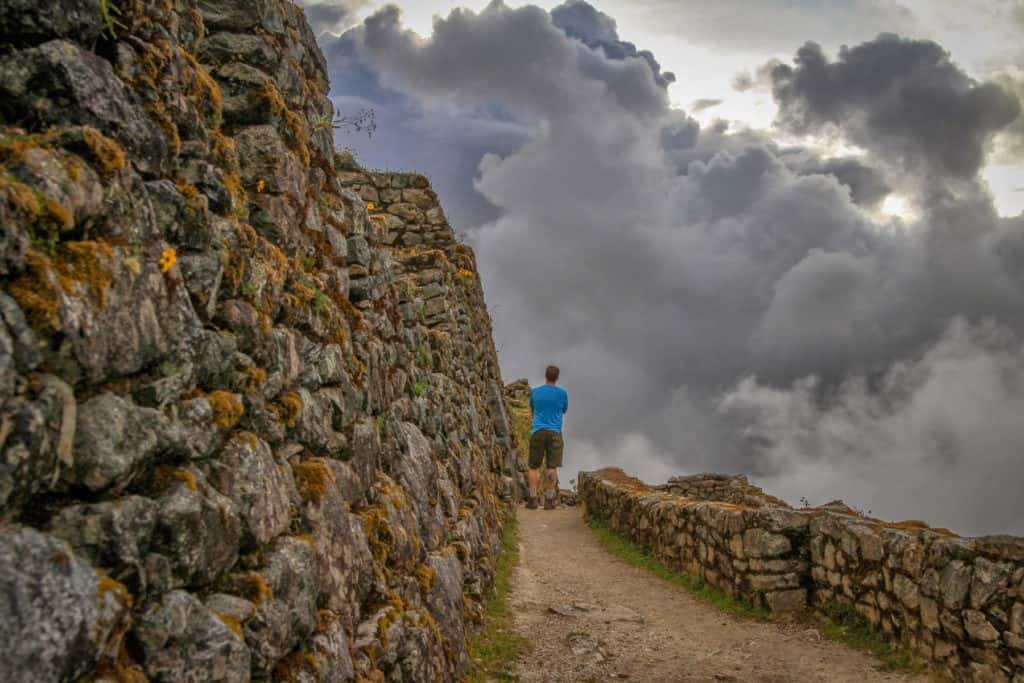
Remoteness & Adventure Ratings
INCA TRAIL : Retracing the footsteps of the Incas along a centuries-old stone path, part of the famous Qhapaq Ñan or Royal Way, and walking through the Sun Gate into Machu Picchu, a magnificent ancient site reintroduced to the world just over 100 years ago, is definitely adventurous. You’re like Indiana Jones!
The problem with the Inca Trail is that there are hundreds of Indiana Joneses hiking it every day. The Inca Trail is always busy and you will see a lot of other hikers and porters as you travel. You will frequently see, hear and interact with other groups
LARES TREK: The Lares Trek, on the other hand, is more “off the beaten path” and with considerably fewer trekkers and congestion to deal with and you don’t need any trekking permits.
When it comes to remote and unique experiences on a Machu Picchu adventure trek, there is no contest – Lares trek, Peru is a far more remote experience. You walk through remote villages and farms and get the opportunity to interact with the local people and learn all about their way of life. You will be trekking in the Sacred Valley through glacial valleys, lakes, waterfalls and see landscapes that have changed little over the years.
Facilities on the Lares Trek vs Inca Trail
INCA TRAIL : The Inca Trail facilities mostly involve government-managed campsites. These are mostly fairly basic and unfortunately are often insufficient to accommodate large numbers of hikers, with overcrowding and limited bathroom facilities. You can, however, upgrade to a more upmarket glamping option, which has privately set up bathrooms and offers gourmet meals. Porters are used for carrying equipment of up to 15 pounds per hiker and you only carry what you need for the day. There are only one or two squat toilet blocks along the trail.
LARES TREK – Everyone who hikes the Lares Trail to Machu Picchu camps for the first 2 nights, then the third night is spent at a comfortable hotel in Aguas Calientes. Unlike on the Inca Trail, mules carry all gear and equipment, rather than porters. Read more here about our camping equipment and what to expect on the trail.
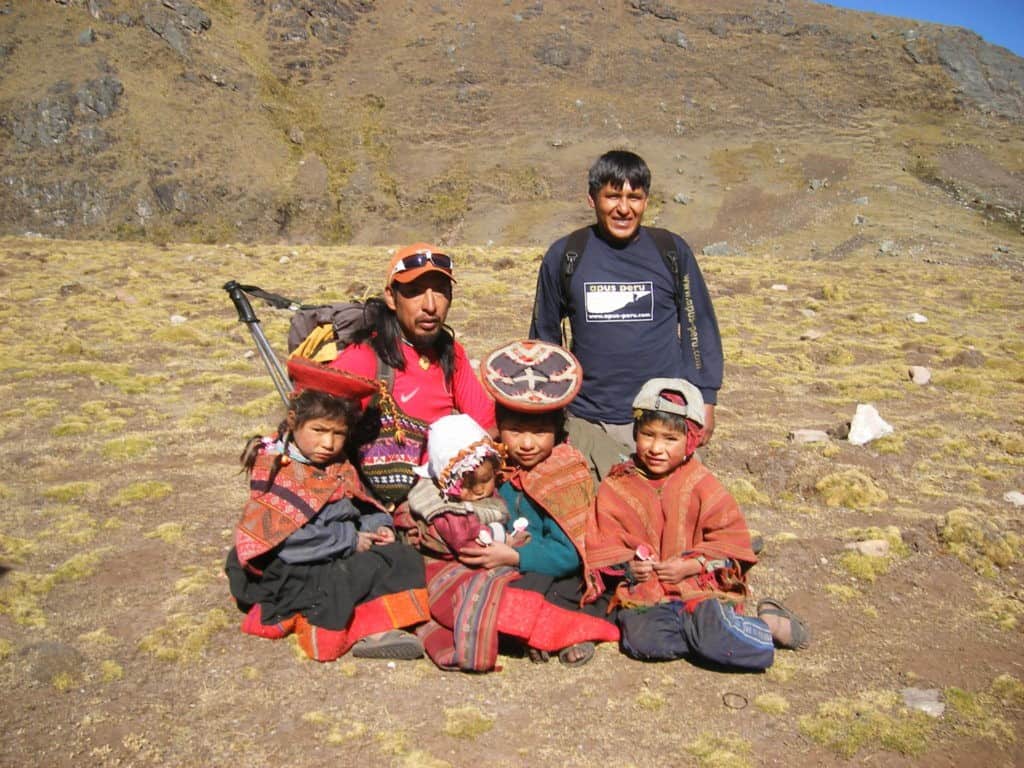
Family Homestays on the Lares Trek
Most of our Lares trek itineraries offer the unique chance to stay with a traditional Andean family in Chaullacocha.
Working in partnership with the local communities, Apus Peru heard the local people when they said that they wanted to diversify their income from tourism. Mostly, the income earned in the Lares Valley is via men working as porters on the Inca trail, or hiring out their mules and working as muleteers. Women earn a small income from traditional textiles working with organizations like Threads of Peru (get to know the Chaullacocha weaving association here ).
If you book a private tour with Apus Peru you can, at the same time, book a Peru family homestay, and support a local family and be welcomed into their lives. This is the epitome of cultural immersion and they have not had so many visitors that they are bored with meeting them (yet)!
A Luxury Lares Experience: Mountain Lodges of Peru
Most well known as purveyors of luxury lodge accommodation on the Salkantay route, the Mountain Lodges of Peru also have two lodges in the Lares region. These beautiful lodges are a fantastic place for people who want to get into the Peruvian mountains but don’t want to sacrifice comfort.
The lodges uniquely conceived through thoughtful architectural design include traditional Inca building techniques and a nod to their respective environments. They offer all the comforts of home along with top-notch amenities and exceptional service.
There are spots to relax and meditate at each lodge, welcoming patios, private guest room balconies, fire pits, and outdoor hot tubs-all with inspiring views of the region.
Lodge menus are comprised of traditional recipes prepared with innovative neo-Andean cuisine flair. Each ingredient is locally sourced with an emphasis on farm-to-table sustainability.
Local staff provides exceptional service and care from the moment you arrive: warm towels and refreshments in the afternoons, hot water bottles and herb-infused pillows at night.
It’s a wonderfully luxurious experience. Contact us for more details, or to book this experience on your Lares trek!
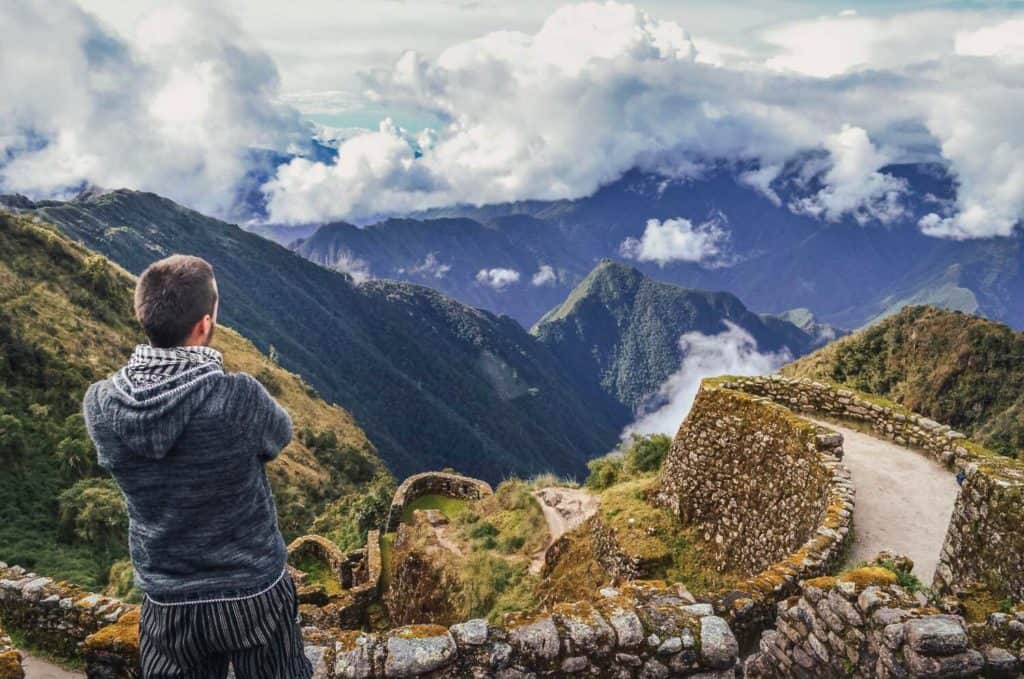
Which Route Is Best for Seeing Inca Ruins?
INCA TRAIL : Without a doubt, the classic Inca Trail is the best trekking route to see Inca ruins. There are at least five fascinating archaeological Inca sites scattered along the trail and best of all, you won’t have to contend with tourist crowds to see them. There will only be the other people hiking the trail who will have the opportunity to view these spectacular Inca ruins.
LARES TREK: There are no ruins on the Lares trek, with a few small caveats. Some agencies stop at the ruins of Ancasmarca en route to Lares town and hot springs, while others (like us) will make a detour to Pumamarca, which is a ruin below Patacancha.
Walking Through the Sun Gate
On the Lares Trail, you don’t arrive at Machu Picchu via the Sun Gate. How important is this to you?
In reviewing the pros and cons of the Lares vs Inca Trail conundrum, there is a general consensus that the biggest downside of the Lares trek is not being able to walk into Machu Picchu through the Sun Gate. For a lot of people, the Sun Gate is an interesting Inca construction and exciting because it marks the end of the Inca trail, and the entrance into Machu Picchu.
In our opinion, whether or not you get to walk through the Sun Gate into Machu Picchu shouldn’t be the deciding factor on whether you choose the Inca Trail or Lares Trek.
For starters, you can hike up to the Sun Gate during your tour of Machu Picchu at the end of your Lares trek. But for the best of both worlds, you can also do our Lares & 2-Day Inca Trail hike . This 4-day tour combines two days of hiking on the Lares trail with the 2-day Short Inca Trail. It won’t be at sunrise but on this journey, you do get to walk through the Sun Gate on Day 3 as you complete the Inca Trail portion of this combined trek. After a night in a comfortable hotel in Aguas Calientes, you visit Machu Picchu on the last day before heading back to Cusco.
The Weather: Best Months to Trek Inca Trail vs Lares Trek
As the crow flies, the Inca Trail and the Lares treks are geographically extremely close to one another, and therefore they are subject to the same weather. The temperatures for both treks during the year range from 0°C (32°F) to 27°C (80°F) and the average daytime temperature is 18°C (65°F).
In general, the driest, and therefore best months to trek, are from May through September. Shoulder months like April, October, and November are also good trekking months but you need to pack your wet trekking gear, just in case.
The Inca Trail is closed in February for maintenance due to the risk of rockfalls with heavy rain. Apus Peru does not operate the Inca trail from early January onwards, especially in particularly wet years, when the heavy rains loosen rocks from above and have killed trekkers in the past.
On the other hand, the Lares trek is excellent for wet season trekking, as it doesn’t have the same steep slopes or canyons found on most of the other treks in the region. Be prepared for some snow in the wet months – it usually isn’t heavy but is cold and an inconvenience.
Find awesome inspiration here for visiting Machu Picchu in the rainy season .
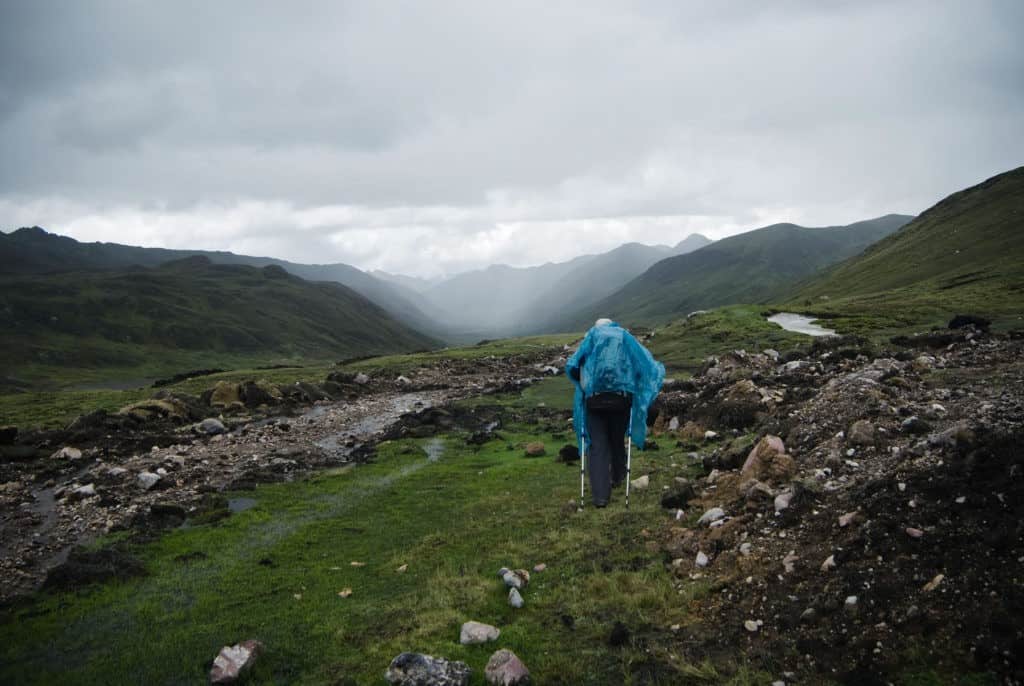
Comparing the Inca Trail to More Alternative Treks Around Cusco
While the Inca Trail is typically the first – or only – trek that comes to mind when thinking of Peru, there are actually a tonne of amazing trekking opportunities around Cusco. Any of these treks make a great alternative to the Inca Trail when it sells out. Here’s a brief taste of a couple of the most popular alternatives (other than the Lares trek):
Choquequirao
Choquequirao is an entirely different experience than the Inca Trail, but it tops our list as one of the great alternative treks because the Choquequirao ruins themselves really rival Machu Picchu.
Called the Cradle of Gold, Choquequirao is Machu Picchu’s “sister city” and is a spectacular Inca ruin. Currently only accessible on foot, it sees a fraction of the traffic that Machu Picchu does.
For more about how Choquequirao compares next to the Inca Trail, stay tuned for our forthcoming post.
Since the Inca Trail first started being regulated by the government, Salkantay quickly became the number two most popular trek to Machu Picchu. As a result, like the Inca Trail, the Salkantay trek can be quite crowded.
It similarly features stunning snow-capped peaks before descending to more tropical climes, challenging climbs and a series of Incan ruins, but it requires an overnight in Aguas Calientes before visiting Machu Picchu. Unlike the Inca Trail, you do not directly walk into Machu Picchu through the Sun Gate on the Salkantay trek.
Read more here about the Inca Trail vs Salkantay .
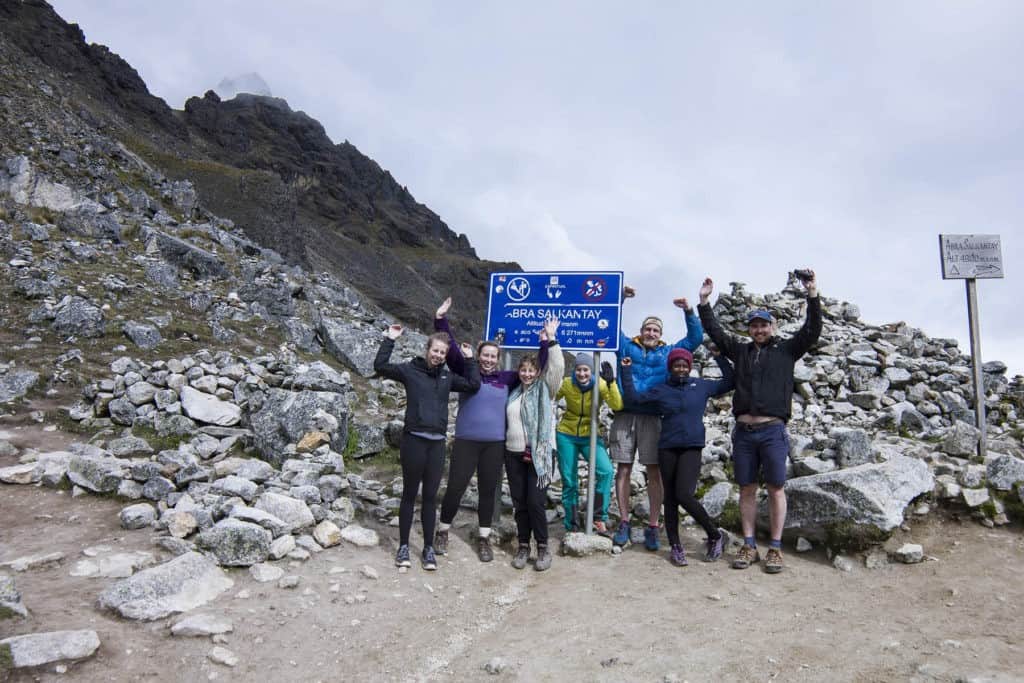
How does Salkantay compare to Lares vs the Inca Trail?
Here are some of the main differences:
- Both routes offer 4- and 5-day hiking itineraries;
- Salkantay gets busy, whereas the Lares Trek is a less congested, much more off-the-beaten-path experience;
- Salkantay can be quite challenging, especially the 4-day trek (read more here about how difficult Salkantay is ). By comparison, Lares is an “easier” trek (though by no means “easy”!);
- Lares is a year-round trek, and can usually be hiked even during the rainy season, while Salkantay is typically too dangerous to hike during those months (Dec-Mar);
- You can’t beat Lares for an immersive cultural experience in the Andean highlands, though on Salkantay you do get the opportunity to learn about traditional coffee-making.
Check out our blog for more about the differences between Salkantay and Lares as an alternative to the Inca Trail.
The Verdict: Which Trek Is Best for Me? Inca Trail vs Lares Trek
Whichever trek you choose, you will get to visit Machu Picchu and you can be sure the entire trek will be an amazing and totally memorable experience! Here are some final points to consider when debating the Inca Trail vs Lares Trek:
CHOOSE THE INCA TRAIL IF YOU
- Want to see as many Inca ruins and archaeological sites as possible.
- Wish to add the Inca Trail – the most famous and original trek to Machu Picchu – to your bucket list.
- Don’t mind sharing your trek with a lot of other trekkers.
- Have plenty of time to pre-book, as you will probably need to apply for your permit at least 6 months ahead of your trek.
- Want the chance to see stunning Andean vistas and mysterious cloud forests and cross the infamous 4215m Dead Woman’s Pass.
- It’s important that you walk into Machu Picchu via the Sun Gate.
CHOOSE THE LARES TREK IF YOU
- Prefer a less congested trek and a more peaceful trekking experience than the Inca Trail.
- Want to get off the beaten
- Wish to make the trek to Machu Picchu at short notice and at any time of the year.
- Want the opportunity for a more cultural experience. The chance to meet, learn more about, and interact with the local people in their remote villages.
- Visit Machu Picchu from Aguas Calientes on the last day.
- See stunning mountain scenery with waterfalls, lagoons, and mountain lakes.
Like it? Pin it!
Keep reading.
- Salkantay vs Inca Trail
- Lares vs Salkantay
- Choquequirao vs Machu Picchu
Leave a Reply Cancel Reply
Save my name, email, and website in this browser for the next time I comment.
Hiking in Peru
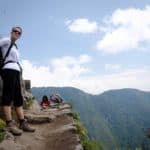
Peru Trip Planning
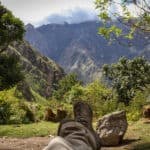
What our clients are saying about us
Apus on facebook.
https://www.facebook.com/ApusPeruAdventure/
Proceed Booking
Already a member, don't have an account create one., or continue as guest.
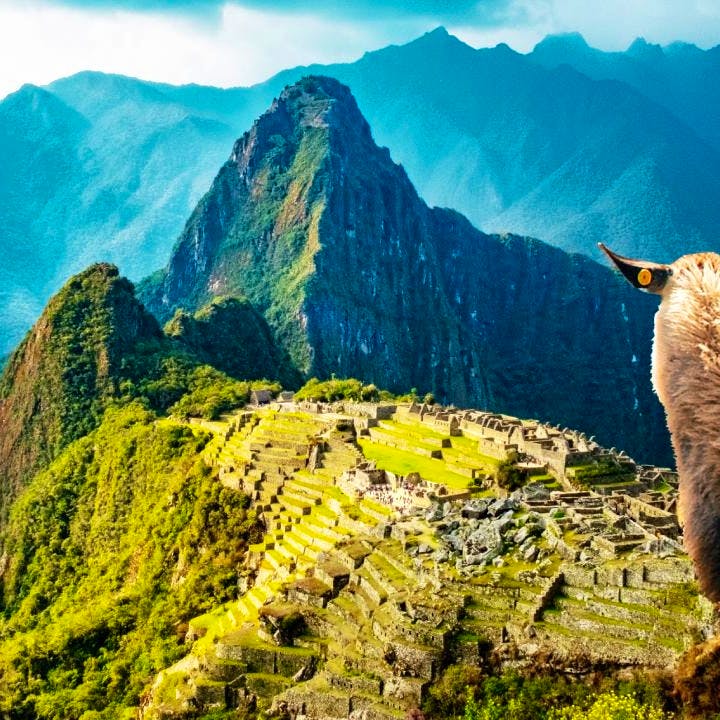
Lares Trek vs Inca Trail: A Detailed Look
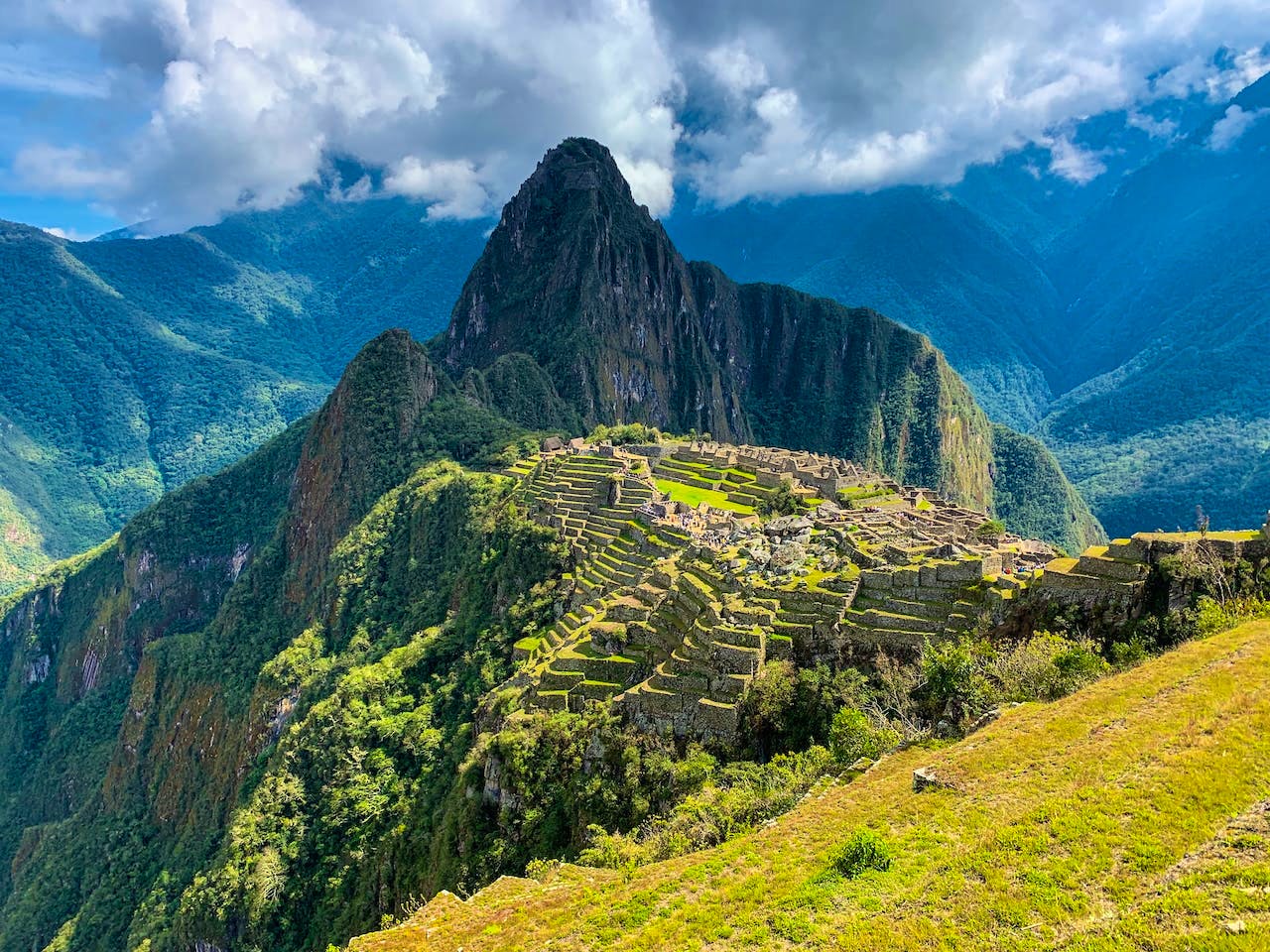
Inca Trail vs Lares Trek: Comparing Two Epic Treks
Meet the two treks: lares or inca.
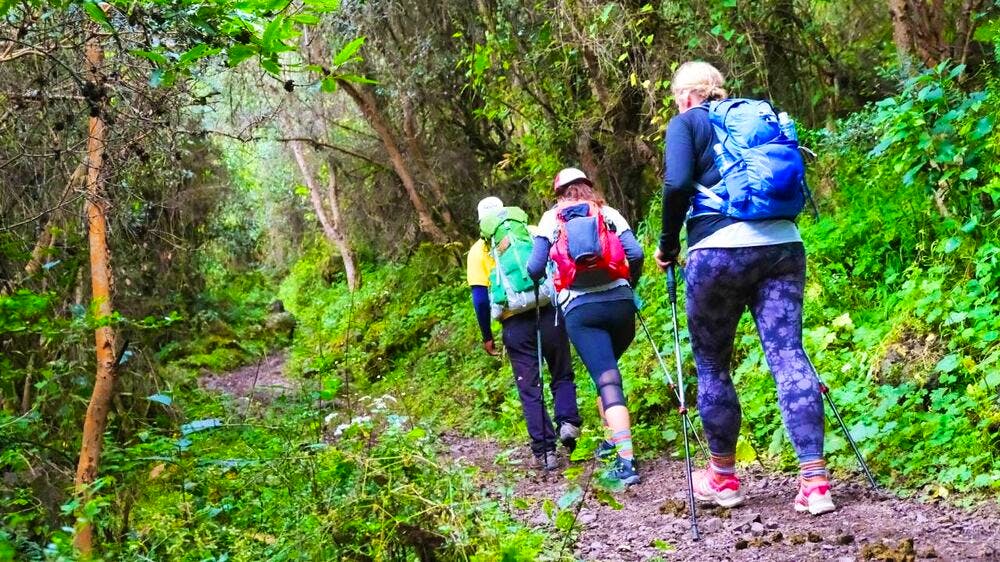
Lares Trek: An Overview
Who will like it, how difficult is it.
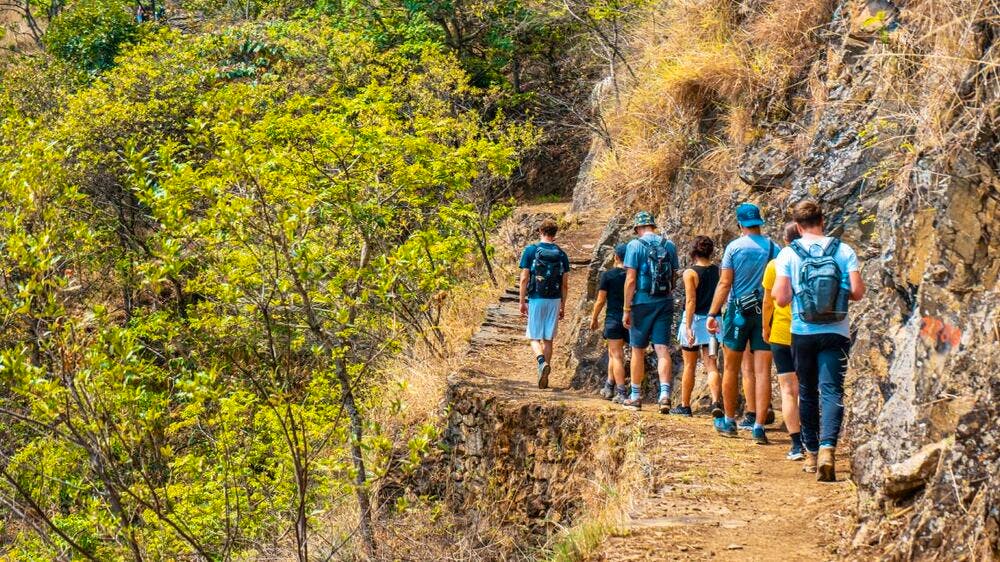
Inca Trail: An Overview
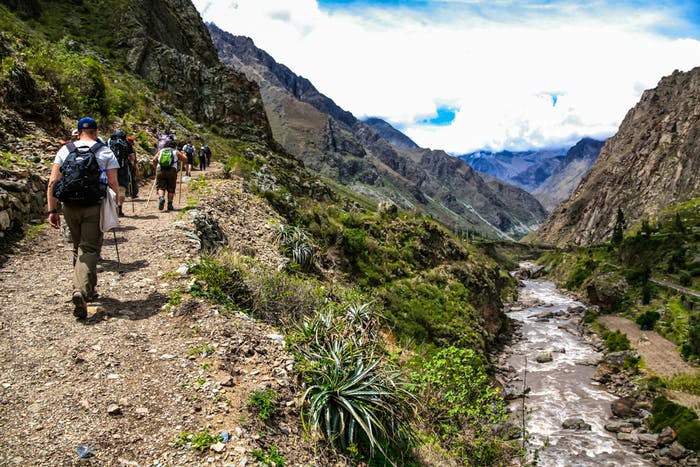
Comparing the Scenery
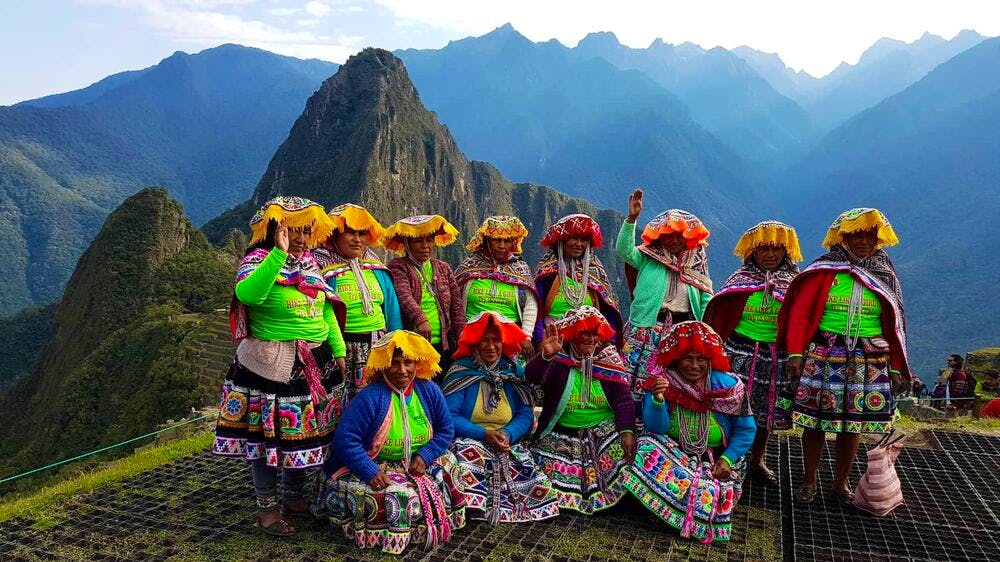
Cultural Experiences
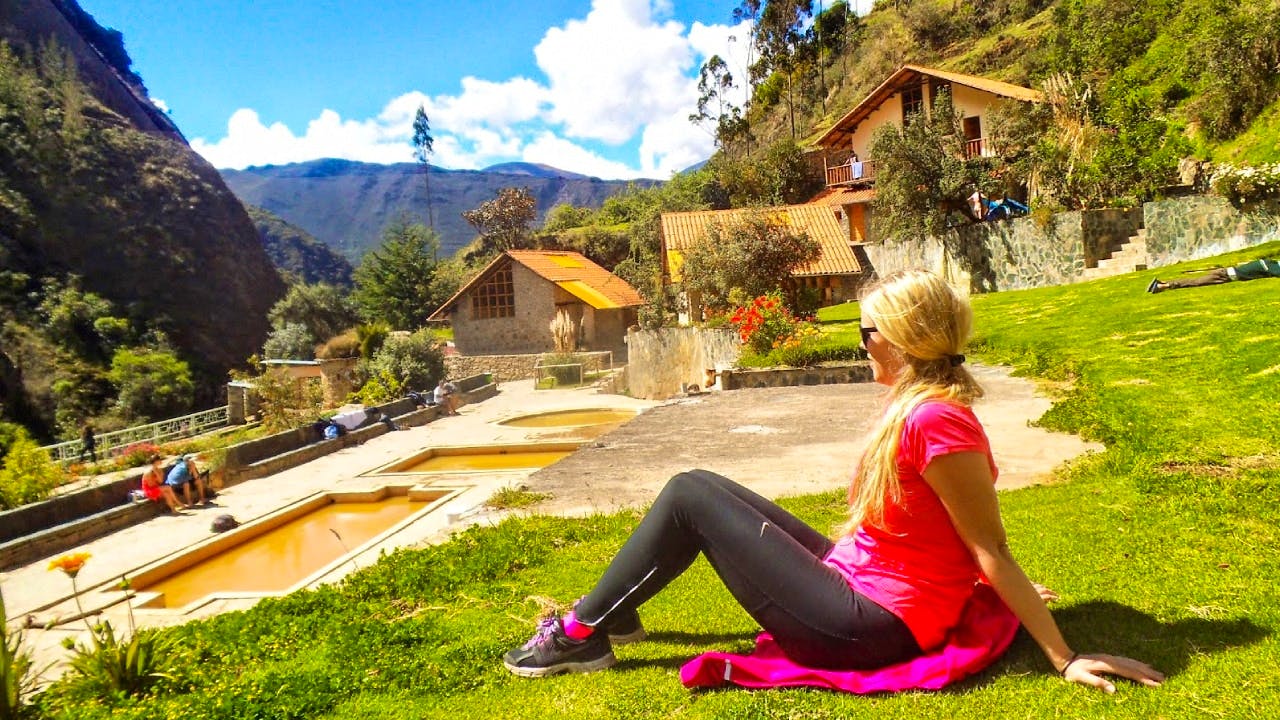
Historical Significance
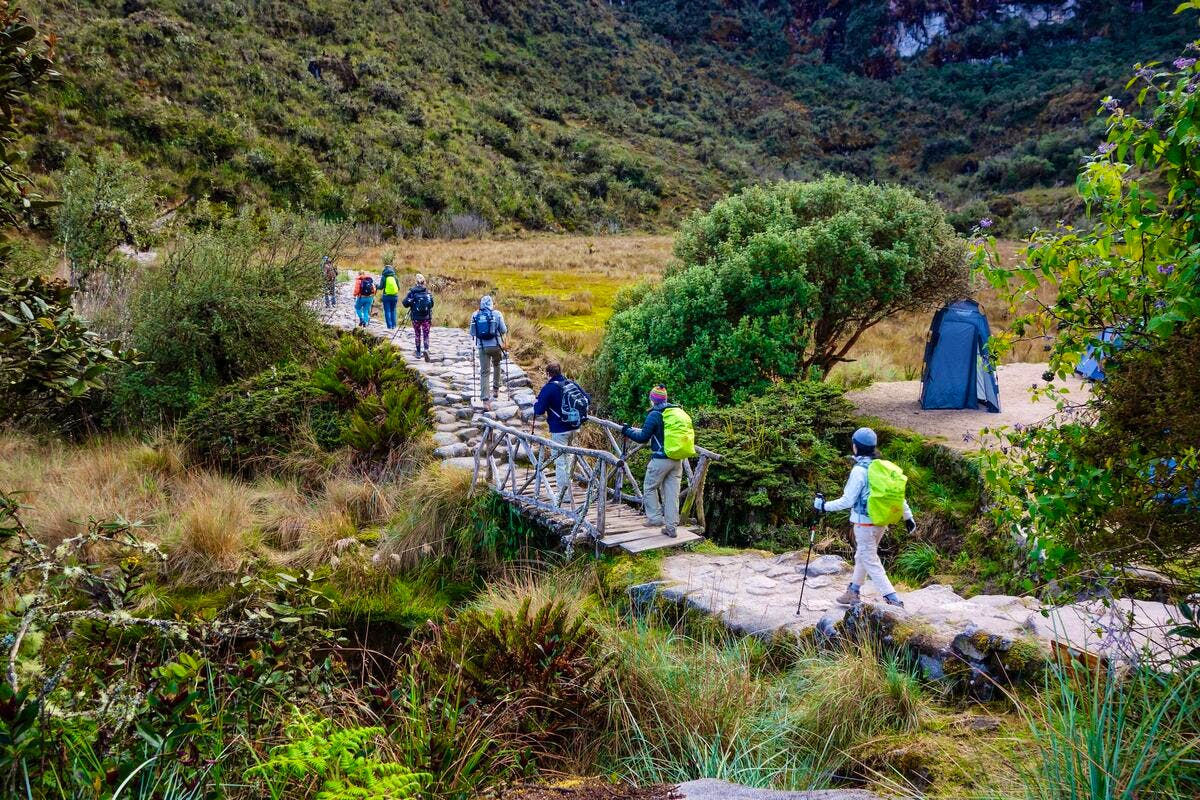
Difficulty and Altitude
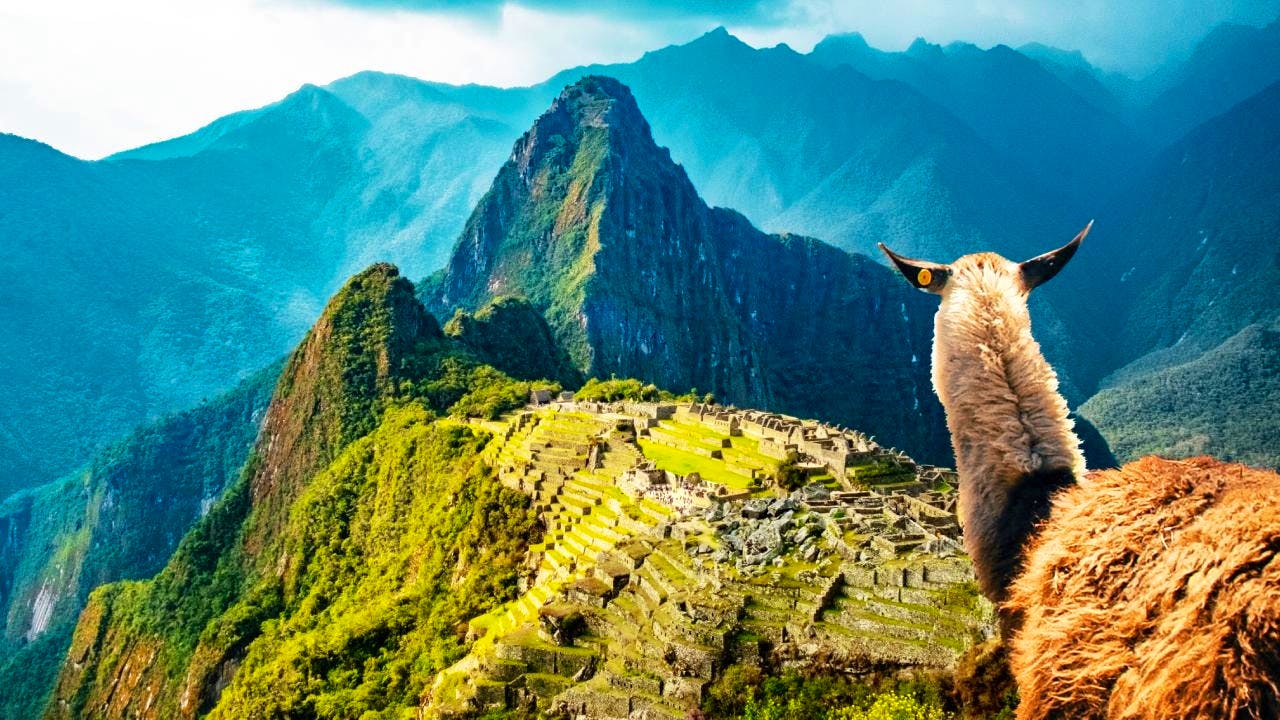
Wildlife and Ecology
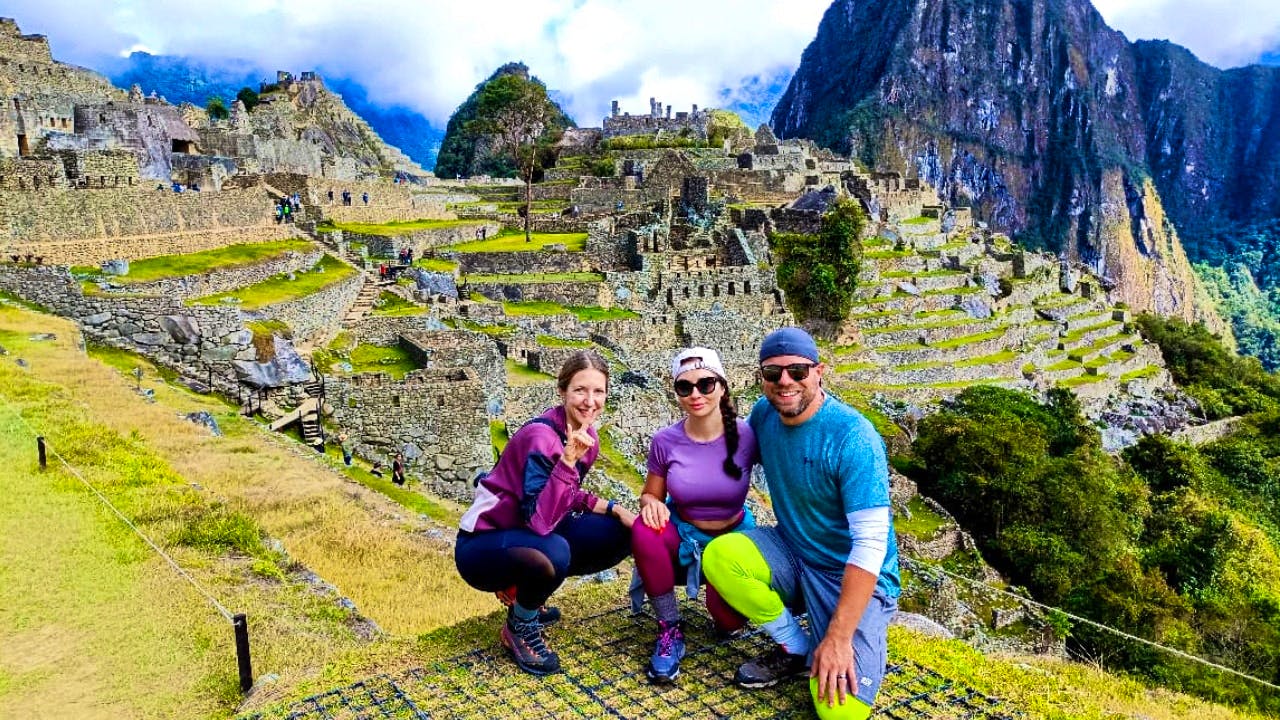
Final Destination: Machu Picchu
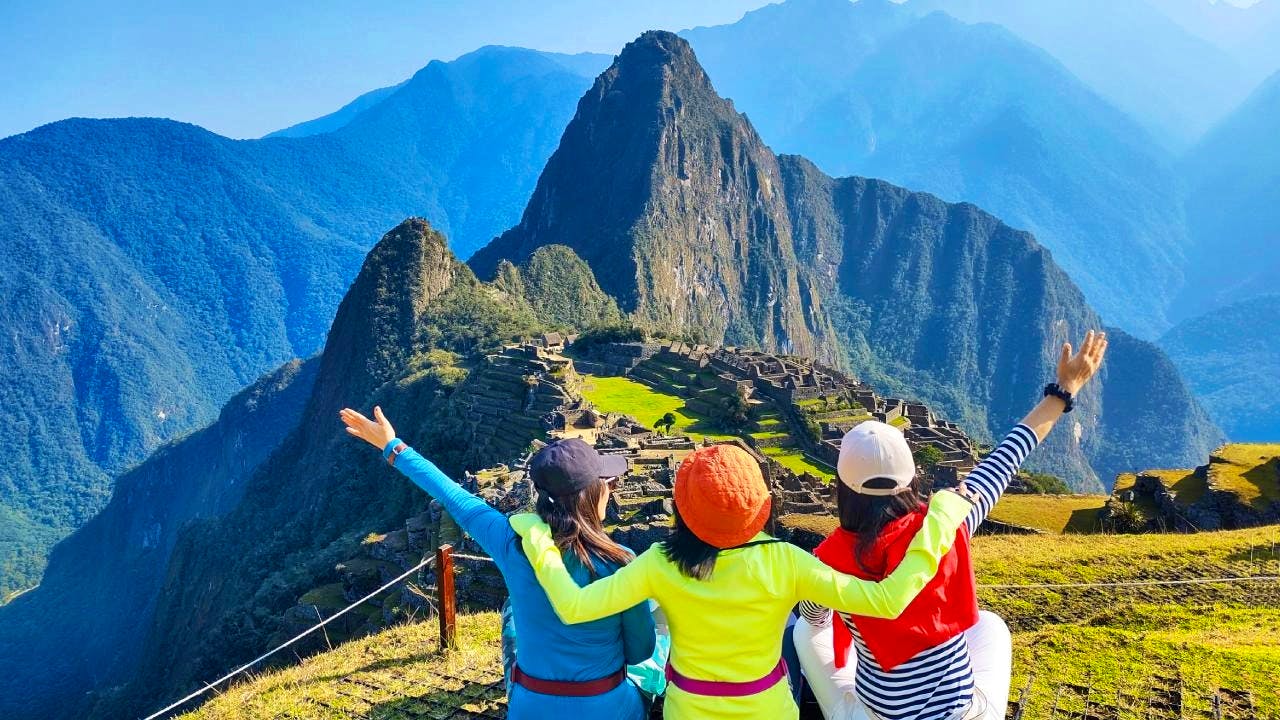
Other Machu Picchu Articles
Salkantay trek without guide
Salkantay trek vs Inca trail
Machu Picchu circuits
Machu Picchu deaths
Machu Picchu Stairs of Death
Huayna Picchu or Machu Picchu mountain
Machu Picchu permits
Why is Machu Picchu a good place to visit?
Temple of the Sun Machu Picchu
Things to do in Cusco Peru
Machu Picchu facts
Sun Gate hike Machu Picchu
Best travel insurance for Machu Picchu
Alternative treks to Machu Picchu
Salkantay trek packing list
Salkantay trek difficulty
Popular Machu Picchu Trips on Skyhook
Salkantay trek to Machu Picchu (8 Days)
Inca Jungle Trail to Machu Picchu (4 Days)
Inca Trail to Machu Picchu (7 Days)
Classic Inca Trail to Machu Picchu (4 Days)
Salkantay Trail to Machu Picchu (5 Days)
Lares Trek to Machu Picchu (4 Days)
Find your next adventure
Inca Trail vs Lares Trek – Which is the best route for you?
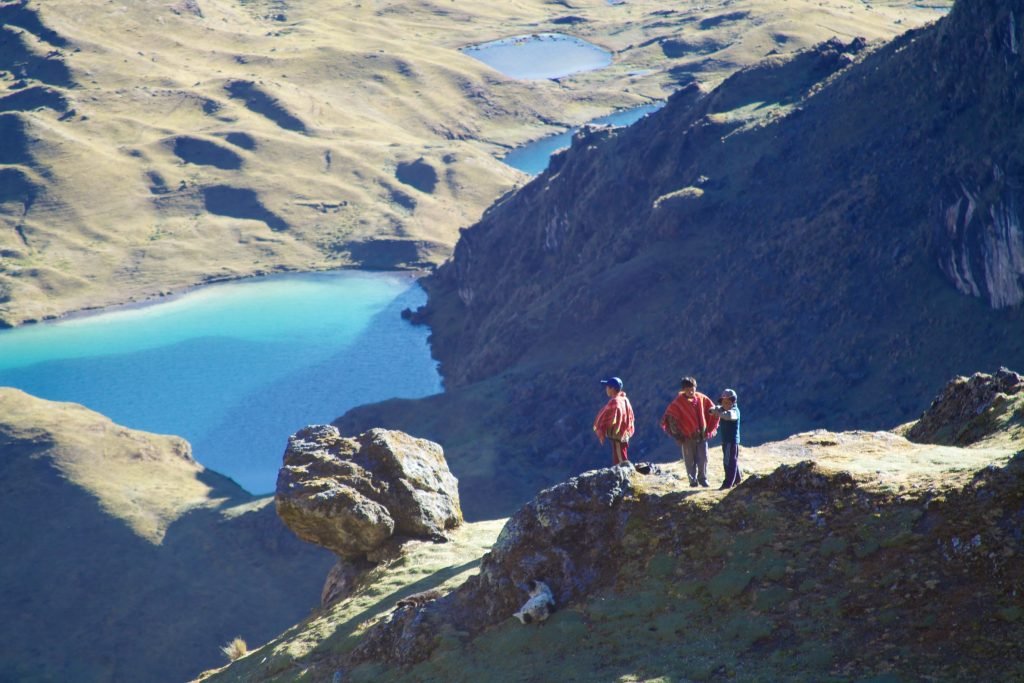
If you have doubts about which trekking route to take among these alternatives in this post Lares Trek vs Inca Trail, we will present you some of the main points to take into account so that you finally end up choosing the trek that best suits you.
The famous Inca Trail is undoubtedly one of the best trekking routes in the world which will take you directly to the citadel of Machu Picchu itself, and of course, entering through the famous Sun Gate where you will have one of the most wonderful panoramic views you can get of the place. Before arriving at Machu Picchu, you will hike through several Inca ruins and inhabited areas unreachable to tourists by any other means. The most common package is the 4-day Inca Trail trek , but shorter alternatives are also available to suit your itinerary.
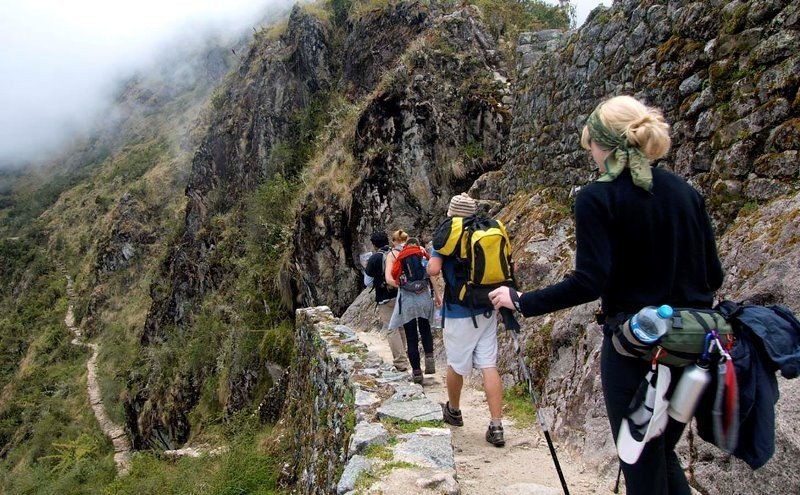
In comparison, the Lares Trek is a much less traveled and therefore less popular trekking route to Machu Picchu , so you will sometimes feel like it is just you and the surrounding mountains. The real satisfaction of hiking the Lares Trek is hiking through small farming villages far from Cusco society, which do not have electricity or potable water, you will interact with the children and the community itself, making the Lares trek a more immersive cultural experience, something the Inca Trail cannot offer.
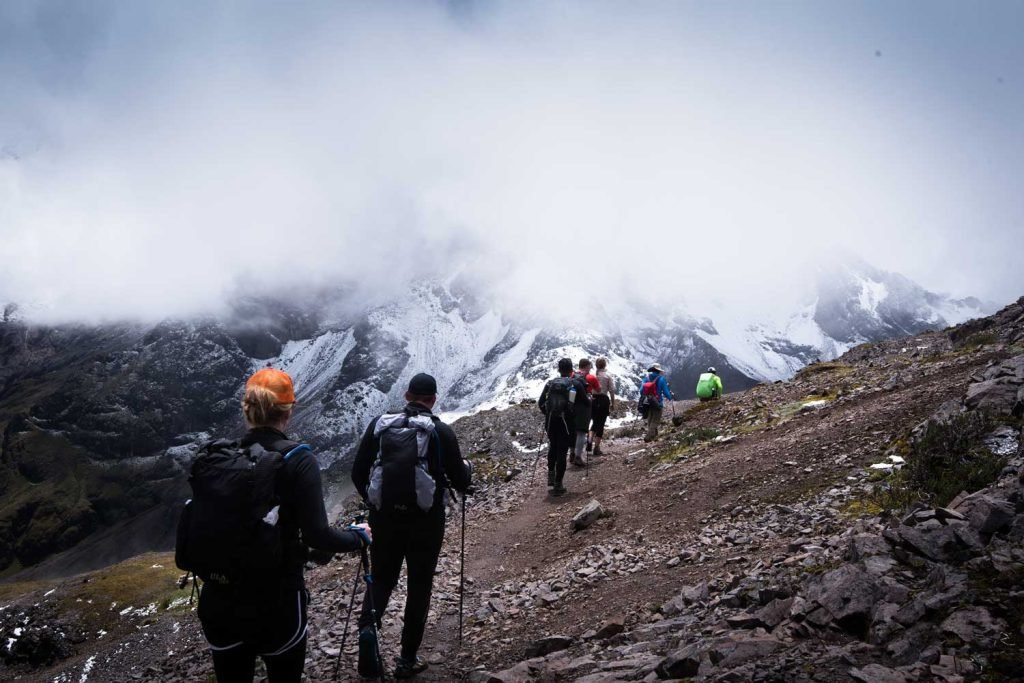
Highlights of the Inca Trail
On the last day of the trek you will get your first magnificent view of Machu Picchu as you walk through the Sun Gate. The views of Machu Picchu from the Sun Gate are amazing and give you a good perspective of the splendor of the Inca ruins long before you actually visit them.
The Inca Trail is the only trekking where you walk all the way to Machu Picchu, leaving you with the feeling of having reached your goal and with a pleasant sense of fulfillment. During the trek you will see many uninhabited landscapes, impressive Andean views and mysterious Andean rainforests. All of them unique landscapes of the diverse majesty that can be found in Peru.
Along the route, you will be able to visit several Inca ruins carved into the mountainside. The diversity of nature on the trail is beautiful: from the high passes of the Andes (the highest point is about 4200 meters above sea level) to the exuberant nature of the rainforest.
You will walk to Machu Picchu along mystical cobblestone paths built by the Incas, which formed part of a network of roads that linked their entire empire, called the Qhapaq Ñan (Great Road).
Low points of the Inca Trail
The Inca Trail does not have the cultural interaction that the Lares Trail can offer. Remember to book well in advance, as permits are limited and sell out months before your visit, especially when it is high tourist season between the months of May and September.
You should not expect solitude or quiet on the trail, as you will be walking with many other hikers and many porters.
All the campsites along the route are very crowded, sometimes it becomes complicated to take a picture or wait your turn to visit the archaeological complexes.
On much of the Inca Trail, especially on day 03, you have to descend stairs built by the Incas. The stairs are not easy and you have to take big steps, so your upper legs and knees will suffer a lot of pressure.
Highlights of the hike to Lares
On the Lares route, you will be surrounded by mostly untouched nature deep in the Andes Mountains, with lakes, glaciers, valleys, viscachas and grazing llamas, all of this also makes for a very pleasant landscape to visit and is a unique experience of connection with nature.
You will walk through small villages where you will have the opportunity to interact culturally with local families, especially children, and learn a little more about their culture.
The Lares hiking trail takes hikers off the beaten path and onto trails where fewer tourists venture, without straying too far from civilization. The only people you will see during your trip will be the inhabitants of the mountains and the surrounding nature.
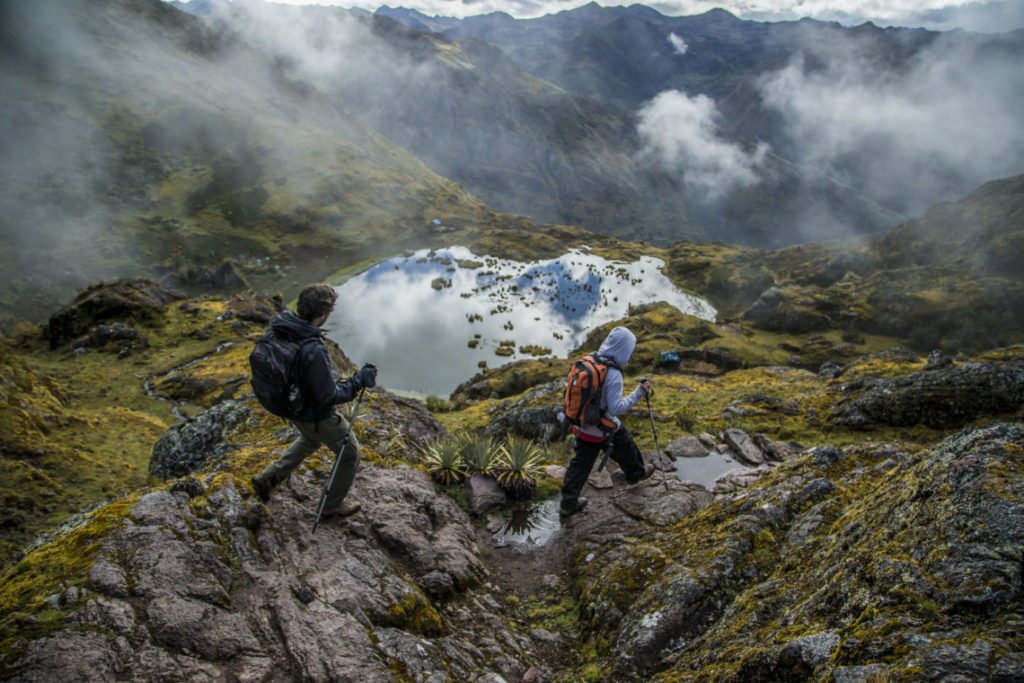
Low points of the Lares route
Machu Picchu is not reached through the Sun Gate. The last night of the trek ends in the town of Aguas Calientes, after which you will have to visit Machu Picchu the day after your arrival.
MOUNTAIN LANDSCAPES – Inca Trail vs Lares Trek
Inca Trail: On the Inca Trail trek, the surrounding mountain slopes are mostly covered with shrubs and trees, making it greener in coloration, and on a good winter day, you even get a glimpse of snow-capped peaks in the distance.
Lares Trek: On the Lares Trek you can see spectacular mountain scenery, snow-capped peaks near the mountain pass, glacier-fed lagoons, etc.
AVAILABILITY / FLEXIBILITY
Inca Trail: The Inca Trail has a quota limit of 500 people per day, including tourists, guides, porters and cooks. If you really want to do this trek, you have to plan and book well in advance to secure your Inca Trail permit. Otherwise, your only option will be to take alternative treks. Also, during the month of February this route is closed for maintenance work.
Lares Trek: It is not necessary to book the excursion months in advance, as this route receives unlimited tour groups throughout the year. Simply find a reputable tour operator and ask for this tour, then they will start organizing the trek. There is always availability.
CLIMA – Inca Trail vs Lares Trek
Inca Trail: As with the Lares route, the winter months on the Inca Trail are the ideal time to hike it. Although the temperature is cold at night, the daytime trekking is mostly pleasant, having sunny days and not too much rain to disturb your experience. However, if you are planning to hike the Inca Trail in summer, the weather is still pleasant (warm), but rain and fog can obscure the scenic views, as well as making the trails a bit more dangerous.
Lares Trek: Expect very cold temperatures at night and in the early hours of winter, from May to August, although these are the most advisable months for trekking (temperatures can drop below freezing). On the other hand, in the summer months, from December to March, the temperature is warmer, but there are downpours that complicate the transit through this route. The rest of the year there are no inconveniences.
MOUNTAIN VILLAGES AND LOCAL POPULATION
Inca Trail: As the surroundings of the Inca Trail are covered with bushes and vegetation, there is no settled mountain village, so no family lives in those lonely mountains. Only on the first day you will see a few local stores and family homes, but none of that will greatly capture your attention.
Lares Trek: You will surely see the local people, concentrated in their daily chores, most of them are farmers and llama herders dressed in their traditional clothes as in ancient Inca times. They live in some adobe huts spruced up with mud and secure the llamas and alpacas in stone chained enclosures or in woven wire fences in the summer months.
PORTERS – Inca Trail vs. Lares Trek
Inca Trail: Pack animals are not allowed on the Inca Trail. In addition to protecting the damage these animals can cause on the trail, the fact is that they cannot go up and down some of the steep stairs on the trail. Only the hand of man carries the trekking equipment and food. All tour operators hire the famous Inca Trail porters.
Lares Trek: At the beginning of your trek, you will be introduced to your Lares Trek porters, and they will carry the food and camping equipment for the trek. Most of them come from the Lares Valley, and after 3 days of work, they have to climb the high passes back home. When there is little work, they dedicate themselves to the cultivation of potatoes and native cereals.
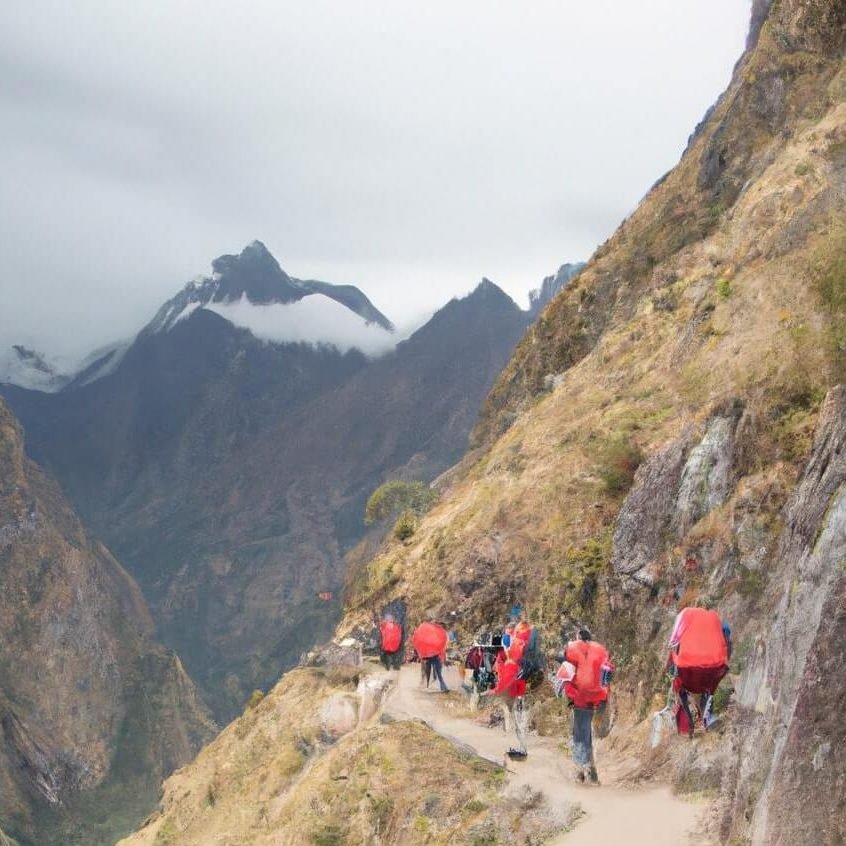
TRAIL CLOSURES IN FEBRUARY
Inca Trail: Yes, it closes for maintenance.
Lares Trail: No, it does not close in February.
ARE THERE CAMPING FACILITIES?
Inca Trail: The Inca Trail porters set up the tents where you will spend the nights in the campsites determined along the route, a kitchen tent, dining tent and all the necessary means for your comfort. For those who want to take a shower after the trek (night shower), there are some shower cabins installed in the camps. As for toilets, there are only toilets without seats, unless you find some suitable toilets on the first day’s hike, but note that these are private, so you will be charged for using them.
Lares Trail: The camping sites are less crowded, as the trail is less trodden and has several versions. As for sanitary facilities, drinking water and showers, there are only outdoor toilets, so be prepared for that. The water may not be drinkable, so it also needs to be purified. As for showering, it will depend on the time and weather. Normally, the temperature is cold, so you can hardly take a bath.
THERMAL WATERS – Inca Trail vs Lares Trek
Inca Trail: It is important to clarify that you will not be able to find hot springs halfway through the hike. The way to get there is to stay an extra night in the town of Aguas Calientes on the edge of the mountain that houses the citadel of Machu Picchu, so you can visit the hot springs that are just minutes away from the main square.
Lares Trek: Whichever version of the Lares Trek you take, you will have the opportunity to soak in the hot springs near the town of Lares. It is a very nice place to relax and have a good time before starting the tour.
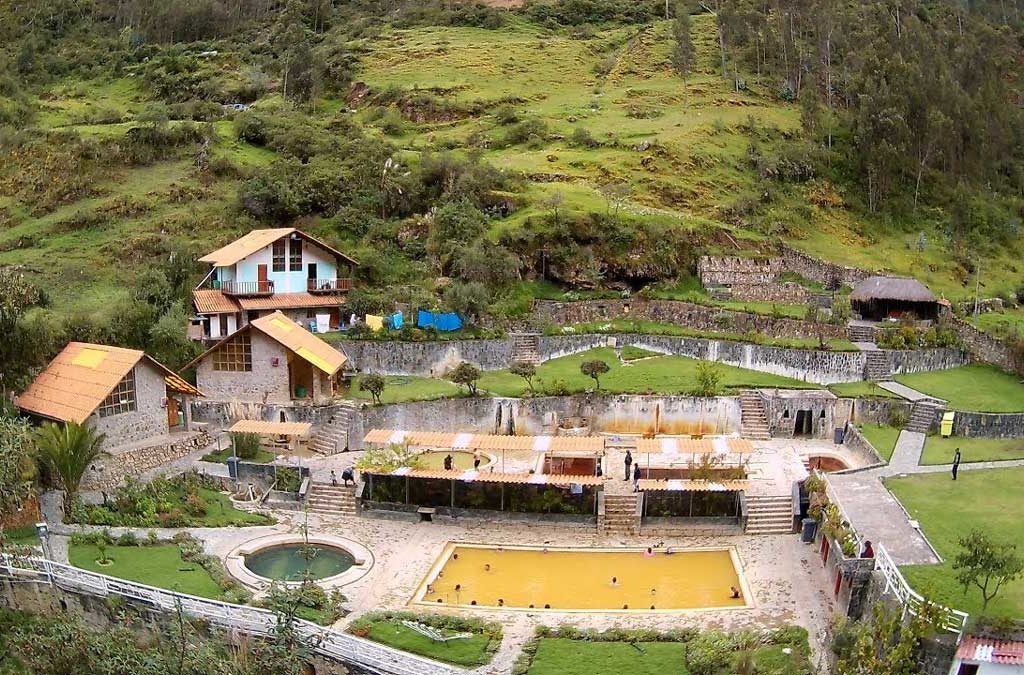
WHO SHOULD CHOOSE THE INCA TRAIL?
If you decide to take the Inca Trail route over the Lares trek you have to keep in mind that unlike the Lares trek, the Inca Trail features the incredible Inca Trail ruins, and it is worth taking this trail to see them along the way. If you are more interested in History and enjoy more of a jungle landscape than a high altitude trek, then you have to opt for the Inca Trail, but remember to book well in advance.
WHO SHOULD CHOOSE THE LARES TREK?
You should opt for the Lares Trek if you are more interested in life in the mountains of the Peruvian Andes, because you will witness a more authentic way of life of the Quechua People living in this part of Cusco; there you will have the opportunity to learn about their wisdom, religion as well as their philosophy. Besides just the mountain villages and local culture, you will also enjoy the clear blue lakes, valleys inhabited by alpacas, the seductive mountain peaks, and many wonders this trek still has to offer.
Related Posts

Best time to visit Rainbow Mountain Peru

Best company for Inca Jungle trek

Best Time to Visit Humantay Lake

Humantay Lake: How to get There
Leave a comment cancel reply.
Your email address will not be published. Required fields are marked *
Save my name, email, and website in this browser for the next time I comment.

Inca Trail vs Lares Trek – Which Is Right For You?
by Nicole Makarenco | Feb 12, 2018 | Articles , Destinations , Information | 0 comments

Choosing the Inca Trail vs Lares Trek – a tough decision
Which is best – Inca Trail vs Lares Trek? You would think that when traveling to Peru the most difficult decision would be what to pack, where to stay, and other unknowns involved with traveling to a faraway location. However, often the toughest choice is which trek to take to Machu Picchu. Most people have heard of the Inca Trail but there are many other beautiful trails in the region that are stunning and don’t require permits, such as the Lares Trek. Read the article below for more information about these two trails to help you decide! Written by our travel partner Plan Ur Escape and posted with permission. Check back with us in the future for a comprehensive post comparing all the available trails.
Originally published by Lorraine Whittemore
We are offering an amazing, fully inclusive tour to Machu Picchu via the Lares Trek. Many people have asked, what’s the difference between the Inca Trail vs Lares Trek and should we take this tour or wait until you offer an Inca Trail tour? Of course, we would love for you to join our Lares Trek tour, but in all fairness, we want to share more about these two options to help you make the best decision.
To try and stay neutral about this decision, let’s just explore the facts about each trek.
The Inca Trail

The Inca Trail is a very historic way to relive the path of the Inca people. You will, over the 4 days, get to see 7 small ruins that only those who make the hike get to see. You will spend a lot of time marveling and contemplating this section of “roadway” that was laid by Pre-Columbian people. The famous 4 Day Inca Trail represents just one small section of their overall extensive roadway system was 39,900 kilometers (24, 800 miles) long! Click here for more information on the ancient Inca Trail .
To trek the Inca Trail you must plan at least 6 months ahead because only 500 people are permitted to hike this trail each day. The 500 person limit includes tourists as well as all the porters required to carry camping gear, food, and more for your trip (this takes a lot of manpower!). There are no horses allowed on this trek as they would damage the stone steps. You must get a permit through an approved tour company, which will be checked along with your passport at various checkpoints as you trek along the trail. The Inca trail is much more touristy and you will see a lot of other hikers as you travel and MANY porters (move to the side to let them through). At night in the campsites, you will see, hear and interact with other groups. The paths are well traveled!
Do you like stairs? The Inca Trail has over 3000 stair steps, up and down, some very steep, some rough. You will travel through Cloud Forest, across high narrow bridges, through little caves and narrow walkways. There are many ascents and descents, day 2 being the most difficult to the famous Dead Woman’s Pass (4215m or 13,828 ft). You will hike up and down thousands of feet on this very long day.
You will see a lot of uninhabited landscapes and scenery while trekking. In total you will travel 42 kilometers (26 miles – same as a marathon!), which doesn’t sound like much over 4 days, but considering elevation, ascents and descents, it is quite strenuous. You will start at an altitude of 2799m (8858 ft) ascending to the highest point 4215m (13, 828 ft), Dead Woman’s Pass. On day 4 you will be woken at 4am to hike to the checkpoint, arriving at the ancient entrance of the Inca, the Sun Gate by approximately 7am (you miss sunrise over Machu Picchu). Your guide will stop you right before you enter for some preparation. It is quite a shock actually to come from the emotional and beautiful trekking experience and enter the crazy, noisy, crowded Machu Picchu. Personally, I felt it was quite anticlimactic and disappointing! Machu Picchu is amazing, of course, but seeing it with thousands of my closest friends after experiencing the Inca Trail was a bit of a let down.
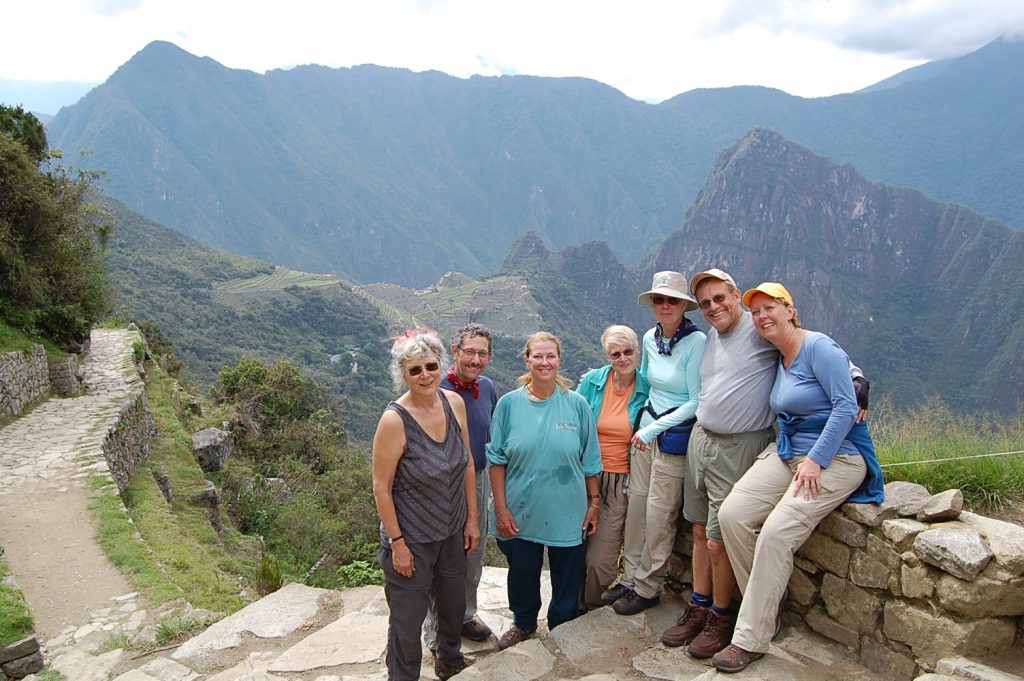
First glimpse of Machu Picchu after entering the Sun Gate
If you want “bragging rights” to say you accomplished this challenging and historic trail, then you should do it for sure!
The Lares Hot Springs Trek
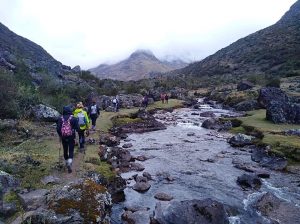
You will most likely not meet lots of other groups along the way. The experience is a bit more private, the campsites more remote and although it is still a challenging trail, it is less physically taxing than the Inca Trail.
After completing the trek, you will take the Vista Dome train (with large wide windows) to Aguas Calientes, where you will spend the night. You will be woken up before dawn to take the 25 minutes bus ride up to Machu Picchu and experience sunrise over the ruins before the crowds arrive. At this early time you will capture the essence of the spirituality in the ruins. After touring the ruins, you can hike up to the Sun Gate to experience what it’s like to enter Machu Picchu via the Inca Trail and to capture photographs and views from that angle.

So which to choose? Inca Trail vs Lares Trek?
Both treks have much to offer. Both provide you the opportunity to visit Machu Picchu. Here are the main deciding factors you should ask yourself. Is it important to enter Machu Picchu through the Sun Gate? Then hike the Inca Trail. Or is it important to have an “off the beaten path” experience interacting with locals and less traveled? Then choose the Lares Trek. In either case, you will have a life-changing, memorable experience, with a spiritual connection to the magic of the Inca and the Andes!
For more information about the luxury, 10-day all-inclusive Peru Trip, including a beautiful Lares Hot Springs Trek, visit our partner website by clicking here . Interested in this 10-day tour? Contact us or Lorraine from Plan Ur Escape!

Stay Connected
Join our mailing list to receive the latest updates and special offers
You have Successfully Subscribed!
Submit a comment cancel reply.
Your email address will not be published. Required fields are marked *

+51 986857391
Redes Sociales En
Find Us On:
Waman Adventures

- Machu Picchu
- Treks to Machu Picchu
- Festivities and Events
Lares Trek vs Inca Trail: Comparing Duration, Challenges and Experiences
Ultima actualización en 29 February, 2024 por Waman Adventures
Last Updated on 29 February, 2024 by Waman Adventures
Based on your travel expectations, which route would be most appropriate for you? Inca Trail or Lares Trek . Join us on this informative blog as we unravel the wonders and peculiarities of the Lares Trek vs Inca Trail . We will help you choose the perfect adventure for your next trekking adventure in the Peruvian Andes. Don’t miss the opportunity to discover the magic of these unique trails and find the one that best suits your travelling spirit!
WHAT ARE THE LARES TREK AND THE INCA TRAIL?
They are 2 of the most famous trekking trails you can do whilts your visit to Peru. So, whichever you choose, you will find incredible moments and experiences unique on each trek towards Machu Picchu, the most beautiful wonder in the world.
WHAT IS LARES TREK PERU?
It is known as the “ Cultural Route ” of trekking, which passes through high Andean villages meeting real Peruvian people. Also, it is the third most famous trekking route in Cusco .

Discover and take the best pictures of exclusive landscapes
WHAT IS THE INCA TRAIL PERU?
The Inca Trail Peru is a legendary and famous trail that leads you to the “ Lost City of the Incas ” in Peru, the World Wonder Machu Picchu. During Inca times this trail was part of the vast network of Inca Trails or “ Qhapaq Ñan “. Nowadays, it is the most famous trekking trail in South America and the only trail that allows you to reach Machu Picchu directly.

What is the Inca Trail Peru?
LARES TREK VS INCA TRAIL – ALTITUDES
The Lares Trek reach a higher elevation than the Inca Trail . This fact is important to consider before starting off any of these options. Furthermore, the Lares Trek route is in the Urubamba Mountain Range whereas the Inca Trail route is located near the Vilcabamba Mountain Range. The highest peak in the Urubamba Mountain Range is the snow-capped Veronica at 5,893 m/19,330 ft and the highest in the Vilcanota Mountain Range is the snow-capped Salkantay at 6,271 m/20,574 ft.
ALTITUDE OF THE LARES TREK
The Lares Trek has an average altitude of 3,500 m/1,482 ft ALS , tending not to have many altitudinal variations during the trek compared to the Inca Trail.

Witness the real Andean culture and people.
HOW IS THE INCA TRAIL ALTITUDE?
The altitude of the Inca Trail in its different versions ranges from 2,200 m/7,218 ft to 4,215 m/14,815 ft. Although this depends on the Inca Trail version you choose, the most notable differences are shown below.
Inca Trail Hike (4 or 5 days).
- Highest altitude: 4,215 m/14,815 ft.
- Lowest altitude: 2,709 m/8,900 ft.
Short Inca Trail Hike (2 days).
- Highest altitude: 2,730 m/8,956 ft.
- Lowest altitude: 2,100 m/6,892 ft.

The altitude is lower than the Lares Trek, so you will enjoy other ecosystems.
HOW LONG IS THE LARES TREK VS INCA TRAIL PERU?
Distance while trekking is an important factor in organizing your packing list, budget, etc. Whether you consider the Inca Trail or Lares Trek, both have different worthwhile distances for mountaineers. So, it is wise to consider having good physical stamina and training before starting the trek off.
HOW LONG IS THE LARES TREK?
Its distance ranges between 30 and 40 km or 19 to 25 mi , but the distance is up to the version you choose. Below we present some important facts about the Lares Trek distances.
HOW LONG IS THE INCA TRAIL?
Distances vary depending on your choice between the different trekking versions of the Inca Trail.
LARES TREK VS INCA TRAIL – VERSIONS
The lares trek peru versions.
- The classic Lares Trek: This is the most popular and well-known version. It is 4D/3N long. Along the itinerary, there are many campsites before reaching the hotel in Aguas Calientes. Even though you visit Machu Picchu on the last day of the trek, the highlight of the trek is the time spent trekking.
- Lares Trek + Short Inca Trail: This trek usually lasts 5 days and 4 nights. This option permits you to hike on a short Inca Trail’s stretch.
- Short Lares Trek: This is a quicker and less known version, as you will cover the same places, but in only 3 days and 2 nights. This option is tailored for travellers running out of time, but it requires trekking experience and training before starting this tough Lares trail route.
THE INCA TRAIL PERU VERSIONS
The duration of the Inca Trail depends on the tour you want to do, as you have several options such as:
- Classic Inca Trail (Best Seller): It is the most booked tour. It lasts 4 days, and 6 to 8 hours of trekking per day approx.
- Extensive Inca Trail: It lasts 5 days taking you by its trails and archaeological complex slowly. If we compare this option with the Classic Inca Trail, there is more time to enjoy the entire tour.
- Short Inca Trail: This is a lighter and simpler option, which only lasts 2 days and allows you to walk part of the original Inca Trail.
DIFFERENCES IN THE LARES TREK VS INCA TRAIL EXPERIENCE
Lares trek vs inca trail cultural experience.
Lares Trek is absolutely the best option if you want to interact and learn more about Peruvian culture by meeting real highland people. However, the Inca Trail passes through archaeological sites rather than towns.
LARES TREK VS INCA TRAIL – LANDSCAPES
You must keep in mind that the Inca Trail route passes through more habitats and ecosystems , so there are more different landscapes along the route. Alternatively, high puna grassland, intermountain valleys, glaciers, wetlands, lakes and others can be appreciated along the Lares Trek.
LARES TREK – SCENERY
The scenery along the Lares Trek is mountainous and tough to see. Sometimes you can stop and see lakes surrounded by wetlands, or you can stop and observe a valley with streams running down the main river.

Trekking in rugged terrain on the Lares Trek route!
INCA TRAIL – SCENERY
On the other hand, the Inca Trail stands out for the archaeological sites observed and explored while trekking. However, this does not mean that there is no nature, on the contrary, there are more ecosystems than the Lares Trek! The Inca trail owns the cloud forest which is a special habitat and can’t be found along the Lares Trek.

Some landscapes at some Inca Trail’s points.
FLORA OF THE LARES TREK VS INCA TRAIL
If you are focused on finding biodiversity along the trek you choose, I must tell you that the Inca Trail has wider biodiversity comparing the Lares Trek or Inca Trail. Why does it happen? Geography plays a big role in species distribution along the Andes Mountain Range.
LARES TREK – FLORA
Describing the flora along this route is a bit complicated. I could list some of the species you must find, but you need to consider that e very 100 meters of elevation the flora changes. In the intermountain valley exist Pines, Eucalyptus, False Pepper, Avocado and Capuli trees. If you ascend more, there are Queuñas, Uncas and Chachacomos in abundance. If you ascend ever more, some scrubs are present to finally just observe puna grasslands above 4000 m.a.s.l.

Flora along the Lares Trek route
INCA TRAIL – FLORA
The first 2 days of the Inca Trail present almost the same flora as the Lares Trek. The main difference starts in the last 2 days as you enter deep in the cloud forest. The cloud forest is a s pecial habitat for orchids, ferns, other species of trees etc! So, Lares Trek vs Inca Trail is incomparable in flora.

Wider biodiversity is found along the Inca Trail
FAUNA OF THE LARES TREK VS THE INCA TRAIL
As well as their flora, they have their own fauna depending on geography, altitude, rainfall, or ecosystem.
LARES TREK – FAUNA
It will depend on where you are trekking. If you are trekking near a rural area, it is probably to find out cows, mules, alpacas or llamas. However, if we trek within mountains far from towns, it’s possible to see deers, foxes and even pumas.

Some of the fauna species along the Lares Trek
However, there is also the possibility of spotting other animals such as birds and insects.
Wild animals in their natural state such as puma, Andean geese, foxes and the spectacular Andean Condor.
INCA TRAIL – FAUNA
Fauna on the Inca Trail is quite different here because you will trek through a preserve zone.
Rural areas are present only on the first day of trekking , then all changes! Along the path, there are exuberant fauna such as the Andean-Cock-of-the-Rock, Andean Bear, Pumas, Alpacas, foxes, endemic birds and so on.

Bringing a camera is one of the best ideas on the Inca Trail
LARES TREK VS INCA TRAIL ARCHAEOLOGICAL SITES
If you are an archaeological site enthusias t and you are in doubt about whether to choose the Inca Trail or the Lares Trek, the definitive answer is to choose the Inca Trail . This trail has wider archaeological sites to explore on each trekking day. However, you should remember that both trails end in Machu Picchu.

Some of the archaeological places along the Inca Trail
FACTORS TO CONSIDER OF THE LARES TREK VS INCA TRAIL
Lares trek vs inca trail difficulty.
Both trails have their challenges, which are based on the average altitude of each route, the terrain, the trekking hours and the season in which you decide to make the trip.
HOW HARD IS THE LARES TREK?
This trek is considered TOUGH, with an average of 6 hours of trekking per day . Due to its high altitude, it should be considered that travellers must be in good health and in good physical condition to complete the trek.

Enjoying a peaceful, beautiful and safe trekking day.
HOW HARD IS THE INCA TRAIL?
In general terms, the Inca Trail is considered TOUGH to CHALLENGING. So it’s more difficult than the Lares Trek because there are more mountain passes to conquer along the route. Despite its lower altitude than the Lares Trek, the effort that trekkers do is higher.

Ups and downs along the Inca Trail route
MAXIMUM ALTITUDE OF THE LARES TREK VS INCA TRAIL PERU
An important fact about both treks is that they reach their highest altitude on the second trekking day. So, I could say that this would be the most challenging day to face along these treks.
THE LARES TREK – HIGHEST ALTITUDE
As mentioned above, you will reach the highest altitude on the second day. The HIGHEST ALTITUDE is reached once you arrive at Sicllakasa Pass at 4,830 m/15,846 ft. Consider that from this point you must see the magnificent view of Pumahuanca Mountain (5,330 masl/17,486 ft) only if the weather permits.

Enjoy this unique experience at Lares Trek
THE INCA TRAIL – HIGHEST ALTITUDE
Face the greatest challenge along the Inca Trail by crossing the Warmiwañuska Pass at 4,215 masl/14,815 feet. Reaching this altitude allows you to take the best pictures of the surroundings. Don’t forget to thank Apus for allowing you to be there which is well worth it.

Warmiwañusca Pass or Dead Woman’s Pass
THE BEST SEASON TO HIKE THE LARES TREK VS THE INCA TRAIL
Both treks are located in the southern Peruvian Andes, you must know that we have two seasons in the year. The first one is the rainy season which runs from December to April; the second is the dry season, running from June to November! As a consequence, the best season to travel to Peru and book the best tour we have to offer is in the dry season.
It is wise to remember that trekking under a storm, muddy trails, hail or snow is very tough or challenging! So, if you don’t have trekking experience, trekking the Lares Trek vs Inca Trail during the rainy season could end badly. Furthermore, the Inca Trail is closed in February, but the Lares Trek is open throughout the whole year.
AVAILABILITY AND RESTRICTIONS OF THE LARES TREK VS INCA TRAIL:
This is a common question; is easier to book the Lares Trek vs Inca Trail? The Inca Trail Peru is, for sure, the most famous and main trekking route in Peru, then it has less availability and more restrictions related to the route.
On the other hand, the Lares Trek is more accessible to book and organize, and this trek is not as crowded as the Inca Trail, creating a different atmosphere during the trek.
INFORGRAFIA
EXPECTATIONS OF THE LARES TREK VS INCA TRAIL
Whether you choose the Lares Trek or the Inca Trail, you will find that both trails will far exceed your expectations , as they have been well-designed by allowing you to explore, learn and trek without being rushed. Also, each of them has its own unique attractions . If I need to choose between the Lares Trek vs Inca Trail, I choose the Inca Trail!
SUMMARY OF THE HIGHLIGHTS OF THE LARES TREK VS INCA TRAIL
Below, discover the most important differences that will help you choose between the Lares Trek or Inca Trai l, taking into account the most relevant highlights of each trek. Remember that whatever your choice is, you will experience an incredible trekking route towards Machu Picchu.
LARES TREK VS INCA TRAIL – FINAL RECOMMENDATIONS
Is the lares trek for me.
The Lares Trek is for you if you’re interested in real Andean culture, living some hours with them or maybe learning their traditions despite archaeological remains along the trekking route. Consider that the Lares Trek is better if you are looking for a noncrowded route in the Andes and before the trek ends, you will have plenty of time to relax your body in the Hot Springs of Lares.
THE INCA TRAIL FOR ME?
The Inca Trail is almost always the best choice because of its popularity around the world. If you are interested in trekking the most famous route in South America, a wider biodiversity, exclusive campsites and archaeological sites that only the Inca Trail could reach, the Inca Trail is for you. Consider that the Inca Trail costs more and has a maximum capacity of only 500 people could enter each day. If this list doesn’t fit with your expectations, it’s wiser to spend your money elsewhere.

Your ideal adventure if you are a traveller in search of stories and unique photographs of archaeological sites.
TRAINING FOR THE LARES TREK VS THE INCA TRAIL
In reality, there is no substantial difference between preparing for the Lares Trek vs Inca Trail . Both have almost the same challenges such as altitude, hours of trekking per day and the length of the trek. By following these tips, you will be prepared for any trek you choose.
- Cardiovascular exercises: you must strengthen your respiratory and cardiac resistance, because during the trek you will climb to more than 4000 m.a.s.l., so the lack of oxygen will be a determining factor even more if you’re not well acclimatized.
- Muscle strengthening exercises: Despite it’s true that your luggage (06 kg) will be carried by our porters or mules (up to the trek), you must consider carrying your necessary equipment in your backpack day for 6 hours per day approx.
- Trekking or mountaineering: The trekking experience plays a crucial role whilts trekking
- everywhere. So, if you have the opportunity to hike before travelling to Peru, why not?
- Prepare yourself mentally: Maybe this is one of the most critical things but passes overlooked. What is the point of having stamina and being in shape if your mentality is broken? Remember that this point is so important when climbing high Andean passes.

By doing these exercises together, you will be able to overcome each challenge.
CONCLUSION ABOUT THE LARES TREK VS INCA TRAIL
The Inca Trail is famous for its history, mysticism, and exclusivity characterised by its ancient Incan trail, ruins and deluxe arrival at Machu Picchu. This makes it the most popular and iconic trekking option in Peru and South America. However, due to its popularity, it can be more crowded and access is more controlled requiring a reservation ahead of time.
On the other hand, the Lares Trek offers a more authentic and less crowded experience. Through this trek, travellers interact more closely with local communities and learn about their culture or traditions while enjoying breathtaking natural scenery.
Choosing a destination depends on the traveller’s preferences. If you value Inca history or architecture, the Inca Trail may be the best option. Whereas if you are looking for a quieter experience, interactions with the local culture and a less crowded trek, the Lares Trek would be the right alternative.
Finally, whether you choose the Inca Trail vs Lares Trek , both routes offer a fantastic experience for travellers, but each has its own charm. The key is to choose the one that best suits your interests and preferences. Bon voyage!
You now know the most important facts about Lares Trek vs Inca Trail , and whether to opt for either of these incredible Peruvian trekking routes to Machu Picchu or which route you would prefer. We are happy to provide you with this information through this blog so that you can have a wonderful time. Waman Adventures , your family, is waiting to help you make these real, whether you choose the Lares Trek vs Inca Trail. Book now!

Experto en turismo, fotografía y viajes, apasionado por explorar el mundo y compartir sus experiencias a través de palabras y fotos. Con años de viajes y fotografía, ha capturado la esencia de diversos destinos, desde selvas tropicales hasta ciudades históricas.
View all posts
GUÍA DEFINITIVA PARA CONQUISTAR EL CAMINO INCA Y LLEGAR A MACHU PICCHU
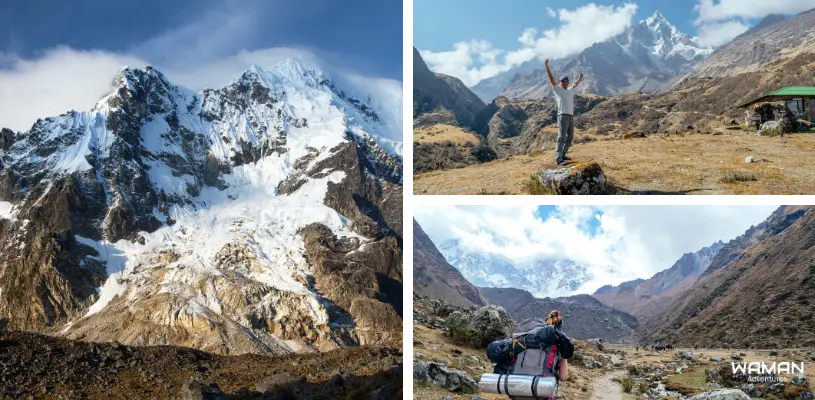
GUÍA DEFINITIVA DE SALKANTAY TREK A MACHU PICCHU

GUÍA COMPLETA DEL TREN A MACHU PICCHU: HORARIOS, ESTACIONES, COMIDA Y TODO LO QUE NECESITAS SABER

PLANIFICA TU AVENTURA: LA MEJOR ÉPOCA PARA VISITAR MACHU PICCHU
If you liked this article and the information you found, give us 5 stars, table of contents.
- International

Don't miss our posts
Subscribe to our newsletter and receive offers, news and more!
SUBSCRIBE TO OUR BLOG!
And receive all our news.


Lares Trek vs Inca Trail – Which One Should You Choose?
Lares Trek vs Inca Trail
Peru is famous for its ancient ruins, picturesque landscapes, and vibrant culture. And when it comes to trekking in Peru, the Lares Trek and Inca Trail are two of the most popular options. While both treks offer stunning views and an immersive cultural experience, they differ in several ways. In this blog post, we’ll compare the Lares Trek and Inca Trail to help you decide which one is right for you.
The Lares Trek:
The Lares Trek is a less crowded and more remote trek than the Inca Trail. It takes you through the beautiful Andean mountains, where you can see snow-capped peaks, glacial lakes, and traditional Andean villages. The trek starts in the Sacred Valley and ends in the town of Lares, where you can relax in hot springs after a few days of hiking.
One of the main advantages of the Lares Trek is that it offers a more immersive cultural experience than the Inca Trail. You will have the opportunity to interact with local communities and learn about their way of life. You will also see traditional Andean textiles being made, and you can purchase them as souvenirs.
Another advantage of the Lares Trek is that it is less physically demanding than the Inca Trail. While the Lares Trek is still a challenging hike, it doesn’t have as many steep inclines and declines as the Inca Trail. It also reaches a lower maximum elevation than the Inca Trail, which can be beneficial for those who are sensitive to altitude sickness.
The Inca Trail:
The Inca Trail is the most famous trek in Peru and one of the most popular in the world. It takes you on a 4-day journey through the Andean mountains, where you can see stunning landscapes and ancient Inca ruins, including the famous Machu Picchu.
One of the main advantages of the Inca Trail is that it offers unparalleled views of the Andes and Machu Picchu. The trek takes you through diverse ecosystems, including lush cloud forests and high-altitude grasslands. You will also have the chance to visit several Inca ruins along the way, including the impressive Wiñay Wayna and the Intipata terraces.
Another advantage of the Inca Trail is that it offers a sense of accomplishment and adventure that is hard to match. The trail is challenging, with steep inclines and declines, high altitude, and variable weather conditions. But the reward is worth it, as you will see some of the most breathtaking views in the world and arrive at the awe-inspiring Machu Picchu.
Lares Trek or Inca Trail So, which one should you choose?
Ultimately, the choice between the Lares Trek and Inca Trail depends on your preferences and fitness level. If you’re looking for a less crowded and more cultural trek, and you’re not a seasoned hiker, the Lares Trek might be the best choice for you. On the other hand, if you’re seeking a challenging and iconic trek with unparalleled views, and you have a good level of fitness, the Inca Trail might be more suitable for you.
Whichever trek you choose, make sure you’re well prepared and have the appropriate gear and clothing for the conditions. And don’t forget to enjoy the stunning landscapes and rich culture of Peru, whichever trek you choose!

- Machu Picchu
- Inca Trail Peru
- Salkantay Mountain
- Ollantaytambo
- Cachicata Inca Quarry
- Sacred Valley of the Incas
- Choquequirao
- Puerto Maldonado
- Trekking & Hiking
- Inca Trail Tours
- Best Alternative Treks
- Best Short Hikes and Tours
- Peru Adventure Holidays
- Luxury Holidays
- History / Culture
- Amazon Rainforest
- Multi-Adventure Zones
- Our Camping Equipment
- Salkantay Trek Packing List
- Salkantay Trek Weather
- Salkantay Trek FAQs
- Salkantay Trek Book & Payment
- Salkantay Trek Difficulty
- Booking Terms & Conditions
- Future tours
Inca Trail vs Lares Trail: The Best Hikes in the Cusco
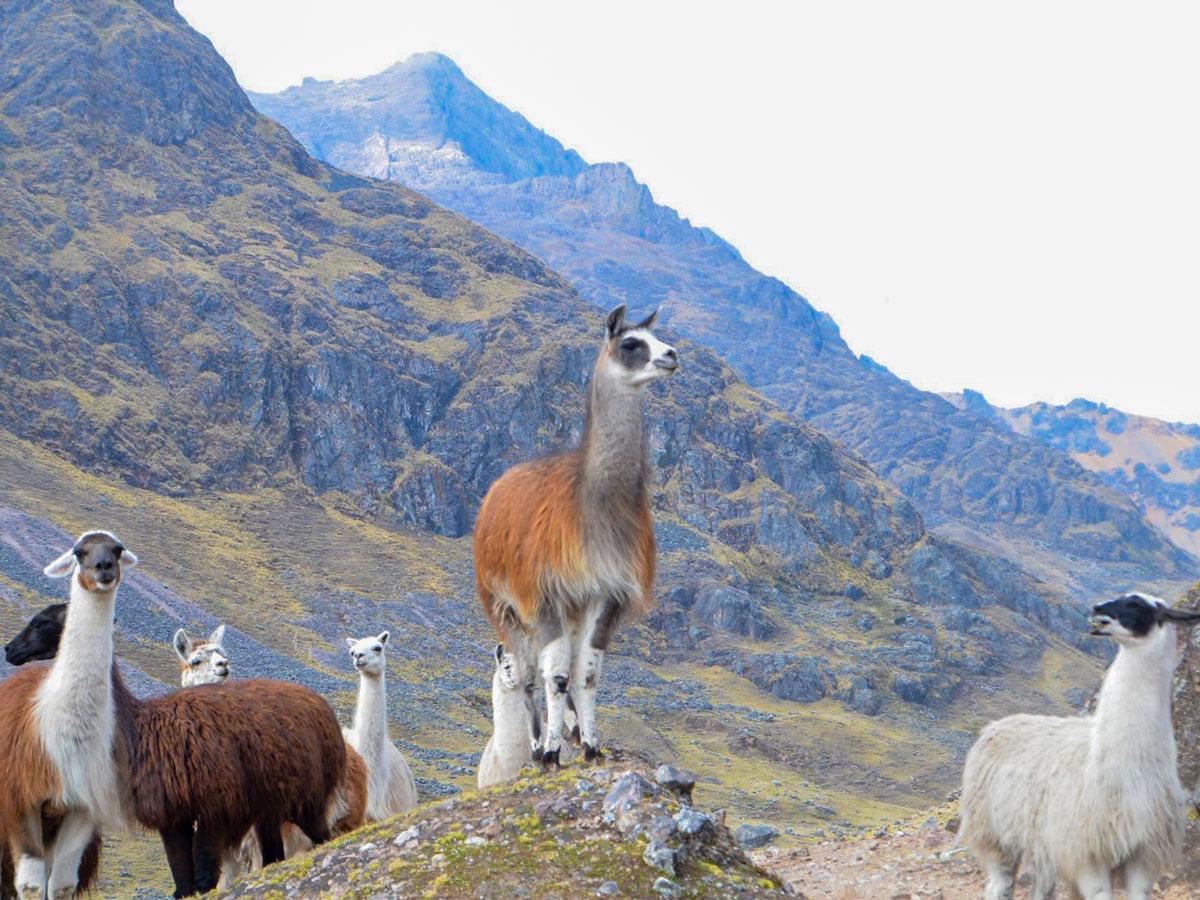
It is hard to compare them because they both share similarities, and at the same time, some contrasting features. Both include several kilometers of hiking up and down mountains. Of course, one is more “famous” and the other rewards the trekker with a more intimate feel.
It was part of the great network road of Inca roads of more than 23,000 kilometers that integrated the state of Tawantinsuyo. These roads led the merchants of the Inca period to ceremonial precincts and to the Incan army of the Tawantinsuyo. We also have the flora and fauna of the area. The beginning of this adventure starts at the pass control of Piscacucho (also known as Km. 82) which is 3 hours away by bus from the city of Cusco. Nowadays, the network is not retained in its entirety, however, it’s still possible to travel around 42 kilometers from Cusco Town to Machu Picchu .
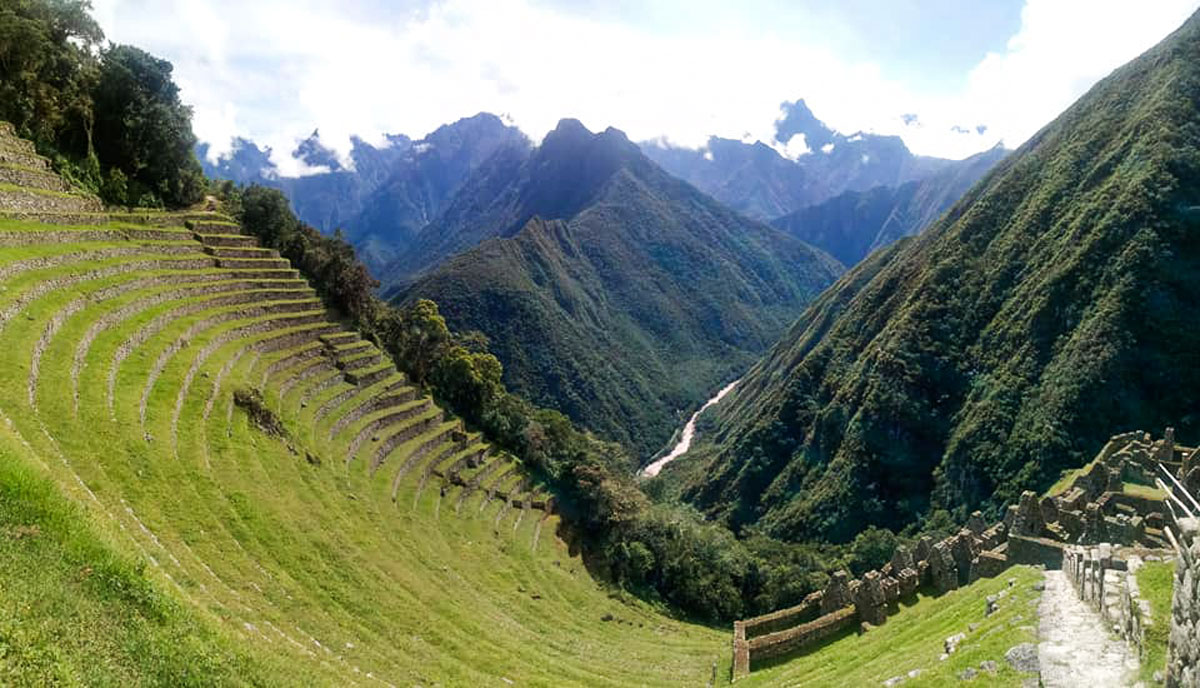
It is a hike that lasts two or three days in Cusco, Peru starting nearby the town of Lares , approximately 64 kilometers north of Cusco and 56 kilometers east of Machu Picchu . It is placed on the mountain range of Urupampa (on the east) crossing part of Sacred Valley. To start this trek you need to take a 5-hour trip by bus or van from the town. The Lares trek route crosses typical zones from the mountains of Peru.
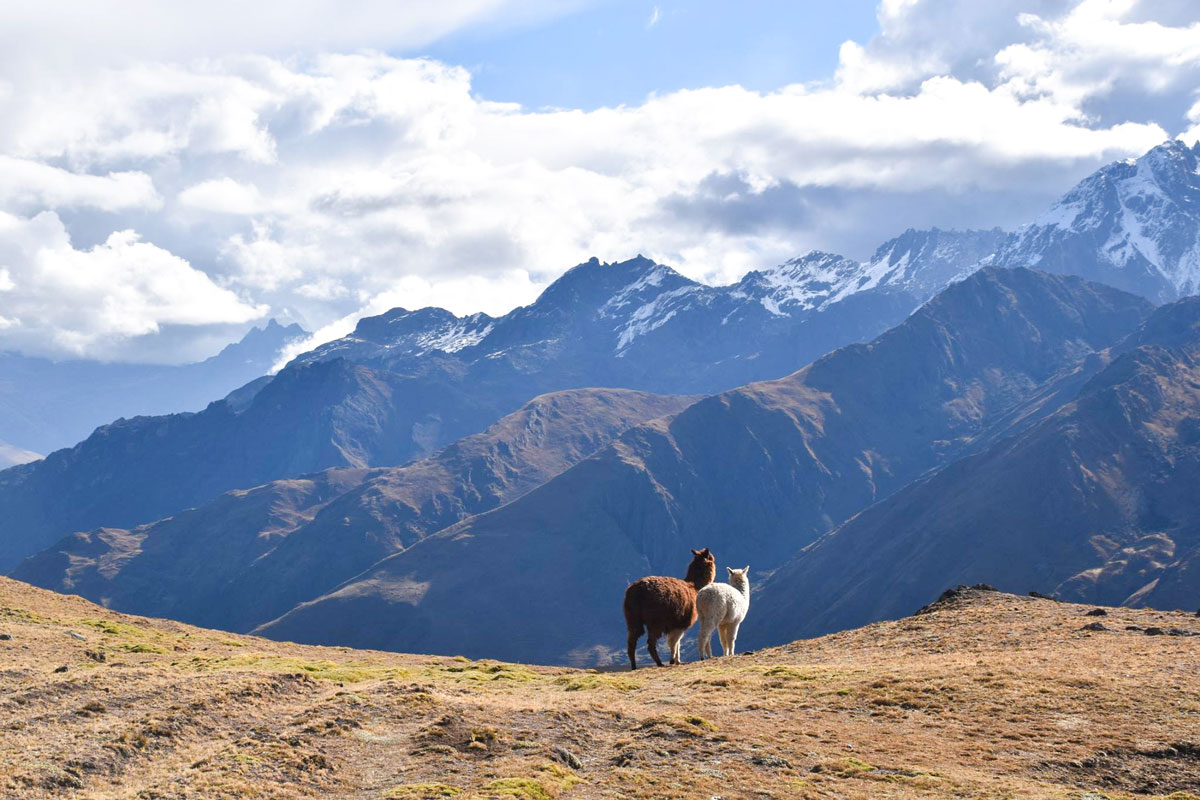
What trek should I do?
Here are the comparisons between them.
- There are more people who have done the Inca Trail than those who have done the other trek and they tend to talk about how impressive this trek is.
- Both are in the high Andes.
- Lares has MUCH LESS tourist influx than the Inca Trail and you go through a couple of very traditional villages.
- Lares has breathtaking views of lakes and some beautiful waterfalls.
- Lares does not count with a lot of ruins – whereas the other trek does count.
- Both end in Machu Picchu.
- The Lares trek is 33 km (20.5 miles) and the Inca Trail 44 km (27 miles).
- We can say that the Inca is tougher due to its climbs (steeps) and theirs descends.
- The Inca last three full days + two hours and the Lares one last 48 hours.
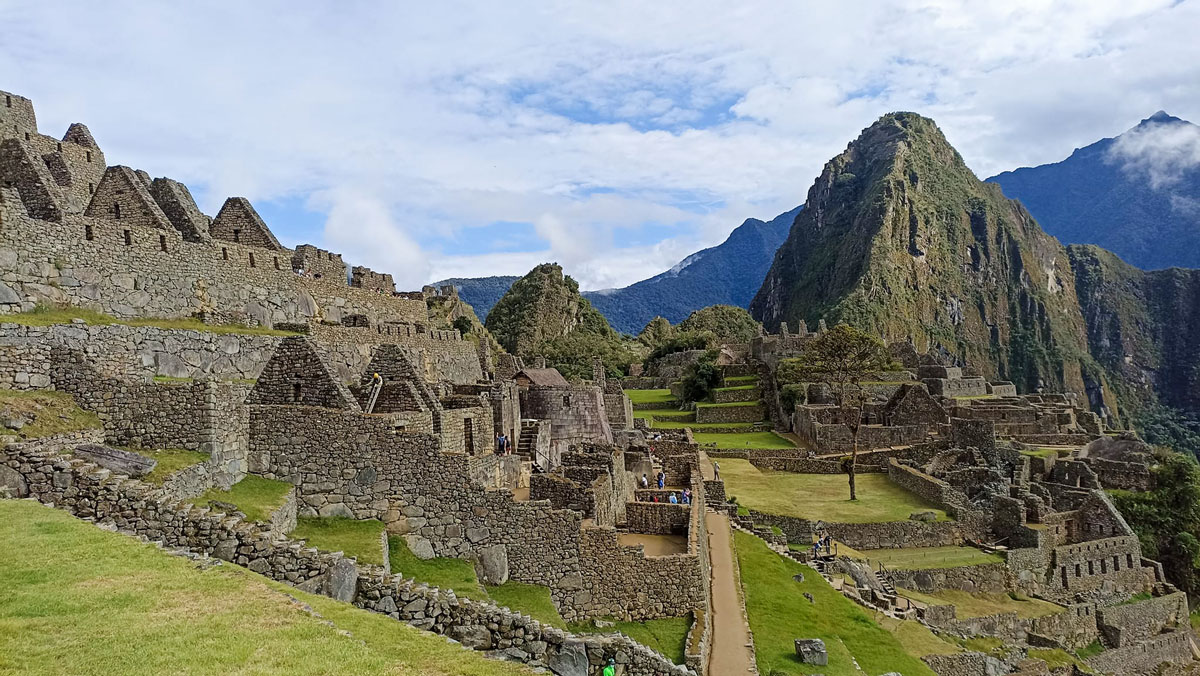
The best treks to Lares and Inca Trail
- 3 Day Inca Trail
- Machu Picchu Hike (2 Days/ 1 Night)
- 4 Day Inca Trail

- [email protected]
- +51 084 287653
- +51 933 839 757
Inkayni Peru Tours

- Alternative Hikes
- Machu Picchu
- Destinations Peru
- Festivities
- LARES TREK VS INCA TRAIL: DURATION, CHALLENGES, AND EXPERIENCES
Welcome hikers! If you are one of those who want more than just a visit to Machu Picchu and are willing to live an unforgettable experience in the majestic Peruvian Andes, then this blog is for you. This time, Inkayni Peru Tours will give you all the information you need to compare two exciting treks in Peru: the Lares Trek vs Inca Trail.

The Inca Trail is an adventure that combines history, culture and nature exceptionally.
Both routes offer the opportunity to explore breathtaking landscapes, immerse yourself in the vast Andean culture and discover Machu Picchu’s magic. Throughout this blog, we will guide you through the differences in length, challenges and unique experiences each route provides.
So now is the time to decide on which of these routes perfectly suits your expectations and preferences – it’s time to embark on an unforgettable adventure to Machu Picchu!

Both routes offer an unmissable experience through the beautiful landscapes and traditional culture of the Peruvian Andes.
THE INCA TRAIL
The Inca Trail, also known as “Qhapac ñan”, is one of the most famous trekking routes in the world. This incredible journey gives you an extraordinary and exciting experience, leading you directly to the mythical citadel of Machu Picchu, where you will enter through the emblematic Sun Gate or “Inti Punku”.
This ancient path, used by the Incas centuries ago, is deeply rooted in history and mystery. Along the way, you will walk on cobblestone paths and cross ancient suspension bridges while trekking through breathtaking Andean landscapes. Each step will bring you closer to Machu Picchu, the enigmatic treasure of the Incas, that awaits at the end of the Inca Trail.
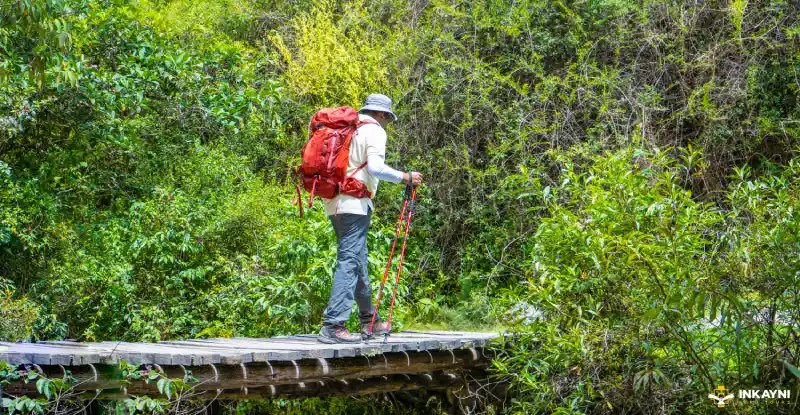
A hiker crosses a bridge on the Inca Trail.
The Lares Trek is a hidden gem on the route to Machu Picchu, a less travelled but equally exciting alternative. Here, you will immerse yourself in the authenticity of small Peruvian Andean villages that keep their customs alive. This closeness to the local communities gives you an enriching cultural experience, something you won’t find on the Inca Trail.
The Lares Trek allows you to interact with local people, and all the children will greet you warmly. You will discover their customs, traditions, lifestyle, and share genuine moments that will bring you closer to the cultural and spiritual richness of the Peruvian Andes.
In addition, on the Lares Trek route, you will witness breathtaking landscapes, from majestic mountains to green valleys and crystal clear lakes. Although you don’t arrive directly at the Sun Gate of Machu Picchu as on the Inca Trail, the reward is in the authenticity of the experience and the deep connection with the earth “Pachamama” and its people.
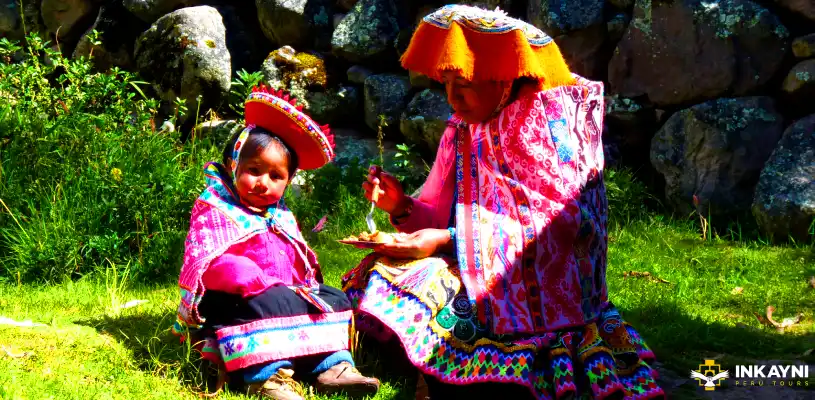
Lares Trek is a more authentic approach to local communities
A BIT OF HISTORY BETWEEN LARES TREK VS INCA TRAIL
- The Inca Trail was perfected by the Incas during the 15th century as an extensive network of roads connecting different regions within the Inca Empire. One of the most famous sections of the Inca Trail is the one leading to the citadel of Machu Picchu.
- On the other hand, the Lares Trek also has its origins in the Inca Empire, in the 15th century. This route was one of the secondary roads used by the Incas to connect the valleys and communities of the Lares region in Cusco, Peru. The Incas established trails and roads in this area to facilitate commercial and cultural exchange with other regions of the empire.
- As a result of the arrival of the Spanish and the fall of the Inca Empire in the 16th century, the ancient paths and trails lost their importance and fell into oblivion for several years. However, in more recent times, with the growing interest in tourism and cultural heritage, both the Inca Trail and the Lares Trek have been rediscovered as exciting alternatives ending in Machu Picchu.
- Today, both trails are considered historical treasures and tourist attractions. Also, both offer unique and enriching experiences for visitors wishing to explore the grandeur of the Peruvian Andes and discover the rich history and culture of the region. Although they have distinct histories, both share the goal of connecting people with the magic and heritage of the ancient Inca civilisation and the region’s breathtaking natural environment.

Lares Trek vs Inca Trail
WHERE IS THE INCA TRAIL OR LARES TREK?
This trekking route is located in Cusco, Peru. This impressive trek unfolds east of the Urubamba Mountain Range and passes through a spectacular part of the renowned Sacred Valley of the Incas.
INCA TRAIL TO MACHU PICCHU
The Inca Trail to Machu Picchu is the most famous stretch of a vast network of ancient trails stretching through several South American countries including Peru, Ecuador, Bolivia, Colombia, Argentina and Chile. The Inca Trail to Machu Picchu is the most visited section, located in Peru, specifically in Cusco, where it extends from kilometre 82 of the Ollantaytambo – Aguas Calientes railway to the majestic citadel of Machu Picchu.
This Peruvian section of the Inca Trail is the most recognized in the world attracting thousands of visitors every year seeking a unique and exciting experience.
WHERE DOES THE LARES TREK VS INCA TRAIL START?
Lares Trek to Machu Picchu generally starts in the charming village of Pumahuanca, located at an impressive altitude of 3,150 m/ 10,334 ft above sea level. From here, trekkers embark on an unforgettable adventure through majestic Andean landscapes, full of traditional culture and natural beauty.
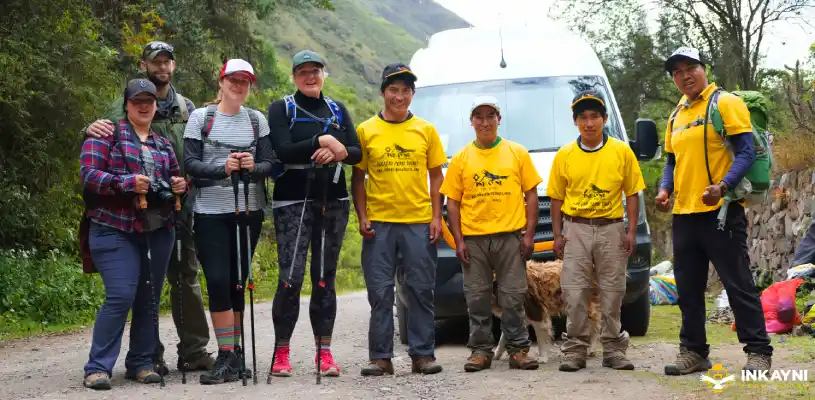
Hikers, tour guide, chef and horsemen ready to start the hike.
The exciting Inca Trail trek begins at kilometre 82 (2,720 m/ 8,923 ft above sea level), also known as “Piscacucho”.

Starting point of the classic Inca Trail
HOW HIGH IS THE INCA TRAIL OR LARES TREK?
Lares trek:.
The Lares Trek’s altitude varies along the route . On the second day, you will reach the highest point in the Sicllakasa Pass, and it is important to take this altitude over 4500 m/14753 ft above sea level. The Lares Trek also crosses high rugged terrain , which may affect some people who are not properly acclimatised.
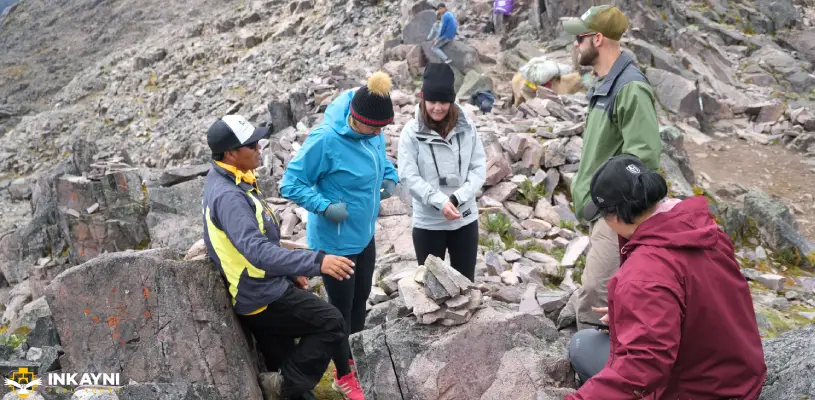
Spiritual offering to Mother Earth at Sicllakasa Pass
Some key altitudes along the route:
- Pumahuanca (Starting point): Approximately 3,150 m/ 10,334 ft above sea level.
- Sicallakasa Pass (Mountain Pass): About 4,830 m/15,846 ft above sea level.
- Cuncani (Village): Approximately 3,800 m/ 12,467 ft above sea level.
- Lares (End of trek): Approximately 3,200 m/ 10,498 ft above sea level.
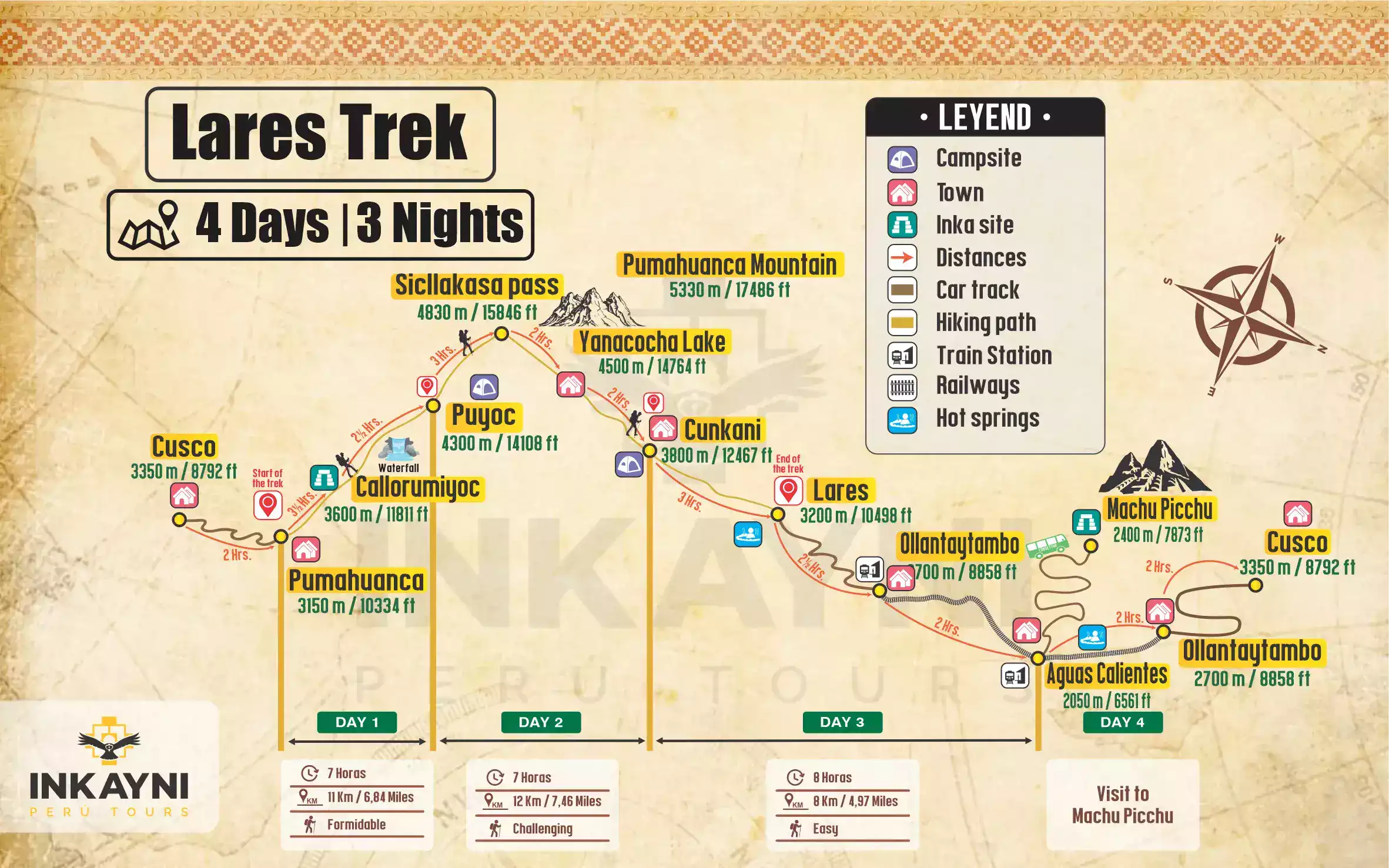
Map of Lares Trek. Note that Sicllaccasa is the highest pass
INCA TRAIL:
The Inca Trail’s altitude varies along the route as it traverses different terrains on its way to Machu Picchu. The Inca Trail’s highest point is 4,215 m/13,828 ft above sea level. This is known as Warmihuañusca or Dead Woman’s Pass. The Abra Warmiwañusca is one of the most challenging points of the Inca Trail trek, as hikers must ascend to t his high altitude along a steep and strenuous trail.

Illustrative map – 04 days Inca Trail to Machu Picchu
Some key altitudes along the trail:
- Kilometre 82 (Starting point): Approximately 2,700 m/8858 ft above sea level.
- Abra Warmiwañusqa (Highest mountain pass): About 4,215m/13829 ft above sea level.
- Runkurakay (Archaeological site): Approximately 3,800 m/12467 ft above sea level.
- Phuyupatamarca (Archaeological site): About 3,600 m/11811 above sea level.
- Wiñay Wayna (Archaeological site): Approximately 2,650 m/8694 ft above sea level.
- Machu Picchu (End of the trek): Approximately 2,430 m/7972 ft above sea level.

Hikers at the highest point of the Inca Trail, Warmiwañusca Pass.
LARES TREK VS INCA TRAIL – HOW LONG IS IT?
The Lares Trek length varies depending on the itinerary you choose. The following are the two popular options:
Lares Trek to Machu Picchu 4D/3N. – This is the shorter version of the trek and lasts 4 days and 3 nights. During this time, you will trek approximately 31 kilometres through the Andes and landscapes before arriving to Machu Picchu on the last day.
Lares Trek to Machu Picchu 4D/3N Information and Summary Table
Lares Trek to Machu Picchu + Short Inca Trail 5D/4N – This option is one day longer and more challenging, as it includes the Short Inca Trail along with the Lares Trek. It lasts 5 days and 4 nights, during which you will walk around 41 kilometres before reaching the majestic Inca citadel of Machu Picchu.
Information and summary table of the duration of the Lares Trek to Machu Picchu + Short Inca Trail (5 days and 4 nights)
HOW LONG IS INCA TRAIL?
The Inca Trail duration varies depending on the itinerary you choose, too. However, the traditional Inca Trail route usually lasts 4 days and 3 nights . During these 4 days, you will trek approximately 44 kilometres through beautiful Andean landscapes, ancient Inca sites and finish in Machu Picchu’s citadel at dawn on the fourth day.
Summary table of the kilometres covered by the different Inca Trail schedules
Table summarising the duration of the different Inca Trail versions.
LARES TREK VS INCA TRAIL – HOW HARD IS IT?
How hard is lares trek.
The Lares Trek to Machu Picchu 4D/3N is considered a tough to challenging trek because of:
- You reach high altitudes, including the highest point at the Sicllakasa Pass, located approximately 4,830 m/15,846 ft above sea level!
- The trail to Machu Picchu via the Lares Trek features uneven and mountainous terrain. You will hike through rocky trails and steep terrain while facing variable weather conditions.
- The trek lasts 4 days and 3 nights, during which you will hike several hours each day.
- The weather in the high Andes is unpredictable, with sudden temperature changes and possible rainfall.
The difficulty level of this version is tough to challenging.
HOW HAR IS INCA TRAIL?
- During the Classic Inca Trail trek , hikers face a number of challenging terrain conditions, including cobblestone paths and steep stairs at high altitudes.
- The highest point on the Classic Inca Trail is the Warmiwañusca Pass, also known as Dead Woman’s Pass, which is at an impressive altitude of 4,215 m/13,828 ft above sea level.
- In addition to the Warmiwañusca Pass , hikers also cross other mountain passes, such as the Runkuracay Pass and the Phuyupatamarca Pass, which add exciting challenges along the way.
This is why the Classic Inca Trail has a difficulty rating of challenging. It is important to be well prepared physically and to take into account the recommendations of the guides during the Classic Inca Trail in order to enjoy this historical and cultural experience in a safe and enriching way.
The classic Inca Trail is challenging.
LARES TREK VS INCA TRAIL HIGHLIGHTS
What to see during my lares trek.
During your Lares Trek, adventurous people can enjoy a truly unforgettable experience in the Urubamba Mountain Range. They can explore and pass through breathtaking landscapes, immerse themselves in the rich Inca culture and discover real Andean life in its small villages. Highlights include:
- Sacred Valley – Located in the Cusco region of Peru. This place was considered sacred by the Incas due to its fertile soil and natural beauty.
- Puyoc Village – Puyoc is a small Andean village that forms part of the Lares Trek route. It is a resting point for hikers on the first day of the trek.
- Waterfall – The Lares Trek crosses many waterfalls along its way. It offers a refreshing and revitalizing experience in the natural environment.
- Sicllaccasa Pass – This is the highest point of the Lares Trek, located at an altitude of approximately 4,830 meters/15,846 feet above sea level.
- Cuncani Village – Another Andean village on the Lares Trek route, Cuncani is known for its authenticity and cultural traditions. Travellers interact with the local people, learn about their way of life and enjoy the community’s warmth.
- Yanacocha Lake – This freshwater lake is found along the Lares Trek route. This is not the only lake because there are many others with different sizes and shapes.
- Lares Hot Springs – Located near the village of Lares, they offer a relaxing and soothing experience after days of trekking, as their waters have medicinal and relaxing properties.
- Ollantaytambo is a historical and archaeological town located in the Sacred Valley of the Incas. It is known for its impressive archaeological sites including agricultural terraces, temples and complex Inca structures.
- Machu Picchu – Considered one of the Seven Wonders of the World. This ancient Inca citadel, built in the 15th century, will be visited on the last day of the trek.
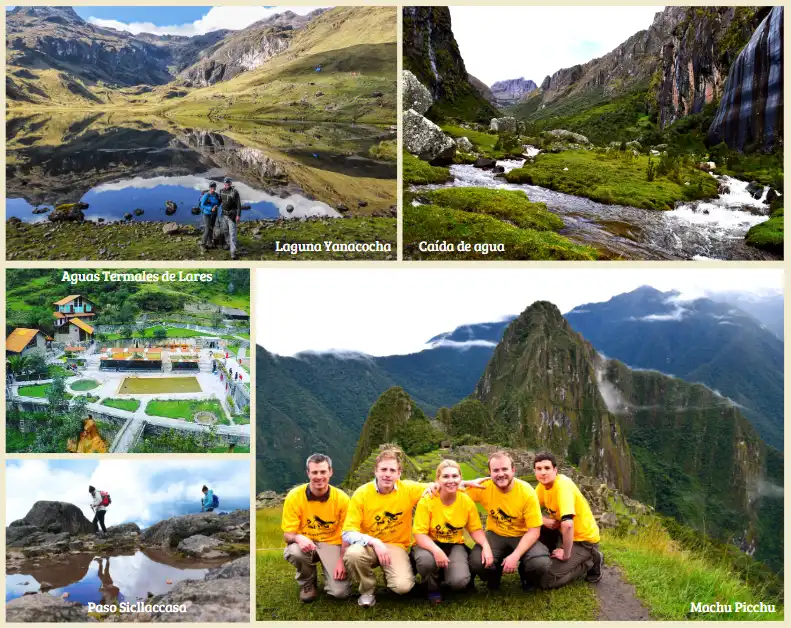
Highlights of the Lares Trek vs Inca Trail
WHAT TO SEE DURING MY INCA TRAIL TREK?
During the Classic Inca Trail trek, you will have the opportunity to discover a number of impressive and significant sites along the route. Some of the highlights you will see during your Classic Inca Trail trek include:
- KM 82 .- Starting point for Inca Trail hikers.
- Warmiwañusca Pass – Also known as Dead Woman’s Pass is the highest point of the trek and offers panoramic views.
- Runkuracay – An Inca archaeological site that was a watchtower and control tower along the Inca Trail.
- Sayacmarca – An impressive Inca archaeological site built on a steep mountain slope with impressive terraces and structures.
- Phuyupatamarca – It’s an archaeological site among the clouds that offers views of the valley and surrounding mountains.
- Inti Pata – The name “Inti Pata” comes from the Quechua language and means “Terrace of the Sun” and is known for its well-preserved agricultural terraces.
- Wiñay Huayna – Its name comes from the Quechua language and means “Forever Young”. It is known for its Inca architecture and location on a steep hillside.
- Inti Punku (Sun Gate) – The entrance to Machu Picchu hiking the Inca Trail, where you will see the Inca citadel.
- Machu Picchu – The final destination and the highlight of the trek, where you can explore and admire the majesty of this ancient Inca citadel.

Great photos of the archaeological sites mentioned above.
FLORA AND FAUNA OF LARES TREK VS INCA TRAIL
Although the Lares Trek and the Inca Trail share some species of flora and fauna due to their geographical proximity in the Peruvian Andes, they also differ in their natural environment.
FLORA OF LARES TREK VS INCA TRAIL
- On the Lares Trek, hikers will observe several plant and tree species typical of the high Andean region . Some of the most common species include pun grasslands, queñua (a tree native to the Andes), ferns, and the colourful Kantu flower (Peru’s national flower).
- The Inca Trail traverses a variety of ecosystems , from intermountain valleys, elfin forest to high puna grassland. In the lower regions, hikers will appreciate lush jungle vegetation, with ferns, lichens and diverse orchid varieties. As they ascend, they will come across flora species typical of the high Andes such as the puya de Gynoxis plant, scrubs, queuñas, etc.
FAUNA OF THE LARES TREK VS INCA TRAIL
On both the Lares Trek and the Inca Trail, native fauna can be seen. Among the animals are the Andean condor, the Alpaca (South American camelid), the Andean Fox, the Mountain Vizcacha, the puma (rarely seen due to its shy nature), different species of birds such as the Canasteros and Cinclodes (generally sighted during the Inca Trail but it can be seen in Lares Trek as well!).

Some of the magestic animals founded in the Inca Trail or Lares Trek
AVAILABILITY/FLEXIBILITY OF LARES TREK VS INCA TRAIL
The availability and flexibility of Inca Trail or Lares Trek are super important factors to consider when planning your adventure in the magical South Peruvian Andes:
- Lares Trek generally has greater availability than the Inca Trail.
- By increasing availability, Lares Trek offers more flexibility in departure dates , making it possible to find available dates with less advance notice.
- Lares Trek offers duration options, such as the 4-day/3-night version or the combined Lares Trek plus short Inca Trail (5D/4N). This allows you to choose the option that best suits your preferences and the time available.
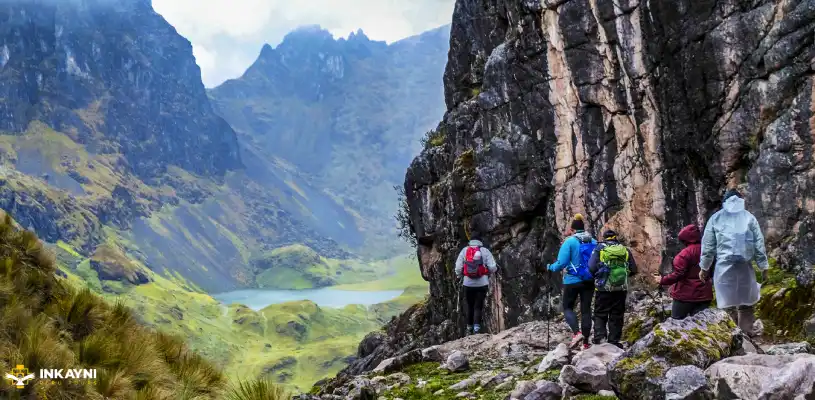
It is important to book in advance, especially if you have specific dates in mind or travelling during the high season.
INCA TRAIL AVAILABILITY:
- The availability of spaces on the Inca Trail is limited due to Peruvian government restrictions on permits. Only 500 people (including hikers, guides, porters, cooks and chefs) can enter each. This action preserves and protects the trail’s historical and natural heritage.
- Due to high demand and limited permit availability , it is advisable to book at least 6 months in advance to secure your spot on your desired date. This may reduce the flexibility to adjust the departure date to suit your convenience.
- The Classic Inca Trail lasts 4 days and 3 nights. However, there are other options for those looking to vary the length and degree of challenge. For example, the 2D/1N Short Inca Trail . On the other hand, the 5D/4N Inca Trail offers a more detailed experience. In case you are an intrepid traveller, the combined version of the Salkantay Trek & Inca Trail (7D/6N) is the most exciting option.

Inkayni Peru Tours offers personalized trekking services. Don’t worry, just enjoy this adventure!
LARES TREK VS INCA TRAIL – CAMPSITES
Stops and campsites are essential on a trek because they provide opportunities to rest, recuperate, adapt to the altitude and enjoy nature at the end of the day. Also, campsites are strategic points for water supply, meal preparation and supplies ensuring trekkers are adequately provisioned to continue their trek. Lares Trek vs Inca Trail have different stops and campsites along their routes. Here are some of the main stops and campsites along each route:
- Pumahuanca – The starting point of the Lares Trek. From this charming village, you will start your exciting trek into the mystical Lares Valley. Here, you will be immersed in Andean culture and surrounded by its native high Andean nature.
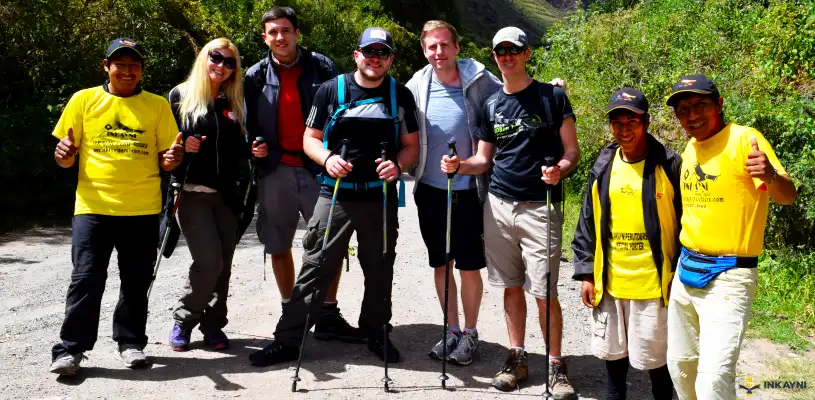
Happy tourist before setting off from Pumahuanca towards Lares.
- Puyoc (First camp): After starting the trek in the charming village of Pumahuanca, you will arrive in Puyoc, which will be the first stop of your trek and the place where you will camp. Here you can rest and recharge your batteries after an exciting day of trekking through breathtaking Andean landscapes.

Puyoc camp and its surroundings. Note the flora and habitat.
- Cuncani (Second Camp) – The second and last camp before reaching the hot springs. Here, you will appreciate the daily life of the local communities and their traditional culture.

Hikers in lunchtime at “Cunkani”, the second Lares Trek campsite.
- Lares Hot Springs – On the third day of the Lares Trek, hikers will enjoy a stop at the comforting Lares Hot Springs.
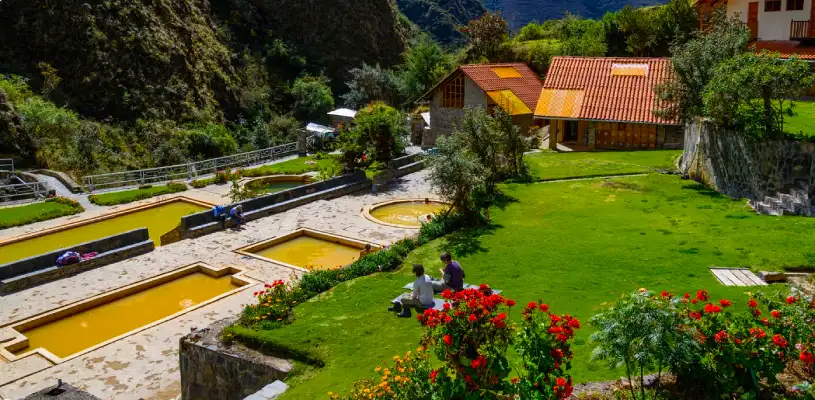
The natural hot springs offer well-deserved rest after the Lares Trek.
- Aguas Calientes (Machu Picchu Pueblo) – In this beautiful place, you will spend the last night before you visit Machu Picchu the last day.

The principal Square in Aguas Calientes
- Piscacucho (KM 82) – This is the starting point of the Classic Inca Trail, located at kilometre 82 of the railway between Cusco and Aguas Calientes (Machu Picchu). This is where hikers begin their exciting trek to the Inca citadel.

Hikers in Piskacucho begin their unforgettable journey through breathtaking landscapes and ancient cobbled trails along the Inca Trail.
- Tarayoq – This is the first stop on the Classic Inca Trail, where hikers can enjoy a well-deserved lunch before continuing their exciting trek to Wayllabamba.
- Wayllabamba (First Camp) – This is the first camp on the Inca Trail, located in the town of Wayllabamba at 3,000 m/ 9,842 ft above sea level. Hikers camp here after the first day of trekking. The camp still offers basic shops and restaurants with panoramic views of its surroundings.
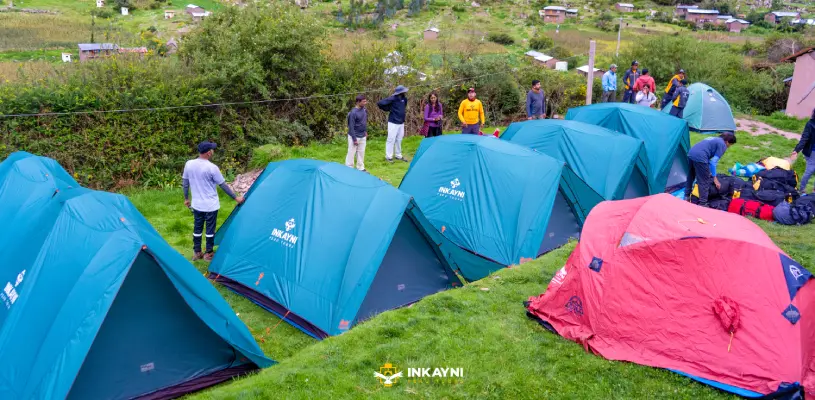
Camping at Wayllabamba
- Pacaymayo (Second Camp).- After climbing through the Warmiwañusca (Dead Woman) Pass, hikers reach Pacaymayo, which is about 3,580 m/11700 ft above sea level.

Tourists resting near Pacaymayo’s camp pass
- Chaquicocha: On the third day of the Classic Inca Trail, hikers stop at Chaquicocha to enjoy a well-deserved lunch. After enjoying a delicious meal, you continue your journey to Wiñay Huayna.
- Wiñay Wayna (Tercer Campamento).- This is the last camp before reaching Machu Picchu. At approximately 2,700 meters above sea level, Wiñay Huayna is noted for its impressive Inca terraces and abundant flora and fauna.

Inkayni Peru Tours offers you Doite and Eureka tents
- Inti Punku is a significant and emblematic point along the Classic Inca Trail. It is considered the final point of the trek and the gate of Machu Picchu because from this spot, hikers get their first breathtaking view of the iconic citadel of Machu Picchu.}

Inti Punku, also known as “The Sun Gate”
WEATHER OF LARES TREK VS INCA TRAIL
One of your biggest questions is when is the most convenient time to do the Inca Trail or Lares Trek? You will be happy to know that Cusco’s weather seasons are well-defined. The dry season runs from April to October and the rainy season extends from November to March.
Dry season (April to October):
- During the dry season, there are sunny and dry days , with pleasant temperatures during the day.
- Nights and early mornings can be quite cold , especially at higher altitudes, so it is important to bring warm clothes for the evenings.
- This season is considered the best time to do the Lares Trek vs Inca trail, as weather conditions are more stable and there is less chance of rain.
Rainy season (November to March):
- During the rainy season, you will find cloudy and rainy days, especially in January and February, which are the rainiest months.
- Rain makes trails slippery and difficult to walk on due to rain, which makes hiking harder.
- However, this season also has its charm, as the vegetation is more lush and the landscapes are greener and more beautiful.
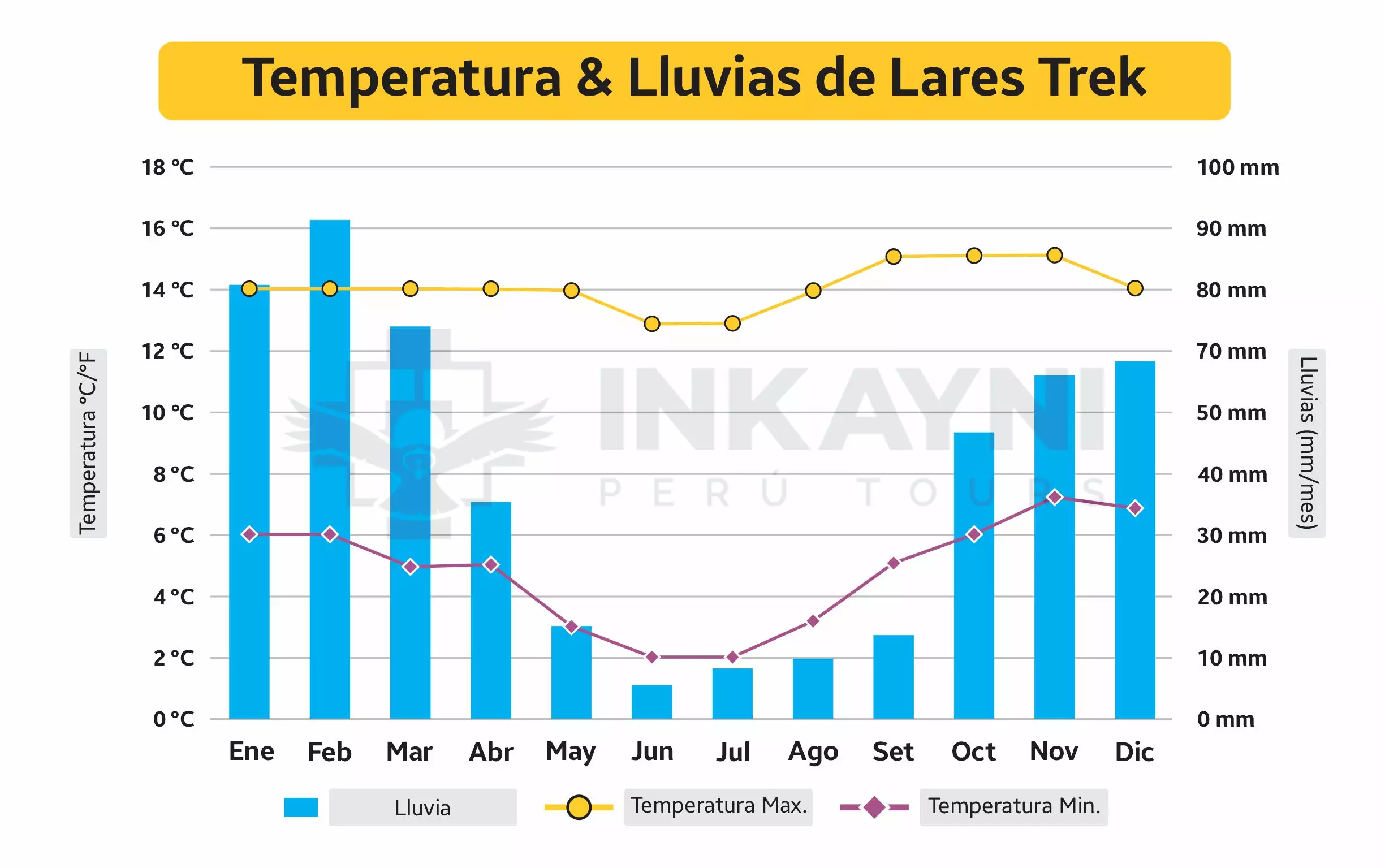
Best months to do the Lares Trek are April, May, June and July
- During the dry season, which is the most popular time to trek the Inca Trail, you will find sunny and clear days , with pleasant temperatures during the day.
- Nights are cool and cold , especially at higher altitudes, so it is wise to bring warm clothes for the night.
- In general, this season is ideal for trekking as the weather conditions are more stable and there is less chance of rain.
- During the rainy season, you can expect rainfall , especially in January and February, which are the most humid months.
- Trails become slippery and difficult to walk on, which makes hiking more challenging.

According to the graph of the average monthly rainfall on the Inca Trail, the best time to conquer it is between June, July, August and September.
WHO CARRIES THE LUGGAGE DURING THE LARES TREK VS INCA TRAIL?
If you book your trek, either the Inca Trail or Lares Trek, with an agency, they will carry the cooking and camping equipment. In addition, they will carry up to 7 kg of personal items.
- On the Lares Trek, luggage is not carried by porters, they use mules or horses ridden by muleteers. The muleteers are local people who guide the animals and ensure the luggage arrives safely at the campsites. This practice is common on several treks in the Cusco region, including the Lares Trek.

As part of our commitment to responsible and sustainable tourism, Inkayni Peru Tours treats animals ethically and humanely.
- On the other hand, on the Classic Inca Trail, we hired porters to carry hikers ‘ luggage along the trek. This service allows hikers to enjoy the experience without carrying a heavy backpack.

During the Classic Inca Trail porters carry not more than 20 kilograms each one.
Although your main luggage is carried, it is important to bring a trekking backpack with your essential belongings for the day. These belongings include water, sunscreen, warm clothes and other personal care items. Luggage carried by porters generally has a weight limit set by the tourist agency organising the trek. Therefore, it is recommended to pack between 2 to 5 kilos in the backpack you will be carrying during the trek in order to ensure your comfort and ease of movement.
LARES TREK VS INCA TRAIL CLOSURES
Trail closures are important before embarking on the Inca Trail or Lares Trek.
The Inca Trail closes annually in February. This is to perform maintenance and preservation work on the route, as well as clean and restore the trails. During this month, Inca Trail access is not permitted and illegal. It is important to avoid planning your trip during February if you intend to hike the Inca Trail, as it will not be available during this period.
Unlike the Inca Trail, Lares Trek remains open all year round. However, weather conditions can affect trail accessibility and difficulty at certain times . For example, in the rainy season (November to March), there may be more chance of heavy rains and landslides, which could be risky.

The availability of the Inca Trail or Lares Trek annually.
LARES TREK VS INCA TRAIL – HOT SPRINGS
Hot springs are a welcome reward for hikers after days of trekking on the Inca Trail or Lares Trek. Although both offer hot springs, there are some differences between them:
LARES TREK HOT SPRINGS:
- During the Lares Trek, hikers have the opportunity to enjoy the natural hot springs at the Lares camp on the last day of the trek. It is located at an altitude of approximately 3,200 m/10,498 ft above sea level.
- These hot springs are known for their healing and relaxing properties , providing needed relief for tired muscles after hiking.
- The atmosphere at the Lares Trek hot springs is more rustic and less crowded , allowing hikers to immerse themselves in nature’s tranquillity while enjoying the hot springs, the sound of the river and birds,

After three or four days of trekking on the Lares Trek, the hot springs of Lares are a real treat for hikers.
HOT SPRINGS IN AGUAS CALIENTES:
- On the Inca Trail, hikers can enjoy the hot springs in the town of Aguas Calientes, which lies at the foot of Machu Picchu mountain at about 2,050 m/6,561 ft above sea level.
- The Aguas Calientes hot springs are more developed and have tourist facilities such as parking.
- After completing the Inca Trail trek, many hikers enjoy a relaxing soak in the hot springs of Aguas Calientes as a way to rest before their visit to Machu Picchu the next morning.

Aguas Calientes thermal baths are one of the most visited tourist destinations because of their location.
HIGHLIGHTS OF THE INCA TRAIL
- You will discover the mystery and grandeur of the Inca Trail as you venture along ancient trails dating back to the 15th century. This iconic trekking route, also known as “Qapac ñan” in Quechua, is one of the most famous in South America and takes you directly to Machu Picchu.
- You will visit various archaeological sites , such as Llactapata, Runkurakay, Sayacmarca, Phuyupatamarca, Wiñay Wayna, among others. Each archaeological site offers a fascinating insight into the ancient Inca civilization and its impressive architecture.
- This trek allows you to explore numerous Inca archaeological sites along the way, each with its own history and mystery. You will come across agricultural terraces, temples and ceremonial centres that reveal the grandiose civilisation that once flourished in this region.
- The Inca Trail is an exciting and enriching experience that will connect you with the history, nature and spirituality of the ancient Incas. You will be able to capture these incredible moments in a photograph that you will remember for the rest of your life.
- You will arrive at the Sun Gate or “Inti Punku” , a strategic point that offers an incomparable panoramic view of Machu Picchu. From this sacred place, you will be able to appreciate the magnificence of the citadel and feel a deep sense of success at the end of your journey

Hikers enjoying the railway on the Inca Trail. The Classic Inca Trail offers a physical and mental challenge, making it a rewarding experience for adventure and trekking enthusiasts.
NEGATIVE ASPECTS OF THE INCA TRAIL
- In contrast to Lares Trek, the Inca Trail does not offer cultural interaction with local communities. If you are looking for an authentic and enriching experience of the Andean people, the Lares Trek is better.
- If you wish to trek the Inca Trail, it is essential to book in advance at least 6 months in advance. Permits to hike this route are limited and sell out quickly due to its popularity and restrictions imposed by the authorities to preserve the environment.
LARES TREK HIGHLIGHTS
- You will visit small Andean villages and pass through as well, where you will meet friendly local people and share unique cultural experiences.
- You will experience experiential tourism first-hand as you interact with the local communities , learn about their traditions and customs, and admire the colourful traditional costumes worn by the locals. These encounters will allow you to connect with the rich Andean culture and show you the hospitality and warmth of the Peruvian Andean people (finishing the Lares Trek is probably to learn phrases in Quechua).
- The route enables you to travel through breathtaking landscapes, including crystal-clear lakes, waterfalls, lush valleys, and majestic mountains with their own habitats, providing you with unforgettable experiences.
- Lares Trek offers you the opportunity to escape the hustle and bustle of the city and enter a natural and peaceful environment. This is where the Andes magic will captivate you in every corner!

Yanacocha Lake is just one of the many highlights along the Lares Trek.
NEGATIVE ASPECTS OF THE LARES TREK
- You don’t reach Machu Picchu via the iconic Sun Gate (Inti Punku) , as the Classic Inca Trail does, in other words, you don’t reach Machu Picchu directly. The Sun Gate is an iconic point from where travellers can get a breathtaking panoramic view of Machu Picchu at the end of their trek.
- In contrast to the Classic Inca Trail, on the Lares Trek route you will experience fewer visits to archaeological sites along the way. This particularity gives Lares Trek a more focused approach to cultural interaction and the natural environment, giving you the opportunity to immerse yourself deeply in the traditions of the local communities and the serene beauty of the mountain landscapes.

Choosing between the Inca Trail or Lares Trek is a matter of personal preference. Both routes have their own unique characteristics and offer different perspectives of the region.
LARES TREK VS INCA TRAIL IN A NUTSHELL
Do you want to immerse yourself in the Andean people’s friendliness and explore the stunning valleys of the Lares Trek? Or do you prefer to follow in the footsteps of the ancient Incas on the mysterious Classic Inca Trail culminating in the unforgettable view from the Sun Gate to Machu Picchu? Without a doubt, both Peruvian Andes routes hold their own! Are you ready for a unique experience full of history, culture and breathtaking scenery? Inkayni Peru Tours offers you the opportunity to embark on an exciting adventure on either the Lares Trek or the Classic Inca Trail. Whichever you choose, we assure you that every step you foot is going to be unforgettable. With our high-quality service, we will accompany you every step of the way, providing you with comfort, safety and the opportunity to write your own story in the wonders of the Peruvian Andes. Don’t wait any longer and live this incredible experience! Join us and discover the magic of Peru in an extraordinary and unforgettable way!
Gonzalo Tapia was born in the rainforest of Peru, Madre de Dios, and he's been living in Cusco since 2008. He has been exploring Peru due to his main hobby as a birdwatcher. Also, he has a lot of experience in outdoor activities and wilderness.
View all posts
GUÍA DEFINITIVA DEL CAMINO INCA PARA CONQUISTAR «LA CIUDAD PERDIDA DE LOS INCAS»

GUÍA DE VIAJE MACHU PICCHU: RUTAS, CONSEJOS Y RECOMENDACIONES

SALKANTAY TREK A MACHU PICCHU: TODO LO QUÉ DEBES SABER DE ESTA INCREÍBLE RUTA
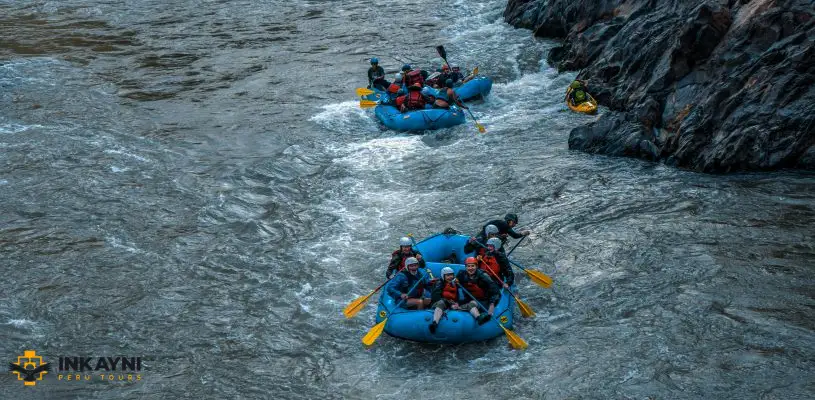
GUIA COMPLETA SOBRE INCA JUNGLE TREK: SUMÉRGETE EN LA SELVA INCA
If you liked this article and the information you found, give us 5 stars.
What’s the Better Ancient Path to Machu Picchu? Inca Trail vs the Lares Trek

- Post author: Mark Ching
- Post published: 1 February 2024
- Post category: Inca Trail
Embarking on a journey to Machu Picchu is a dream for many adventure seekers, and the trek to this ancient wonder offers two prominent paths – the Inca Trail and the Lares Trek . Each route presents a unique set of challenges, landscapes, and cultural experiences. In this comprehensive exploration, we will delve deeper into the nuances of the Lares Trek and the Inca Trail to help you make an informed decision when planning your once-in-a-lifetime adventure.
Key Takeaways
- The Inca Trail, often hailed as the crown jewel of trekking routes, is a 26-mile journey that follows the footsteps of the ancient Incas
- The Lares Trek boasts its own set of spectacular landscapes, showcasing the diverse beauty of the Andes
- Both treks showcase the stunning beauty of the Andean landscapes, but they do so in different ways. The Inca Trail, with its varied ecosystems and archaeological sites, offers a blend of history and nature
The Inca Trail

Historical Significance
The Inca Trail, often hailed as the crown jewel of trekking routes, is a 26-mile journey that follows the footsteps of the ancient Incas. This path not only promises a physical challenge but also provides a profound connection to Peru’s rich history and the ingenuity of the Inca civilization.
Trekkers on the Inca Trail have the unique opportunity to explore several archaeological sites, such as the mesmerizing Winay Wayna and the panoramic Intipata, all contributing to the allure of the journey towards the iconic Sun Gate overlooking Machu Picchu.
Landscape and Scenery
The Inca Trail is renowned for its diverse and breathtaking landscapes. The route winds through lush cloud forests, traverses high-altitude Andean passes, and presents awe-inspiring vistas at every turn. From the challenging ascent of Dead Woman’s Pass to the enchanting terraces of Wiñay Wayna, the trail is a visual feast for nature enthusiasts and history buffs alike.
Trekkers witness the gradual transformation of ecosystems, from dense vegetation to barren heights, adding to the sense of accomplishment as they approach the grandeur of Machu Picchu .
Permit System
An essential consideration for those aspiring to trek the Inca Trail is the restricted permit system. The Peruvian government imposes a daily limit on the number of trekkers allowed on the trail, contributing to its exclusivity and conservation efforts.
Due to this limitation, meticulous planning is required, and prospective trekkers must secure their permits well in advance. The popularity of the Inca Trail means that securing a spot demands timely preparation and a commitment to the planned travel dates.
The Lares Trek

Cultural Immersion
For those seeking a more intimate connection with local communities and a deeper understanding of traditional Andean life, the Lares Trek is an ideal choice. Unlike the Inca Trail, this trek takes you through remote Andean villages, allowing for meaningful interactions with Quechua-speaking villagers and an immersion into their daily activities.
Trekkers on the Lares Trail witness the resilience and vibrancy of these communities, gaining insights into their age-old traditions, agricultural practices, and unique way of life.
Scenic Diversity
The Lares Trek boasts its own set of spectacular landscapes, showcasing the diverse beauty of the Andes. The route takes trekkers through highland plateaus adorned with vibrant alpine flora, past picturesque lakes reflecting the surrounding peaks, and into authentic Andean villages where time seems to stand still.
While the Lares Trek may lack the grandeur of iconic archaeological sites, it compensates with its natural wonders and the opportunity to witness the pristine beauty of the Andean highlands .
Flexibility
One significant advantage of the Lares Trek is its flexibility. Unlike the Inca Trail, there is no permit system, providing trekkers with more freedom and spontaneity in their travel plans.
The Lares route can be customized to suit different fitness levels and preferences, offering a more accessible alternative for those who may be deterred by the physical demands of the Inca Trail. This flexibility makes the Lares Trek an excellent choice for those seeking a less rigid and more personalized adventure.
Inca Trail vs Lares Trek

Now that we have explored the unique features of both treks, let’s delve into a detailed comparative analysis to assist you in making an informed decision based on your preferences, fitness level, and the type of experience you desire.
Difficulty and Physical Challenge
The Inca Trail is renowned for its challenging terrain, particularly the steep ascent to Dead Woman’s Pass, which stands at an altitude of approximately 13,800 feet (4,215 meters). Trekkers should be prepared for varying weather conditions and altitude-related challenges.
On the other hand, the Lares Trek, while still demanding, is considered less strenuous than the Inca Trail . The highest point on the Lares route is around 15,000 feet (4,570 meters), and the terrain is generally more forgiving.
Trekking Duration
The Inca Trail typically takes four days to complete, allowing trekkers to acclimatize gradually and savor the journey. The longer duration provides a more immersive experience and additional time to explore archaeological sites along the way.
The Lares Trek offers flexibility in terms of trekking duration, with options for shorter routes spanning three to four days. This is advantageous for those with time constraints or those seeking a slightly less extended trek.
Cultural Interaction
The Lares Trek excels in cultural immersion, offering trekkers the chance to engage with local communities in a more direct and personal manner. Homestays in traditional villages are a common feature of the Lares experience, providing insight into the daily lives of the Andean people.
While the Inca Trail does offer cultural experiences, they are often more focused on the historical aspects of the Inca civilization. The encounters with local communities are limited compared to the Lares Trek.
Both treks showcase the stunning beauty of the Andean landscapes, but they do so in different ways. The Inca Trail, with its varied ecosystems and archaeological sites, offers a blend of history and nature.
The Lares Trek , on the other hand, emphasizes the natural beauty of the Andean highlands, featuring pristine lakes, alpine meadows, and traditional villages. The landscapes are less dominated by historical ruins, creating a more serene and unspoiled trekking experience.
Archaeological Sites
The Inca Trail is renowned for its archaeological richness, with the trail itself serving as a historical journey. Trekkers encounter sites like Llactapata, Sayacmarca, and Phuyupatamarca before reaching the grandeur of Machu Picchu.
While the Lares Trek does not feature the same concentration of iconic Inca sites, it compensates with the authenticity of its cultural experiences. Trekkers on the Lares route may visit lesser-known archaeological sites, providing a glimpse into the region’s history.
Permit System and Booking Considerations
The Inca Trail’s permit system, while adding an element of exclusivity, requires meticulous planning. Permits are limited and often sell out months in advance, necessitating early bookings and a commitment to specific travel dates.
The Lares Trek, without a permit system, allows for more spontaneous bookings and flexible travel plans. Trekkers have the freedom to decide on their journey closer to their desired travel dates.
In conclusion, both the Lares Trek and the Inca Trail offer unparalleled journeys to the majestic Machu Picchu, each with its unique charm and appeal. The choice between the two paths ultimately depends on individual preferences, fitness levels, and the type of experience you seek.
If you yearn for a profound historical connection with the Inca civilization, relishing the challenge of iconic sites and a well-trodden path, the Inca Trail is the quintessential choice. However, if cultural immersion, flexibility, and a more personalized trekking experience are your priorities, the Lares Trek beckons with its intimate encounters with Andean communities and diverse natural landscapes.
Whichever path you choose, the magic of Machu Picchu awaits at the end of the trail, promising an unforgettable adventure in the heart of the Andes. Whether you’re drawn to the ancient echoes of the Inca Trail or the vibrant tapestry of the Lares Trek, both routes offer a gateway to the wonders of Peru that will linger in your memory for a lifetime.
Check out the free Lares Trek itinerary from Bamba Travel.
Share with the world Share this content
- Opens in a new window WhatsApp
- Opens in a new window Facebook
- Opens in a new window X
- Opens in a new window Pinterest
- Opens in a new window LinkedIn
You Might Also Like

Who Built the Inca Trail? A History of the Famous Hike to Machu Picchu

Choquequirao Trek to Machu Picchu – An amazing alternative hike

Budget-Friendly Adventure Travel
- Paddleboarding & Kayak
- Multi Day Adventures
- Mountain Biking & E-Biking
- White Water Rafting in Cusco & Peru
- Amazon Adventures
- Multi-Day Family Adventures
- Family Day Tours
- Multi-Day Cultural Tours
- Inca Trail Treks to Machu Picchu
- Day Hikes in Cusco
- 1-2 Day Unique Inca Trail Treks
- Fixed Departures
- Cultural Tours
- Multi-Day Adventure
- Treks to Machu Picchu
- Inca Trail Treks
- All Tours to Machu Picchu
- Cultural Day Trips
- Food Experiences
- Adventure Day Trips
- Art Experiences
- Why Choose Us
- Customer Reviews & Testimonials
- Sustainable Travel Practices
- Risk and Safety
- Terms & Conditions
- Meet the Team
- Design My Trip
- Amazonas Explorer Blog
- USA & CANADA 1 (888) 696-0505

The Lares Trek to Machu Picchu VS the Inca Trail

The Lares Trek to Machu Picchu is a fantastic trek. It allows you to interact with local people as you pass through their pueblitos, deep in the mountains. Our favorite way to do the Lares Trek is to add the one-day Inca Trail Trek, KM104 on to it, so that you can appreciate the beauty and the culture of the Lares Trek while still enjoying the iconic moment of walking through the Sun Gate for your first glances at Machu Picchu.
On the other hand, the Inca Trail is one of the most iconic treks, not just in Peru or even South America, but in the world. It follows along a real-life Inca Path, passing by ruins, through cloud forests and ecosystems, and offers a true pilgrimage to a world-famous landmark. It’s on many people’s bucket lists and it deserves to be there. However- there are certainly pitfalls to choosing such a popular route. Read on to find out more.
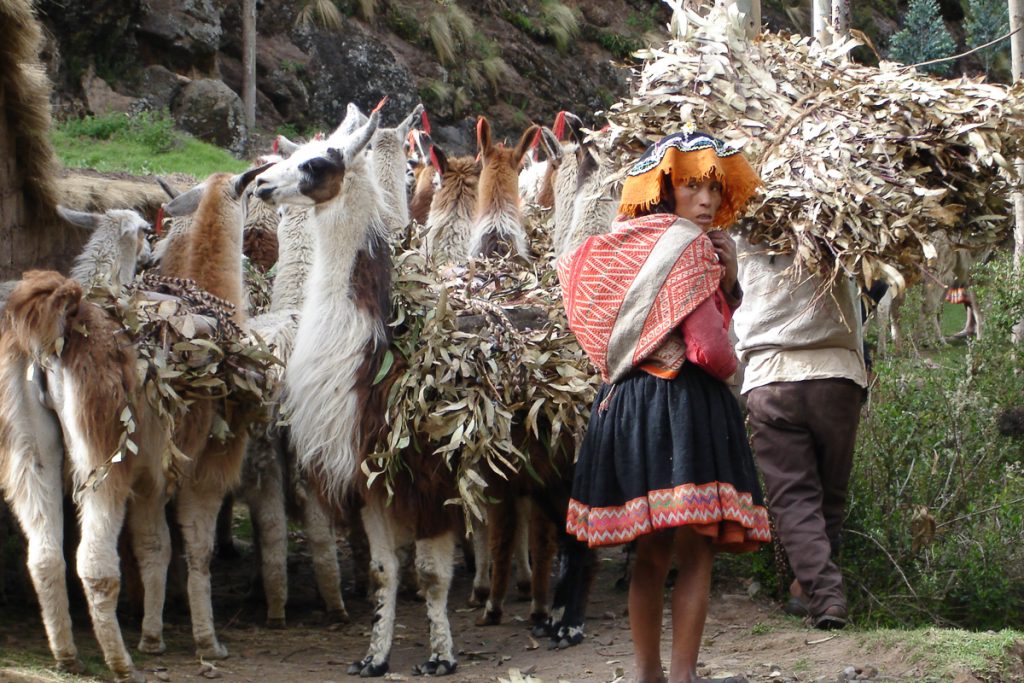
Is the Lares Trek Better than the Inca Trail?
That depends on your trekking preferences! Read the below points and decide for yourself to be sure you decide which is truly the best fit for you.

Lares Trek Permits are easy to get than the Inca Trail
Yes, the Inca Trail is world-famous. But there is an undeniable permit issue. With just 500 Inca Trail permits offered per day, and a majority of these going to the staff that accompanies trekkers (porters, guides, cooks, etc), permits sell out extremely quickly .
The KM104 Inca Trail permits have a special allocation of 250 permits and rarely sell out- making this a great option for those who are nervous for a longer trek but really want to hike some sort of Inca Trail. Although ALL Machu Picchu tickets selling out is becoming increasingly common in the wake of the COVID pandemic.
The Lares Trek, unlike the Inca Trail, never sells out as it is not a trek that requires permits- simply a hike through the beautiful Lares Valley.
You still get the Sun Gate and other Inca ruins on the Lares Trek
Many people have heard of the Sun Gate as the classic way to get your first sight of Machu Picchu, and it’s completely worth the hype. Hiking through the Sun Gate is a fantastic experience, and that’s why we love to add the KM104 one-day Inca Trail trek into Machu Picchu onto the classic Lares Trek . We believe that this combines the best of both worlds- history, and culture. Plus, it’s pretty unlikely that you will ever do a trek into Machu Picchu again, so why not enjoy the best of both worlds?
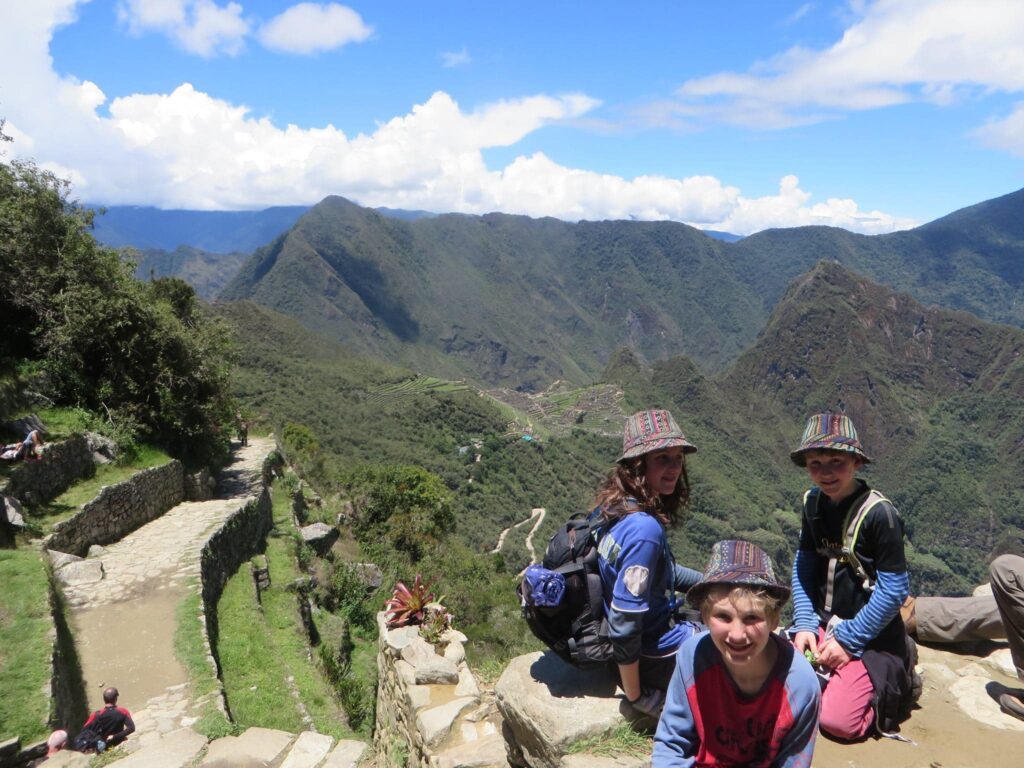
The Sungate
The Lares Trek Only has Two Nights Camping, vs 3 or 4 on the Inca Trail
Not everyone likes camping! Even though we believe that camping in Peru is a different experience that everyone should try, some people simply are not interested in spending the four days in a tent which is demanded by the Inca Trail. So, the Lares Trek has just two nights of camping- just enough to see the beauty of the milky way and appreciate the silence and the dark of night times in Peru. (Plus if you really really hate camping then we have a luxury camping option- complete with beds). The other two nights of the trek are spent in comfortable hotels along the route.

Night sky in Peru
Check out: Our complete list of alternatives to the Inca Trail and find your perfect way to experience the Andes away from the crowds.
The Lares Trek is Easier than the Inca Trail
The Lares Trek is easier than Salkantay , Ausangate or Choquequirao to Machu Picchu , thus more suitable for a wider range of people.
If you are fit, healthy, and up for a challenge then the Lares Trek might not offer enough of a challenge for you- making the Inca Trail a bit more your speed. However, if you’re nervous about altitude, rolling an ankle, or any of the potential pitfalls of the Inca Trail then the Lares is a good alternative.
Far Fewer People Choose to do the Lares Trek than the Inca Trail
If you choose to do the standard four-day Inca Trail, your route and your campsites will be overflowing with other tourists- 499 other trekkers to be exact- as the 500 permits offered each day for the Inca Trail always sell out. We tend to avoid this problem by offering a 5 day Inca Trail instead of the usual 4 day route. This practically guarantees you the route to yourself.
However, the Lares Trek has practically no other hikers- a lot of companies choose slightly different routes- so the chances of you running into another group of hikers is almost non-existent. And isn’t that what hiking in Peru is about?

Queue of people on the Inca Trail
The Lares Trek has the best backup of any trek
The very nature of the Lares Trek means that a backup vehicle is never too far behind. That means that your night bags, food, water, and emergency help are never far away. This is not the same on the Inca Trail, which is one of the most difficult treks to evacuate from, as it does not allow mules and there are no roads close by. On the Inca Trail, if you get into trouble, the only option you have is to be evacuated by a porter.
The Lares Trek is completely do-able for almost anyone
The ascents and descents of the Lares Trek are reasonable. They are nowhere near as tough as the Inca Trail, Choquequirao, Ausangate or Salkantay. (You can read our head-to-head comparison of the Salkantay Trek and the Inca Trail here ). During the Lares Trek, you walk for the most part on wide trails, where you can stroll two abreast chatting away. The daily distance is not too far. It is only 4 days and 3 nights. And if you get tired you can jump on a horse for a bit. It makes for the perfect achievable trek for everyone. Kids love it too. Yet it is also tough enough to feel like a good challenge for everyone.
This is not the case for the Inca Trail. The Inca Trail is a challenging hike, suitable for those who are reasonably fit and who are accustomed to the altitude in Cusco.
You have more comfort than any other trek on the Lares Trek
This comfort comes down to the vehicles that accompany trekkers on the Lares. They can carry heavy items that would require huge teams of porters or horses. You also do not have to feel guilty when you are sitting there in luxury, worrying about who had to carry it, as you might on the Inca Trail- as the Inca Trail uses exclusively porters. If you appreciate your comforts and that your days of roughing it are behind you, the Lares Trek is a better choice than the Inca Trail. Having that extra comfort is great, and due to weight restrictions, isn’t available on the Inca Trail.
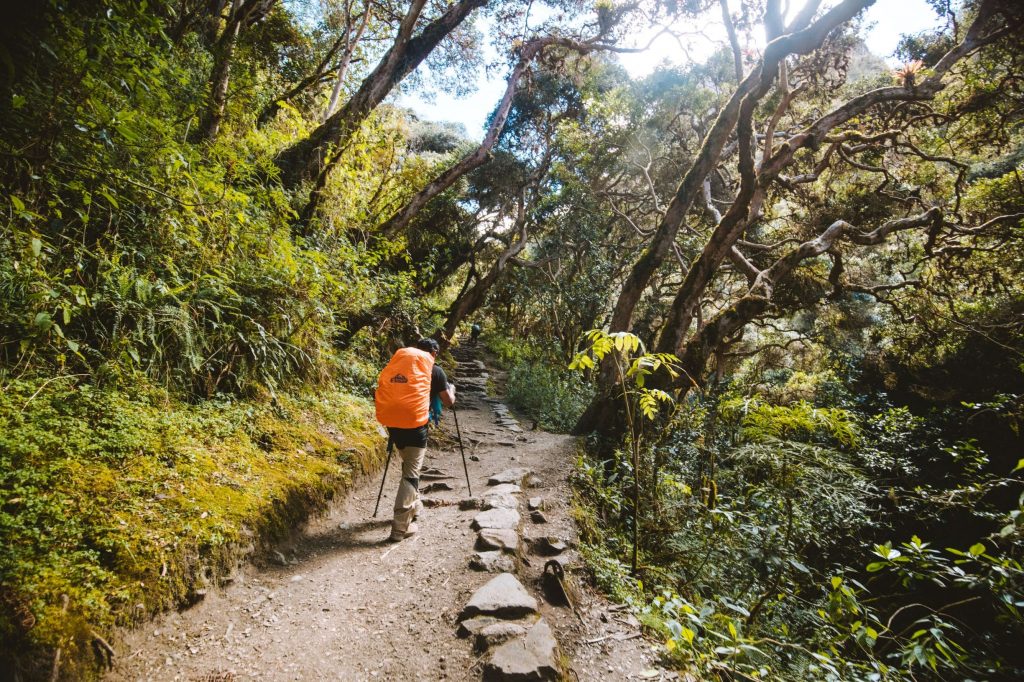
Lares offers more of an insight into Peruvian life than the Inca Trail
Travel is not just about seeing nice places. You will really appreciate the insights into local life you get. The Lares Valley is a fascinating place, untouched by time. It is the Peruvian equivalent of visiting the Masai or the Thai hill tribes before the crowds got there. The people of Lares are almost completely unchanged by tourism. No other trek has as many local villages en route. The Inca Trail does not pass through any villages, but it is an interesting look into lives gone by, and the history of the Incas. Whether you prefer to soak in the culture of now, or the culture of times gone by will influence whether you prefer the Inca Trail or the Lares Trek.
Because we have worked with the Lares communities for years, planting trees and helping them in other ways such as donating laptops and photocopiers, you get special treatment. The locals see plenty of agencies coming through who do not care for them or the area at all. At Amazonas Explorer, we are one of the few who do, and as such, we get very well looked after by the communities. They give us the best campsites and do all they can to make your trek as enjoyable as possible.
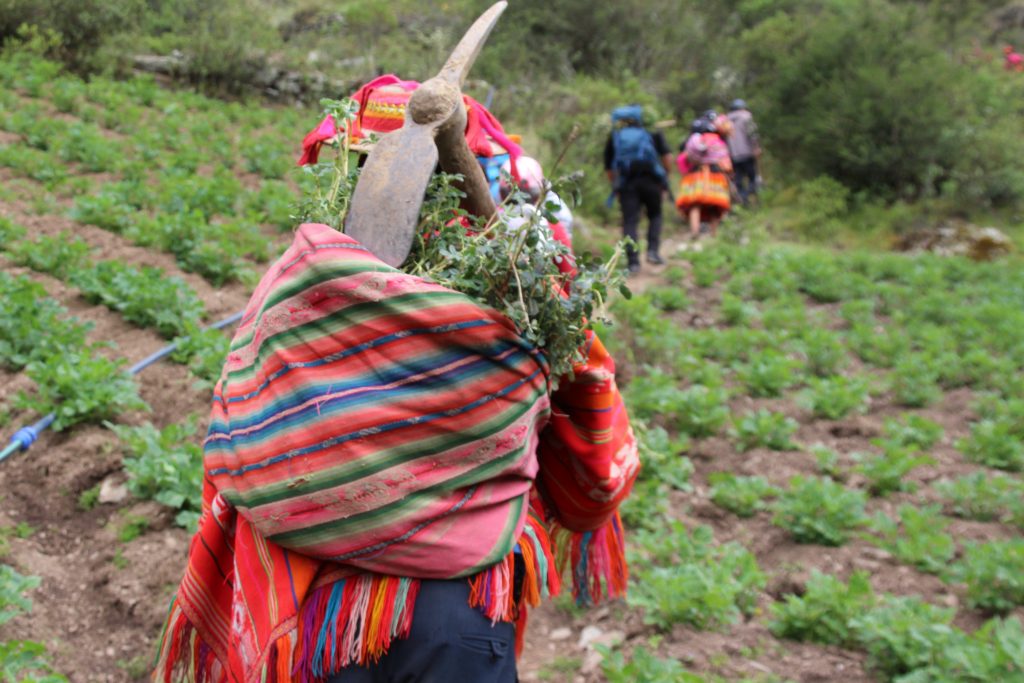
Queña Raymi Lares People
So while you do not have the amazing ancient ruins of the Inca trail, the huge glacial scenery of Ausangate or Salkantay , or the remoteness of Choquequirao , when it comes down to the modern day traveler, Lares could well be the perfect option.
If you are ready to start planning your trip to Peru, contact us or check out our recommended adventures for ideas, adventures, and updates.
- Search for:
Recent Posts
- 4 Days Rafting the Apurímac Canyon- From Personal Experience
- Sponsor a Tree in Peru and Help with Reforestation!
- Christmas in Peru: Local Traditions and How to Visit
- Amazonas Explorer Climate Action Plan
- The Best Multi Day Rafting Trips in Peru
- English Blog
- Mountain biking in peru
- Uncategorized
We create safe, responsibly run adventures in Cusco and the Sacred Valley for lovers of the great outdoors. We are a Certified B Corps and hold all Adventure Licenses for the activities we offer. Sitemap
Enquiries: US/CANADA Toll Free 1 (888) 696-0505 Email: [email protected] Whatsapp: +51 954165014
Emergency: Maria Del Pilar Handa- Operations Manager Tel:+ 51 984765446
Address: Avenida Collasuyo 910, Miravalle, Cusco
Hours: 9am-4pm local time (GMT-5)
Amazonas Explorer Ⓒ 2022 Peru Adventure Experts Since 1985 .
Visit our Blog
View Our Privacy Policy
Terms and Conditions
- Cleaning Campaign of the Lucre-Huacarpay Swamp
- Mother’s Hands that Save the World
- Salkantay Trekking is Recognized for its Social Service
- Alternative treks to the Inca Trail to reach Machu Picchu
- Things you need for traveling to Peru – What to wear
- Adventure Sports you should practice when in Cusco
- Machu Picchu Mountain vs Huayna Picchu
- Everything you Need to Know About the Inca Trail in 2024
- Five tips before taking the Inca Trail
- 7 Famous Foods you Must Try in Cusco
Salkantay Treks
Salkantay trekking companyy.

Getting to Machu Picchu: Inca Trail or Lares Trek
For many travelers, it’s a dream to walk to the great Inca citadel of Machu Picchu. Although there is only one destination, there are several options that you can choose to fulfill your fantasy. The world-famous Inca Trail and the Lares Trek are considered by specialists as 2 of the best alternatives. Still don’t know which one to choose? Here we present a comparative description where you can study the pros and cons of both trails and make your decision in the best way.
You’re just a short time away from starting one of the most incredible trips of your entire life. Walking through the sacred Andean mountains will test your physical and mental resistance. You’ll travel ancient pilgrimage routes that served to purify body and mind before reaching a ritual site as powerful as Machu Picchu . To help you make the best decision, we will take a brief but in-depth look at the attributes of each excursion and carry out an accurate analysis. Inca Trail or Lares Trek? Find out which one best suits you.
The Inca Trail has long attracted the attention of tourists from around the world. This makes it the most popular option to walk to Machu Picchu. The part that tourists go through is just a small section of a gigantic and complex road system that connects the entire Tahuantinsuyu: from Santiago in Chile to Cuenca, Ecuador, approximately. The most difficult day of this excursion is the second due to the long climb and the number of steps; however, your reward will be the impressive views of the valley from above. Remember that the descents are quite steep and your knees can start to hurt. In addition, along this entire route, you get to discover impressive archaeological sites.
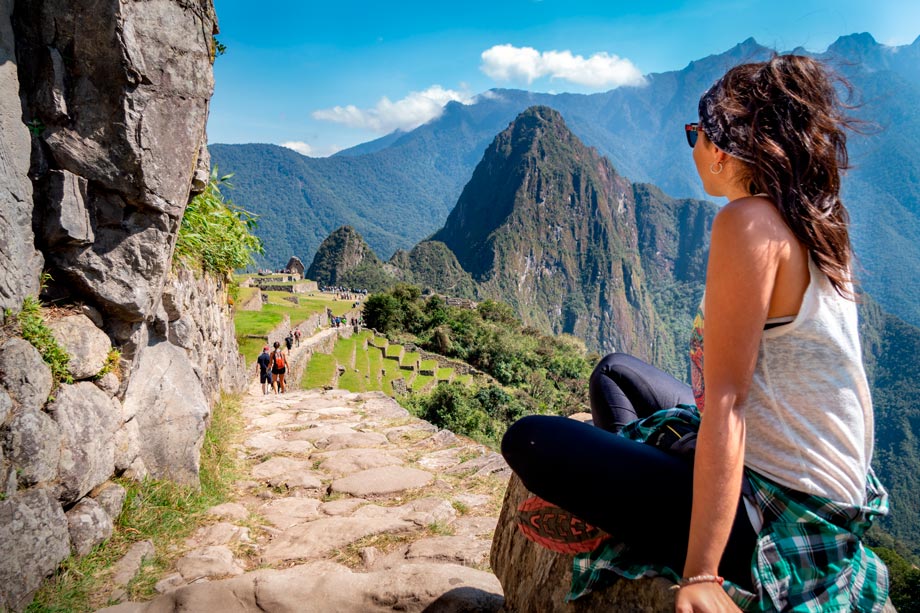
The highlights of the Inca Trail
- This is the “original” route to walk to Machu Picchu.
- It’s the only route that can direct walkers to the very gates of Machu Picchu.
- You’ll enjoy the fantasy landscapes of the Andean mountains and within the cloud forest.
- You will reach the highest point at the Dead Woman’s pass at 4,212 masl / 13,818 fasl
- There are various archaeological sites along the entire path.
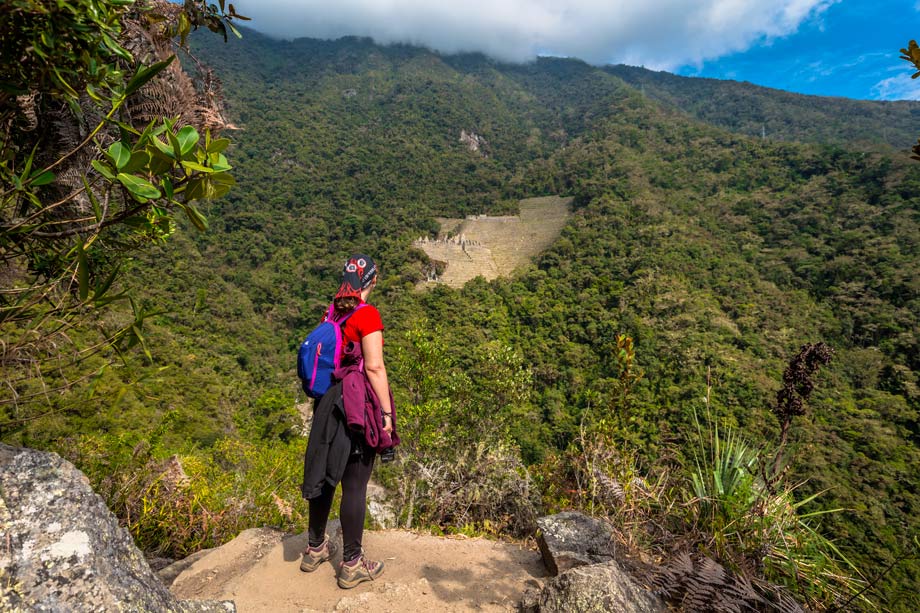
Should I choose the Inca Trail?
If your desire is to travel the mysterious original path that the Incas used to reach Machu Picchu, this route is for you. However, due to limited capacity, you need to book your tour several months in advance. Furthermore, this is the only route that takes you directly to the archaeological site of Machu Picchu. There’s nothing better than observing the impressive stone citadel from Puerta del Sol (The Sun Gate) after 4 days of intense walking.
Remember that in all other excursions you must travel by train to Aguas Calientes to rest in a hotel and enjoy your visit to Machu Picchu the next day.
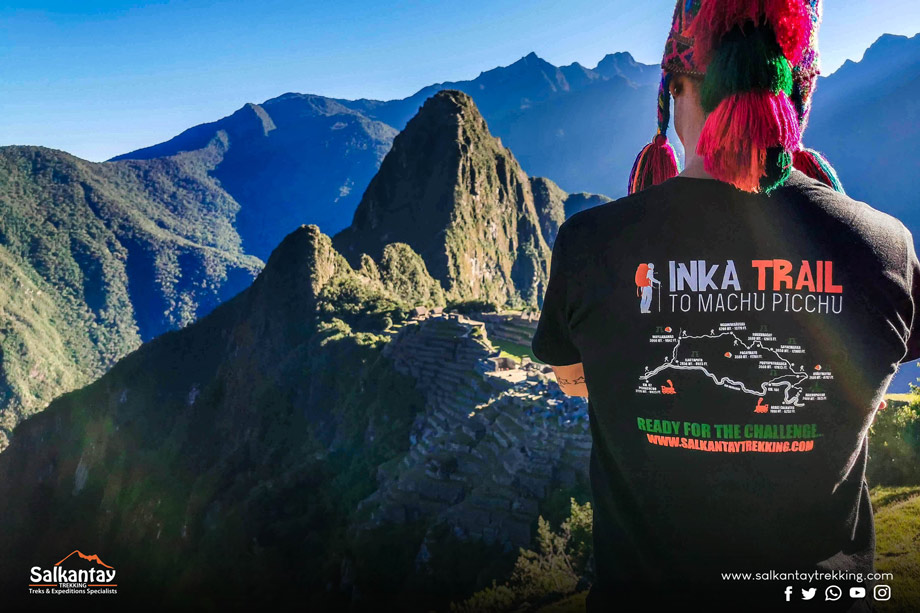
The Lares Trek or Lares Route is as challenging as the Inca Trail, and for this reason, many tourists choose this option to avoid the crowds. In addition to being close to the city of Cusco and other tourist sites, Lares is excellent for appreciating the daily life of the Andean man who has not lost his deep relationship with Mother Earth. In addition, it’s an excellent route to connect with the spirit of the water since you’ll be able to contemplate incredible lagoons and waterfalls.
You’ll be transported to a place visited by very few tourists, where the Andean ancestral culture shines like fire. You’ll be able to make new friends in the traditional communities along the way, in addition to appreciating their fine textile art. Treat all people with great respect and learn from their lifestyle.
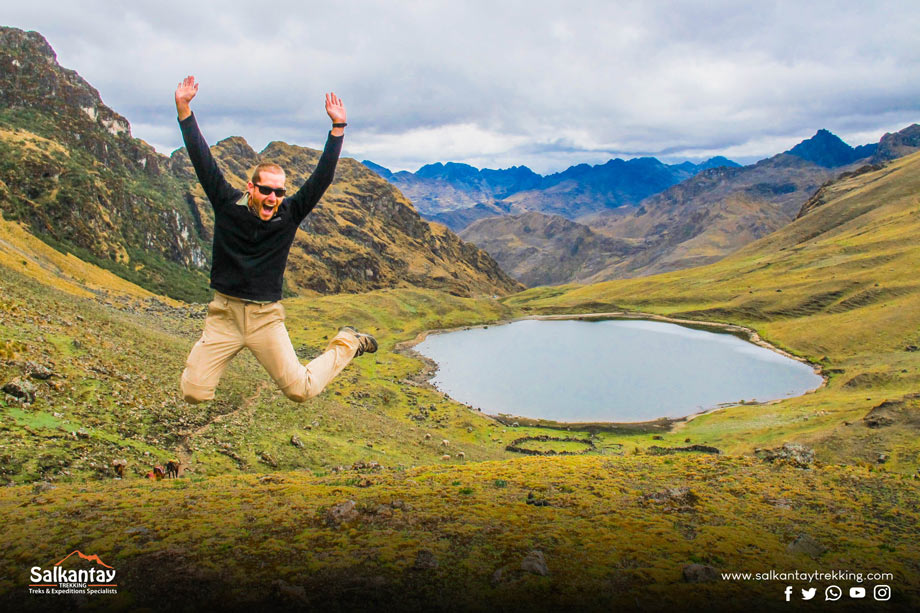
The highlights of the Lares Trek
- It’s a much less congested route than the Inca Trail.
- It highlights its natural beauty and the majesty of its bodies of water: multicolored lagoons and sacred waterfalls.
- It’s an experience of contact with traditional Andean culture.
- The highest point is slightly higher than on the Inca Trail: Abra de Pachacuteq at 4,450 masl / 14,599 fasl
- The visit to Machu Picchu is made on the last day, after resting for a night in the small city of Aguas Calientes.
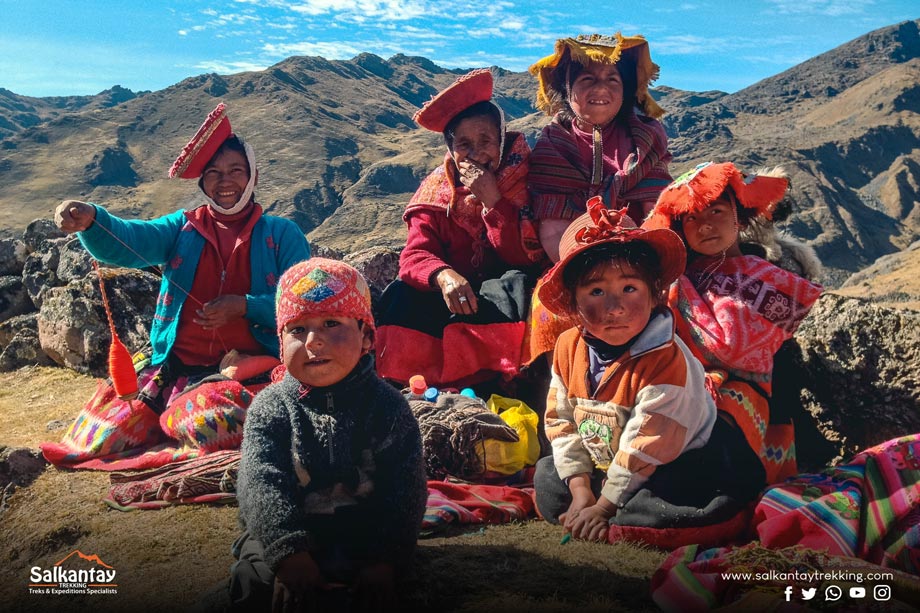
Should I choose the Lares Trek?
If you want to enjoy an impressive walk through the Sacred Valley, one of the most splendid places in the Cusco region, and sacrifice the fact that you will not walk directly to the gates of Machu Picchu, the Lares Trek offers you a more authentic tourist experience . It also brings you closer to the most traditional lifestyle in the mountains of Peru. To do the Lares Trek you only need to spend 2 nights in camps and 1 night in the hotel in Aguas Calientes, so if you have little time in Cusco, this route is ideal for you.
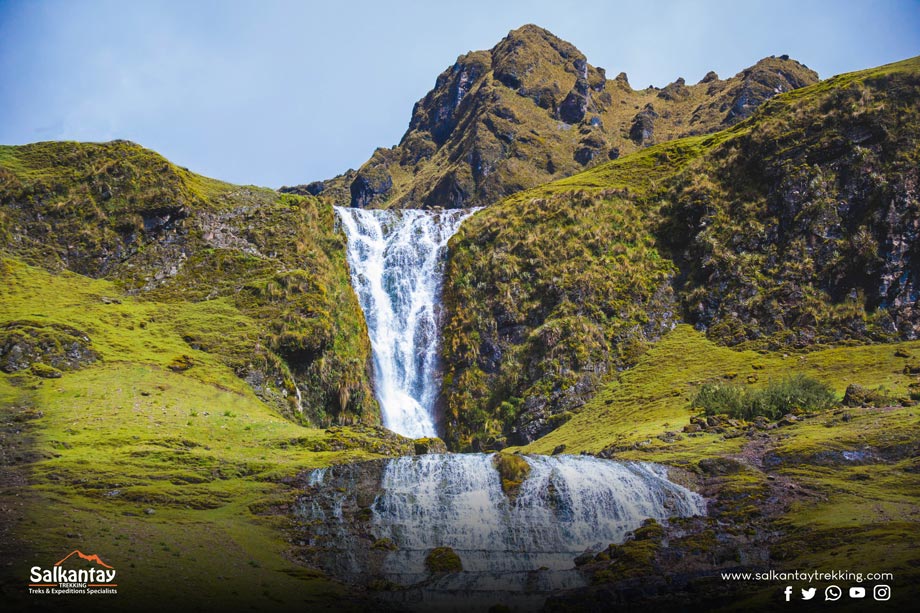
Salkantay Trekking
Leave a reply, leave a reply cancel reply.
Your email address will not be published. Required fields are marked *
Save my name, email, and website in this browser for the next time I comment.
Popular Posts
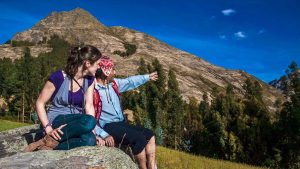
Recent Posts
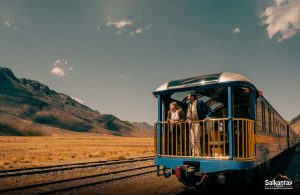
- Choquequirao Treks
- Huchuy Qosqo Trek
- Lares Trek to Machu Picchu
- Inca Jungle to Machu Picchu
- Inca Trail Classic 4 Days
- Inca Trail Short 2 Days
Alternative Treks
- Machu Picchu One Day Tour
- City Tour Cusco – Half Day
- Sacred Valley of The Incas 1 Day
- Ausangate Rainbow Mountain 1 Day
- Huchuy Qosqo Trek 1 Day
- Humantay Lake Full Day
- Sky Camp & Humantay Lake 2 Days
Social Media
Hrmm. Looks like you're using an older browser, which means some site features may not work they way they should. For the full gadventures.com experience, we recommend upgrading to the most recent version of your browser . It's worth it! Honest!
View all tours
North America
Central america & caribbean, south america, north africa & middle east.
Few travellers make it to this icy continent, but the lucky ones who do get to explore a frozen Eden ruled by the elements and teeming with wildlife.
G Adventures Land
G adventures sailing & cruises, g adventures private travel.
Whether it’s a family retreat or a girls trip, you can surround yourself with a hand-picked crew and customize a tour that fits you all perfectly.
The Geluxe Collection
Our new line of premium active adventures is officially here. With perfectly paced itineraries, one-of-a-kind accommodations and elevated dining, this is adventure at its finest.
National Geographic Journeys
Go deeper into the cultures and habitats of the places we explore. More is included and you’ll enjoy greater hands-on exploration, interactions with local experts, and freedom to roam.
National Geographic Family Journeys
Are you an adventure-loving family in search of meaningful ways to discover the world together? These tours are specially designed for travellers seven and up and their inquisitive families.
Jane Goodall Collection
Step deeper into the animal kingdom while respecting all of its inhabitants. Our incredible collection of 20 wildlife-focused tours is endorsed by the world-renowned ethologist.
Roamies by Hostelworld
The thrill of adventure. The awesomeness of hostels. Get ‘em both on these immersive small group trips for 18 to 35-year-old travellers.
Why choose us
As the leader in small group travel for 30 years, we know how to do it right: flexible itineraries, freedom to roam, safety, peace of mind, and locally based guides.
Change the world just by having the time of your life. When you travel with us, you become a force for good by acting responsibly and creating positive impact.
Together with our non-profit partner, Planeterra, we ensure local communities touched by our tours benefit from our visits in as many ways possible.
Trees for Days
Leave your destination even greener than you found it! For every day on tour, we’ll plant a tree in your honour and ensure that our forests get to live their best lives.
Travel resources
Last minute deals.
Looking to have the time of your life in the next 90 days or so? You can save big if you’re ready to book now.
Loyalty discount
Back home from a G Adventures tour? Submit a quick trip evaluation to save 5% on your next tour with us.
Student discount
Got proof that you’re pursuing higher learning? Then we’ve got a travel voucher with your name on it.
All travel deals
New ways to save pop up all the time. Here’s where you’ll find every hot deal in one easy place.

Reaching Machu Picchu: The Inca Trail or Lares Trek?
Inca trail or lares trek g adventures' very own alistair butchers takes on the classic debate. lace up your boots, where you end up might surprise you.
Of all of us that work for G Adventures around the world, few are as qualified to answer this question as Alistair Butchers, Innovation Manager for Active and Family product. So we asked, and he answered.
Wine or beer? Cats or dogs? Sun or snow? The Beatles or the Stones? They’re tough questions that don’t really have right answers (except for the last one, which is clearly the Stones). The same can be said of a question we get all the time: “If I want to see Machu Picchu, should I take the Inca Trail or the Lares Trek ?” Well, both of these classic treks lead to the same incredible destination and both offer beguiling ways to reach it.
The trekking

Inca Trail. The Inca Trail is undoubtedly the more well known of the two. Opened years before the Lares Trek, it’s become very popular with travellers the world over. Starting at km 82 at an altitude of 2,700m (8,858 ft), you climb up to a high point of 4,215m (13,828 ft) at Dead Woman’s Pass.
There is now a limit of 500 daily trekking permits, so while there are times when you’re trekking with no one else around, you’ll likely encounter more people at busy sections, and it does mean campsites can get busy.
Lares Trek. By comparison, the Lares Trek is a much less discovered route so at times, it does feel you are alone with the mountains. Starting at 3,200m (10,499 ft), you ascend up to a maximum of 4,600m (15,092 ft).
Trekking at higher altitudes means you need to be aware of the effects of altitude sickness, and while there’s no way to know if you’ll be affected, as long as you keep your own pace and stay hydrated, you should be fine. There are also no permit restrictions for the Lares Trek, but also nowhere near as many trekkers either.
It’s hard to say which of these routes is harder. You are dealing with more ascents and descents on the Inca Trail, while walking at a higher altitude on the Lares Trek. Both bring unique challenges of their own.
Further reading
- The 7 Stages of Inca Trail Trekking
The Campsites

Inca Trail. Because of the permit system on the Inca Trail, there are more regulations on this route. This means campsites are also regulated, and that means there are specific spots to pitch a tent. The plus side of this is that some of the sites have working toilets and showers – cold showers, but a refreshing wash nonetheless.
Lares Trek. Lares Trek camping is much less regulated, meaning there’s a lack of facilities after the first night in a Planeterra-supported campsite . What this is replaced by is the atmosphere of staying near small settlements, where local people are happy to see you and offer a small slice of village life.

Inca Trail. The views you see on each trek offer something very different. The Inca Trail offers a time-worn path to Machu Picchu. This means passing ancient Inca ruins clinging to hillsides along the way. The history each day is dense and fascinating.
Lares Trek. While you do pass ruins on the Lares Trek, there are nowhere near as many and are much less of a factor in the hike. Instead, you get plenty of clear mountain air, deep lakes and jagged peaks. The sense of remoteness is prevalent here, although you do pass through villages and farms on the way. The Lares Trek very much feels like a part of the living experience of Peru, instead of making a way through ancient history.
Further Reading
Instagrams of the Week: Trekking Peru
Time-Lapse Tuesday: Machu Picchu Mist
The Experience

The experience itself is difficult to compare. The one thing in common on both of the treks is the exceptional level of service that you receive including full-service camping, with three meals a day and plenty of snacks and water. All of the trekking equipment is in excellent condition, and can be easily hired for both routes.
Inca Trail. Equipment on the Inca Trail is carried by porters, who make for friendly company and provide some good encouragement when the going gets tough.
Lares Trek. Equipment on the Lares Trek, however, is carried by mule rather than porter, giving trekkers the freedom to undertake these more challenging routes. Another part of the Lares Trek experience that makes a difference is that after the trek, you continue to Aguas Calientes and spend the night in a hotel in comfort, before ascending to Machu Picchu the next morning.
An experience that stands out on all trips to the Sacred Valley is a visit to the Parwa Restaurant . Built with the help of Planeterra, this place works within the local community to provide delicious meals using produce from the surrounding areas.
And so, if I had to choose, which one would I take? This isn’t as easy as picking England’s newest hit-makers from the 60s. I’d say it’s too difficult to choose because both appeal to me in very different ways. The first image of Machu Picchu you get from the Sun Gate (on the Inca Trail) is unsurpassable; however, the views of the high peaks of the Andes while on the Lares Trek can’t be missed. At the end of the day, I’ll let you choose which you prefer.

Read more from
Capturing patagonia: an analog film adventure, by haramar kandola.
Steeple-like peaks, turquoise lagoons, contemplative moments at camp — our very own Haramar Kandola shares analog snaps from Torres del Paine

5 ways solo travel helps you meet new people
By g adventures.
See how small group tours like National Geographic Journeys with G Adventures help spark lasting connections

6 best places to propose for a unique engagement
By jessica moy.
From glowworm caves to snow monkey parks, discover our best destinations to pop the question

Going solo: how to travel the world on your own
See how small group tours pave the way for incredible solo adventures (especially for women!)

Mexican street food: a beginner's guide
By richard kitzinger.
One frequent (but first-time Mexico) traveller takes a crash course to prep for a Classic Mexico Adventure
Delete post?
Note: If you only want to remove this post from public view, you can choose to unpublish it instead.
- Peru Travel Guide
- Peru Hikes/Treks
Lares Trek vs. The Inca Trail
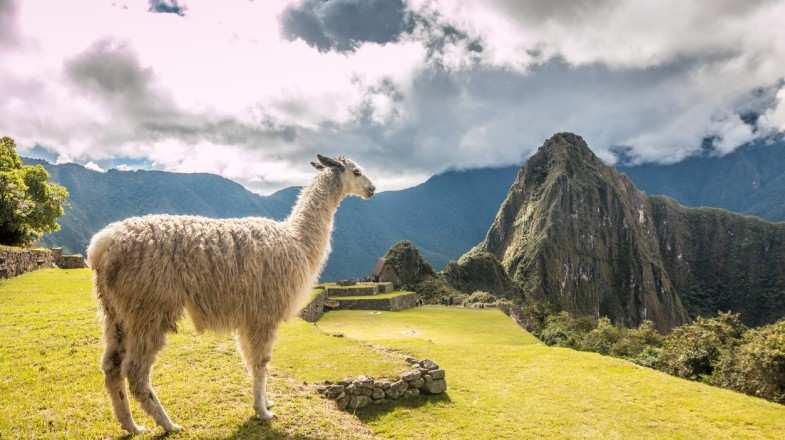
- 3.14K views
- ~ mins read
The Lares trek vs. the Inca Trail. Which one to take a classic dilemma many trekkers in Peru will face. Both treks are two of the best treks in Peru . The Inca Trail is the classic Peruvian trek and is one of the most famous multi-day treks in South America . The four-day route follows an ancient mountain trail, offering splendid views and passing various Inca ruins. The trail crosses three high passes, the highest of which is the infamous Dead Woman’s Pass (4212 m), before finally arriving at the world-famous ruins of Machu Picchu. However, the Inca Trail is also the busiest and is always fully-booked months in advance
For those searching for something more authentic, the Lares trek offers the chance to walk a route far less commonly attempted than the classic Inca Trail. The Lares trek is shorter and considered a little easier although it reaches higher altitudes than the Inca Trail. This trek offers spectacular mountain scenery of waterfalls and lakes and is commonly combined with a visit to Machu Picchu on the final day. This trek also passes through several traditional Andean villages and offers the chance to meet locals and learn about their way of life, something not possible on the classic Inca Trail.
Below we give you a breakdown of the Lares trek vs. the Inca Trail.
- Kelley Lipphard
Lares trek vs. the Inca Trail: Highlights and lowlights
Inca trail highlights.
- The ‘original’ trek to Machu Picchu
- The only trek that takes hikers right to the gates of Machu Picchu on foot
- Stunning Andean vistas and mysterious cloud forests
- Chance to cross the infamous Dead Woman’s Pass at 4212 m
- Several sets of Incan ruins along the way
Inca Trail lowlights
- Crowded trail due to its popularity
- Well-developed trail and not a “real” wilderness experience
- Can be expensive
Lares trek highlights
- Less busy than the Inca Trail
- Particularly beautiful trek featuring waterfalls and mountain lakes
- Chance to see local villages and experience traditional way of life
- Moderately hard trail with only one significantly high pass, the Ipsaycocha Pass at 4450 m
- Visit Machu Picchu on the final day (from Aguas Calientes)
Lares trek lowlights
- Does not actually end in Machu Picchu, the last night of the trek ends in Aguas Calientes, after which you can visit Machu Picchu on the following day.
Lares trek vs. the Inca Trail: Trek facts comparison

Who should choose the Inca Trail?
For some people, it is important to do the ‘real’ Inca Trail and none of the alternatives makes a satisfactory substitute. If you think there is only one trail to Machu Picchu and no visit to Peru would be complete without walking it, then obviously you should opt for the Inca Trail. Remember to book well in advance since places are limited and tickets sell out months beforehand.
This is also the only trek that truly finishes at the ruins of Machu Picchu. All other alternatives require participants to travel to Aguas Calientes for the final night followed by a visit to Machu Picchu on the next day. It is true that catching the first glimpse of the world-famous ruins through the Sun Gate after four days of tough trekking is hard to beat and is something none of the alternative treks can offer. If this is how you want to see Machu Picchu for the first time, there is no other choice.
If you decide you want to attempt the classic Inca trail, there are some things you need to bear in mind. It is by far the most popular and busiest of all the trekking routes in the area. You should not expect solitude or peace and quiet on the trail as you will be trekking with many other trekking groups. The campsites along the route are all busy and there are plenty of places to buy drinks and snacks. You should not expect a wilderness experience like in the pristine Andes far from the crowds.
The classic Inca Trail is also highly regulated, numbers are strictly controlled and documents must be shown at various checkpoints. This can detract from the overall authenticity of the experience. If you are hoping for a true taste of the wild Andes, the Inca Trail might not be the best option.

Who should choose the Lares trek?
If you want to complete a trek in the Sacred Valley and it is not important to you to arrive at Machu Picchu itself on foot, then the Lares trek offers a more rewarding and authentic trekking experience. The Lares trek is suitable for those with limited time since it is shorter than some of the other alternative treks to the Inca Trail . Only two nights are spent in tents while the third night is spent in a hotel in Aguas Calientes. Trekkers will return to Cusco after a visit to Machu Picchu on the fourth day.
This trek is slightly less challenging than the Inca Trail but still not an easy trek. What makes the Lares route unique is that it passes through several traditional mountain villages where the way of life has changed little over the centuries, giving participants the chance to meet local people and even try traditional craft activities such as weaving.
The Lares trek is one of the less commonly attempted alternatives to the Inca Trail, which means it will give participants a much more authentic wilderness experience. The Lares trekking route takes trekkers off-the-beaten-track and along paths where fewer tourists venture while still not straying too far from civilization.
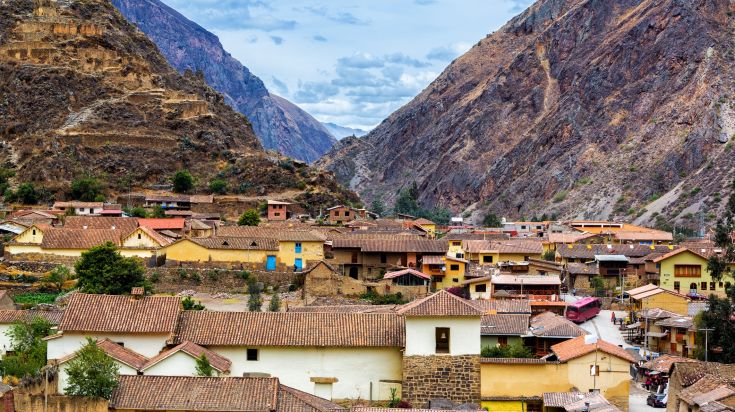
Lares trek vs the Inca Trail: Which one to choose?
Both the Lares trek and the Inca Trail are highly rewarding in their own ways. When comparing the Lares trek vs. the Inca Trail, the ultimate decision will depend upon your preference of a classic trail or something more original. You should also think about whether you want to arrive in Machu Picchu on foot or whether you are happy to visit the day after your trek, from Aguas Calientes. If you want to catch your first sight of Machu Picchu through the Sun Gate on the last day of your trek, then you should choose the Inca Trail. If you are willing to forgo this experience in return for a more novel and authentic trekking experience, the beautiful and lesser-known Lares trek is a good option.
Related Articles
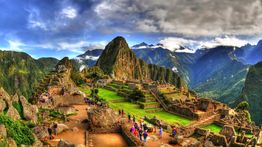
12 Best Treks in Peru - The Ultimate Trekking Guide
Whether you’re an avid hiker or an enthusiast... read more
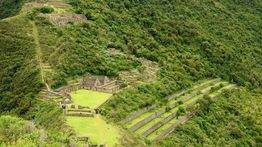
Choquequirao Trek: A Challenging Alternative to the Inca Trail
For those looking for an authentic and challe... read more
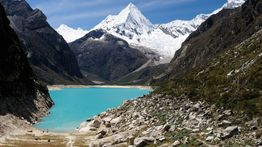
Huayhuash Circuit Trek: The Trek Less Explored
The Huayhuash trek route involves a circular ... read more
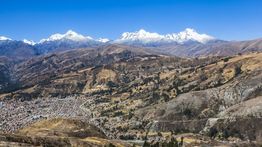
Santa Cruz Trek: Walk in the Shadow of Giants
The Santa Cruz Trek is one of the most popula... read more
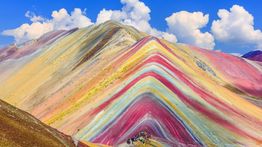
Ausangate Trek: Adventure At High Altitude
Of all the alternatives treks to the famous I... read more
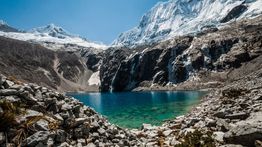
Laguna 69: A Challenging One-Day Hike
Located in the imposing Cordillera Blanca, La... read more
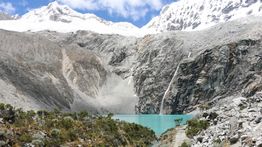
Top 5 Cordillera Blanca Trekking and Hiking Trails
The Cordillera Blanca is Peru’s premier hikin... read more
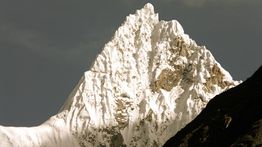
10 Mountains in Peru for Climbing: Snapshot Overview
For those who feel the magnetic pull of the m... read more
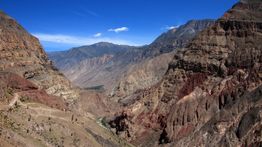
Cotahuasi Canyon Trek - Overview, Itinerary and Trek Facts
Visitors to Peru have been venturing further ... read more
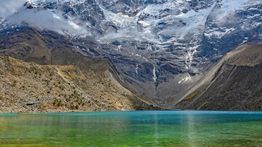
Laguna Churup: A Perfect Day Hike
The Cordillera Blanca trekking and hiking tra... read more
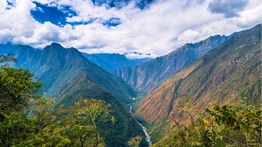
The Dead Woman's Pass: Do You Have What it Takes?
For any hiker attempting the Inca Trail, one ... read more
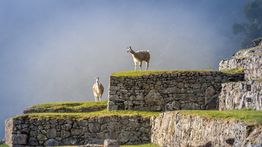
Huchuy Qosqo Trek – The Shortest Trail to Machu Picchu
For anyone short on time or concerned about t... read more
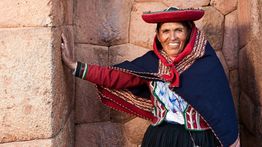
The Quarry Trail to Machu Picchu
Of all the alternative treks to the Inca Trai... read more
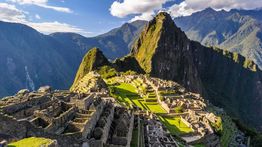
9 Best Machu Picchu Treks: The Ultimate Guide
Practically every visitor to Peru wants to vi... read more
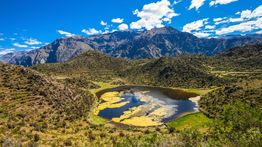
Colca Canyon Trek: Short Adventures Galore
The remote and spectacular Colca Canyon is on... read more
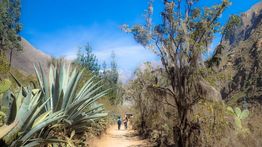
Hiking in Peru: 10 Best Day Hikes
Peru is a country perfect for lovers of the g... read more
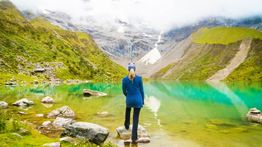
6 Great Cusco Treks
Arriving in Cusco is an adventurer's paradise... read more
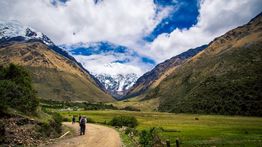
Machu Picchu Lodge Trek: Newest Trail on the Block
For those of you who want a taste of trekking... read more
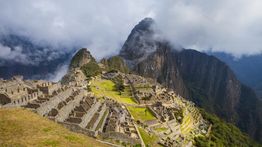
Huayna Picchu Hike: For the best views of Machu Picchu
Of the 2,500 daily visitors to Machu Picchu, ... read more

Vilcabamba Trek – An Adventurous Alternative to the Inca Trail
There are several alternative treks to the In... read more
Related Categories
- How Long To Stay In Peru
- Peru Travel Advice
- What To Do In Peru
- When To Visit Peru
- Where To Go In Peru
- Previous Post

Popular Destinations
- Europe Tours
- Everest Base Camp Trek
- Italy Tours
- Spain Tours
- Argentina Tours
- Canada Tours
- Sri Lanka Tours
- Chile Tours
- Antarctica Tours

- Salkantay Mountain
- Machu Picchu
- Ollantaytambo
- Colca Canyon
- Lake Titicaca
- Sacred Valley of the Incas
- Amazon Rainforest
- Nazca Lines
- Choquequirao
- Walking & Trekking Tours
- Short Hikes & Tours
- Cultural Discovery
- Family Holidays
- Pristine Rainforest
- Multi-Adventure Tours
- Peru Travel Packages
- Luxury Holidays Tours
- Inca Trail Alternative Treks
- Tickets, Tours & Guide 2024
- San Martin School
- Reusable snack bags
- Reforestation with Native Trees
- Essentials Peru
- The best time to visit Peru
- What to bring on a Hike
- Things to do in Peru
- Getting to Machu Picchu
- Inca Trail Trek & Tours FAQs
- Camping Equipment
- How to Book & Payment
- Booking terms & conditions
- Coronavirus Travel Policy
Lares Trek vs Inca Trail
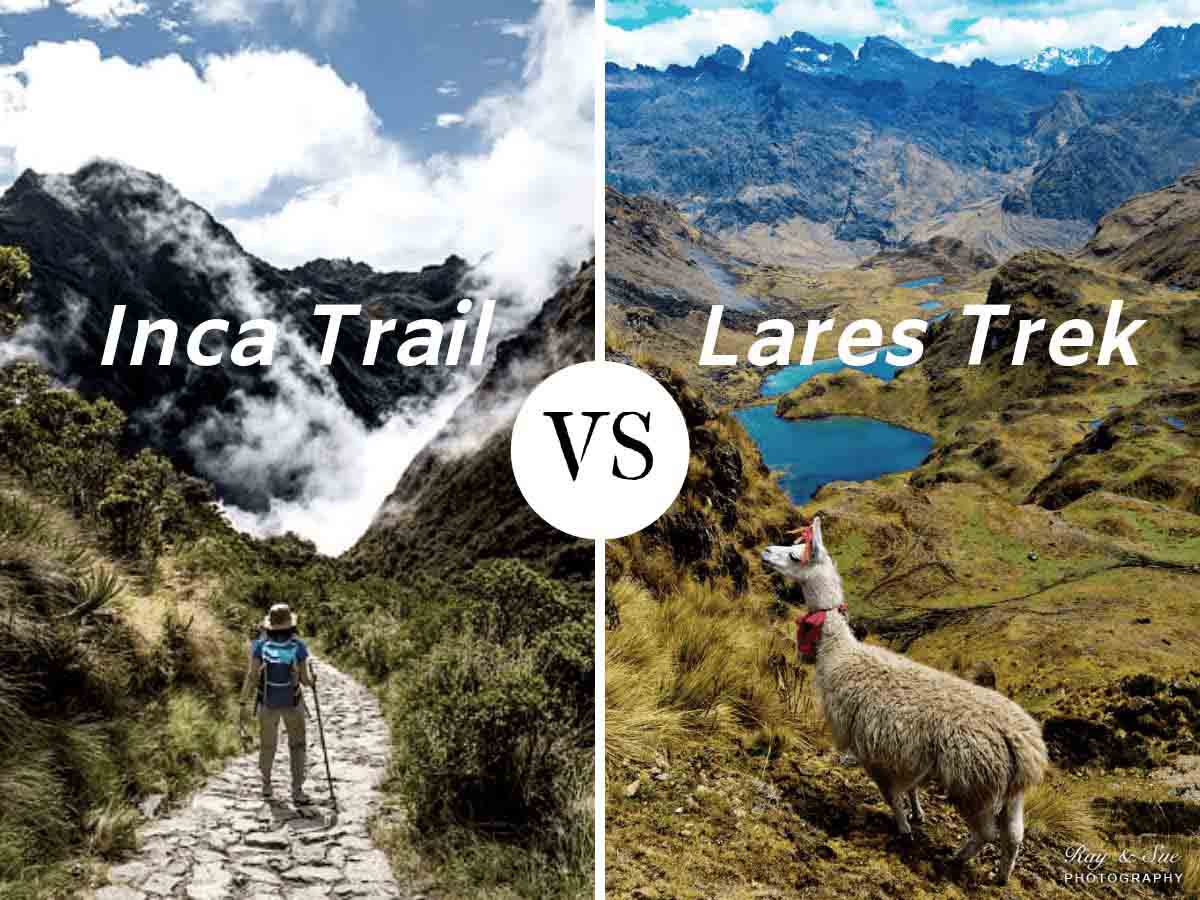
While planning your trip to Peru and specifically to Machu Picchu , you are undoubtedly waiting for the trip of your life, and there are many decisions to make regarding your trip. One of the most important decisions faced by visitors to Machu Picchu is how they want to get there, and many times that decision is reduced to a simple question:
Which is best - Lares Trek or Inca Trail? You would think that when traveling to Peru the most difficult decision would be what to pack, where to stay, and other unknowns involved with traveling to a faraway location. However, often the toughest choice is which trek to take to Machu Picchu. Most people have heard of the Inca Trail but there are many other trails in the region that are stunning and do not require permits, such as Lares Trek. Read the article below for more information about these two trails to help you decide!
Undoubtedly, the most famous of the two tours, the Inca Trail is undoubtedly more widely known than its less-known cousin. If the purpose of your trip is simply to show off to friends and family when you get home, the Camino del Inca is definitely the way to go, but we hope you never make such a frivolous decision!
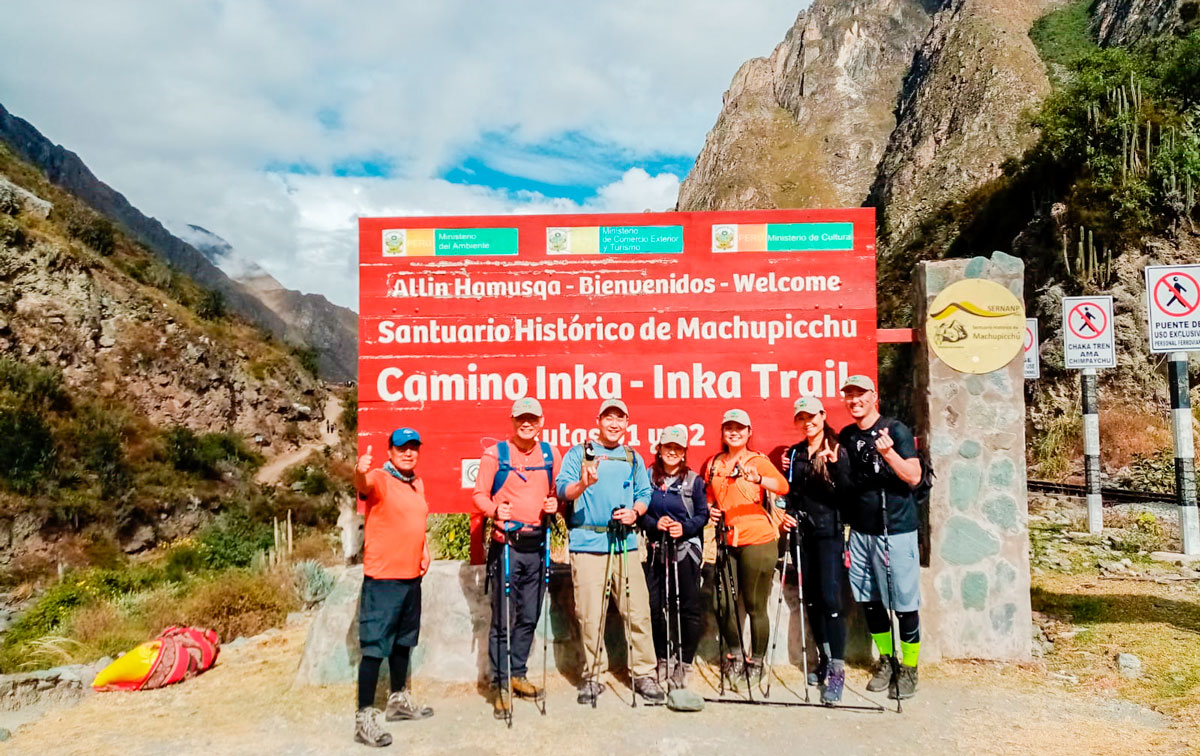
The Inca Trail is definitely the most historic option. Before arriving at Machu Picchu, you will walk through a variety of Inca ruins, sites unreachable for tourists by any other means, and although Machu Picchu can be full of tourists, you will surely find each of these sites comparatively quieter and calmer.
Another decisive factor in the Lares trek vs Inca Trail for many visitors who choose the Inca Trail is the fact that it is the only way to get to Machu Picchu through the famous Sun Gate of the ancient city. This experience is so beautiful that it can be emotionally overwhelming, and many visitors look back to find it one of the most memorable moments of their lives.
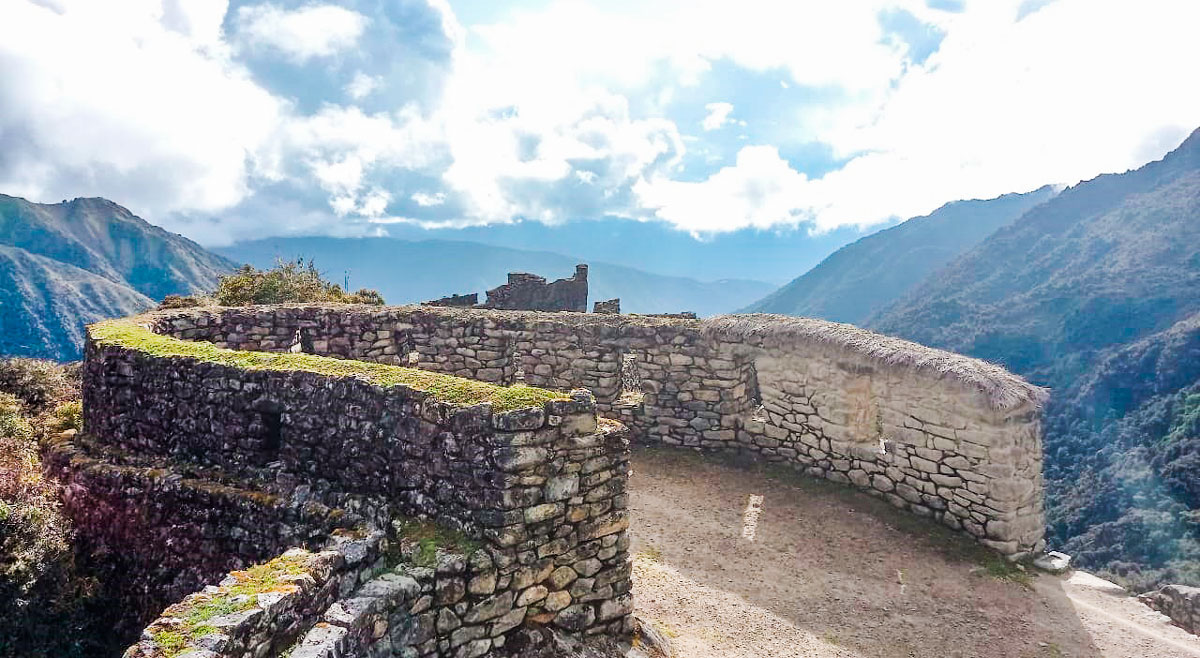
Also in this Lares trek vs Inca trail , there are some potential disadvantages to the Inca Trail. Due to its immense fame and popularity, it is necessary to plan your months of travel, and sometimes in the high season, almost a year, in advance. 500 hikers are allowed daily, half of which are guides and porters, so it can be difficult to find a place. In addition, the result is that the road can sometimes be full, especially if you are looking for a more solitary experience.
If you do not feel like waiting so long to do your walk, or maybe if you're just waiting for a different experience, do not worry! There is still another angle in the Lares trek vs Inca trail .
First of all, one good thing about the Lares Trek is that it is a little less physically complicated, but that does not mean that it is without difficulty. They are approximately 33 kilometers in comparison with the 44 kilometers of the Inca Trail. Both have a lot of altitude gains and steep descents, although once again the Inca Trail slightly surpasses the Lares Trail on this front.
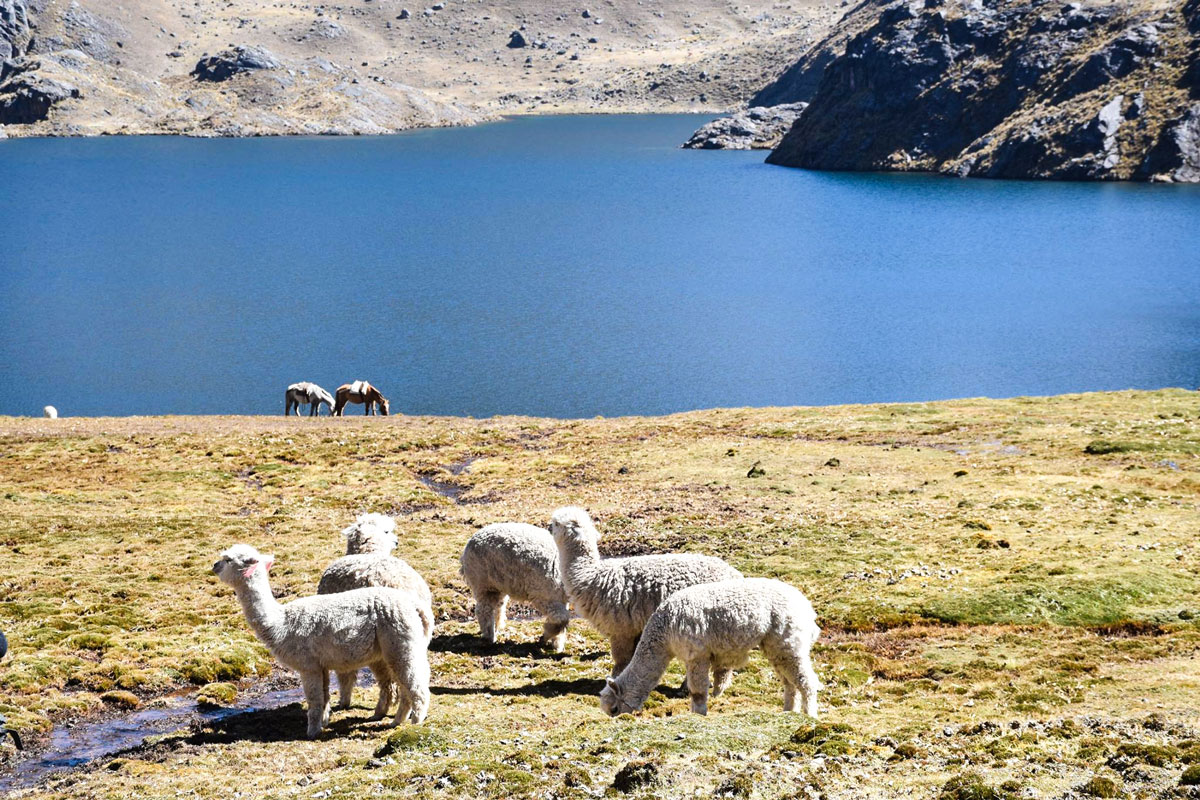
Compared to the Inca Trail, the Lares Trail is much less famous in the tourist circuit. This means that there is no competition for the tickets, it is not necessary to book so long in advance, and the walk will involve more privacy.
RELATED STORY: LARES VALLEY TREK
Which brings us to a great difference between the two paths: the Inca Trail passes through the uninhabited areas, the Lares Trail passes through villages and farms inhabited by the modern Andean people, the descendants of the Incas who built Machu Picchu. During your trip, you probably have many opportunities to interact with the indigenous peoples of Peru, so the Lares Trail is a cultural experience in a way that the Inca Trail simply is not.
The first disadvantage of Lares Trail is the fact that you do not get to Machu Picchu through the Sun Gate.
At the end of the day, there is no clear answer to the question of the Lares trek vs Inca trail : it is about your personal preferences and what you expect to get from your trip to Machu Picchu.
RELATED STORY: LARES TREK VS SALKANTAY
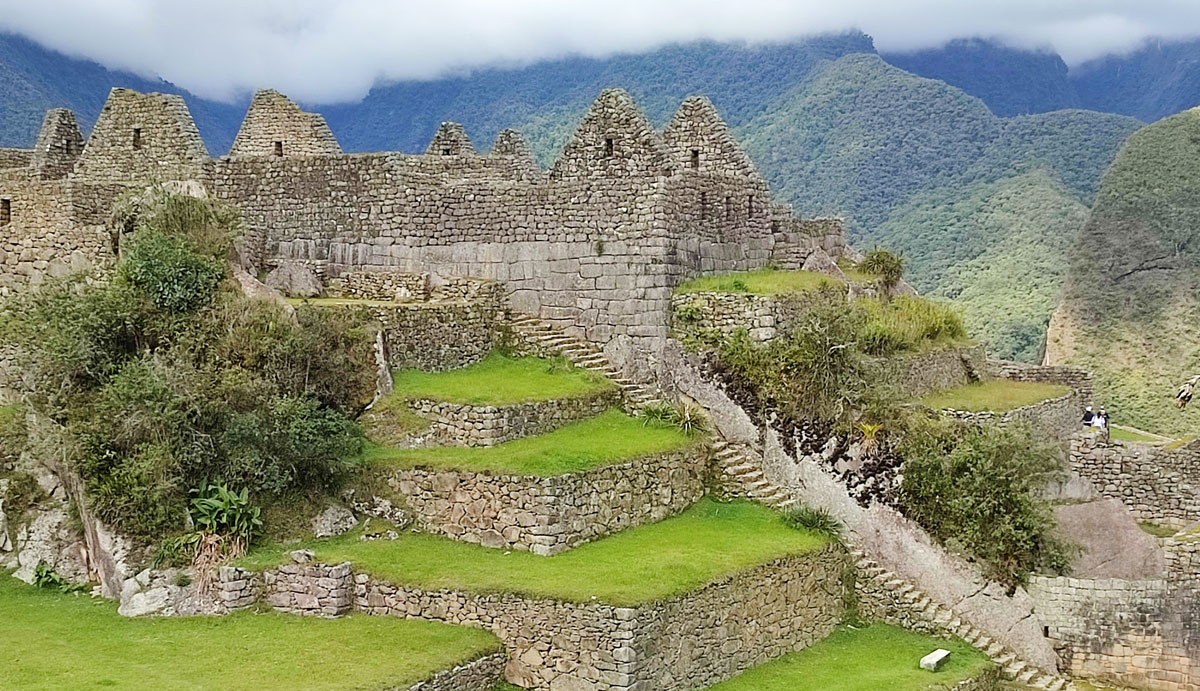
The best treks to Lares and Inca Trail
- Short Inca Trail 2 Days
- 3 Day Inca Trail
- Inca Trail Tours 4 Day
- Inca Trail Trek (9 Days/ 8 Nights)
- Lares Trek tours from Lima (9 Days/ 8 Nights)
- Peru Treks (18 Days/ 17 Nights)


Lares Trek vs. Inca Trail, Which is for You?
by Lorraine | Feb 6, 2018 | Blog , Destination Information | 3 comments

We are offering a tour to Machu Picchu via the Lares Trek. Many people have asked, what’s the difference between the Inca Trail and the Lares Hot Springs Trek and should we take your tour or wait until you offer an Inca Trail tour? Of course we would love for you to join our Lares Trek tour, but in all fairness, we want to share more about these two options to help you make the best decision.
To try and stay neutral about this decision, let’s just explore the facts about each trek.
The Inca Trail
The Inca Trail is a very historic way to relive the path of the Inca people. You will, over the 4 days, get to see 7 small ruins that only those who make the hike get to see. You will spend a lot of time marveling and contemplating this section of “roadway” that was laid by Pre-Columbian people. The famous 4 Day Inca Trail represents just one small section of their overall extensive roadway system was 39,900 kilometers (24, 800 miles) long! For more information on the ancient Inca Trail .
To trek the Inca Trail you must plan at least 6 months ahead because only 500 people are permitted to hike this trail each day. The 500 person limit includes tourists as well as all the porters required to carry camping gear, food, and more for your trip (this takes a lot of manpower!). There are no horses allowed on this trek as they would damage the stone steps. You must get a permit through an approved tour company, which will be checked along with your passport at various checkpoints as you trek along the trail. The Inca trail is much more touristy and you will see a lot of other hikers as you travel and MANY porters (move to the side to let them through). At night in the campsites you will see, hear and interact with other groups. The paths are well traveled!
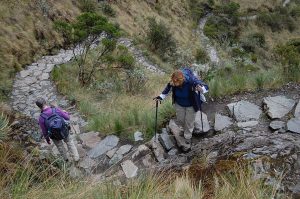
Stairs down after Dead Woman’s Pass
Do you like stairs? The Inca Trail has over 3000 stair steps, up and down, some very steep, some rough. You will travel through Cloud Forest, across high narrow bridges, through little caves and narrow walkways. There are many ascents and descents, day 2 being the most difficult to the famous Dead Woman’s Pass (4215m or 13,828 ft). You will hike up and down thousands of feet on this very long day.
You will see a lot of uninhabited landscapes and scenery while trekking. In total you will travel 42 kilometers (26 miles – same as a marathon!), which doesn’t sound like much over 4 days, but considering elevation, ascents and descents, it is quite strenuous. You will start at an altitude of 2799m (8858 ft) ascending to the highest point 4215m (13, 828 ft), Dead Woman’s Pass. On day 4 you will be woken at 4am to hike to the checkpoint, arriving at the ancient entrance of the Inca, the Sun Gate by approximately 7am (you miss sunrise over Machu Picchu). Your guide will stop you right before you enter for some preparation. It is quite a shock actually to come from the emotional and beautiful trekking experience and enter the crazy, noisy, crowded Machu Picchu. Personally, I felt it was quite anticlimactic and disappointing! Machu Picchu is amazing, of course, but seeing it with thousands of my closest friends after experiencing the Inca Trail was a bit of a let down.
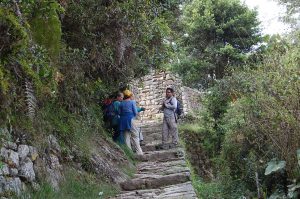
Preparing to enter the Sun Gate

First glimpse of Machu Picchu after entering the Sun Gate
If you want “bragging rights” to say you accomplished this challenging and historic trail, then you should do it for sure!
The Lares Hot Springs Trek

Hiking down into the Lares Valley alongside the Cuncani River
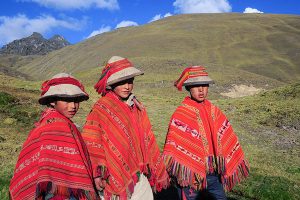
Three local Andean boys along the trail
The Lares Hot Springs Trek including a visit to Machu Picchu is also 4 days. The Lares Trek is 34 kilometers (21 miles), high altitude, but less dramatic in the ascents and descents. You start at 3200m (10,499 ft) and ascend to 4700m (15,092 ft), the highest pass being Pumahuanca. There are no permits needed as this hike is more rustic, off-the-beaten-path, and cultural as you walk through villages and farms where you will meet and interact with modern day Andean people, the descendants of the Inca. You will pass through glacial valleys, past rivers, lakes, waterfalls and of course the amazing, Lares Hot Springs where you can bathe your trekking dirt away on the 3rd day. You will be hiking in the Sacred Valley, seeing Inca ruins, landscapes and villages that have changed little over the centuries. The experience is rewarding and authentic both in the people you will meet and the wilderness you will pass through.
You will most likely not meet lots of other groups along the way. The experience is a bit more private, the campsites more remote and although it is still a challenging trail, it is less physically taxing than the Inca Trail.
After completing the trek, you will take the Vista Dome train (with large wide windows) to Aguas Calientes, where you will spend the night. You will be woken up before dawn to take the 25 minutes bus ride up to Machu Picchu and experience the sun rise over the ruins before the crowds arrive. At this early time you will capture the essence of the spirituality in the ruins. After touring the ruins, you can hike up to the Sun Gate to experience what it’s like to enter Machu Picchu via the Inca Trail and to capture photographs and views from that angle.
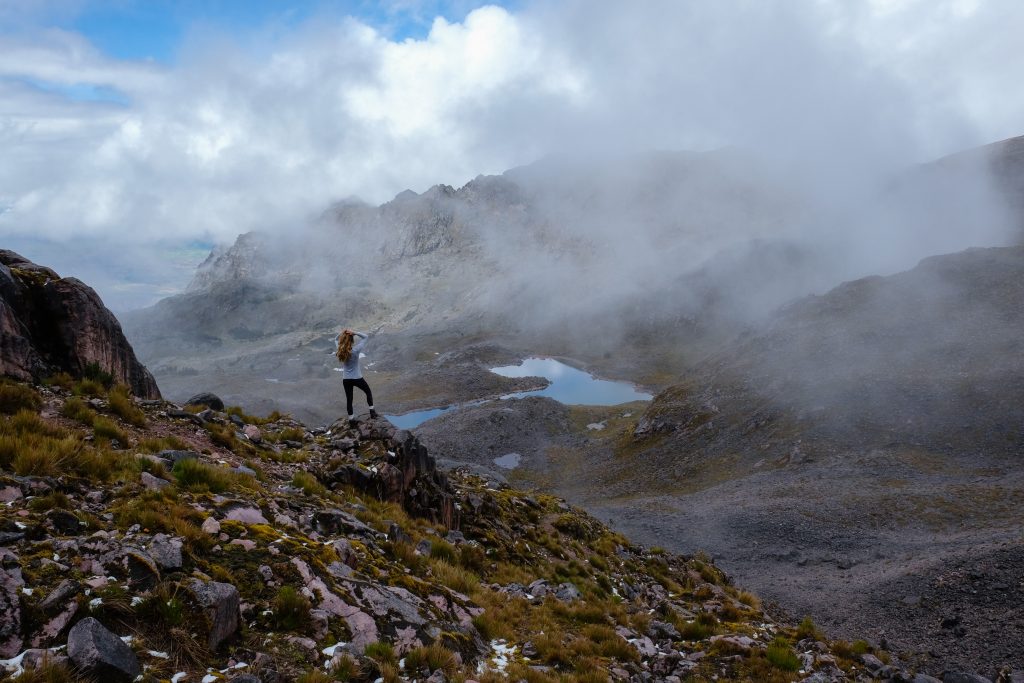
Hiking down into the Cuncani Valley with views of Yanacocha (day 2)
Submit a Comment Cancel reply
Your email address will not be published. Required fields are marked *
Recent Posts
- Armchair Travel With Me! Less Explored World’s Natural Wonders
- Armchair Travel With Me – Driving the Ring Road Around Iceland
- Armchair Travel With Me – Dreaming of Venice
- My Egyptian Escape
- Exclusive Interview with Holland America’s Lauren Green
Recent Comments
- Elinor on Lares Trek vs. Inca Trail, Which is for You?
- google on Tanzanian Safari, Trip of a Lifetime!
- free windows app download on Choose the Right Tour For Your Next Adventure
- tinyurl.com on Port Stop Bratislava
- rechargeable rabbit on Choose the Right Tour For Your Next Adventure
- January 2020
- December 2019
- November 2019
- August 2019
- September 2018
- February 2018
- January 2018
- January 2017

- Destination Information
- General Information
- Interviews – Supplier & Traveler
- Travel Stories
- Travel Tips

- Personal Data Protection
- Terms & Conditions
- Legal Information
- Cusco City Tour Half Day
- Cusco to Machu Picchu Full Day
- Homestay in Ccaccacollo, Sacred Valley & Machu Picchu 3D/2N
- Lake Titicaca Tour 4D/3N
- Maras Moray Half Day
- Machu Picchu by Vistadome Train Full Day
- Machu Picchu, Huayna Picchu / Mt. Machu Picchu 2D/1N
- Peru Sacred Valley Tour Full Day
- Qeswachaka Inca Rope Bridge Tour Full Day
- Sacred Valley & ATV Tour Full Day
- Sacred Valley & Machu Picchu Tour 2D/1N
- Sacred Valley, Short Inka Trail & Mountain Rainbow 4D/3N
- South Valley Tour Half Day
- Ancascocha Trek To Machu Picchu 5D/4N
- Ausangate Trek 6D/5N
- Choquequirao Trek 9D/8N
- Huchuy Qosqo Trek to Machu Picchu 3D/2N
- Inca Jungle Trek to Machu Picchu 4D/3N
- Inca Quarry Trail To Machu Picchu 4D/3N
- Inca Trail 4D/3N
- Lake Humantay Full Day
- Lares Trek 4D/3N
- Machu Picchu Tour Package 5D/4N
- Palccoyo Mountain Full Day
- Salkantay Trek 5D/4N
- Short Inca Trail to Machu Picchu 2D/1N
- Vinicunca Rainbow Mountain Full Day
- Salkantay Trek Package 7D/6N
- Travel Blog
Lares Trek vs. Inca Trail: Which One Should You Choose?
Lares Trek vs. Inca Trail is a common dilemma for trekkers heading to Peru. Both trails offer unique experiences, each weaving through the stunning landscapes of the Andes. This blog post compares the two, helping you decide which trek suits your adventure spirit best.
The Lares Trek is known for its cultural immersion, taking you through remote Andean communities. In contrast, the Inca Trail is famous for its archaeological sites, culminating at Machu Picchu. We’ll delve into the specifics of each trek, from difficulty levels to scenic beauty.
Understanding the differences between these two treks is key to making an informed decision. Whether you’re a seasoned hiker or a cultural enthusiast, this guide will aid in choosing the right path for your Peruvian journey. Let’s explore what each trail has to offer.

Traversing the Andes: A Detailed Look at the Lares Trek Experience
When it comes to hiking in Peru, the Lares Trek vs. Inca Trail debate is a frequent topic among trekkers. While the Inca Trail leads to the famous Sun Gate and Machu Picchu, the Lares Trek offers a different but equally mesmerizing experience. This post delves deep into the Lares Trek, showcasing why it’s a remarkable journey for those looking to explore the Andes.
The Path Less Traveled: Lares Trek’s Unique Appeal
Unlike the Inca Trail, which often steals the spotlight with its archaeological wonders, the Lares Trek immerses you in the authentic culture of the Andes. This trail offers an intimate encounter with local people, providing insights into their traditional way of life. The interaction with communities along the route adds a rich cultural dimension to the trek.
While the Lares Trek doesn’t lead directly to Machu Picchu, it compensates with stunning Andean vistas and mysterious cloud forests. The trek navigates through higher altitudes, offering breathtaking views that rival even the famed Dead Woman’s Pass on the Inca Trail. Its natural beauty is a significant draw for nature lovers.
Lares Trek: A Journey Through Diverse Landscapes
The Lares Trek is a celebration of Peru’s diverse landscapes. From the rolling hills of the Sacred Valley to the rugged mountain passes, the trail showcases a variety of terrains. The route passes through areas less frequented by tourists, ensuring a serene hiking experience.
One of the highlights of the Lares Trek is the opportunity to see Inca ruins that are off the typical tourist path. These hidden ruins on the Lares Trek add an element of discovery and adventure to the journey. Each day ends with a sense of accomplishment and anticipation for what lies ahead.

Preparation and Considerations for the Lares Trek
Preparing for the Lares Trek involves acclimatizing to high altitudes to avoid altitude sickness. It’s advisable to spend a few days in Cusco or the Sacred Valley before embarking on the trek. Packing for various weather conditions is crucial as the trek traverses different microclimates.
The Lares Trek typically concludes with a visit to Machu Picchu on the fourth day. While trekkers don’t arrive at Machu Picchu on foot via the Sun Gate, they often travel to Aguas Calientes and then to Machu Picchu, ensuring the iconic citadel is still a part of their journey.
The Historic Inca Trail: Unveiling Its Timeless Allure
The Inca Trail, an iconic trek that winds through the heart of the ancient Inca civilization, continues to captivate hikers from around the world. While the Lares Trek vs. Inca Trail debate rages among trekkers, the classic Inca Trail offers an unparalleled journey through history, culminating in the majestic Machu Picchu. This blog post delves into the timeless allure of the Inca Trail and what makes it a must-do for avid trekkers.
A Journey Through History and Nature
The Inca Trail is much more than a route; it’s a historical journey. As you trek the same path the Incas once did, you’re stepping back in time. The trail weaves through a variety of stunning landscapes, from the lush cloud forest to rugged mountain passes.
The trek’s high altitudes and challenging terrain make it an adventurous journey, with Dead Woman’s Pass being the highest and most strenuous part. However, the breathtaking views and the sense of accomplishment after conquering each section make every step worth it.
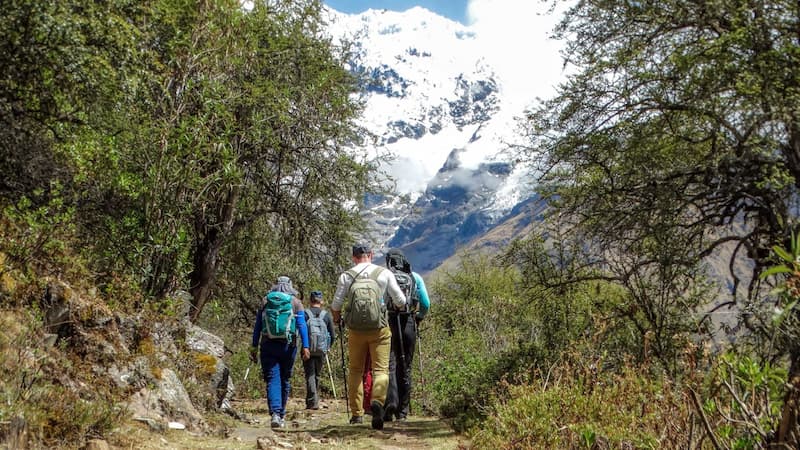
Archaeological Wonders along the Way
One of the most significant highlights of the Inca Trail is the numerous archaeological sites en route to Machu Picchu. Unlike the Lares Trek, the Inca Trail offers a unique opportunity to explore various well-preserved Inca ruins. Each site, from the imposing fortress of Huayllabamba to the mystical ruins of Wiñay Wayna, tells a story of the ancient Inca empire.
These ruins are strategically placed along the trail, providing not just historical context but also awe-inspiring vistas of the Andes. The combination of natural beauty and archaeological significance makes the Inca Trail a unique experience.
The Grand Finale: Arriving at Machu Picchu
The culmination of the Inca Trail is the arrival at Machu Picchu through the Intipunku, or Sun Gate, on the fourth day. This moment is a highlight for many trekkers, as the first glimpse of the ancient city through the misty clouds is nothing short of magical.
Visiting Machu Picchu on foot, after days of trekking through varied landscapes, offers a deeper appreciation for this World Heritage Site. The sense of connection to the ancient Incas is most profound as one walks through the Sun Gate, just as they did centuries ago.
Lares Trek vs. Inca Trail Conclusion
The historic Inca Trail stands out with its rich blend of natural beauty, archaeological wonders, and historical significance. For those weighing the Lares Trek vs. Inca Trail, the latter offers a classic experience that leads to the heart of the Inca empire. It’s a journey that challenges the body, stimulates the mind, and enriches the soul. The Inca Trail is more than a trek; it’s an unforgettable expedition through the annals of time to the lost city of Machu Picchu.

Your Next Adventure Awaits You

Explore Our Tours Now

Embark on Your Next Adventure
Unveil New Horizons with a Simple Click
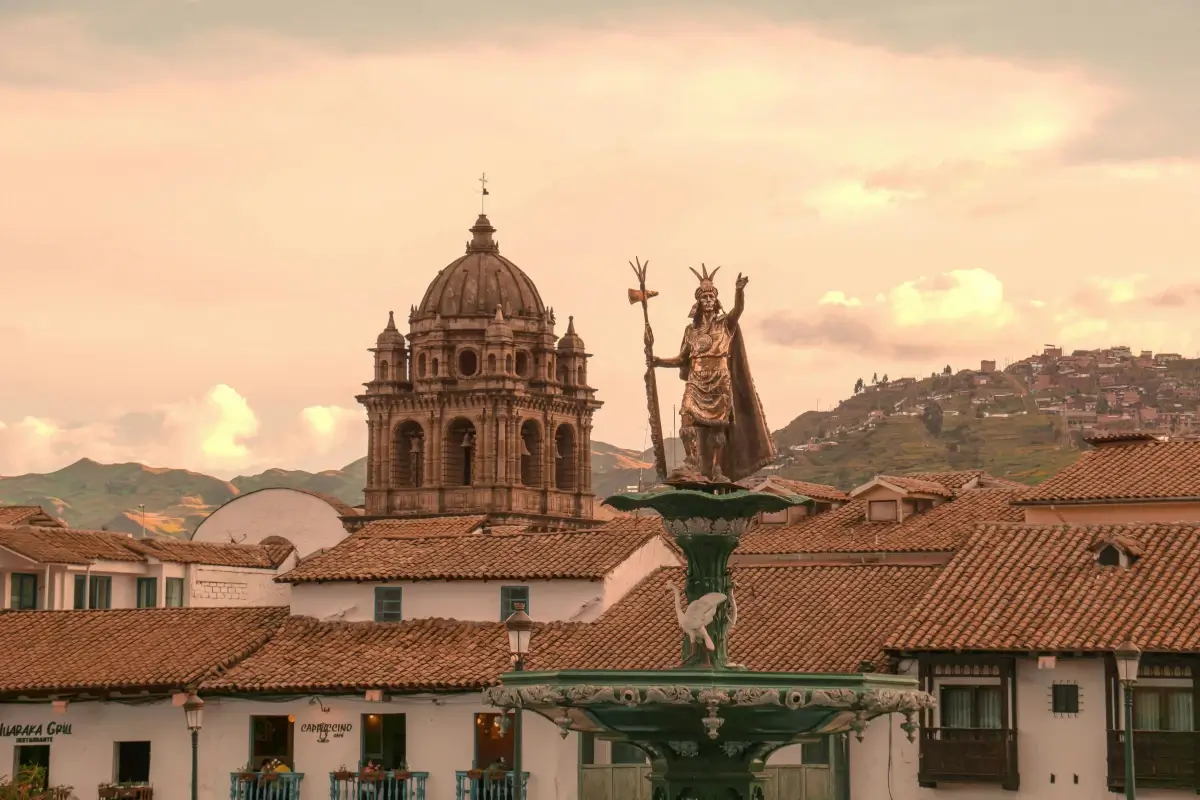
Visit the Heart of the Inca Empire

Machu Picchu
Discover the Majesty of Machu Picchu
Explore our destinations
Discover ancient ruins, wander through charming cobblestone streets, and stand in awe of majestic mountain views.
Discover Machu Picchu Explore Cusco
Why Book With Us?
- No-hassle best price guarantee
- Customer care available 24/7
- Hand-picked Tours & Activities
Get in Touch
Our team is ready to assist with your inquiries. Reach out to us now!
+51 978 707 855

Lares trek + Short Inca Trail
Inca trail + lares trek.
The Lares Trek + The 2 day Short Inca Trail to Machu Picchu gives the hikers the best of both worlds in 5 days. You pass through the most isolated indigenous communities, which are still keeping the Inca culture alive, and get the privilege to interact with them. Our unique route is incredibly picturesque, with majestic glaciers, shockingly blue glacial lakes, waterfalls, llamas, and alpacas. You will really feel that you are out in the wilds of the Andes!
On the Inca Trail, you will hike on the original Inca Trail just like in ancient times, explore the ancient Inca religious sites along the way and enter through the Sun Gate directly to the new 7 wonders Machu Picchu. You get to visit Machu Picchu twice.
- Day 1: Cusco – Calca – Huaran – Cancha Cancha
- Day 2: Cancha Cancha – Pachacuteq Pass – Quiswarani
- Day 3: Quiswarani – Cuncani – Lares – Hot Springs – Ollantaytambo
- Day 4: Ollantaytambo – KM104 – Wiñay wayna – Machu Picchu – Aguas Calientes
Day 5: Aguas Calientes – Machu Picchu – Cusco
Useful information.
- Starting Altitude: 3,000 m / 9,840 ft
- Maximmun Altitude: 4,780 m / 15,682 ft
- Walking Distance: 48 km / 29,82miles
Day 1: Cusco – Calca – Huaran – Cancha Cancha
Today your Lares Valley adventure to Machu Picchu begins early.Picking you up at 5:00am. On the way to the trailhead we have a quick stop at the traditional Calca market where your chef will buy some local organic produce. Here you also have the opportunity to buy anything you might want to gift to the highland children you will meet along your trek. Arriving at the trailhead Huaran(3,000 m/9,840 ft) in the sacred valley, your breakfast is served between the mountains, admiring the mountain peaks and awesome views of the valleys. Full of energy, it’s now time to get our packs ready, put our boots on and begin our first 3 hours gradually ascending towards Cancha Cancha. Along the way, your lunch will be served next to the river, replenishing your energy for the trek ahead with a delicious meal prepared by your trekking chef.
Cancha Cancha (3,956 m / 12,976 ft) is one of the most isolated and traditional communities, self-sustaining as it has been for hundreds of years. There is no road to the community and they were recently connected to electricity in December, 2019. After settling into your tents and having afternoon tea, you will have the opportunity to visit a local family. You will learn all about life in a traditional Andean village, with your guide as your interpreter.
- Meals: Breakfast / Lunch / Afternoon Snacks / Dinner
- Accommodations: Camping
- Maximum altitude: 3,956 m / 12,976 ft
- Minimum Altitude: 3,000 m / 9,840 ft
- Walking Distance: 10 km
- Approximate walking time: 5-6 hours
- Difficulty: Moderate
Day 2: Cancha Cancha – Pachacuteq Pass – Quiswarani
Your guide will wake you with a hot mug of coca tea to enjoy in your sleeping bag before you get up for breakfast. Feeling all revved up to begin our second day, after another delicious breakfast, we begin our 7 hour hike. It starts out as an intense walk, accomplishing high passes on our way to the highest point of our trek at Pachacuteq Pass(4,780m /15,678 ft). This is where you pat yourself on the back and embrace the satisfaction and exhilaration for making it up to the summit. Motivating you along the trail for this intense part of the trek are the views of glaciers, remote lakes, alpaca herds, rugged valleys and spectacular mountain vistas. Keep your eyes on the sky for the Caracara falcons and Andean geese!
After enjoying the snacks and the summit, we descend for 3 hours until we reach our campsite Quiswarani community, (3,700m/12,139ft). On the way, we will be taking an isolated trail where we will see indigenous highland people in their traditional outfits herding their llamas and alpacas. The local indigenous people will open their hearts and interact with you in the Quechua language (the Incas’ language). Your guide will act as your interpreter to translate and teach you some Quechua language. When you arrive at the spectacular seven waterfalls, you are almost to the campsite!
At the campsite, everything will be ready. Enjoy hot drinks and appetizers before dinner, then snuggle in for a comfortable night sleep.
- Maximum altitude: 4,780 m / 15,678 ft
- Minimum Altitude: 3,700 m / 12,139 ft
- Walking Distance: 12 km
- Approximate walking time: 7-8 hours
- Difficulty: challenging
Day 3: Quiswarani – Cuncani – Lares – Hot Springs – Ollantaytambo
Your adventure continues as you begin the most scenic day yet! We begin our ascent for 3 hours until we reach the Willqaqasa Pass, (4,200 m/13,779 ft) getting a bird’s eye view of the reflections of the mountains in mirror images in the glacial lakes. The majestic Colquecruz and Pitusiray Mountains are awe inspiring to admire from the pass. We continue our trek through the Puna grasslands, undulating and productive agricultural sites and natural pristine lakes. Time to descend for 2 hours to the Cuncani community. Connecting with the local indigenous children, you may have the opportunity to visit their school and share in some quality time with the students.
From Cuncani we meet our driver and ride down through a lush valley with extensive agricultural areas, fruit bearing trees, varied flora, and native flowers like begonias and wild orchids. Finally, we reach our destination, the Lares Hot Springs (3,100m/ 10,170ft), where we cannot wait to soak in the natural volcanic hot springs, have lunch and relax. Time for our goodbyes for our remarkable chef and horsemen.
After lunch in Lares, we take our private transport to 3 hours to Ollantaytambo, where we have dinner together and spend the night in our hotel.
- Meals: Breakfast / Lunch / Dinner
- Accommodations: Hotel
- Maximum altitude: 4,200 m / 13,779 ft
- Minimum Altitude: 2,792 m / 9,158 ft
- Walking Distance: 13 km / 8 miles
- Approximate walking time: 6 – 7 hours
Day 4: Ollantaytambo – Km104 – Wiñay wayna – Machu Picchu – Aguas Calientes
We start this exciting day early; your guide will leave the hotel with you at 5:30. When you arrive at the train station, your guide will give you your lunch to add to your daypack. Your train departs Ollantaytambo at 6:10 and you will have just over an hour on the train to enjoy the scenery and have breakfast (not included), Your hotel can provide you a box breakfast to take with you or you can pack your own breakfast.
Your guide will get off the train with you at the famous Km104, where your hike begins! (2,000m/6,560 ft. above sea level) After crossing the Urubamba river on a picturesque foot bridge, you will show your passport at the checkpoint and visit your first Inca site nearby. The first hour and a half are a gentle up, with several shelters along the way to pause for a bit out of the sun, or rain, depending on the season. Along the way, you will stop at several outlooks where you have an expansive view of the Urubamba River. You will also pass through several microclimates, including cloud forest, so be ready for damp or even rain at any season of the year. The next hour and a half are a slightly steeper uphill with a beautiful waterfall as your reward at the end of the hike!
Cross the bridge below the waterfall, take some time for photos and then you will find yourself gazing up at the spectacular Wiñay Wayna! (2,600m/8,500ft above sea level) These amazing Inca ruins have a fascinating history and some parts are still hidden by the dense jungle. This close to Machu Picchu, you are hiking through lush sub-tropical jungle. Your guide will tell you all about the remains, plus the incredible flora and fauna of this microclimate and answer any questions you have before the short 5 minute walk to your lunch spot.
You have lunch at a covered shelter at the Wiñay Wayna campground, which is the last campground for those hiking the four day Inca Trail. Nearby are outdoor sinks to wash your hands and also restrooms. Take your time enjoying your hearty lunch and admiring the tropical flowers around the campground.
After lunch, you will have a mostly flat walk to the Sun Gate, from which you have your first view of Machu Picchu! Though the hour long walk is a gentle rolling up and down, it does end with a set of steep stairs carved directly into the bedrock by the Inca. Once you reach the stairs you will know that you’re almost at the Sun Gate! It is a breathtaking view of Machu Picchu, so take some time to savor the moment and take photos. The last 45 minutes down from the Sun Gate provide many opportunities to take more photos of Machu Picchu from this unique vantage point.
Once you reach Machu Picchu, you will have time to take more photos from the viewing platforms above the site. You will arrive in the afternoon, as the archeological area starts to empty of tourists, which gives you the opportunity to take beautiful photos in the afternoon light with fewer people in your shots. Take your time to enjoy this magical experience before you take the bus down to Aguas Calientes to check into your hotel. You will have a delicious dinner in town, then have time to walk around this picturesque little town or just go to your hotel to rest after such an exciting day.
- Meals: Boxe Lunch – Dinner
- Maximum Altitude: 2,720 m / 8,920 ft
- Minimum Altitude: 2,040 m / 6,691 ft
- Approximate walking time: 6-7 hours
- Difficulty: moderate
This is the day you’ve been waiting for! After an early breakfast at your hotel, you will take one of the first busses up to Machu Picchu so that you can be there to witness the sunrise. It is a truly extraordinary site and not something you will want to miss! Your guide will give you the full tour, which takes about two hours. You will see all of the most important parts of Machu Picchu.
After your tour, those who have booked in advance for the extra hikes up Huayna Picchu or Machu Picchu Mountain will have time to enjoy those views on their own. When you have had your fill of the exceptional views of Machu Picchu, you will take the bus back down to Aguas Calientes for lunch (not included).
The train will take you back to Ollantaytambo, following the spectacular Urubamba River. Close to Aguas Calientes, the canyon is narrow and the river has many beautiful sections of whitewater. You can also see Wiñay Wayna from the train, if you look up high on the steep canyon wall! Back at Ollantaytambo, your driver will meet you at the exit from the train station to take you back to your hotel in Cusco
- Meals: Breakfast
- Minimum altitude: 2,040 m/ 6,691 ft
- Maximum altitude: 2,440 m/ 8,052 ft
- Professional English Speaking Tour Guide
- Assistant Tour Guide for groups of 9+
- Briefing with your trekking guide 1 or 2 days before your trek
- Transfer upon arrival from airport or bus station in Cusco to your Hotel
- Professional Chef
- Breakfast on Day 1.
- Mules to carry cooking and camping equipment plus 7kg of your personal items.
- Pick-up from the Hotel
- Transportation by bus to Huaran and from Lares to Ollantaytambo
- Train from Ollantaytambo to Km 104
- Return transportation by train and bus to Cusco
- Water (excluding the first 4 hours of the hike when you need to bring your own)
- Hot water for washing
- Daily morning boiled and cold water to refill the water bottles.
- 5 Breakfasts, 4 Lunches, 3 Afternoon Snacks and 4 Dinners. If you have a dietary such as vegetarian food please let us know,and request with no cost at all.
- Dining tent with tables and chairs for the Lares trek 4 days to Machu Picchu
- Kitchen tent
- Toilet tent
- Duffle bag for your personal gear
- a 4-men tent for every 2 trekkers
- Hotel on Day 3 & 4
- Sleeping mattress
- Oxygen bottle
- First aid kit
- Entrance to Lares hot springs
- Entrance to the Inca Trail
- Entrance to Machu Picchu
- Bus Tickets from Aguas Calientes to Machu Picchu -round trip
Does Not Include:
- Sleeping Bag (Can be hired from us)
- Lunch on Day 5
- Dinner on Day 5
- Entrance to Huayna Picchu Mountain-US$ 70
- Tips for the crew (guide, chef, wranglers)
- Travel Insurance – you are strongly recommended to take out travel insurance for the duration of your Lares trek to Machu Picchu in 4 days.
What you need to take for this Trip.
- Original Passport
- Valid STUDENT CARD (if you are a student and want to qualify for the discount)
- Walking boots
- Waterproof jacket / rain poncho
- Warm jacket
- Hat and gloves
- Comfortable Trousers
- Insect repellant
- Toiletries and hand sanitiser
- towel / sandals
- Personal medication
- Camera and film
- Spare batteries
- 2 people US$950 per person
- 3 people US$930 per person
- 4 people US$910 per person
- 5+people US$890 per person
- Student Discount: US$20 (Requires Valid STUDENT CARD to qualify)
- Under 15 years Discount: US$30 Please send us a copy of your passport at the time of booking.
Optional Rentals:
- Sleeping Bag $20 USD
- Walking Poles –$15 USD per pair per trek (These are professional poles that can be extended)
- Personal tent- $20 USD – (Please request when you book your trek)
- Additional night in Aguas Calientes – from $60 USD (depending on availability)
- Vistadome Train Upgrade $67 USD per person (Return only)
- Huayna Picchu Mountain $70 USD per person (Please request when you book your Trek)
- Machu Picchu Mountain $70 USD per person (Please request when you book your Trek)
WHAT IS THE WEATHER LIKE IN THE CUSCO AREA AND WHAT ARE THE BEST MONTHS TO VISIT?
Peru’s climate varies depending on where you visit, but here are the basics for the Cusco/Inca Trail and Lares Trek area.
The best months to experience the Inca Trail are from May to September when the conditions are fairly dry and the weather is generally sunny.
June, July and August can be very cold at night so bring a good quality four-season sleeping bag (or rent one from us).
In the Andes there are two main seasons – wet and dry. The wet season runs from November to April and is usually warmer overall. The dry season runs from May to October and has hot clear days but cold nights.
The weather in Peru is difficult to predict. You can have beautifully clear hot days in the middle of the wet season and hail storms in the dry season – it’s one of the beauties of Peru!
WHAT ABOUT ALTITUDE SICKNESS?
We strongly suggest staying at high altitude (above 3,000 metres – in Cusco or another high altitude city) for 2 to 3 days (minimum) before undertaking the trip. This is in order to minimize the effects of possible altitude sickness. Also, you can help your body acclimatize by drinking plenty of liquids, adding a bit more sugar to your drinks, eating food rich in carbohydrates, avoiding cigarettes and alcohol and drinking coca (ancient traditional leaf) tea. Diamox can also be helpful – please ask your doctor about this.
The recommended natural remedies for altitude sickness is water, coca tea and muña (andean mint)
IS THE TREK DIFFICULT, DO I NEED TO BE FIT?
The Lares trek & Short Inca Trail to Machu Picchu is a 39 km/ 24.23 miles hike through the Andes in the Cusco region. The maximum altitude reached is (4,780 m/15,682 ft). The Trail is a fairly difficult trek and you should be well prepared and healthy prior to starting it. You have to be moderately fit and take regular exercise. It is also important to be well acclimatized to the altitude. Try to spend at least 2 or 3 days in Cusco (3,350 m/11,047 ft) prior to starting the trek.
ARE WE GOING TO BE DROPPED OFF AT OUR HOTEL AFTER THE LARES TREK & SHORT INCA TRAIL TO MACHU PICCHU?
Absolutely, Included in the package and on the last day we will drop you at your hotel! If you have booked your hotel in the Sacred Valley like Ollantaytambo or Urubamba, we will drop you there too! If you spend the night at Ollantaytambo before the trek, for sure we wil pick you up there.
ARE THERE TOILETS ON THE LARES TREK & SHORT INCA TRAIL TO MACHU PICCHU?
This has been highly appreciated by most of our clients, especially by our trekkers, who want a private, clean and sanitary toilet! Mountain Gods Peru toilet facilities have an individual tent and a camping toilet with a seat.Our toilet is always set up a comfortable distance from our campsite. At night if you need to use the toilet it is readily accessible and clean, unlike the dirty facilities supplied by the government.
HIKING TO LARES TREK MACHU PICCHU
The evening before you start your trek, you will be given a Duffel Bag to pack your clothes for the next four days. Your weight allowance is up to 7 kg /14 pounds.Your team of pack horses will carry your duffel bag for you, together with the food and camping gear. It’s important to be aware that you will not have access to your items in the duffel bag until the end of each day, as the horses will always be ahead of the group. During the Lares trek & Short Inca Trail to Machu Picchu, you need a day backpack big enough to carry your personal belongings such as a warm jacket, a rain jacket, your camera, sunscreen, snacks, water, etc. A 30 to 40L backpack is recommended.
DO I NEED MY ORIGINAL PASSPORT?
Yes! You have to bring your original passport and it is very important that it is the same passport number you sent to us to book your Lares Trek + Short Inca Trail, permit, entrances and reservations.In case you are renewing your passport or changing your name, go ahead and send us your old passport information to secure your permit, and we can change it when you get your new passport number or updated your name for a fee of $25 USD per person. We must have a copy of your old and new passport to make the change. Before you change your passport keep a copy of your old one.
If you do not wish to pay this fee you will need to bring both passports to Peru with you. You can enter Peru with your new passport but you will need to show both passports, old and new to be to enter the Inca Trail, Machu Picchu or the train. If you do not have both you will not be allowed to enter the Lares trek & Short Inca Trail to Machu Picchu or get on the train.
WHAT IS THE FOOD LIKE ON THE TREKS?
Our experienced chefs make amazing cuisine in the middle of the mountains using minimal equipment! They are used to preparing dishes for people with different food restrictions or lifestyles, so please let us know your preferences and if you have any dietary needs. We provide complete meals and snacks during the treks.
ADDED VALUES FOR FREE
- Inflatable Mattress (Included)
- Pillow (Included)
- Blanket (Included)
Extra 7 kg of personal ítems (Included).All of our treks include porters, who are responsible for carrying and setting up all equipment. They will also carry your personal duffel, which you will receive at your briefing the night before your Comfort Inca Trail. This duffel can not exceed 7 kg/15.43 pounds, and must include your sleeping bag and an air mattress.
PERSONAL INFORMATION
Name (required)
Email (required)
Phone or Skype
Country (required)
Passport Number
Birth Date (required)
Name of Tour (required)
Type of Service (required) Group (3+) Private (1-2)
Number of Travellers (required)
Desired Depature Date (required)
Please give at least two alternative start dates in order of preference. Write none if there are no other dates available for you
Do you want to hike Huayna Picchu? Yes No
Is anyone in your group 17 or under? Yes No
How did you find us? (Optional)
Additional Details
Related tours
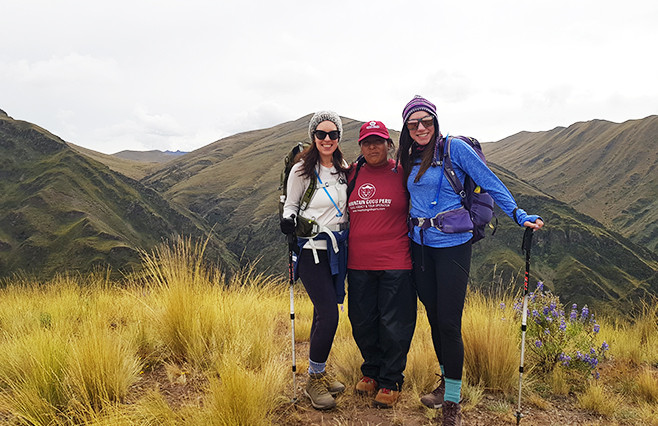
Ancascocha Trek
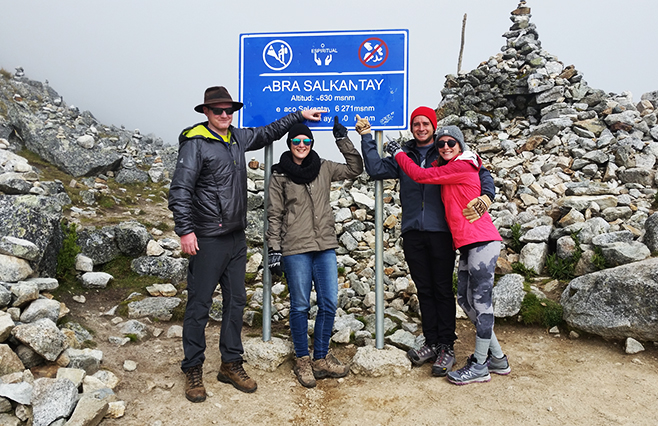
Salkantay Machu Picchu + Zipline
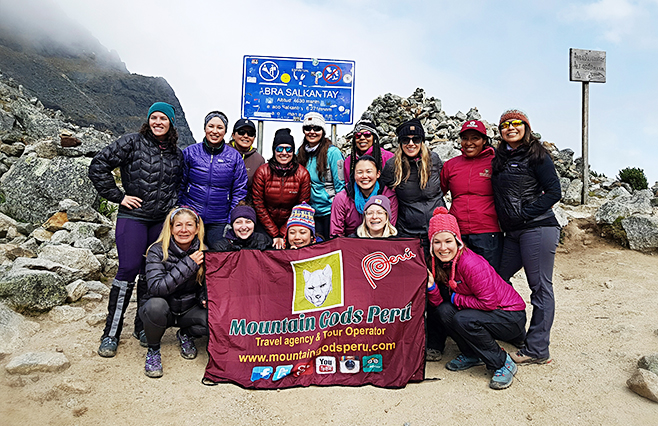
Express Salkantay Trail
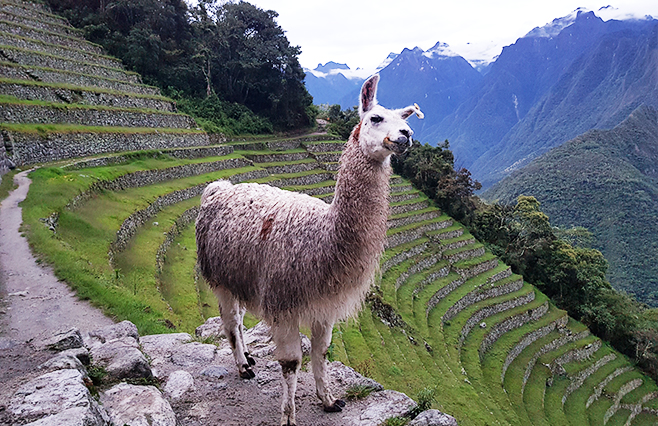
Southern Peru & Short Inca Trail
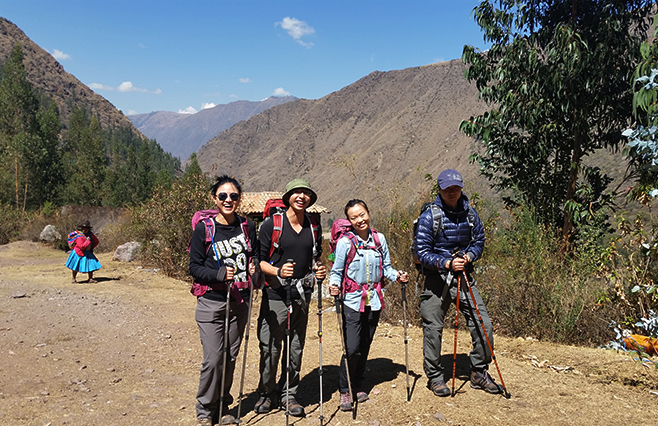
Lares trek via fundo Huaran
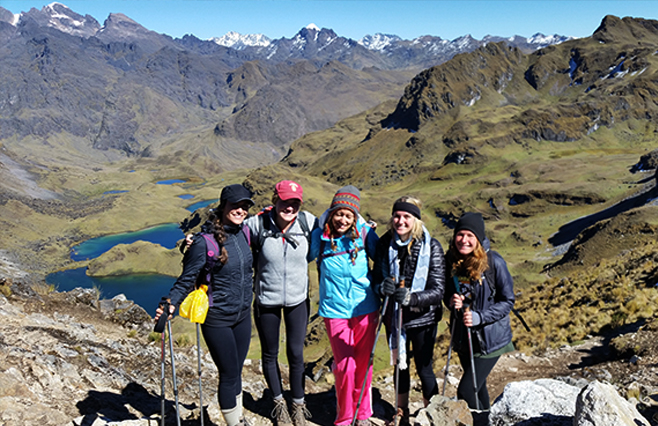
Lares & Machu Picchu – Pumahuanca
What our clients say in tripadvisor.

Social Projects
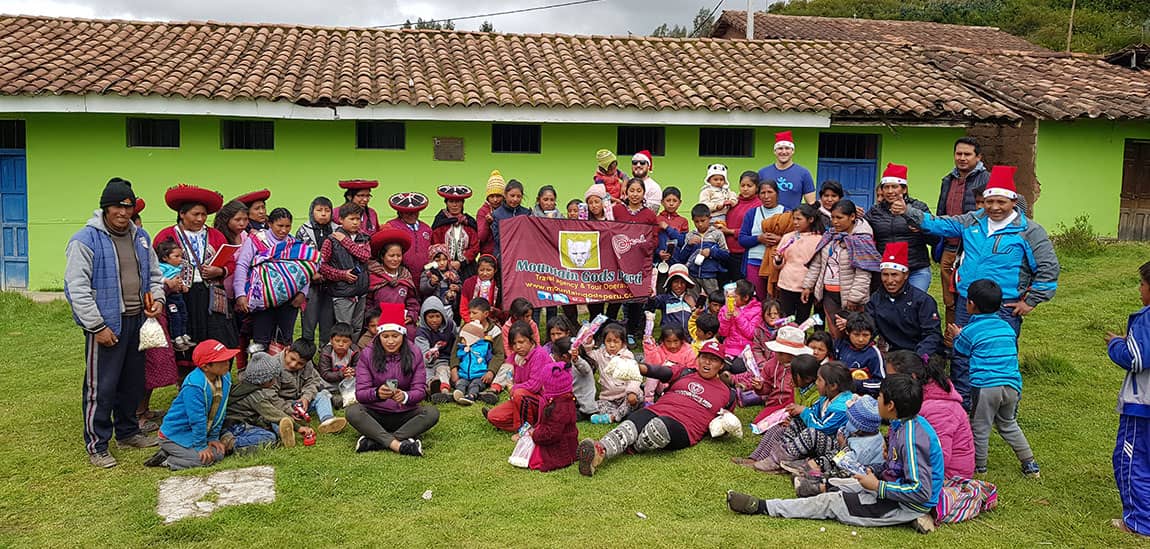
Porters on the Inca Trail Cusco
“Our porters represent the Peruvian people, the men who are in our company. It is not possible to create the experience we offer without the
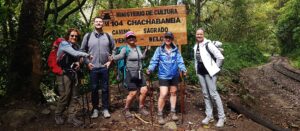
The Inca Trail Permits
Inca Trail Availability The Inca Trail is one of Peru’s most famous treks, and every year thousands of foreign visitors are lured to the Andes
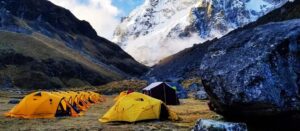
The Salkantay mountain, Treks & Tours
This amazing trail runs beneath the magnificent Salkantay mountain (6.271 m/20,569ft), one of the highest and most stunning in the Andes. The Salkantay Trek was
Calle: Huacracalle 108-A – Santiago
+51 901 024 826
+51 974 755 534
Mon to Sat: 9:00 to 13:00 – 15:00 to 20:00
Usefull Information
Payment methods.

Enquire now!
What to know when planning an awe-inspiring hike on the Inca Trail
Peru's most famous trail leads to Machu Picchu
- Newsletter sign up Newsletter

While on the Inca Trail, every step — past ancient ruins, up stone staircases and over Dead Woman's Pass — brings hikers closer to their final goal: reaching Machu Picchu. Trains and buses drop thousands of visitors off here every day, but hiking in offers an unmatched experience. Hikers get to sit in sacred spaces, sleep under the stars and bond with their fellow adventurers. The promise of being able to reach the Sun Gate and take in that first view of Machu Picchu keeps them motivated.
Planning a hike on the Inca Trail takes time. There are also important factors to keep in mind, like when the dry season is and what time of year the trail is closed for maintenance. Here are some tips to ensure an epic experience.
What is the Inca Trail?
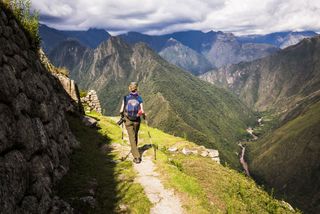
Hikers get to see stunning views from the Inca Trail
The Classic Inca Trail is a 25-mile-long hiking trail in the Andes Mountains that takes four days to complete and ends at Machu Picchu. After starting at KM 82 in the Sacred Valley, hikers will follow the stone paths that wind by sites like the Valley of Llulluchapampa, Sayacmarca ruins and Wiñay Wayna complex. On the final day of the trek, you most likely will rise well before dawn in order to arrive at the Sun Gate and Machu Picchu around sunrise.
Subscribe to The Week
Escape your echo chamber. Get the facts behind the news, plus analysis from multiple perspectives.

Sign up for The Week's Free Newsletters
From our morning news briefing to a weekly Good News Newsletter, get the best of The Week delivered directly to your inbox.
How soon should you start planning a hike?
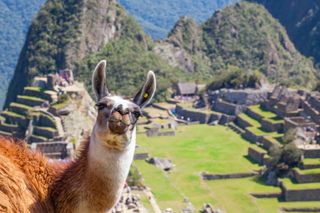
Running across alpacas is another highlight of the Inca Trail
If possible, think about booking six to nine months in advance. The peak season to visit is June through August, and with the Inca Trail being a popular hike, permits are snapped up quickly.
What is the best time of year to hit the trail?
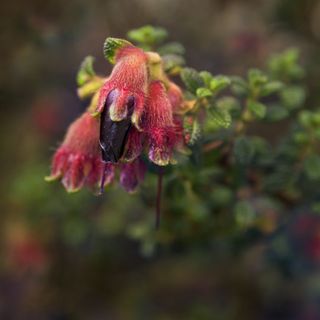
One of the many types of flowers that grow along the trail
The trail is open year-round except in February, when it is closed for maintenance. Dry season is May through September, "where temperatures are milder and you can expect bright, sunny days, making for great visibility along the hike," Krissy Concannon, an independent affiliate of Travellustre in Boston, told The Week. The Inca Trail is one direction only, and when the adventure is over you will leave by train or bus.
Do I need to train for the Inca Trail?
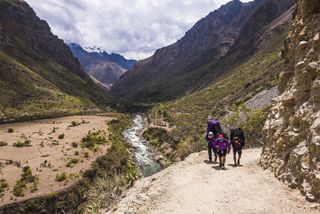
Preparation for the hike should start before you leave home
This is a strenuous hike at a high altitude, traversing different landscapes like cloud forests and grasslands. Travelers should expect to travel six to nine miles a day and can train ahead of time by hiking with a pack or getting regular exercise at home. Julie Sudderth of Vivid Getaways in Dallas told The Week she has seen "hikers from 7 to 70 years old command this trail with no problems." The Inca Trail reaches an elevation of 13,800 feet above sea level, making acclimation critical, especially for those who have experienced altitude sickness previously. Concannon recommends spending at least two or three days in Cusco prior to the hike to acclimate better to the altitude.
What kind of experiences can you have on the trail?
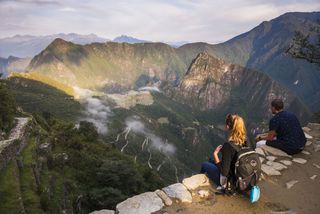
Sunrise on the trail is a beautiful experience
Every trip has one element in common: You must go with an operator and cannot hike on your own. "Normally, the best companies go with the best guides," Sudderth said. "This is invaluable." Good guides "will know when to slow down or quicken the pace as they are actively reading the client’s demeanor," she added, and also "weave the rich history, wildlife and flora and fauna into the hike" while keeping everyone "engaged and motivated. With children especially, this is priceless."
Those who want to go all out can book a private or small group hike, with an expert guide and porters, a well-stocked and clean bathroom tent, gourmet meals and high-quality camping gear, from the pillows to the tents. Midrange experiences are catered toward hikers who do not want a bare-bones trip but also aim to keep costs down, and include nice gear and good food with moderate accommodations.
Concannon warns that when opting for low-cost hiking tours, travelers "need to be cautious to ensure operators are not cutting corners that could negatively impact their experience. Hikers can expect minimal or lesser quality gear and food options to be more minimal. Campsite options could also be less than ideal, with locations lacking in view."
Sign up for Today's Best Articles in your inbox
A free daily email with the biggest news stories of the day – and the best features from TheWeek.com
Catherine Garcia is night editor for TheWeek.com . Her writing and reporting has appeared in Entertainment Weekly and EW.com , The New York Times , The Book of Jezebel , and other publications. A Southern California native, Catherine is a graduate of the University of Redlands and the Columbia University Graduate School of Journalism.
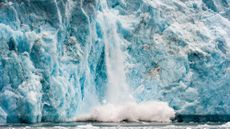
The Explainer Glacier dust to the rescue
By Devika Rao, The Week US Published 19 April 24

The Week's daily crossword puzzle
By The Week Staff Published 19 April 24

In The Spotlight Where American states stand on abortion care
By Theara Coleman, The Week US Published 19 April 24
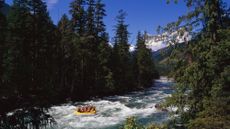
The Week Recommends Have a rip-roaring time on the water
By Catherine Garcia, The Week US Published 18 April 24

The Week Recommends This 'genre-bending' new Amazon series is set in a post-apocalyptic wilderness where survivors shelter below ground
By Adrienne Wyper, The Week UK Published 17 April 24

The Week Recommends Why more of us are choosing to go on holiday on our own
By Adrienne Wyper, The Week UK Published 16 April 24

The Week Recommends April is National Poetry Month
By Scott Hocker, The Week US Published 16 April 24

The Week Recommends The trend for combining classics from two food cultures can result in dishes that are doubly delicious
By The Week UK Published 15 April 24

The Week Recommends The southwestern region pretty much has it all, from beachfront, to port metropolis, to verdant mountainside
By Scott Hocker, The Week US Published 15 April 24

The Week Recommends Mauritius, the star of the Indian Ocean, is the ultimate in relaxing destinations
By James Rampton Published 11 April 24

The Week Recommends From 'subversive' textiles to exquisite Flemish drawings, there's something for every art lover
By Adrienne Wyper, The Week UK Published 11 April 24
- Contact Future's experts
- Terms and Conditions
- Privacy Policy
- Cookie Policy
- Advertise With Us
The Week is part of Future plc, an international media group and leading digital publisher. Visit our corporate site . © Future US, Inc. Full 7th Floor, 130 West 42nd Street, New York, NY 10036.
Lares Trek + Short Inca Trail To Machu Picchu
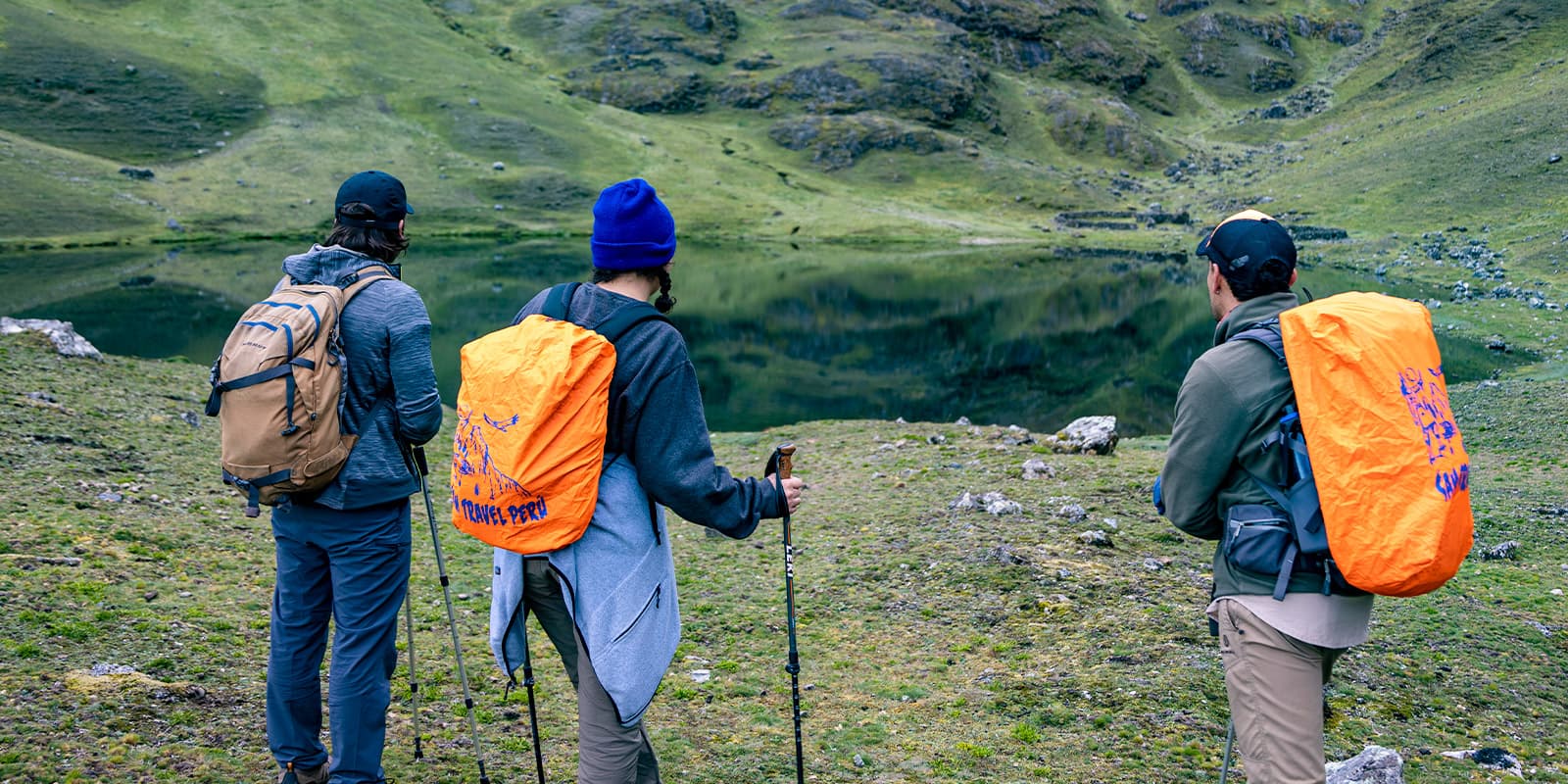
All-Inclusive Door to Door service
- Trips Managed & Run by Expert Local Tour Operator
- Easy, Fast & Risk-Free Services - Bookings Guaranteed.
- Personalized Services with Small Groups
- Tours are a Great a Value for the Money.
- Unique & Customized Tour Itineraries.
- Best Certified Guides & Teams in the Region.
OUR LARES TREK IS THE MOST UNIQUE PATH AVAILABLE WITH THE SHORT INCA TRAIL TO MACHU PICCHU
The Lares trek & Short Inca Trail to Machu Picchu gives you the best of all worlds in four days. Our own unique route is incredibly picturesque, with majestic glaciers, shockingly blue lakes, waterfalls, llamas, and alpacas. On the Inca Trail, hike on the original Inca trail just like in ancient times. You explore the ancient Inca religious cities along the way and enter through the Sun Gate directly to Machu Picchu Citadel . Have a guided tour of the Inca city and spend time alone exploring. Visit Machu Picchu twice! before returning to Cusco. How could you want more?
- Important Info
- Packing List
Day 1: Cusco – Huaran – Cancha Cancha
Your Andean Mountain adventure through the Lares Valley to Machu Picchu begins early with a pickup at 6:00am from the Cusco hotel. Then drive for 2 hours toward Huaran, meet your horsemen and horses. Time to get ready, boots on, begin our first 3 hours gradually ascending towards Cancha Cancha. Along the way, your lunch will be served next to the river, replenishing your energy for the trek ahead with a delicious meal prepared by your trekking chef.
Cancha Cancha(3,900m/12,800ft) is one of the most isolated and traditional communities, self-sustaining as it has been for hundreds of years. There is no road to the community and they were recently connected to electricity in December, 2019. After settling into your tents and having afternoon tea, you will have the opportunity to visit a local family. You will learn all about life in a traditional Andean village, with your guide as your interpreter. After dinner, your guide will show you the Inca constellations on which they depended for their agricultural guidance and still do to this day.
- Meals included : Breakfast – Lunch – Afternoon Tea Time – Dinner
- Accommodation : Camping facilities with bathroom building
- Distance : 9kms / 5.6 miles
- Time : 3.5hrs approximately
- Difficulty : Moderate
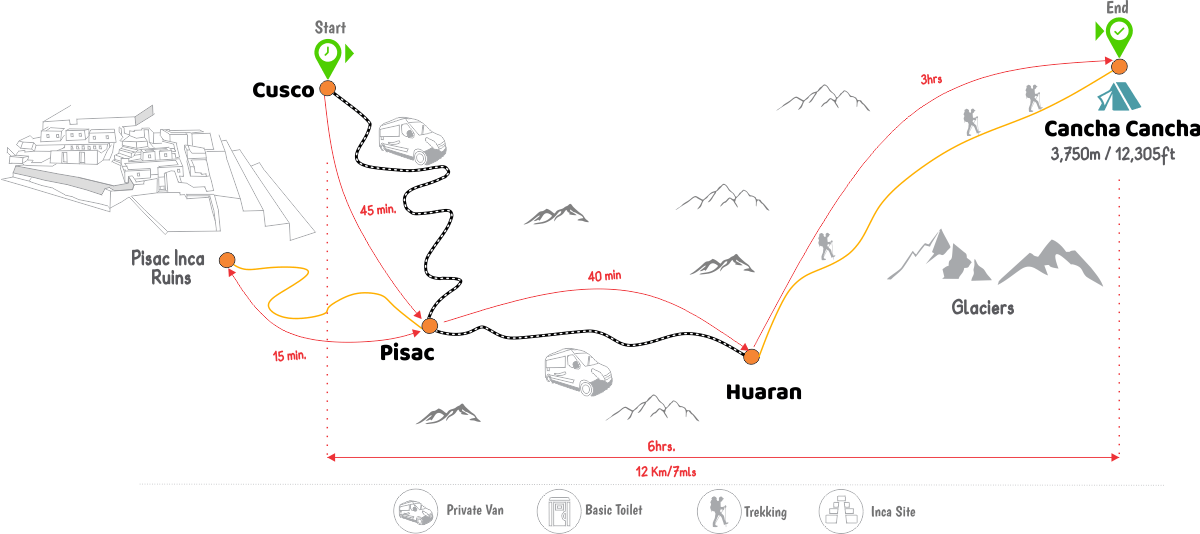
Day 2: Cancha Cancha – Quiswarani – Ollantaytambo
Feeling all revved up to begin our second day, after another delicious breakfast, we begin our 7 hour hike northeast. It starts out as an intense walk, accomplishing high passes on our way to the highest point of our trek at Pachacutec Pass(4,500m /14,800 ft). Motivating you along the trail for this intense part of the trek are the views of glaciers, remote lakes, alpaca herds, rugged valleys and spectacular mountain vistas. Keep your eyes on the sky for the Caracara falcons and Andean geese.
After enjoying the summit, descend for 3 hours until we reach our campsite located by the Quiswarani community at (3,700m/12,139ft). On the way, we will be taking an isolated trail where we will see indigenous highland people in their traditional outfits herding their llamas and alpacas. The local indigenous people will interact with you in Quechua (the Incas’ language). Your guide will act as your interpreter to translate and teach you some Quechua. When you arrive at the spectacular seven waterfalls, you are almost to the end of the trail!
Finally we arrive to Quishuarani and take our transportation for 2 hours to Ollantaytambo where we will have dinner together and stay the night. If you are staying at the Veronica View, you will have time to enjoy the heated swimming pool or sauna before dinner.
- 2* Accommodation : Veronica View Hotel
- Distance : 12kms / 7.5 miles
- Time : 7hrs approximately
- Difficulty : Challenging
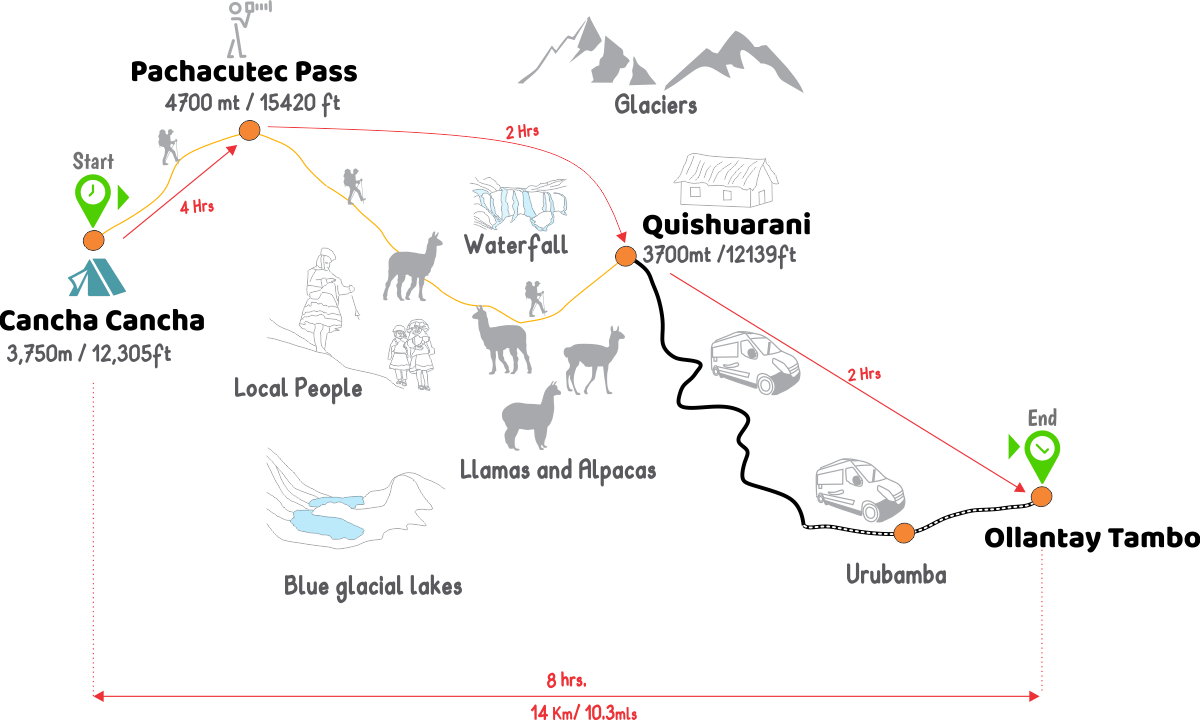
DAY 3: Ollantaytambo – KM 104 – WIÑAYHUAYNA – SUN GATE – MACHU PICCHU
We start this exciting day early; the guide will pick you up at 5:30. When you arrive at the train station, your guide will give you your lunch to add to your daypack. The train departs Ollantaytambo at 6:10am and you will have just over an hour on the train to enjoy the scenery and have breakfast (not included), or your hotel will provide you a picnic breakfast to take with you or you can pack your own breakfast.
You get off the train at the famous Km104, where your trek begins! (2,000m/6,560 ft. above sea level). After crossing the Urubamba River on a picturesque foot bridge, show your passport at the checkpoint and visit the first Inca site nearby. The first hour and a half are a gentle upward climb. Along the way, you will stop at several outlooks where you have an expansive view of the Urubamba River. You also pass through a cloud forest, so be ready for damp or even rain at any season of the year. The next hour and a half are a slightly steeper uphill with a beautiful waterfall as your reward at the end of the hike!
When you cross the bridge below the waterfall, be sure to take some time for photos and as you do find yourself gazing up at the spectacular Wiñay Wayna! (2,600m/8,500ft above sea level) These amazing Inca ruins have a fascinating history and some parts are still hidden by the dense jungle. This close to Machu Picchu, you are hiking through lush sub-tropical jungle. The guide will tell you all about the ruins, plus the incredible flora and fauna and answer any questions you have before a short 5-minute walk to your lunch spot.
After lunch, you have a mostly flat walk to the Sun Gate, here you have your first view of Machu Picchu! Though the hour-long walk is a gentle rolling up and down, it does end with a set of steep stairs carved directly into the bedrock by the Inca. As you turn the corner from the Sun Gate, you will enjoy your first breathtaking view of Machu Picchu. So, take some time to savor the moment and take photos. The last 60 minutes down from the Sun Gate provide many opportunities to take more photos of Machu Picchu from this unique vantage point. There are also a couple more important Inca sites between the Sun Gate and Machu Picchu, so make sure to go slowly, ask your guide questions about these historical places on the last bit of your hike to Machu Picchu.
Once you reach Machu Picchu, you will have time to take more photos from the viewing platforms above the site, “House of the Guardians” where you can take the famous postcard pictures of Machu Picchu. You will arrive in the afternoon, as the archeological area starts to empty of tourists, which gives you the opportunity to take beautiful photos in the afternoon light with fewer people in your shots. Take your time to enjoy this magical experience before you take the bus down to Aguas Calientes to check into your hotel. Have a delicious dinner, then have time to walk around this picturesque little town, visit the hot springs or just go to your hotel to rest after such an exciting day.
- Meals included: Breakfast, picnic lunch, dinner in a restaurant in Aguas Calientes
- 3* Accommodation: Hotel Ferre´ Machu Picchu
- Difficulty: moderate
You can leave your duffel from the trek at the Ollantaytambo train station to be sent by train directly to Aguas Calientes.
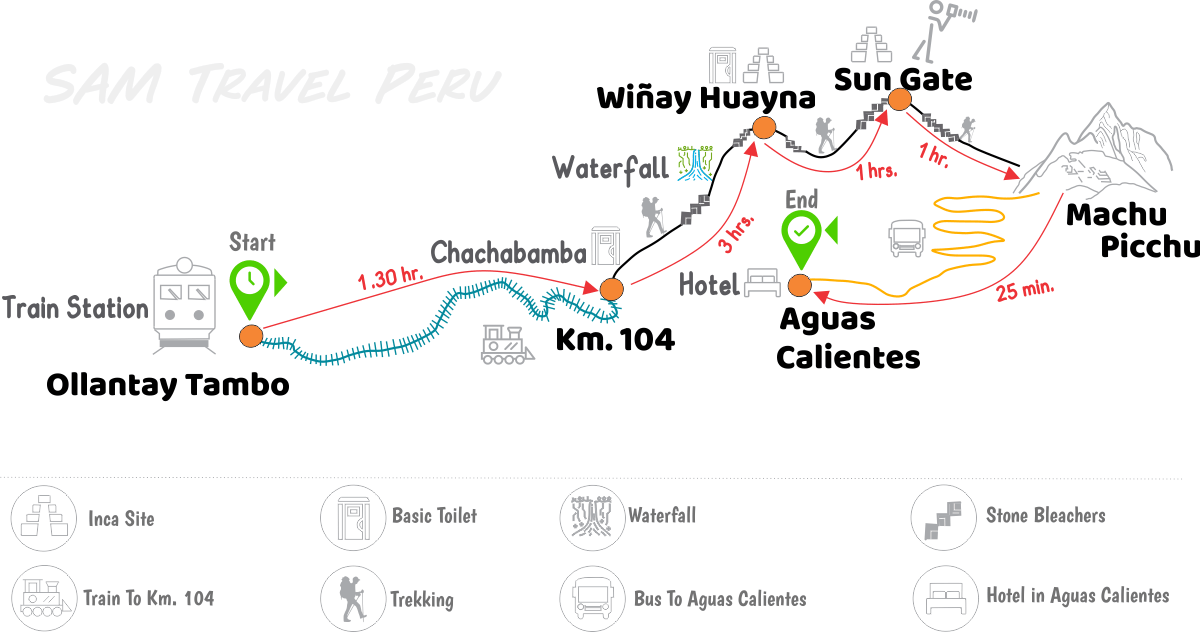
DAY 4: AGUAS CALIENTES – MACHU PICCHU – CUSCO
This is the day you’ve been waiting for! After an early breakfast at the hotel, take one of the first buses up to Machu Picchu to witness the sunrise. It is a truly extraordinary site and not something you’ll want to miss! The guide will give you a guided tour of Machu Picchu, which takes about two hours. You will see the most important parts of Machu Picchu Citadel.
When you have had your fill of the exceptional views of Machu Picchu, you will take the bus back down to Aguas Calientes for lunch (not included). Depending on your train departure time, you may also have time for some shopping, sightseeing or a visit to the museum or hot springs.
The Expedition train will take you back to Ollantaytambo at 2:55pm or 3:20pm, following the spectacular Urubamba River. Close to Aguas Calientes, the canyon is narrow and the river has many beautiful sections of whitewater. See Wiñay Wayna from the train, if you look up high on the steep canyon wall! Back at Ollantaytambo, the driver will meet you at the exit from the train station to take you back to your hotel in Cusco in our private vehicle. You can expect to arrive at your hotel by 7:00pm.
Meal included: Breakfast
- Difficulty: Easy
***IMPORTANT:
- You can upgrade to the Vistadome Train for the same times, 2:55pm or 3:20pm, 4:22pm, or 4:43pm. The cost is $67 USD.
- Early trains can be organized by requested and it has to be done by booking time.
- The Huayna Picchu Mountain Hike depends on availability and let us know about it at booking time.

WHAT IS INCLUDED
- Transfer from the airport to your hotel
- Private transportation from the hotel to Huaran – Trail head
- Licensed guide fluent in English, Spanish and Quechua.
- Round trip Expedition train ticket from Ollantaytambo to KM 104 and Aguas Calientes to Ollantaytambo
- 3 Bus tickets from Aguas Calientes to Machu Picchu and return to Aguas Calientes
- Admission ticket to the Machu Picchu Archeological Complex
- Entrance tickets to the Inca Trail National Park
- 2 nights hotel with private bathroom, hot shower, wifi, storage and buffet breakfast included (This applies ONLY if you are choosen the price which includes hotels)
- 4 person Igloo tents for 2 trekkers (large and comfortable)
- Pillow and foam mattress
- Delicious meals during the 4 days, as indicated in the itinerary
- Cook and cooking equipment
- Horseman and mules, to carry all camping and personal equipment (7 kilograms of your personal items such as extra clothes, sleeping bag, these will be carried by our mules) (on Lares Trek portion only)
- Provision of a horse in case of emergency (With helmet) in case of illness, to ensure the trek can be completed by all participants (on Lares Trek portion only)
- First-aid kit including emergency oxygen tank
- Boiled water to fill your drinking bottles
- Guided tour in Machu Picchu
- Chef, cooking equipment and kitchen tent
- Transfer back to Cusco for our group
- Local interaction with the local kids and the community
WHAT IS NOT INCLUDED
- Sleeping Bag: $20 USD per person per trek (It will be clean and warm)
- Air Mattress: $20 USD per person per trek (Therm-a-rest mattresses)
- Walking Poles: $15 USD per pair per trek (Professional Poles that can be extended)
- Personal tent: $30 USD – (Please request when you book your trek)
- Vistadome Train Upgrade: $67 USD per person (Return only)
- Huayna Picchu Mountain : $75 USD per person (Please request when you book your trek)
- Lunch on the last day in Aguas Calientes
- OPTIONAL UPGRADES: Hotel
- Tips for the crew, guide, cook and porters of SAM TRAVEL PERU
**Huayna Picchu Mountain is optional trek within Machu Picchu Citadel which do not include a guide. The climb is usually done on your own after your tour of Machu Picchu Citadel. If you would like the extra hike to be guided, please request in advance. There is an extra cost for this extra guided tour.
*** The Short Inca trail to Machu Picchu which is included in this trek is almost always available year round except it is closed in February for maintenance.
- $717 USD per person without hotels
- $797 USD per person 1 nights 2* and 1 night 3* hotels
Personal porter included!
- *** This price includes the pack horse who will carry your belongings up to 7 kilograms. We will provide you a duffel bag, to put your belongings in.
- ***We provide large Eureka 4 person tents for each 2 trekkers.
- ***Private service is $100 USD extra per person
- 18 to 25 years old: $30 USD. Information required on student card: name of university, student name, photo of student, expiration date etc. A copy of the card is required at booking for government approval for discount.
- Under 18 years old : $30 USD. Please send us a copy of your passport at the time of booking.
- Under 11 years old : $40 USD. Please send us a copy of your passport at the time of booking.
EXTRAS
- Sleeping Bag : $20 USD per person per trek (It will be clean and warm)
- Air Mattress: $20 USD per person per trek (Therm-a-rest mattresses)
- Walking Poles: $15 USD per pair per trek (Professional poles that can be extended)
- Personal Tent: $30 USD – (Tent is for single trekkers only)
- Additional Night in Aguas Calientes – From: $60 USD (depending on availability)
- Vistadome Train Upgrade: $67 USD per person (Return only)
- Huayna Picchu Mountain : $75 USD per person (Please request when you book your trek)
- Single Supplement: $40 USD 3* for single travelers Ferre´ Hotel
**Huayna Picchu Mountain is optional treks within Machu Picchu Citadel which do not include a guide. The climb is usually done on your own after your tour of Machu Picchu Citadel. If you would like the extra hike to be guided, please request in advance. There is an extra cost for this extra guided tour.
ADDED VALUES FOR FREE
Comfortable foam mattresses for every hiker, camping pillow, transfer from airport to hotel (only in Cusco), duffle bags, plastic liner bags, and extra blanket for the tent are included in the trekking price!
- EXTRA PACK HORSE is included in the price, the pack horse will carry your things up to 7 kgs / 14p sleeping bag, mattress, clothes etc. (Lares Trek portion only)
- COLD BOILED WATER will be provided along the trek, there will be hot and cold water at each meal time.
- OXYGEN TANK will be available.
- EMERGENCY HORSE is included which can be ridden if you feel tired or sick. (Lares Trek portion only)
- BEST ITINERARY operated by Lares Trek specialist only.
WHY CHOOSE SAM TRAVEL?
SAM Travel Peru is a family owned travel agency and a local tour operator based in Cusco with personal experience over many years of trekking. SAM Travel Peru is a 100% Cusqueñian Company without any shareholders.
Our dream as a locally based company is to create small personalized tours & treks strictly and only operated by local professional staff catering in PERSONALIZED and HIGH QUALITY SERVICE.
We take pride in our reputation as a RESPONSIBLE & SUSTAINABLE tour operator. Our staff are our extended family! We ensure they are supported financially by offering them a fair salary. We are so proud of our team! Without them, we wouldn’t be able to offer the best service and lifetime experiences to our clients .
SAM Travel Peru knows how important it is to trust in a reliable honest operator to create your adventure of a lifetime while in Peru. Check out our reviews and certificates of excellence on, TRIPADVISOR for yourself! Also we are highly recommended on Conde Nast Travelers , Lonely Planet and by many blogs like: Trek de Lares 4 hours , “ It’s the journey, not the destination…” , Lares Pass – Day 3 , Trekking in the Sacred Valley .
SMALL GROUPS
To ensure a more personalized service for our guests, at SAM Travel Peru we have a policy that our groups will not exceed 8 people. This fact alone sets us apart from other companies that operate departures with bigger groups.
BEST LARES TREK ROUTE + SHORT INCA TRAIL
SAM Travel Peru is the only tour operator which TREKS OFF THE BEATEN PATH with the LARES TREK MACHU PICCHU, passing through the most isolated communities, ending at the exclusive Veronica View Hotel swimming pool. Now you get the best combination possible, our incredible LARES TREK PLUS SHORT INCA TRAIL. It is the best of both worlds and NO ONE HAS A BETTER DEAL than SAM Travel Peru for this combination trek.
OUR TOP TOUR GUIDES
We are so proud of our guides! They are h ighly professional and speak fluent English. They are very knowledgeable and passionate for Inca heritage and history. Our guides are dedicated to continuous personal and professional development. They do research to ensure that you receive accurate and recognized theories in Inca and Andean culture. Our crew is fun loving , great sports and well-educated. They all hold degrees in one of the following: Archeology, Tourism, Botany, History or Anthropology.
OUR PACK HORSES
Trekking the Lares Trail and Short Inca Trail with SAM Travel Peru is a life changing experience! This is a fully portered trek, where your comfort and enjoyment are our first priority. We make sure that you get the best experience for your holiday in Peru, while you interact with the locals, explore fantastic sites and re-discover remote ancient Inca towns. Our pack horses will carry your gear and are well cared for.
OUR COOKS ON THE LARES TREK
The food on the trek has been highlighted by all our clients as delicious and abundant gourmet style meals. Peruvian and international cuisine are prepared by our professional and dedicated cooks from a mixture of local and exotic produce. If you have any dietary restrictions or have food allergies of any kind, we can cater to your needs.
OUR EQUIPMENT
Our team (Guides, cooks, horsemen) and our equipment are what really makes SAM Travel Peru stand out from all the competitors. For all our adventures, we hike we include the following items:
- OUR TENTS: Enjoy a good night’s sleep in our 4 season EUREKA Timberline tents. All our tents are 4 person tents, but ONLY sleep 2, leaving lots of room to spread out comfortably and store your duffel bags. They also include a little vestibule in front, giving you some extra outdoor space to leave your boots and walking sticks so you don’t have to bring in dirt.
- OUR MATS: They are used to separate and insulate you from the ground. They all are comfortable.
- AIR MATTRESSES: They can be rented for $20 USD. OUR KITCHEN & DINING TENTS: The dining tent is used as our meeting room at meal time. It is a place to enjoy our meals and the company of fellow trekkers.
- OUR TABLES & CHAIRS: The interior of the dining room includes tables and chairs with two doors on each side, which are adaptable to weather conditions.
- DUFFEL BAGS: Will be provided at briefing time the night before the trek.
- MORE: Pillows, backpack, rain covers, survivor t-shirts, hot shower and the biochemical camping toilet are provided on trek.
OUR SERVICE PROJECTS
At SAM Travel Peru, we have always believed that we should give back to the local mountain communities. Therefore, as part of our commitment to responsible tourism, we always do many service projects and hire locally.
SAM Travel Peru is so proud to be able to support our local people, not only by employing them but also by going back to our own grassroots as they share with their families. It makes us happy to have this holistic approach with our highland employees and their families!
Please read carefully the following information as it will help with your questions about our services and the Lares trek & Short Inca Trail to Machu Picchu!
THE BRIEFING
The briefing will take place the night before the trek at 6pm in our office, which is located at Calle Garcilaso 210, office 207 (second floor) in the La CASA DEL ABUELO shopping center.
CAN I STORE MY LUGGAGE AT YOUR OFFICE?
Of course! During the Lares trek & Short Inca Trail to Machu Picchu, your main luggage can be stored at our office or at your hotel, whichever is more convenient for you.
HOW TO BOOK THE LARES TREK & SHORT INCA TRAIL
FIRST, to book your Lares trek & Short Inca Trail to Machu Picchu, we need you to fill out our booking form by clicking on BOOK NOW on our homepage or click here the link BOOK NOW .
Please be ready with the following information (FROM EACH PARTICIPANT in your group). We cannot purchase an Lares Trek + Short Inca Trail permits and entrances without the following information:
- Personal information (your full name, exactly as on your passport):
- Passport number
- D.OB. (dd / mm / yyyy)
- Nationality
SECOND, we require a deposit of $211.00 USD per person in order to purchase a permit for the Lares Trek + Short Inca Trail. You can make you deposit by clicking on the VISA or PAYPAL symbols on the top of our home page, or you can click on the VISA or PAYPAL symbols on our booking page.
WHAT ABOUT THE BALANCE?
If you would like to avoid the high credit card fees in Peru, you may pay in cash at our office (US dollars or Peruvian soles) here in Cusco. There are many ATMS within the historical center to withdraw money. You can also pay by VISA or PAYPAL online but you will have to pay a 5.5% service fee, charged by VISA and PAYPAL . To pay your balance through PAYPAL, you need to log into your PAYPAL account and use our email address [email protected].
MAY I CHANGE THE DEPARTURE DATE AFTER THE TICKETS HAVE BEEN BOUGHT?
Unfortunately the answer is No. Once the tickets have been bought the government does not allow any changes, so we can’t change any departure dates. Permits and entrance tickets are not transferable nor refundable. If you cancel your Lares trek & Short Inca Trail to Machu Picchu, the deposit is not refundable at all!
DO I NEED MY ORIGINAL PASSPORT?
Yes! You have to bring your original passport and it is very important that it is the same passport number you sent to us to book your Lares Trek + Short Inca Trail, permit, entrances and reservations. In case you are renewing your passport or changing your name, go ahead and send us your old passport information to secure your permit, and we can change it when you get your new passport number or updated your name for a fee of $25 USD per person. We must have a copy of your old and new passport to make the change. Before you change your passport keep a copy of your old one.
If you do not wish to pay this fee you will need to bring both passports to Peru with you. You can enter Peru with your new passport but you will need to show both passports, old and new to be to enter the Inca Trail, Machu Picchu or the train. If you do not have both you will not be allowed to enter the Lares trek & Short Inca Trail to Machu Picchu or get on the train.
WHAT IS THE WEATHER LIKE ON THE LARES TREK & SHORT INCA TRAIL TO MACHU PICCHU?
The weather is very unpredictable and it’s difficult to foresee. We recommend that you plan to always dress in layers to facilitate adjusting to the quickly changing weather conditions.
WHAT ABOUT ALTITUDE SICKNESS?
In general, if you exercise regularly and spend a couple of days in Cusco or the Sacred Valley, you will be able to acclimate normally. It usually take between 24 hours to 2 days.
The recommended remedies for altitude sickness is WATER, COCA TEA and OXYGEN, IF NEEDED. Our guides are trained to treat you for Altitude Sickness. See our detailed information about Altitude Sickness under FAQS.
HIKING TO LARES TREK MACHU PICCHU
The evening before you start your trek, you will be given a SMALL DUFFEL BAG to pack your clothes for the next four days. Your weight allowance is up to 7kg/14lbs. Your team of pack horses will carry your duffel bag for you, together with the food and camping gear. It’s important to be aware that you will not have access to your items in the duffel bag until the end of each day, as the horses will always be ahead of the group. During the Lares trek & Short Inca Trail to Machu Picchu, you need a day backpack big enough to carry your personal belongings such as a warm jacket, a rain jacket, your camera, sunscreen, snacks, water, etc. A 30 to 40L backpack is sufficient.
IS THE TREK DIFFICULT, DO I NEED TO BE FIT?
The Lares trek & Short Inca Trail to Machu Picchu is a 39 km hike through the Andes in the Cusco region. The maximum altitude reached is (4,700m/15,419ft). The Trail is a fairly difficult trek and you should be well prepared and healthy prior to starting it. You have to be moderately fit and take regular exercise. In preparation: try walking 15kms a day or go to the fitness club in the months leading up to the trek. It is also important to be well acclimatized to the altitude. Try to spend at least 2 or 3 days in Cusco (3,350m/11,047ft) prior to starting the trek.
ARE THERE TOILETS ON THE LARES TREK & SHORT INCA TRAIL TO MACHU PICCHU?
This has been highly appreciated by most of our clients, especially by our trekkers, who want a private, clean and sanitary toilet! SAM Travel Peru toilet facilities have an individual tent and a camping toilet with a seat. Check out the picture, which illustrates how we set up our camping toilet on the trek by using this link: picture of toilet tent . Our toilet is always set up a comfortable distance from our campsite. At night if you need to use the toilet it is readily accessible and clean, unlike the dirty facilities supplied by the government.
WHAT HAPPENS IF I AM UNABLE TO FINISH THE TREK?
In the unlikely scenario that you are unable to finish the trek due to a health issue, Sam Travel Peru will assist you to the nearest town for help with transportation. We always carry oxygen on the trek for any respiratory problems In extreme cases, a helicopter pick up can be arranged at your own expense. (Travel insurance required). There are no refunds in the unlikely situation that you are unable to finish the trek. Generally, those who have to be assisted off the trail are taken to Ollantaytambo and if they recover quickly, they then continue the journey to Aguas Calientes (cost incurred by trekker) and visit Machu Picchu according to original plan.
ARE WE GOING TO BE DROPPED OFF AT OUR HOTEL AFTER THE LARES TREK & SHORT INCA TRAIL TO MACHU PICCHU?
Absolutely!! Included in the package and on the last day we will drop you at your hotel! If you have booked your hotel in the Sacred Valley like Ollantaytambo or Urubamba, we will drop you there too! If you spend the night at Ollantaytambo before the trek, for sure we wil pick you up there !
If you’re happy with the services provided, a tip – though not compulsory – is appreciated. While it may not be customary in your country, it’s of great significance for the people who will take care of you during the trek. It inspires them to give excellent service and is an entrenched feature of the tourism industry across many SAM Travel Peru destinations. Of course, you are free to tip as much as you feel appropriate, depending on your perception of the quality and the length of your trip. Remember, a tip is not compulsory and should only be given when you receive excellent service.
ARE WE SUSTAINABLE?
Yes, we are a local, sustainable & responsible tourism operator that incorporates universal principles of tourism: protect the environment and benefit the local communities by respecting their culture and religion. With this in mind, we have trained all our local staff to know and understand, respect the places and the local people.
WHAT YOU HAVE TO TAKE WITH YOU
- Original passport (it has to be the same you have used for booking your trek)
- Valid university card (if you booked as a student)
- Good daypack (the smaller, the better)
- Water storage: 2-3L (Please bring reusable, not disposable bottles)
- Comfortable hiking boots with ankle support
- Sleeping bag (can be rented from SAM Travel)
- Headlamp: essential
- Toilet paper
- Good rain gear.
WHAT TO PUT IN YOUR DUFFEL BAG
As a Direct Local Tour operator we provide you with a duffel bag at your briefing and INCLUDE an extra porter who will carry up to 7 kgs or 14lbs including your 2.5kg sleeping bag, mattress and extra clothing. By Peruvian law, a duffel bag must not weigh more than 7 kilograms (15lbs). This limit is set to protect the health of the porters or horses. All bags will be weighed before being accepted. If you require more than 7 kilograms, it will then be your responsibility to carry the extra weight with your day pack. In this 7 kilos, please count 2 kilos for your sleeping bag and 1 kilo for your sleeping pad. This leaves you about 4 kilos for your personal gear.
- 2 hiking pants at least
- 4 sets of undergarments
- 3 sets of hiking socks
- Bathing Suit for the Veronica View swimming pool
- 2 fleece/ thermals
- Warm clothes, down jacket — 2nd campsite temp around 3º C
- Waterproof gloves (even if they are ski gloves, take them)
- Comfortable shoes for camp
- Quickdry towel. We provide small ones, you might prefer something larger
- Small bottle of soap: we provide warm water each day to wash
- Battery Charger: No electricity along the trek
- Large plastic bags will be provided at the office — Please ask for them
- Sleeping bag: It has to be at least -15ºC – This can be rented from us
- Face moisturizer
- Hand sanitizer
- Toothbrush and toothpaste
- Personal medications
- First aid kit: band aids, moleskin, etc
WHAT TO PUT IN YOUR BACKPACK
We highly recommend a small backpack 30 to 40L for hiking in the day. A big backpack will not be allowed into Machu Picchu. The remainder of your belongings will be in your duffel bag at camp.
- Water: Please supply your own water until the first lunch spot, then we will provide you with cold boiled water at every meal time. Please bring your canteens.
- Snacks like chocolate bars, cereal bars or any dry fruits
- Rain plastic poncho
- Toilet paper and small plastic bag for waste
- Extra money for souvenirs, drinks & tips
Our tours are Fully Customizable and leave 365 days a year! Our travel experts are happy to help.
Classic inca trail to machu picchu 2024, are you looking for.
- Inca Trail Treks
- Tours to Machu Picchu
- Lares Treks
- Salkantay Treks
- Choquequirao Treks
- Cusco Day Tours
- Rainbow Mt Trek
- Peru Tour Packages
Viru Guest House & Experience

Choose a Date
Number travellers
How can we contact you?
Anything else we should know?
What else should we know before connecting you with the guide? (optional)
WHY BOOK WITH SAM TRAVEL?
SAM Travel was born of our love for sharing these beautiful places with travelers. Our owner ( Saúl Alvarez ) went from porter to guide to business owner, without losing sight of his roots. We know how to show you the most beautiful places and give you the most authentic experiences. For Sam Travel our guides are the most important in the business , they all are fluent in Ingles and passoinated about teh culture. They are all trained and retrained in first aid and carry satellite phones for any emergency to be connected to a medical professional when or if needed. We can guarantee our guides will make you feel like hiking with your own family or friends
EXPERT Direct & 100% Local Tour operaor
All our Tours & Treks are provided only by SAM Travel Peru staff and professional guides. What that means for you is that SAM Travel Peru will never pass you onto another company or 3rd Party .
Our Camping Equipment
Enjoy a good night sleep in our 4 season igloo waterproof, spacious and professional EUREKA tent. All our tents are 4 person tents. ONLY 2 people will sleep in each, leaving lots of room to spread out comfortably and store your duffel bag.
Small Groups for Big Wows
To ensure a more personalized service for our guests, at SAM Travel Peru we have a policy that our groups will not exceed 8 people. This fact alone sets us apart from other companies that operate departures with bigger groups..
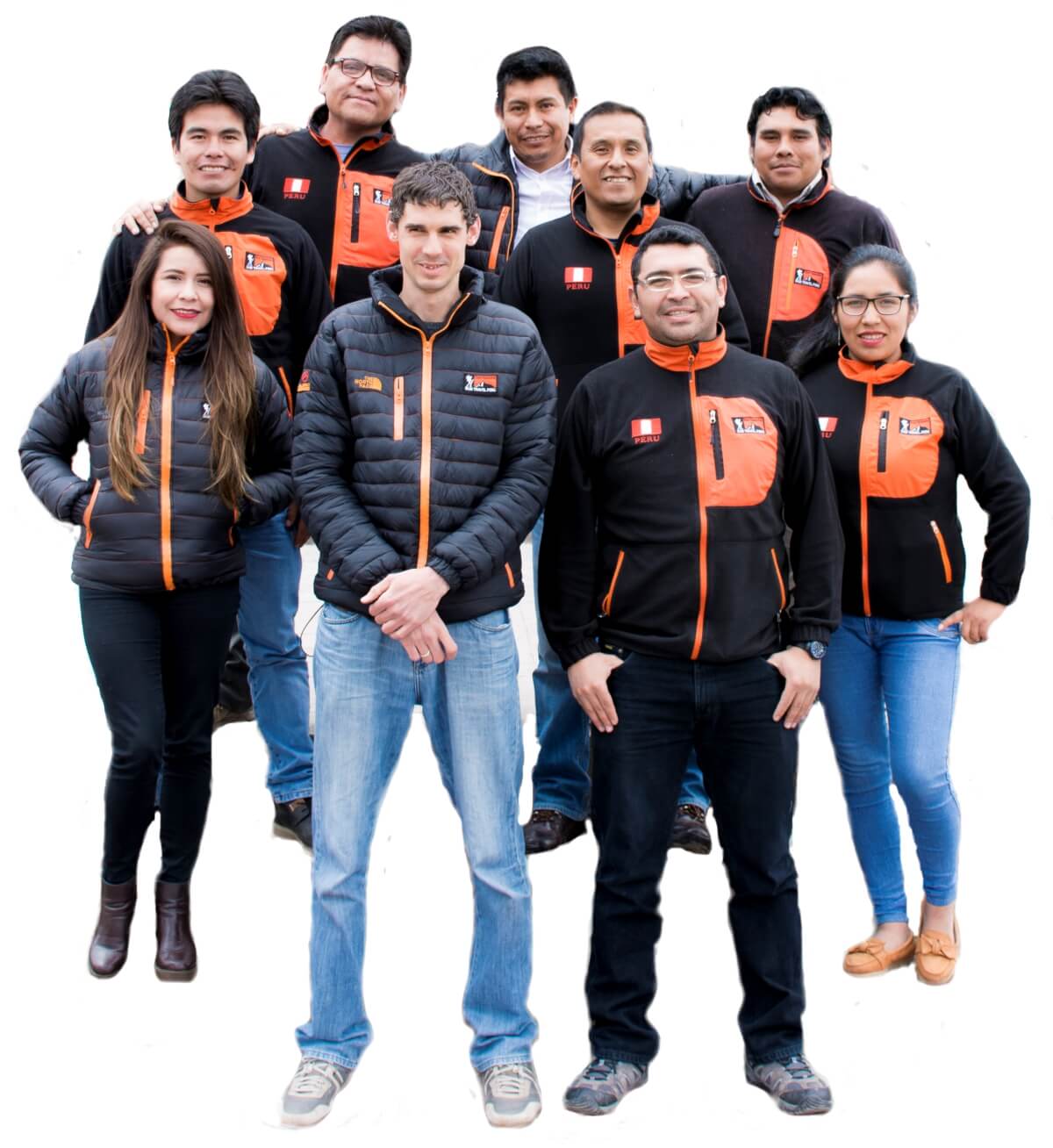
Unique Tours & Trekking Packages for all budgets
We have the most customized tours and packages for all budgets. They are created to meet our clients’ desires and needs when looking for something unique in a travel experience.
Gourmet and Hearty Meals
SAM TRAVEL PERÚ has one of the most outstanding meal services. Our chefs have been highly trained to prepare the best peruavian food our treks.
Our Commitment to the Environment
SAM Travel Peru has annual clean-up campaigns that creates awareness towards people across the planet that have the same desires to help protect the environment. It is our commitment in creating a positive and sustainable contribution towards the quality of life for rural Andean communities. .
Join the thousands of satisfied customers who rate us #1 on TripAdvisor
- Trip Advisor
Had a great trip with our guide Ray Herrera and driver Alfredo. Lots of good experiences in a short period of time 4 days. Learnt a lot not just about the main tourist destinations but Peru in general by Ray. Ray has a passion for Inca history and local produce. Ray knows all the good photo spots and we managed the sun out every day .. Good culture and if you want to get on a tour ask for Ray at Sams Travel = amazing
Ray was our Tour Guide and Alfredo was our driver for a 4 day tour we did with SAM Travel Peru. Ray's knowledge of the history of Cusco and Machu Picchu was outstanding. Ray was very accommodating with all our needs. He stayed alongside us when trekking and helped where he could. His sense of humour was pleasant to be around. Ray spoke very good English. He is such a nice guy. I would strongly recommend Ray to be your tour guide to visit Machu Picchu. Ray explained everyday what the plans were for the next day, which was reassuring what we needed to take etc
Our 1 day tour thru the Sacred Vally with Danny was wonderful. He was very knowledgeable and able to answer all our questions in detail. I would recommend asking for him personally if you are able.
We booked the Classic Cusco to Machu Picchu tour with SAM travel which we really had a good experience. SAM travel is very responsive during the communication and cater to our changes needed. Our guide is Ray who is also an very awesome guide. He is knowledgeable, patient, humorous as well reliable, he help us take many good photos and also go extra mile to help with our request. Thanks Ray! Thanks SAM travel that gave us good memories in Peru! Highly recommend if you consider booking any tour in Cusco.
Reviews by Trip Advisor

Wow. We had such an incredible experience in Sacred Valley and Machu Picchu. Our guide, Dayvit, is the most knowledgeable guide we have ever had. He has such an extensive knowledge of the history and is very friendly and helpful. If you are planning a trip to Peru, I highly recommend SAM travel and be sure to request Dayvit!
2 day tour sacred valley / Machu Picchu highly recommend! David was the best tour guide. He knows an incredible amount about Incan culture and is personable and funny. He also kept us up to date on a political situation happening when we were there and was informative. Overall, this tour checks all the boxes. Thank you!
We used SAM Travel for a 2D/1N trip from Cusco to Sacred Valley and Machu Picchu on Dec 25-26, 2022. The team was good with communication from the start - both Saul and Junior were very helpful and professional with answering any questions and clearing up any misunderstandings. Our guide, Miguel, was prompt, pleasant, and quite knowledgeable. We enjoyed his company and insight over the 2 day trip and recommend him to anyone booking with SAM Travel.
Reviews by Google
My wife and I just completed two excursions with SAM Travel Peru and we absolutely loved them. We did the 4 Day Salkantay Wilderness + Machu Picchu and then the 2-Day Rainbow Mountain + 7 Lakes trek with guide Carlos Estrada, chefs Nerio & Lucio, and horseman Unarato. Over the last 6 days we have learned so much about the Inca culture, discovered some of the most incredible sights, and ate delicious food every step of the way. We would definitely recommend SAM Travel (especially with Carlos!) to anyone that wants an incredible Peruvian adventure. The Wilderness trek is a much quieter trail than the standard Salkantay and goes a bit higher elevation, but camping at the base of Salkantay was incredible. Carlos's guided tour through Machu Picchu was so informative. We would have missed so much without him taking the time to share his knowledge.
Big thanks to David he was an amazing tour guide who really cared for our group. He allowed us to go at our own pace and was a brilliant photographer He was really funny and is full of interesting information & his passion for his inca ancestors is very obvious and warming. He also brought us to great restaurants! This company are very good and from what I can recall were cheaper than most. Thank you!
They took care of everything! Saul the owner is very responsive and helpful. Johnny our guide was fantastic, as were our chef, assistant chef and horsemen. I can’t recommend them highly enough and will definitely use them again if we return to Peru!
Three of us decided to choose Sam Travel Peru, reason being is it is a local travel company that help indegenious communities. We picked Lares Trek 4D3N to have cultural experience while hiking. Good foods provided by talented Mario Chef! Johnny is our tour guide, very helpful tour guide. He even helped me to carry my daypack as I was too exhausted to carry it on day 1 hiking. Strongly recommend to those like to have local experience while hiking.
Reviews by Facebook
Why you should travel with sam travel.
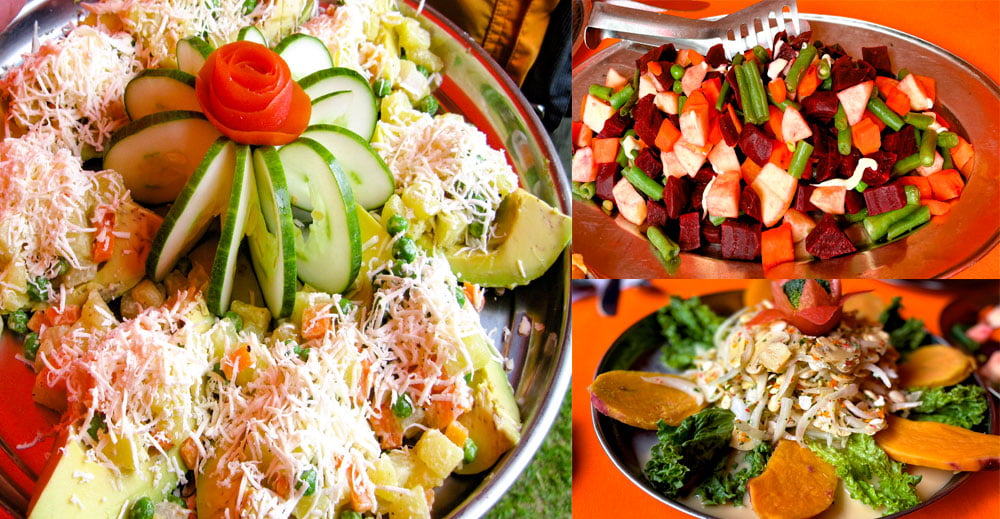
Best food in Machu Picchu hike
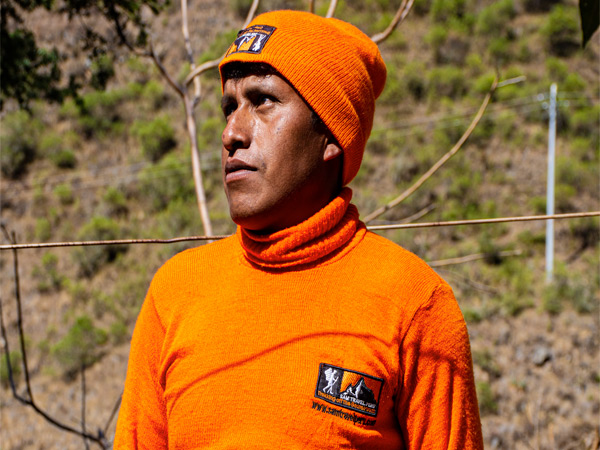
Our porters
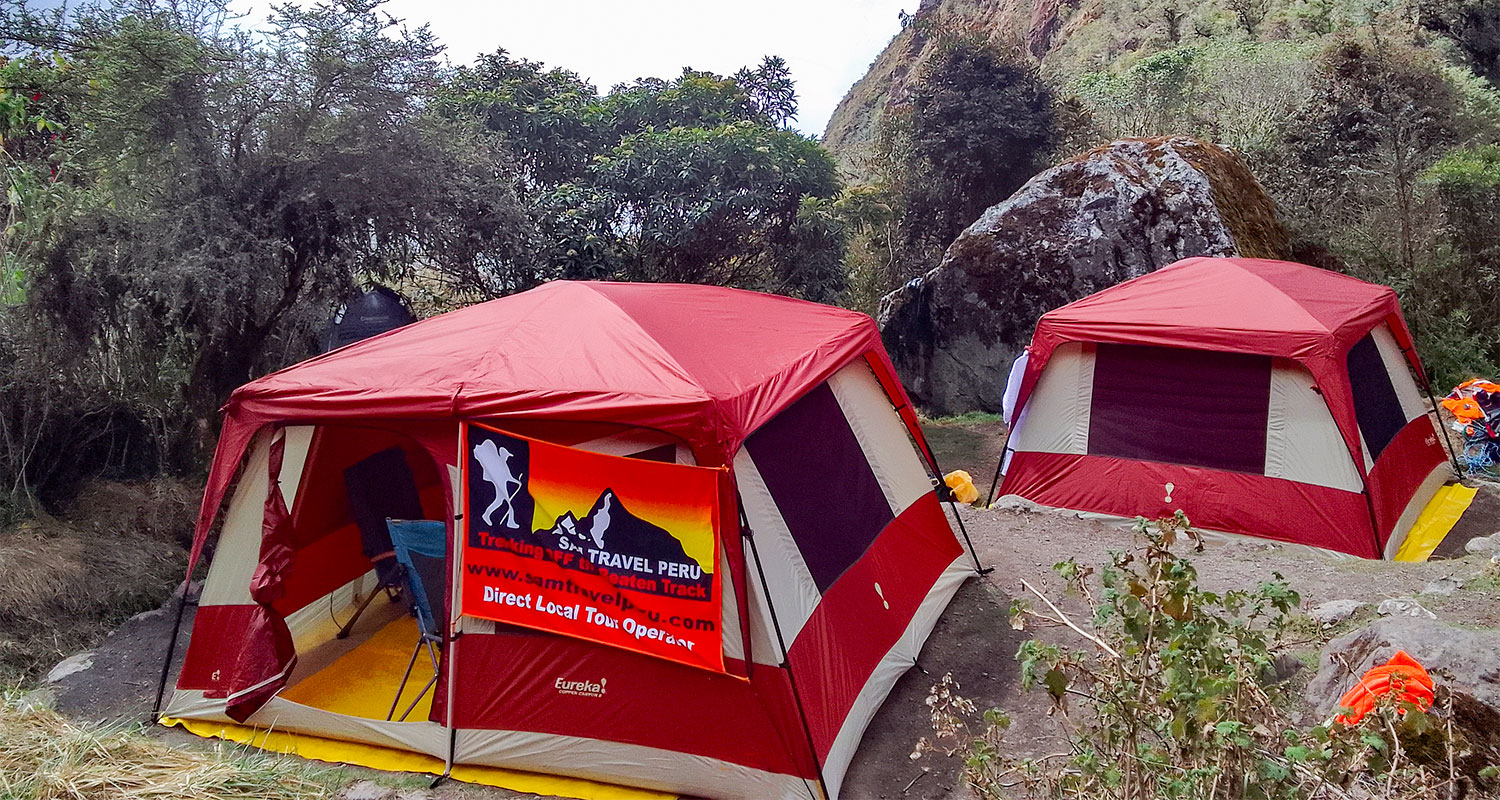
Best camping equipment
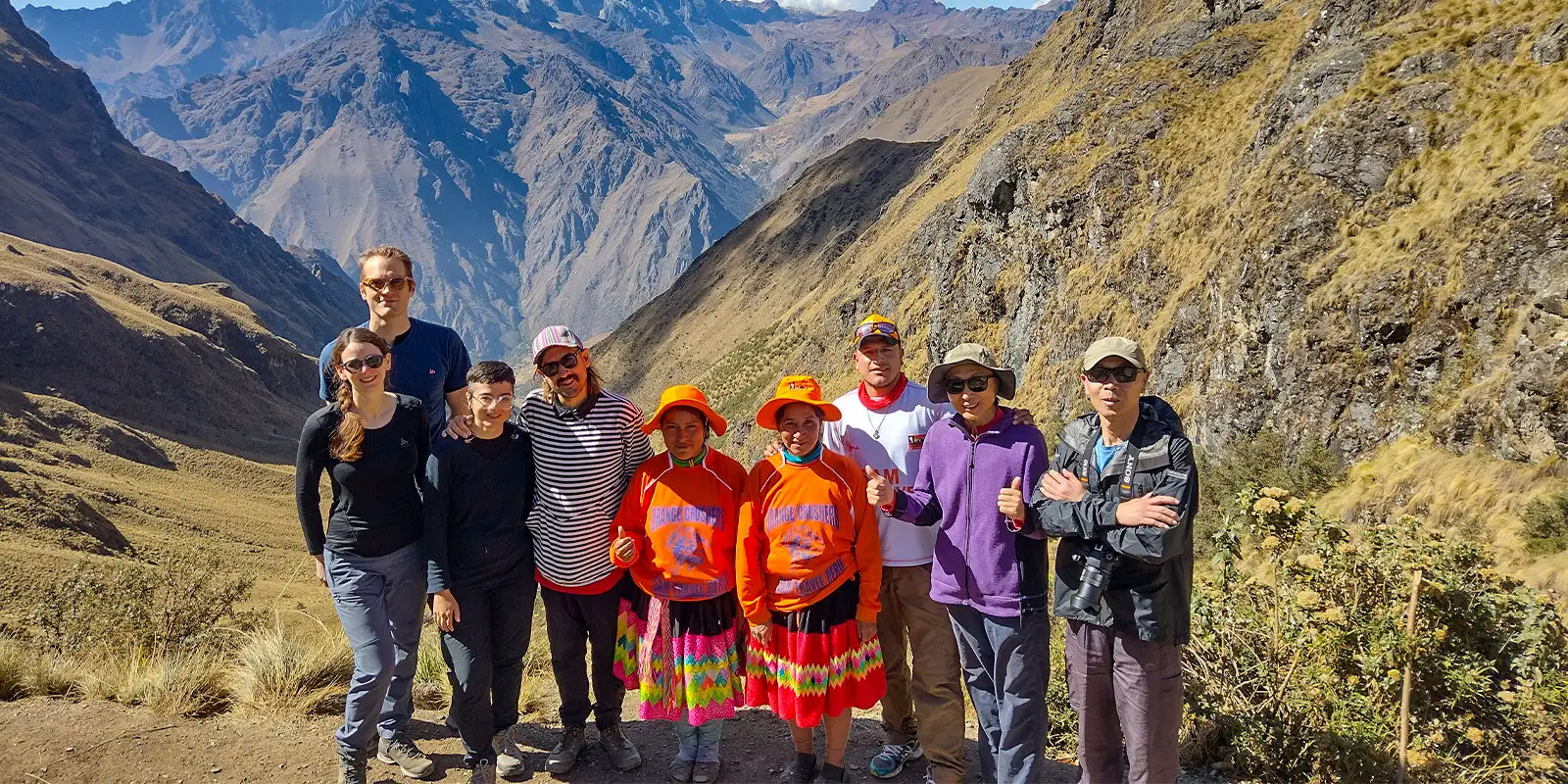
Empowering Women
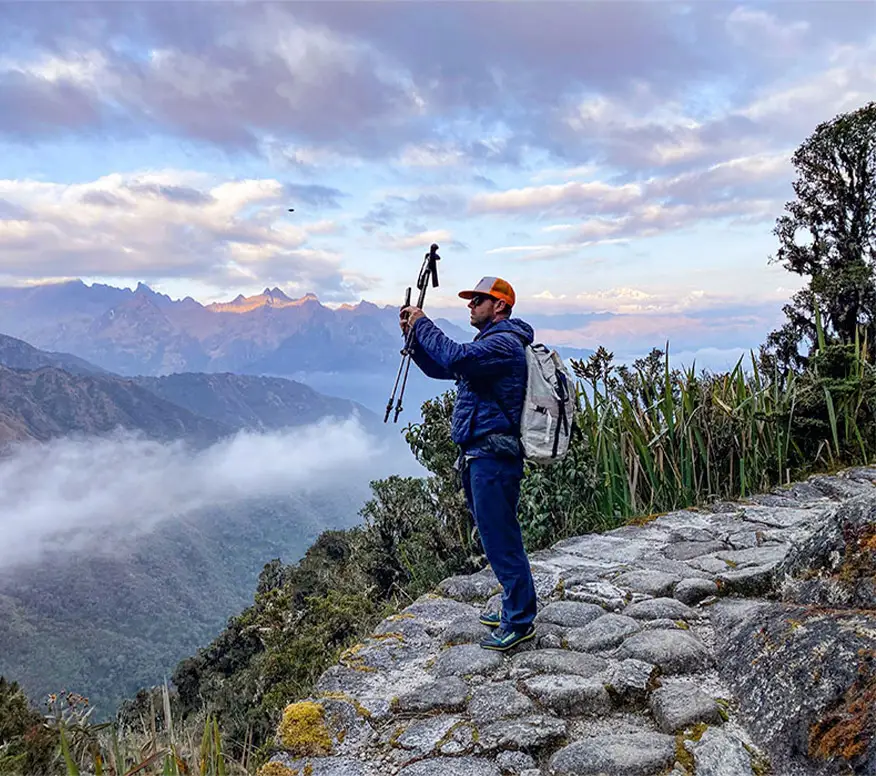
Safety on the Trail
Related tours new alternative treks.
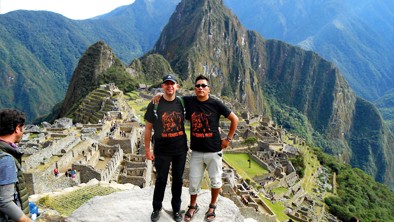
Luxury Glamping Inca Trail to Machu Picchu
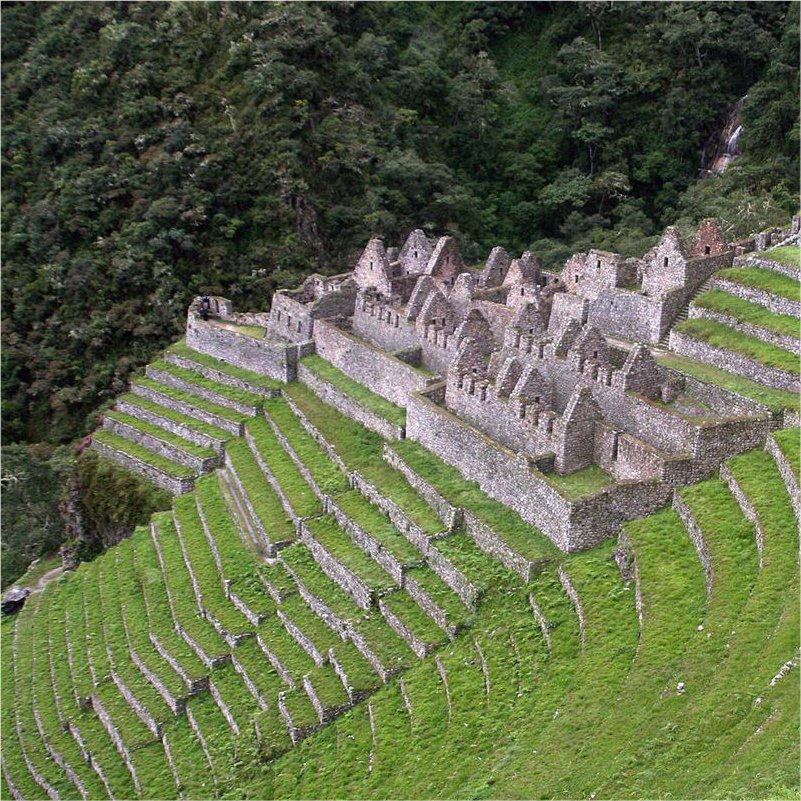
5 Day Lares Trek + Short Inca Trail to Machu Picchu
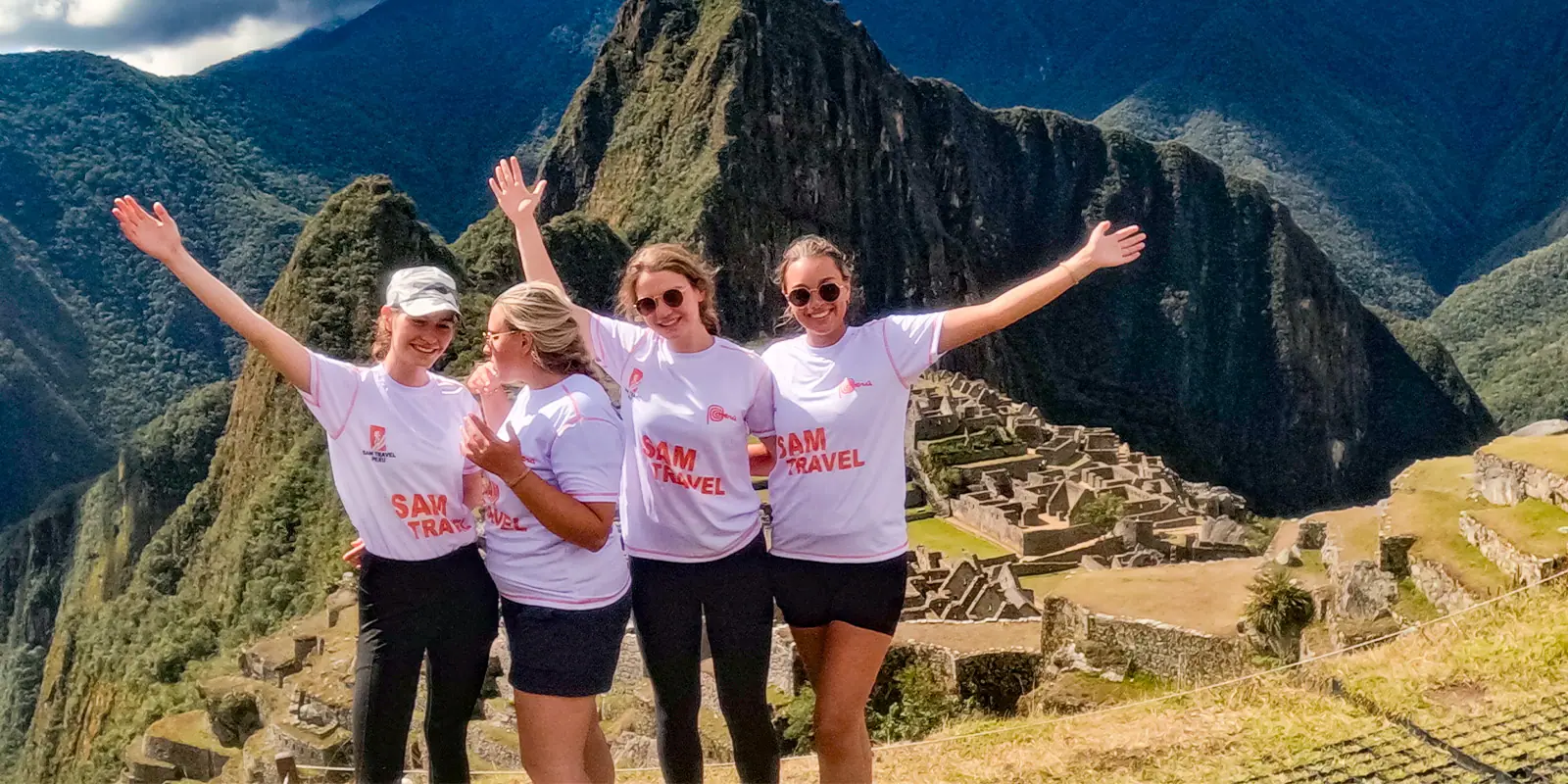
Best Lares Trek & 2 day Inca Trail to Machu Picchu Package
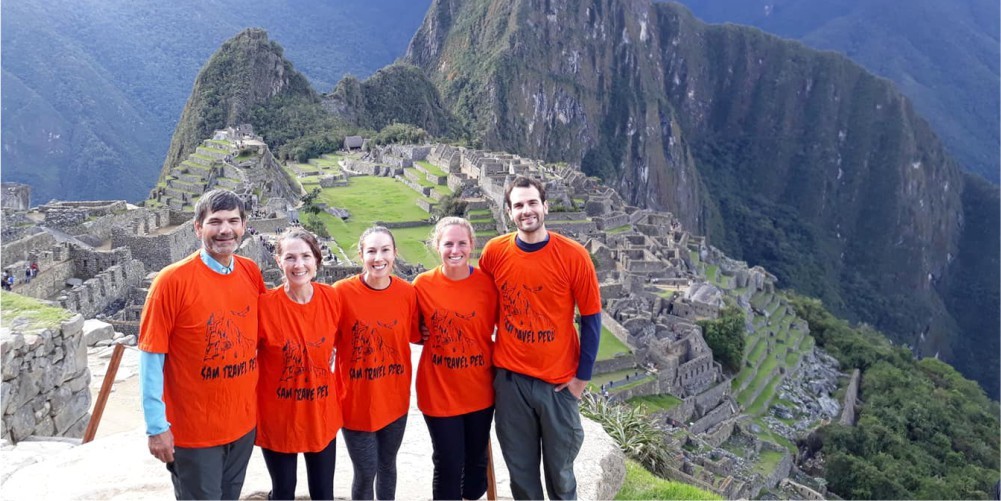
Ancascocha Trek to Machu Picchu – via Salkantay
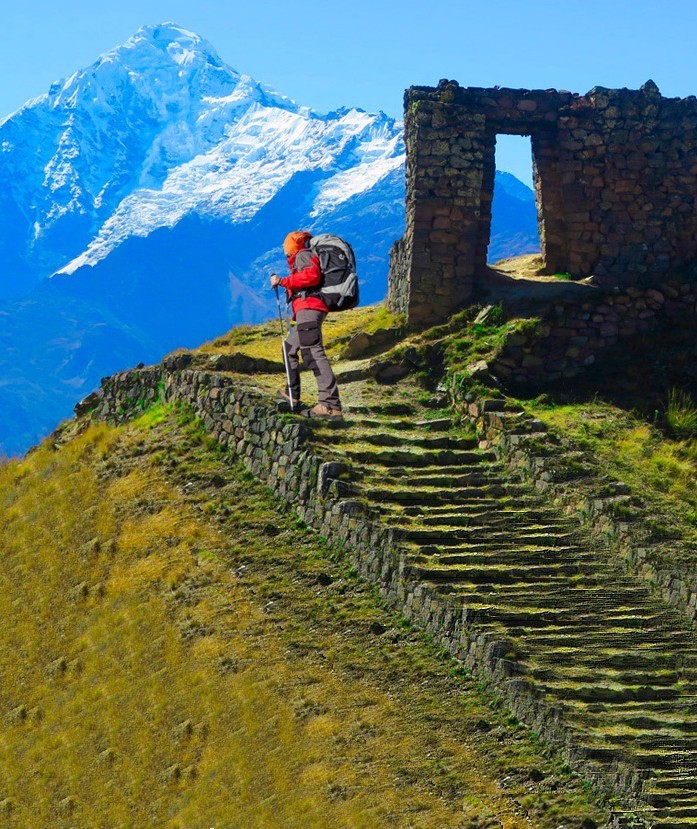
Inca Quarry Trail to Machu Picchu
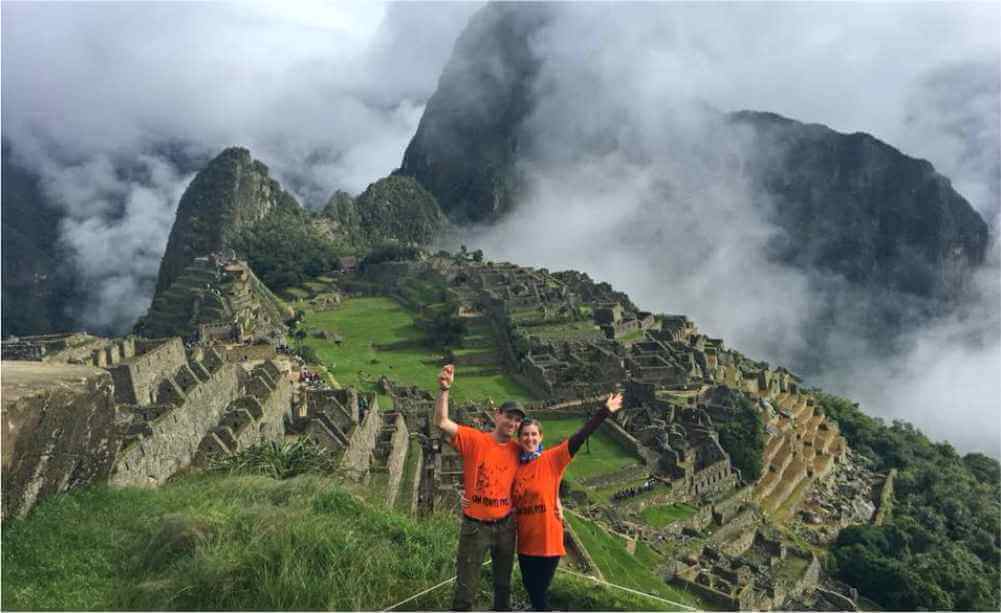
Inca Jungle Trail to Machu Picchu – Biking, Rafting & Trekking
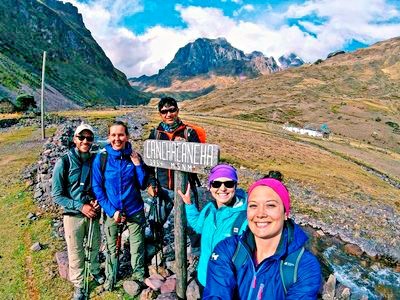
Lares Hike to Machu Picchu-3 days & 2 nights
Plan your tailor-made travel adventure.
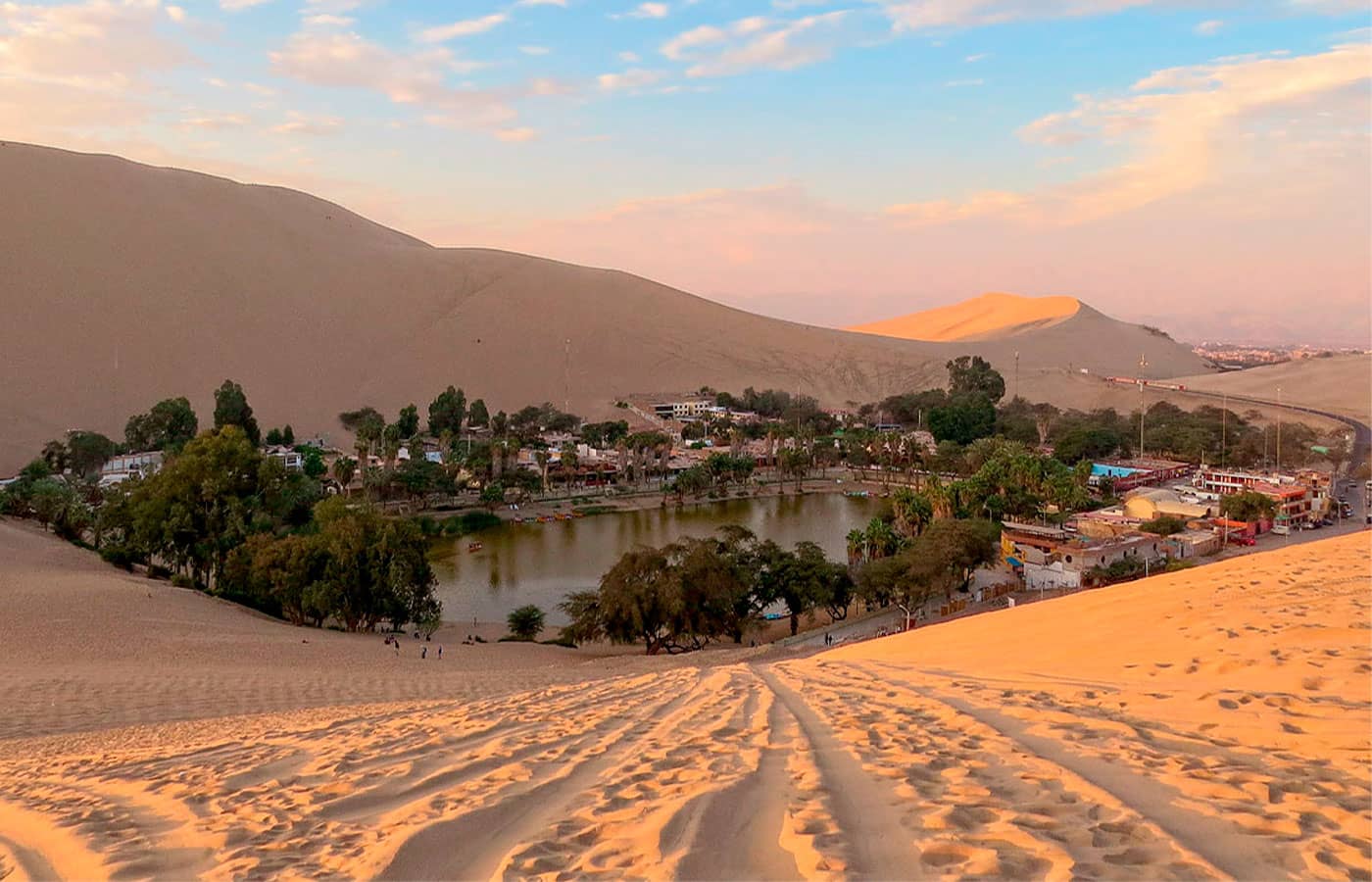
Our Peru trek, Peru Tours
Our packages range from short day tours to longer expeditions, and cover destinations such as Machu Picchu, the Amazon rainforest, Lake Titicaca, Colca Canyon, Huacachina Nazca, Lima and more. We also offer adventure tours, trekking tours, and cultural immersion experiences, as well as tailor-made itineraries to meet specific requests.
Our trips are well organized and on time. No need to worry. We do it all!
We offer guaranted trips and safe travel for all clients!
Join us on a journey of discovery and adventure in Peru, and let us create a personalized package that exceeds your expectations. Contact us today to start planning your dream trip!
PERSONALIZE YOUR TRIP
We stand out for the environmental care & dedication to our clients and work team.

We are ISO 9001 certified, which ensures that all our customers get consistent, good quality services and products. Sam Travel honors and is committed to these principles.

ISO 14001 sets an internationally agreed upon standard for Environmental sustainability. They encourage organizations to protect the environment through the efficient use of resources and reduction of waste. Sam travel adopts a holistic approach to environmental sustainability and management.

We are honored to have been chosen by our travelers as their travelers’ choice of 2022. Trust us to plan your travel, for an unforgettable, once in a lifetime experience. We are humbled and proud to provide the best tours to Machu Picchu, trekking the Inca trail and other tours and treks throughout the Cusco region and beyond.
Sam Travel is committed to a greener earth. We make direct contributions to counter the carbon emissions created by our website and its foot traffic. We play our part in reducing the impact on our environment by neutralizing our carbon emissions.
What Defines Us !

Form Contact us Sam Travel

OFFICE HOURS
Sales team hours, sam travel office, destinations.
- Peru Information, Land of the Incas
- The Imperial City of Cusco
- Trekking to Machu Picchu and Other Related Information
- Information about Our Salkantay Trek
- Lares Trek to Machu Picchu travel guide
- Huchuy Qosqo Trek Information 2024
- Travel Guide & Information for Choquequirao Trek
Useful Information
- Terms & Conditions (Covid 19)
- Terms & Conditions (General)
- Emergency Preparation SAM Travel´s Guide
- Extra Luggage
- Homestay in Pisac
- Vistadome or Expedition Train?
- Social Projects
- Our Clean up Campaign
- Our Christmas project
- Empowering Women on the Inca Trail
- Personal Porters
- Our travel blog
- Privacy Policy
Click one of our representatives below to chat on WhatsApp or send us an email to [email protected]
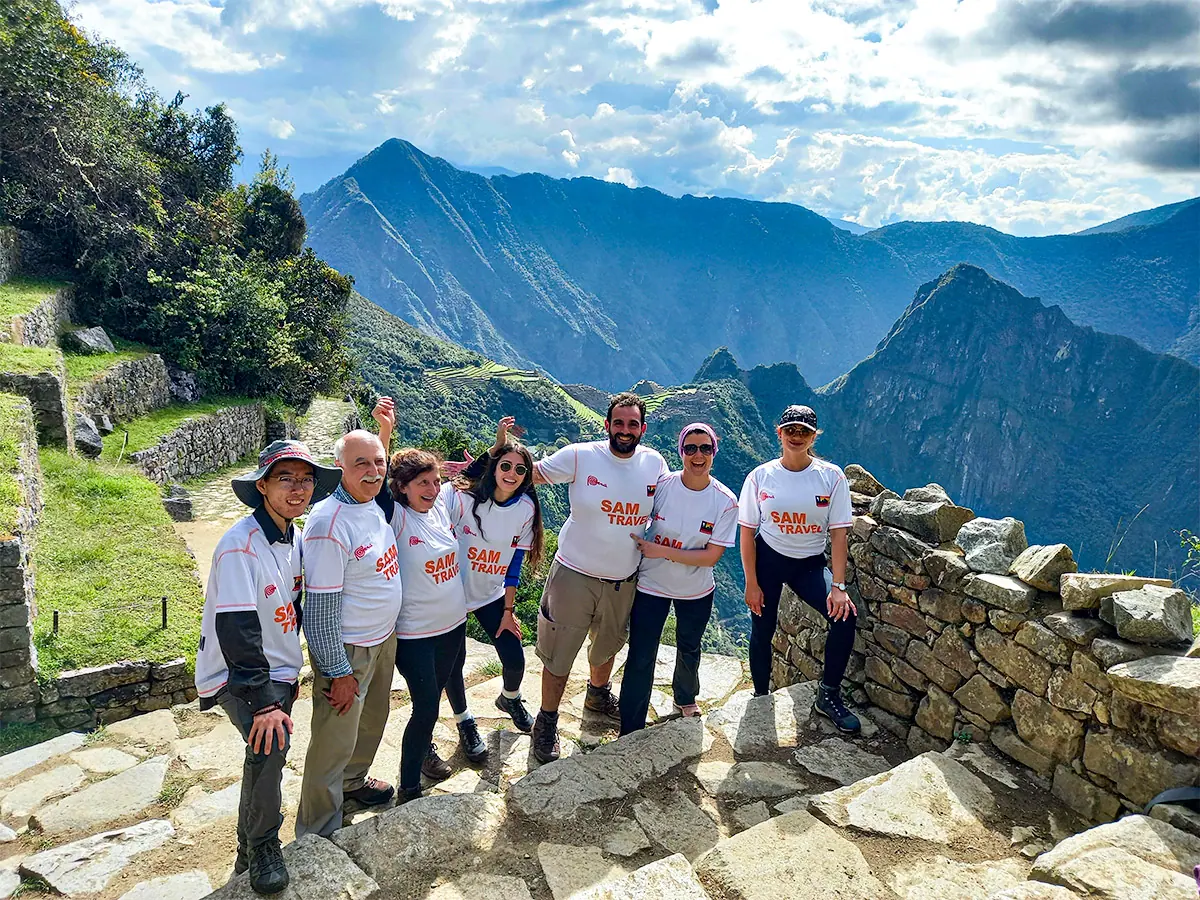
Permits will be released in October 2023, secure your Inca Trail ticket now. Don't miss out. They sell out extremely quickly.

COMMENTS
The Lares Trek is only 3 days of hiking compared to the Inca's four days. This makes it shorter (33km for the Lares vs 41km for the Inca trail) and easier than the Inca trail. Finally, there is no permit required to hike the Lares Trek, but you do need a permit for the Inca Trail. Please Note: Inca Trail permits sell out months ahead of time.
Inca Trail.-. Just like on the Lares Trek, winter months on the Inca trail are just the right time to go. Although the temperature is cold at night, the day hike is mostly enjoyable, having sunny days. However, if you are planning on hiking the Inca trail in summer, the weather is still nice (warm) but rain and fog can obscure the scenic views.
INCA TRAIL: The Inca Trail is labeled a moderate difficulty trek, and is considered slightly more challenging than the Lares Trail. One of the biggest difficulties on the Inca Trail is STEPS! Google says that there are over 70,866 steps on the Inca trail, and some of them are big steps, about 10 to 12 inches high.
The Lares Trek and the Inca Trail both present unique challenges in difficulty and altitude, catering to different types of adventurers. The Lares Trek is considered moderately challenging. It reaches higher altitudes than the Inca Trail, with its highest point around 4,500 meters above sea level. It can be demanding for those not acclimatised ...
Inca Trail Lares Trek. In comparison, the Lares Trek is a much less traveled and therefore less popular trekking route to Machu Picchu, so you will sometimes feel like it is just you and the surrounding mountains.The real satisfaction of hiking the Lares Trek is hiking through small farming villages far from Cusco society, which do not have electricity or potable water, you will interact with ...
To compare the Inca Trail vs Lares Trek, the Lares Hot Springs Trek including a visit to Machu Picchu is also 4 days. The Lares Trek is 34 kilometers (21 miles), high altitude, but less dramatic in the ascents and descents. You start at 3200m (10,499 ft) and ascend to 4700m (15,092 ft), the highest pass being Pumahuanca.
The Lares Trek reach a higher elevation than the Inca Trail. This fact is important to consider before starting off any of these options. Furthermore, the Lares Trek route is in the Urubamba Mountain Range whereas the Inca Trail route is located near the Vilcabamba Mountain Range. The highest peak in the Urubamba Mountain Range is the snow ...
Lares Trek vs Inca Trail. Peru is famous for its ancient ruins, picturesque landscapes, and vibrant culture. And when it comes to trekking in Peru, the Lares Trek and Inca Trail are two of the most popular options. While both treks offer stunning views and an immersive cultural experience, they differ in several ways. In this blog post, we'll ...
Lares has MUCH LESS tourist influx than the Inca Trail and you go through a couple of very traditional villages. Lares has breathtaking views of lakes and some beautiful waterfalls. Lares does not count with a lot of ruins - whereas the other trek does count. Both end in Machu Picchu. The Lares trek is 33 km (20.5 miles) and the Inca Trail 44 ...
Lares Trek to Machu Picchu + Short Inca Trail 5D/4N - This option is one day longer and more challenging, as it includes the Short Inca Trail along with the Lares Trek. It lasts 5 days and 4 nights, during which you will walk around 41 kilometres before reaching the majestic Inca citadel of Machu Picchu.
The Lares Trail. First of all, one good thing about the Lares Trail is that it is slightly less physically taxing than the Inca Trail - but that's not to say it's without difficulty. It's approximately 33 kilometers vs. the Inca Trail's 44 kilometers - still no walk in the park. Both feature plenty of altitude gains and steep descents ...
Inca Trail vs the Lares Trek. Post author: Mark Ching; Post published: 1 February 2024; Post category: Inca Trail; Embarking on a journey to Machu Picchu is a dream for many adventure seekers, and the trek to this ancient wonder offers two prominent paths - the Inca Trail and the Lares Trek.
The Lares Trek Only has Two Nights Camping, vs 3 or 4 on the Inca Trail. Not everyone likes camping! Even though we believe that camping in Peru is a different experience that everyone should try, some people simply are not interested in spending the four days in a tent which is demanded by the Inca Trail. So, the Lares Trek has just two nights of camping- just enough to see the beauty of the ...
The highlights of the Lares Trek. It's a much less congested route than the Inca Trail. It highlights its natural beauty and the majesty of its bodies of water: multicolored lagoons and sacred waterfalls. It's an experience of contact with traditional Andean culture. The visit to Machu Picchu is made on the last day, after resting for a ...
The Inca Trail is undoubtedly the more well known of the two. Opened years before the Lares Trek, it's become very popular with travellers the world over. Starting at km 82 at an altitude of 2,700m (8,858 ft), you climb up to a high point of 4,215m (13,828 ft) at Dead Woman's Pass. There is now a limit of 500 daily trekking permits, so ...
The Lares trek vs. the Inca Trail. Which one to take a classic dilemma many trekkers in Peru will face. Both treks are two of the best treks in Peru.The Inca Trail is the classic Peruvian trek and is one of the most famous multi-day treks in South America.The four-day route follows an ancient mountain trail, offering splendid views and passing various Inca ruins.
First of all, one good thing about the Lares Trek is that it is a little less physically complicated, but that does not mean that it is without difficulty. They are approximately 33 kilometers in comparison with the 44 kilometers of the Inca Trail. Both have a lot of altitude gains and steep descents, although once again the Inca Trail slightly ...
The famous 4 Day Inca Trail represents just one small section of their overall extensive roadway system was 39,900 kilometers (24, 800 miles) long! For more information on the ancient Inca Trail. To trek the Inca Trail you must plan at least 6 months ahead because only 500 people are permitted to hike this trail each day.
Choosing between the Lares Trek vs. Inca Trail is a common dilemma for trekkers heading to Peru. Both trails offer unique experiences +51 978 707 855 [email protected]
The Lares Trek is one of many Inca Trail options leading to Machu Picchu. The trail is known for its breathtaking scenery, including cornfield terraces, cloud forests, and glacial rivers. Many travelers are looking for images of the Inca Trail to help them plan their trip or to relive their adventure.
The Lares trek & Short Inca Trail to Machu Picchu is a 39 km/ 24.23 miles hike through the Andes in the Cusco region. The maximum altitude reached is (4,780 m/15,682 ft). The Trail is a fairly difficult trek and you should be well prepared and healthy prior to starting it. You have to be moderately fit and take regular exercise.
The Classic Inca Trail is a 25-mile-long hiking trail in the Andes Mountains that takes four days to complete and ends at Machu Picchu. After starting at KM 82 in the Sacred Valley, hikers will ...
The Lares trek & Short Inca Trail to Machu Picchu gives you the best of all worlds in four days. Our own unique route is incredibly picturesque, with majestic glaciers, shockingly blue lakes, waterfalls, llamas, and alpacas. On the Inca Trail, hike on the original Inca trail just like in ancient times. You explore the ancient Inca religious ...